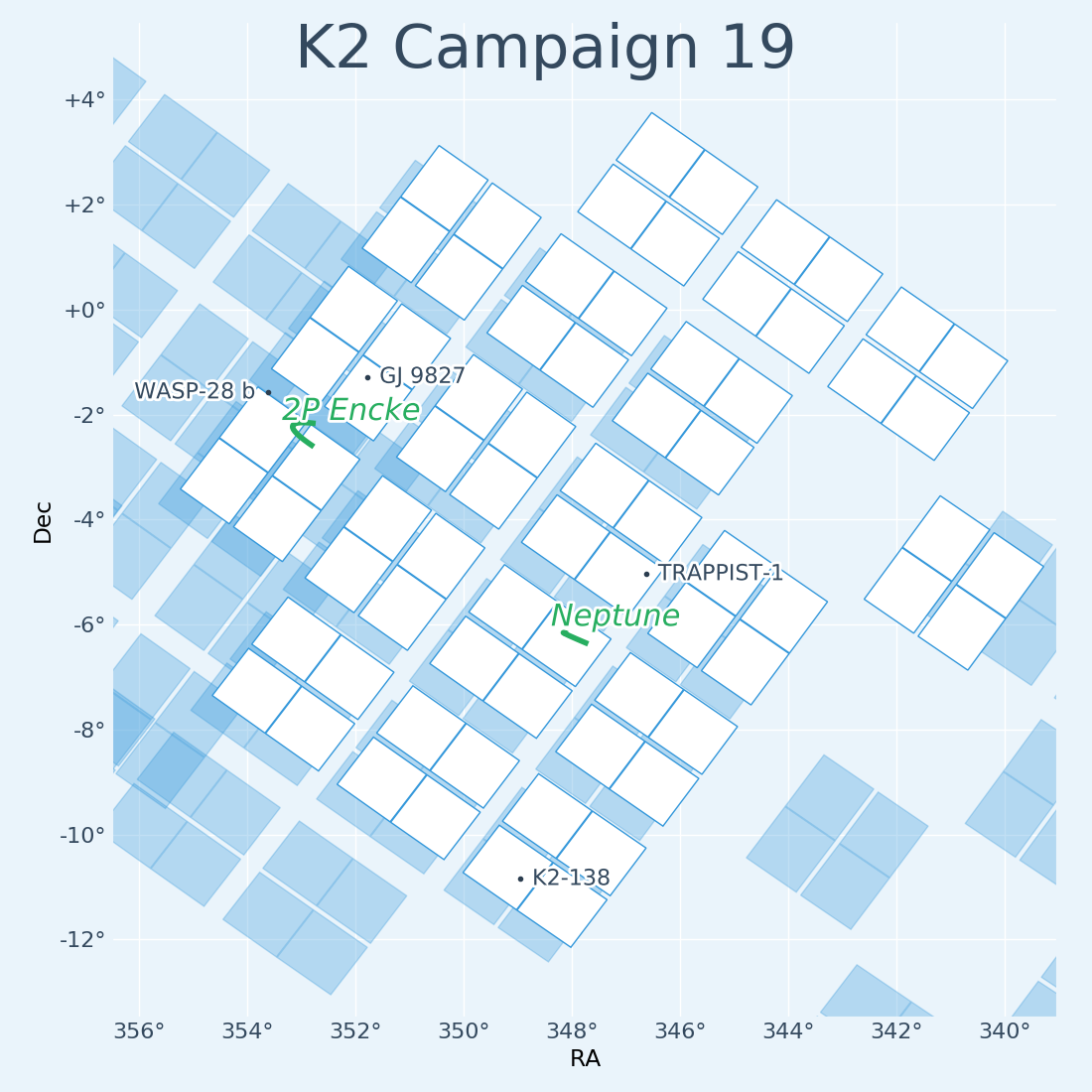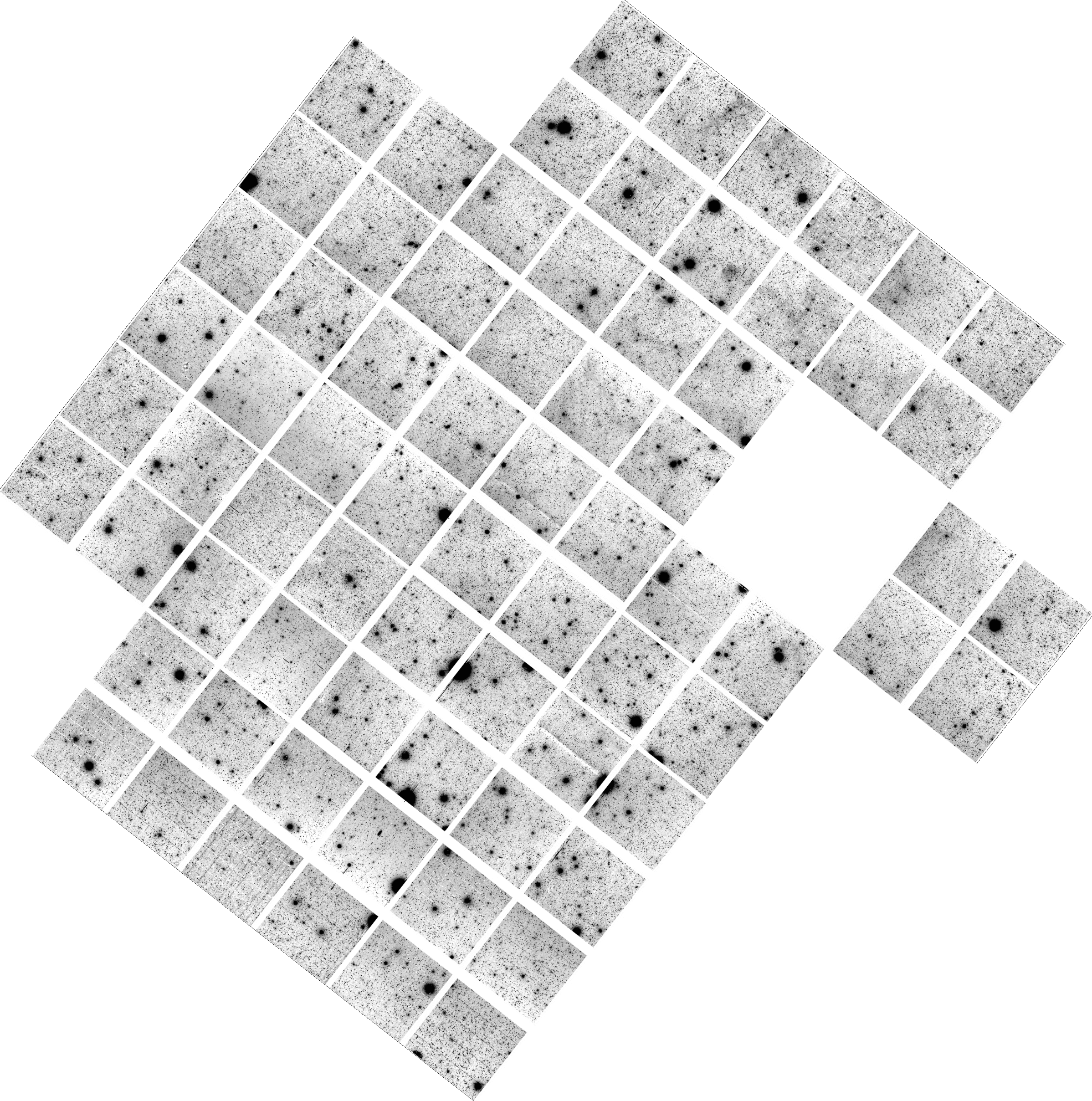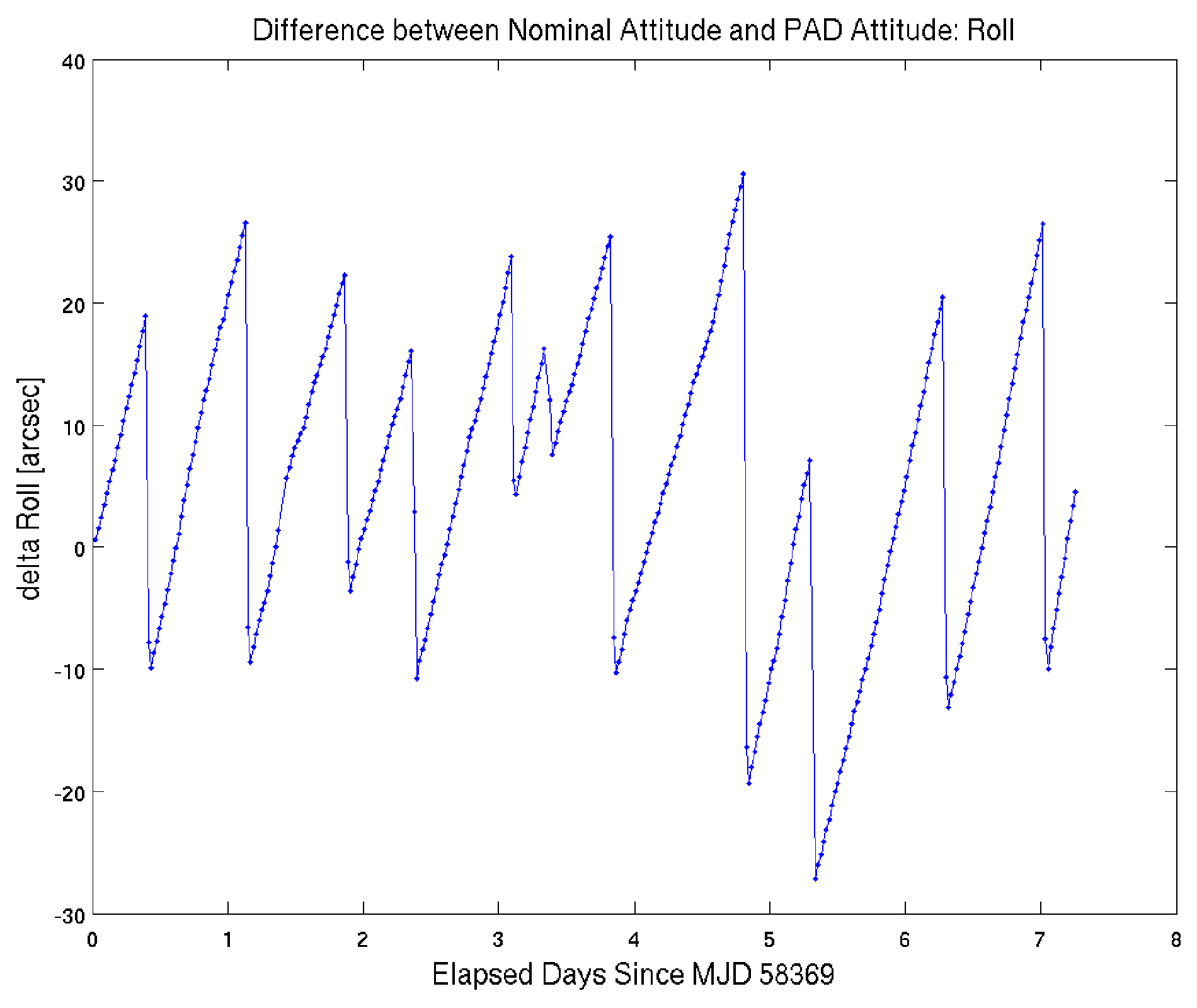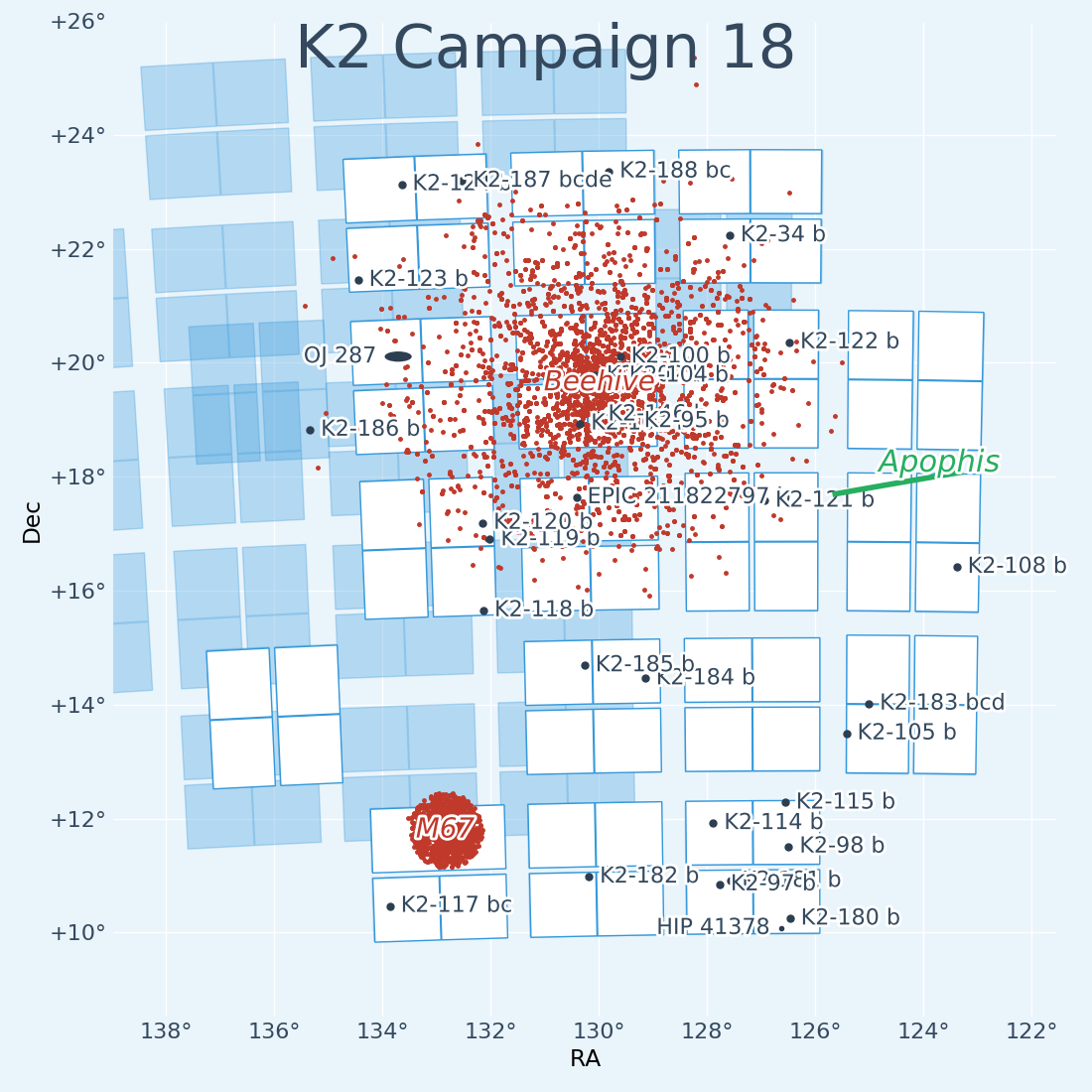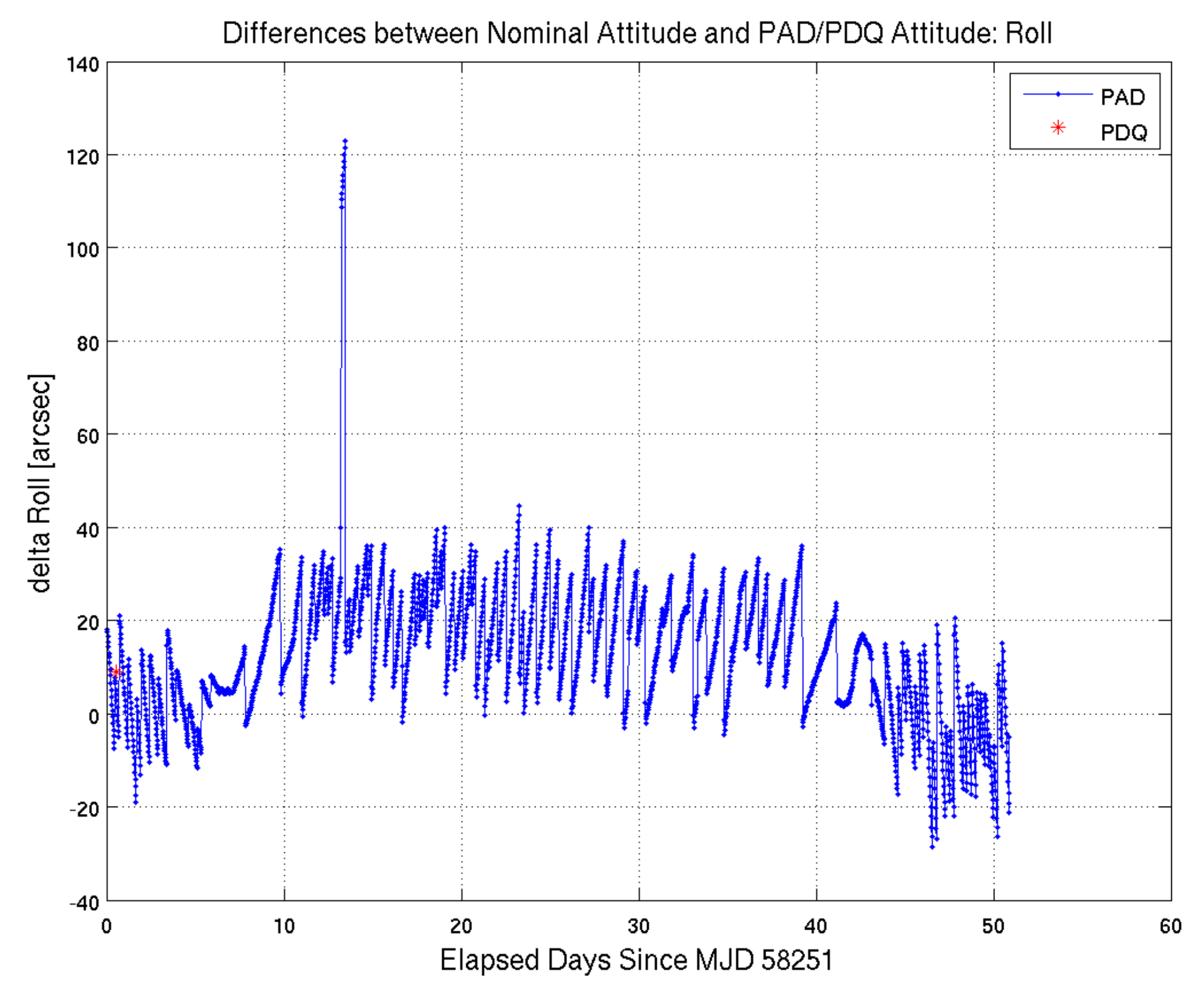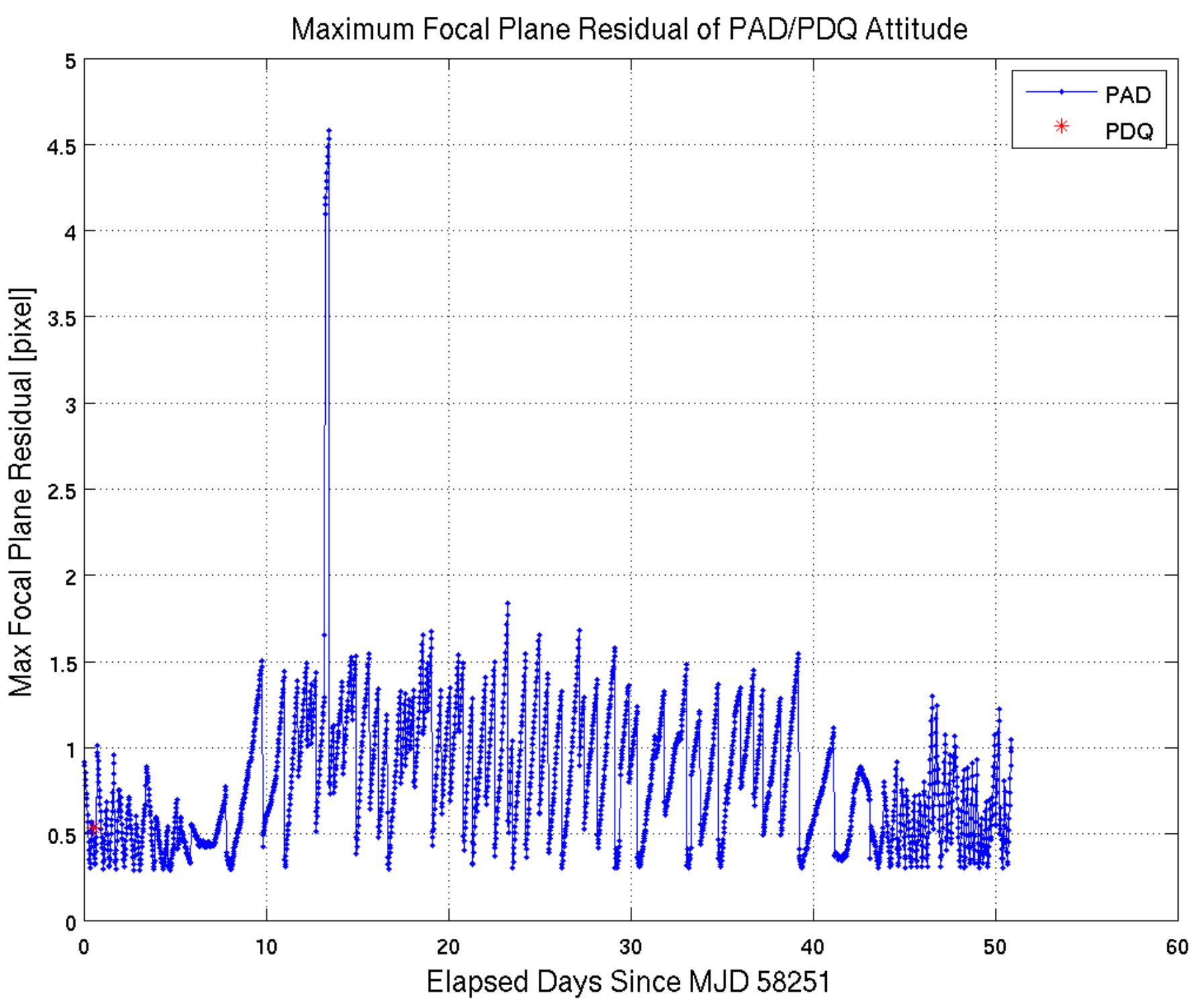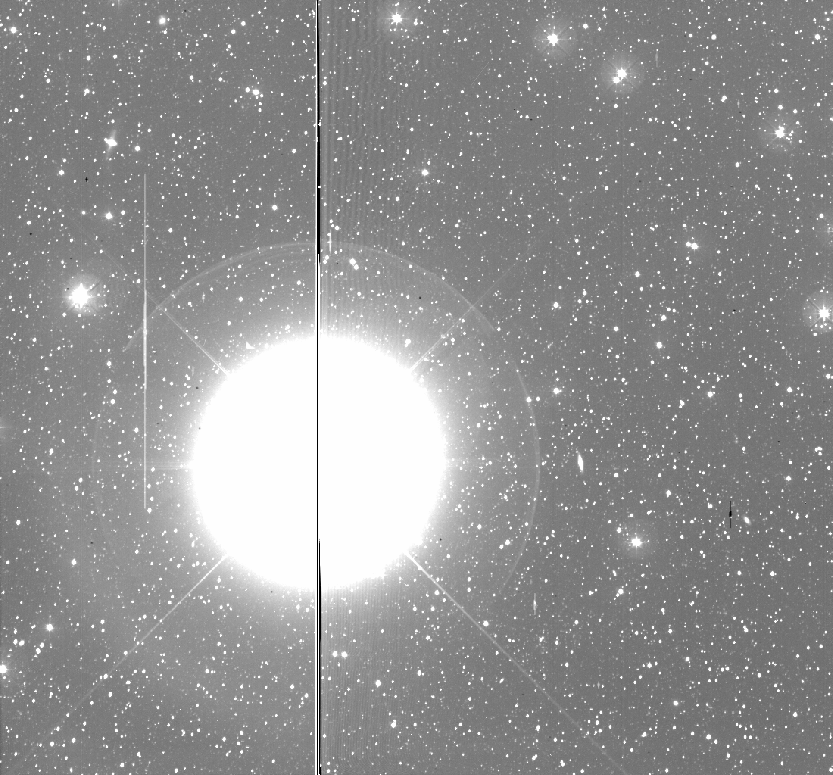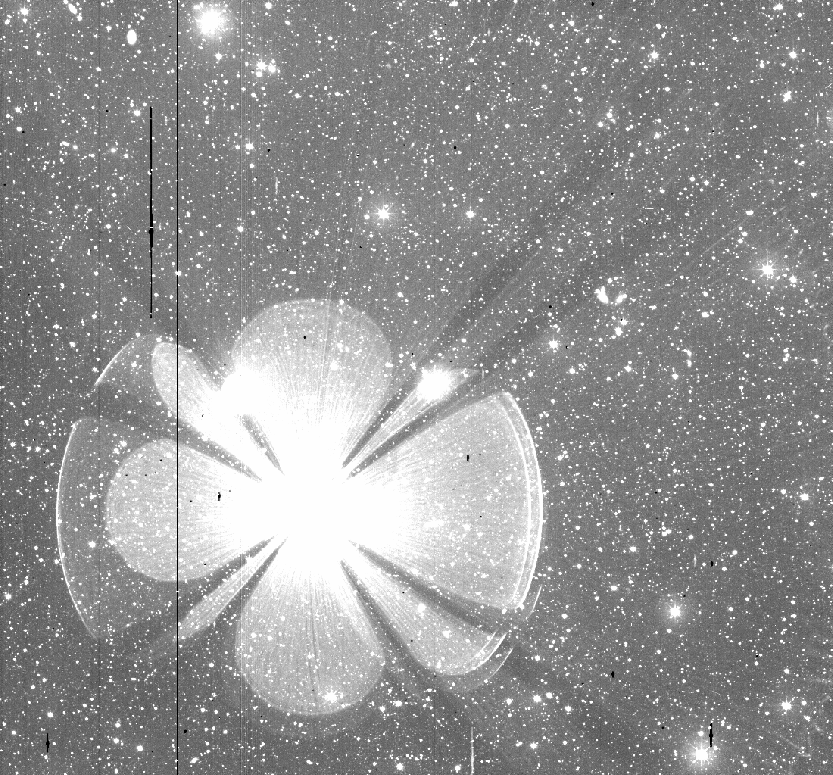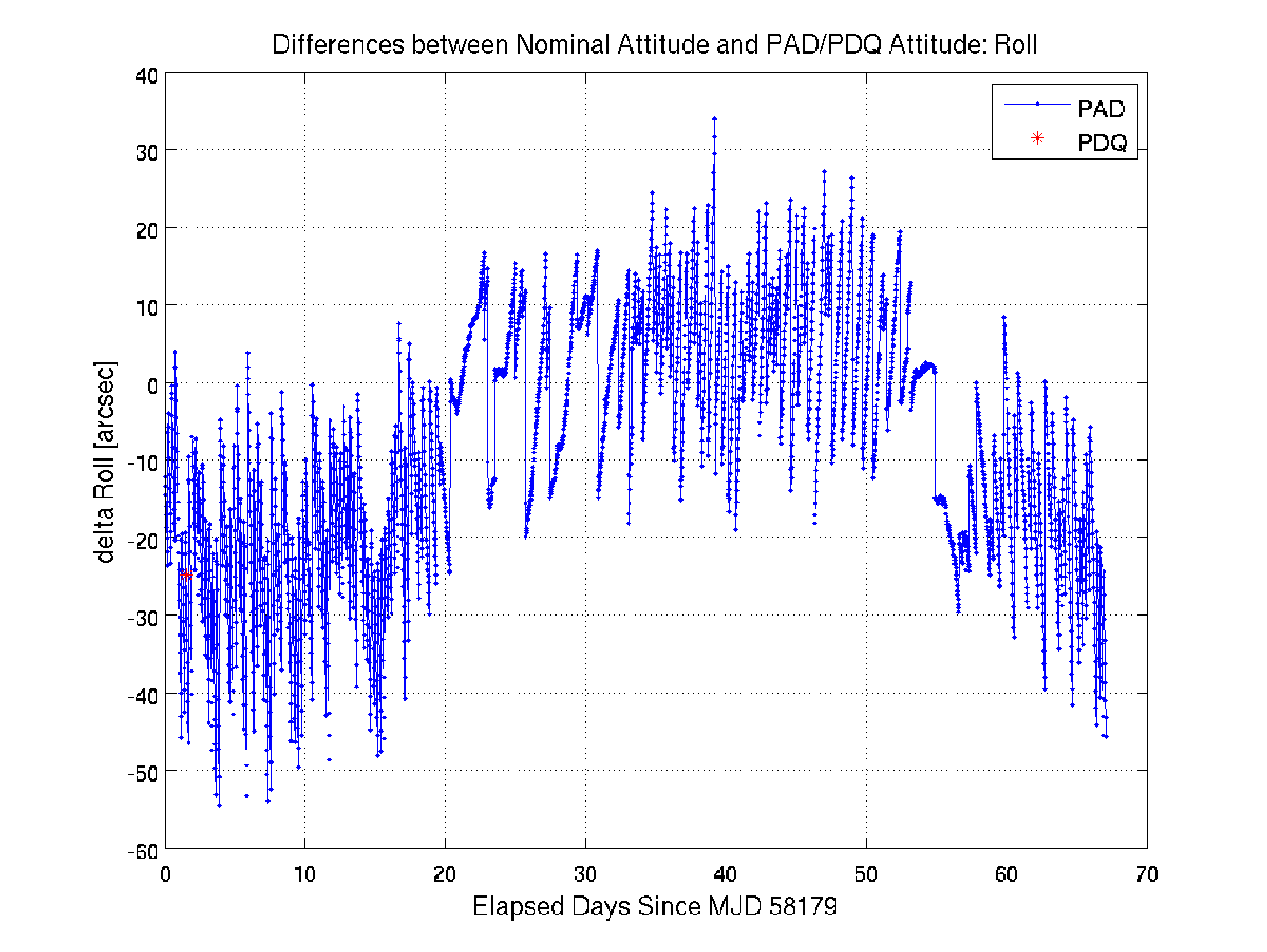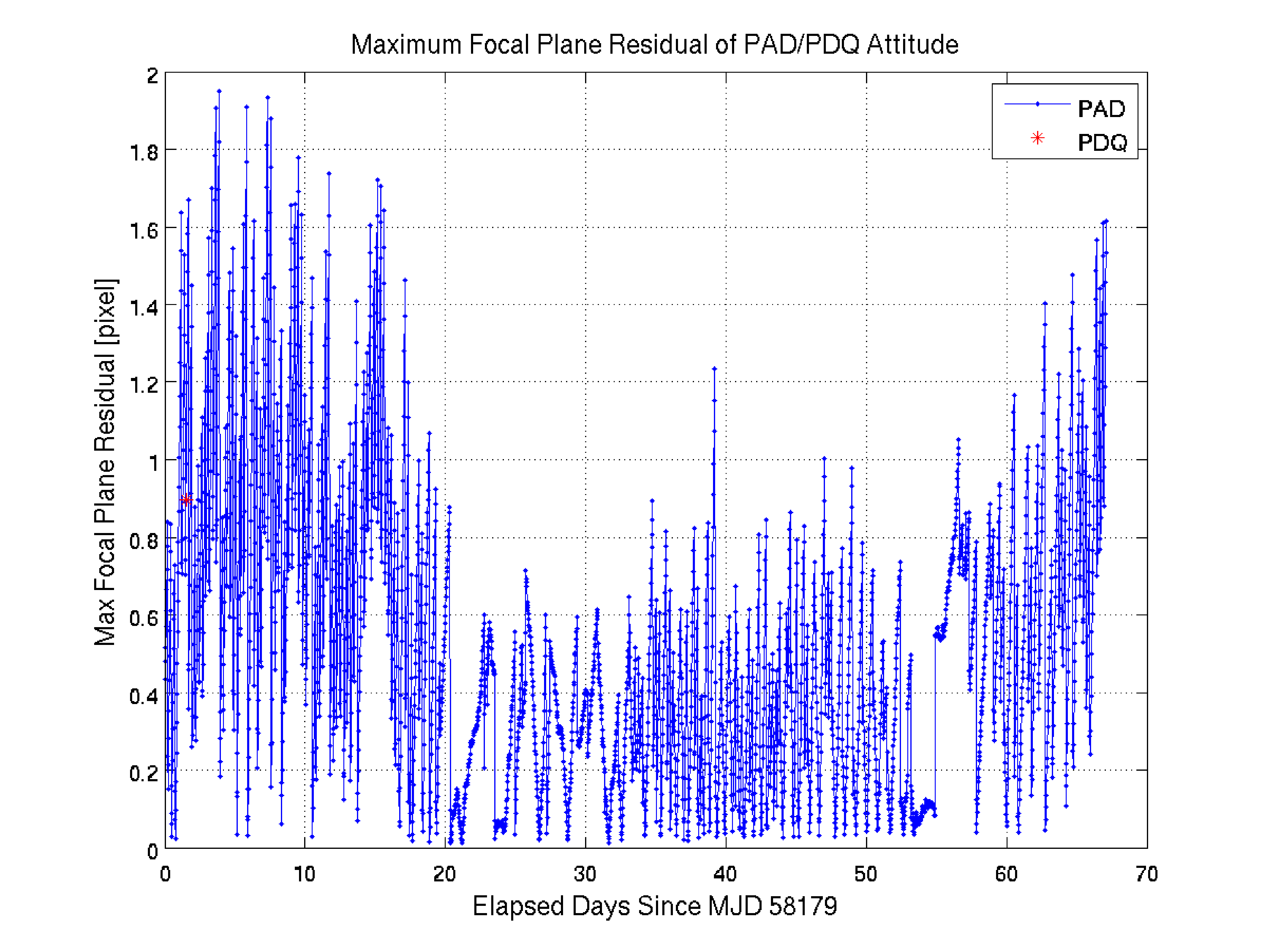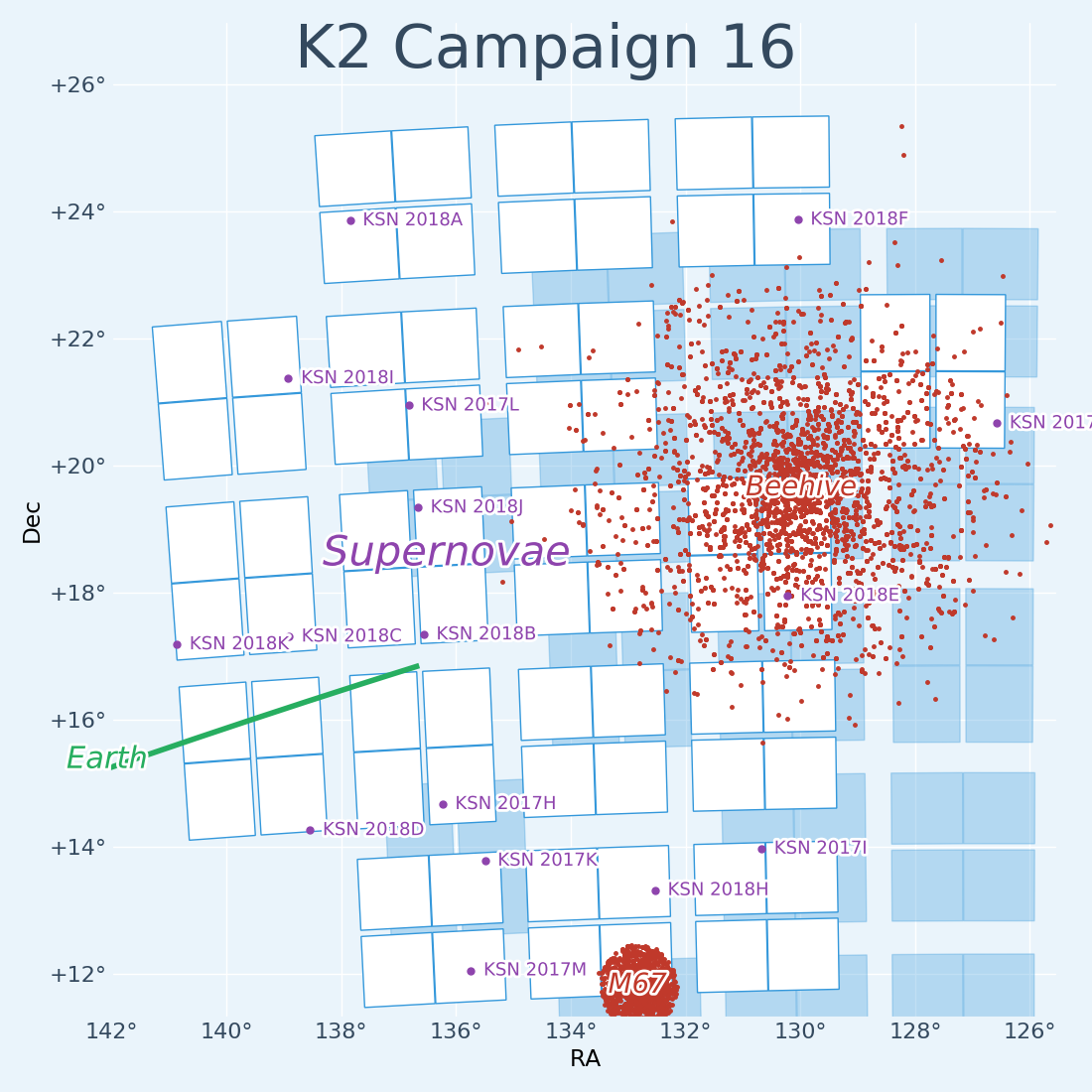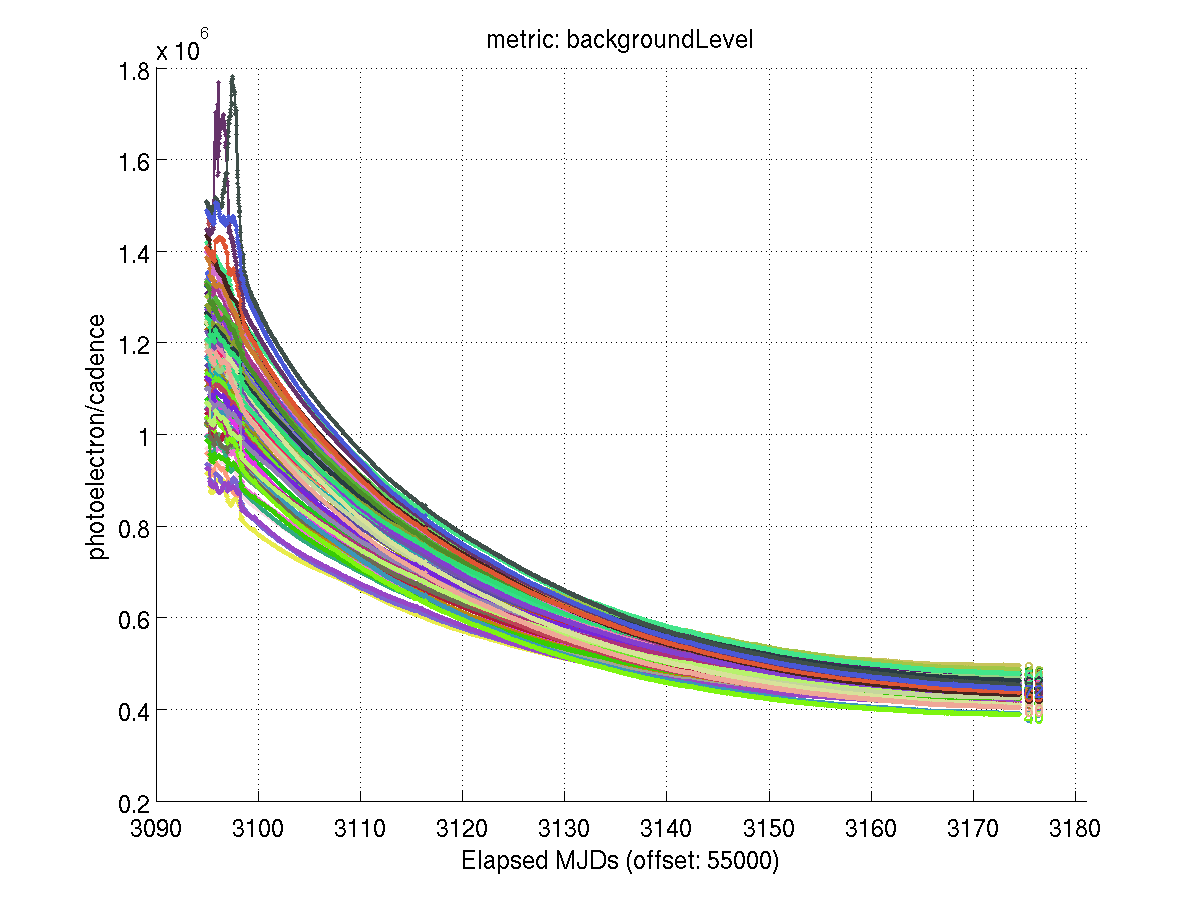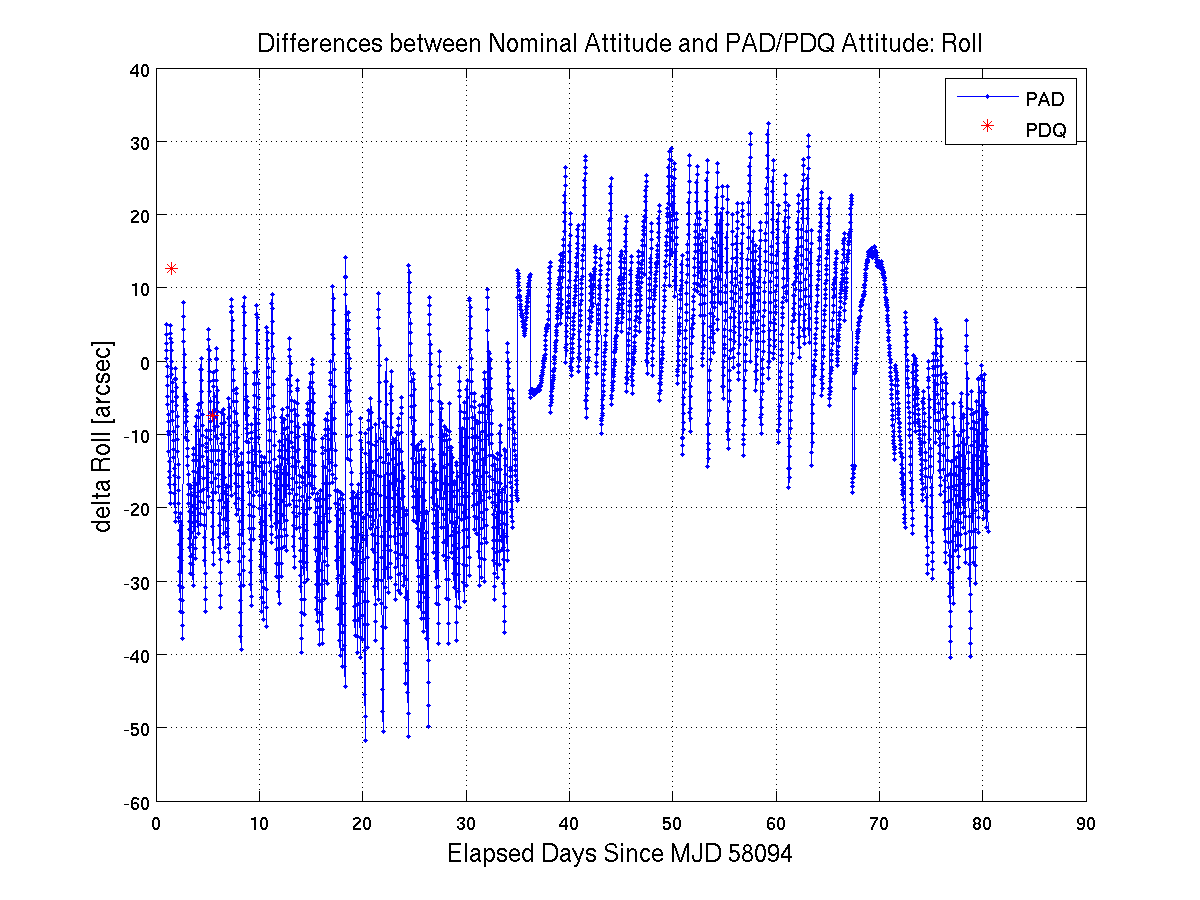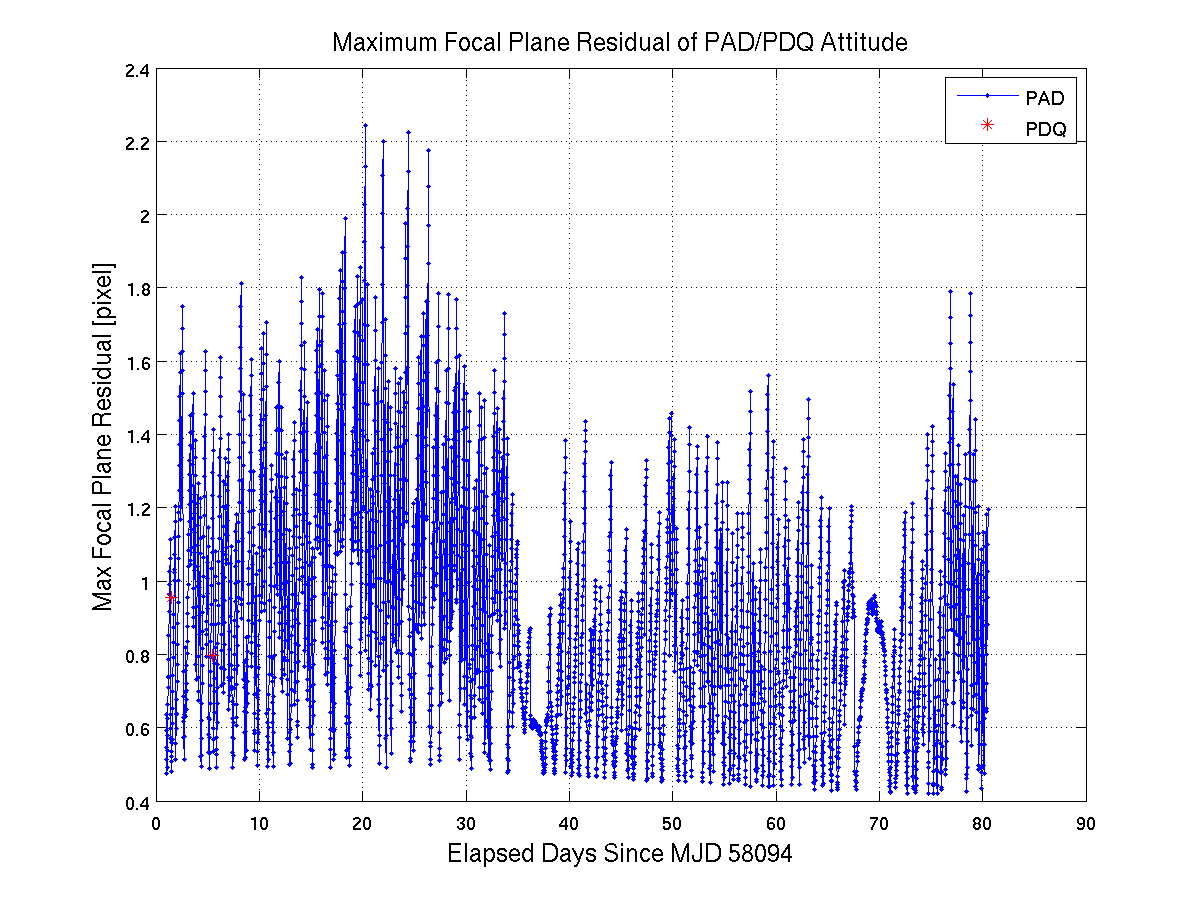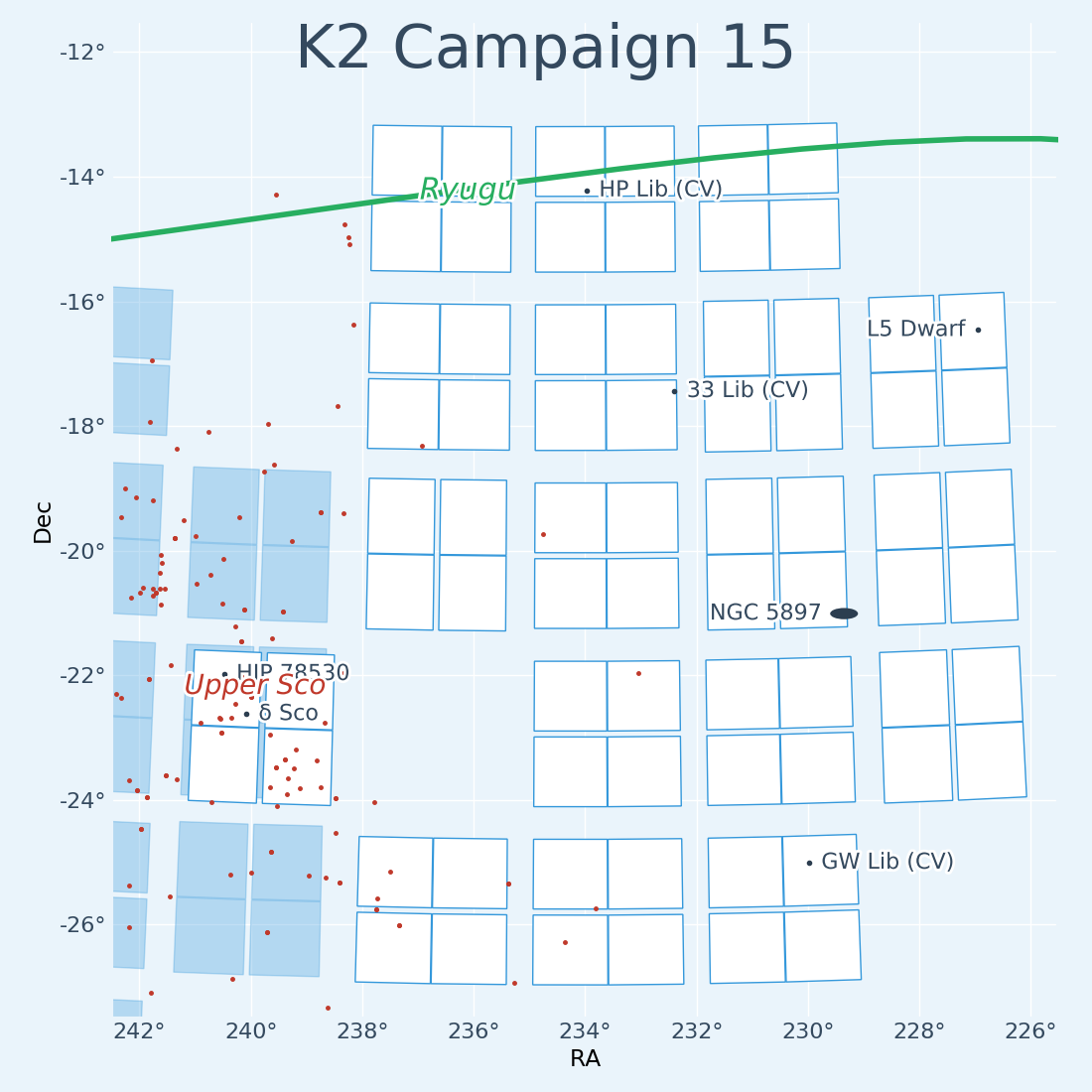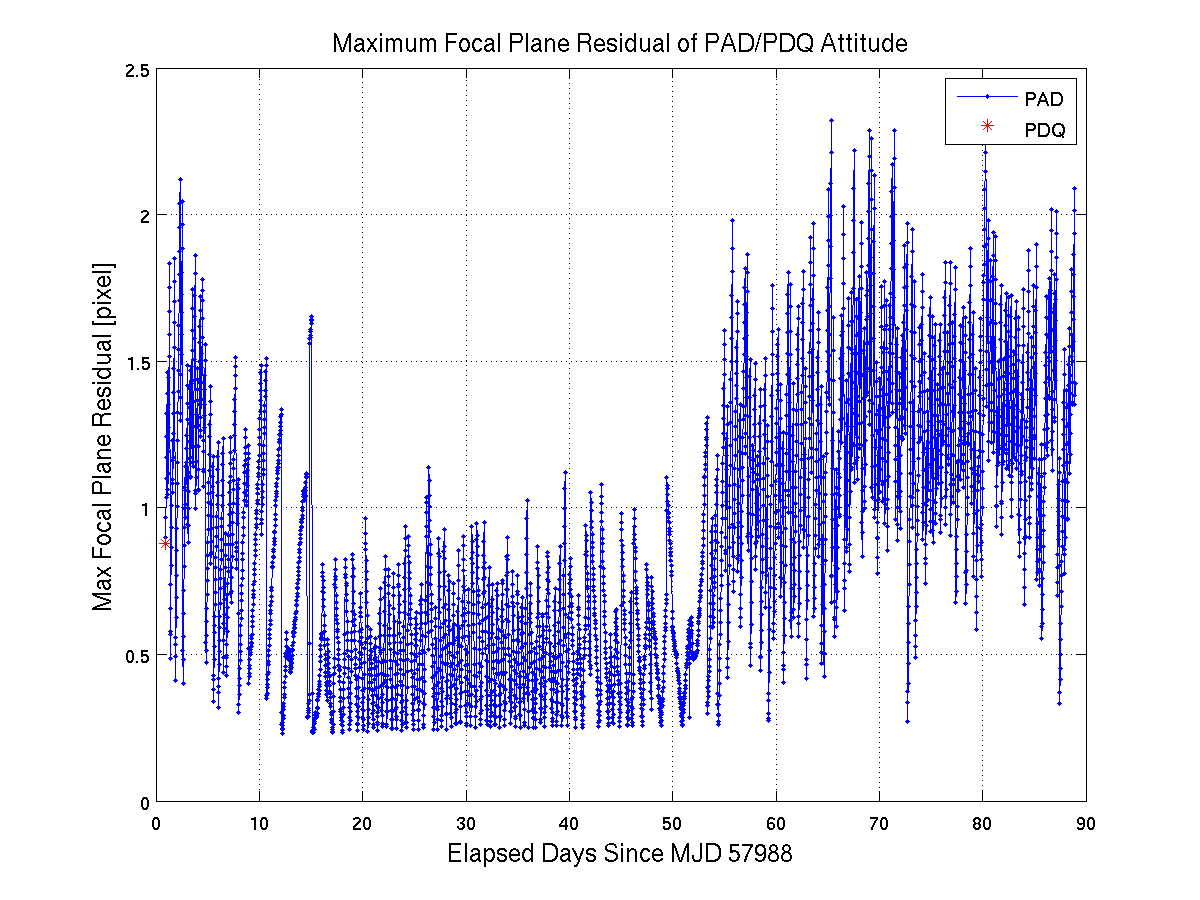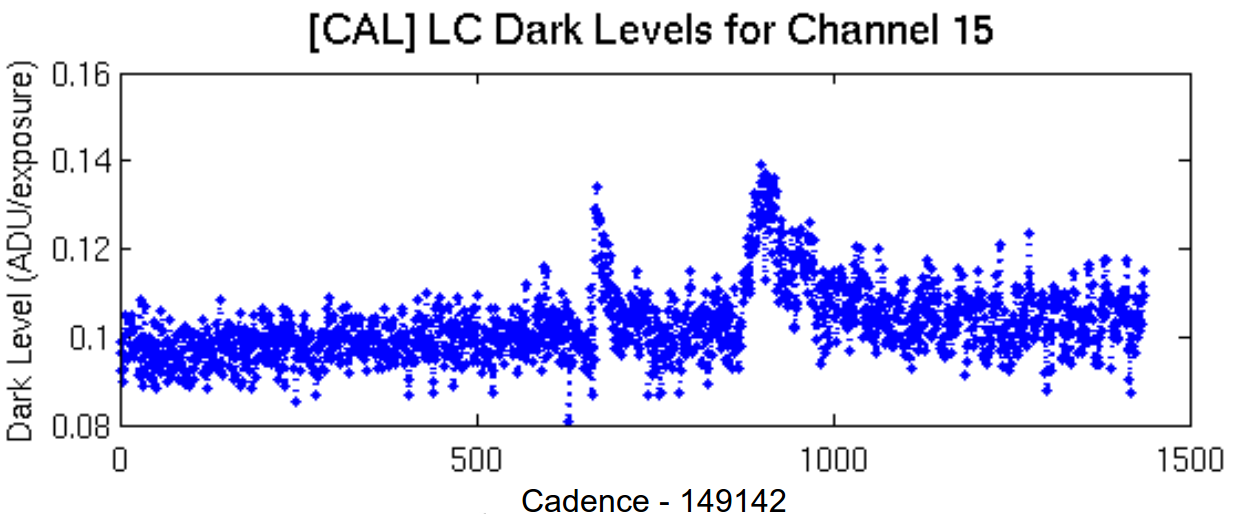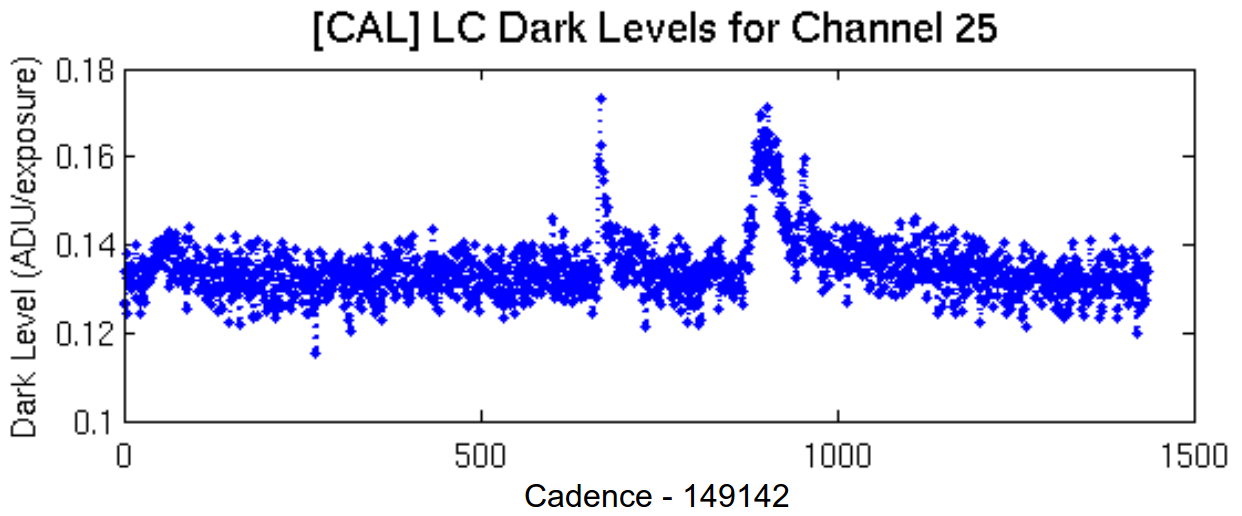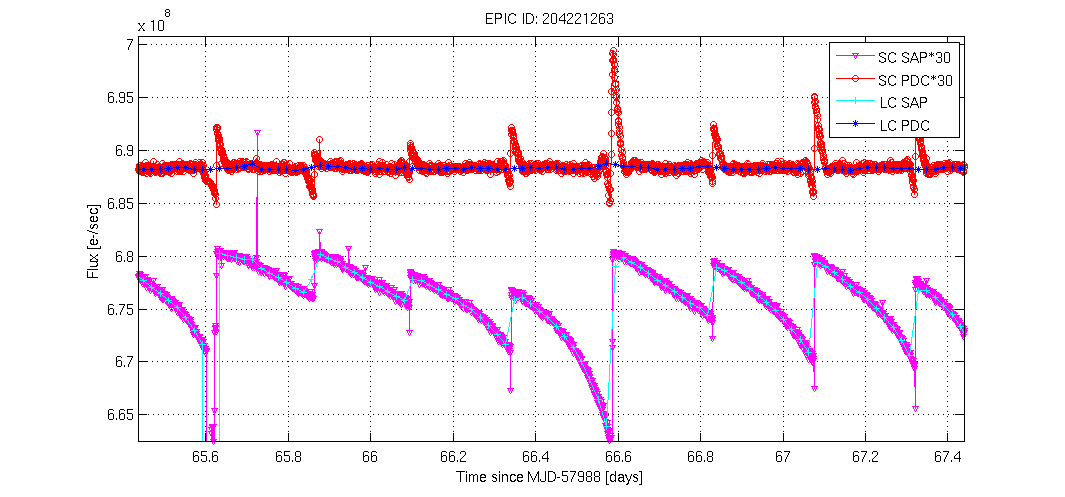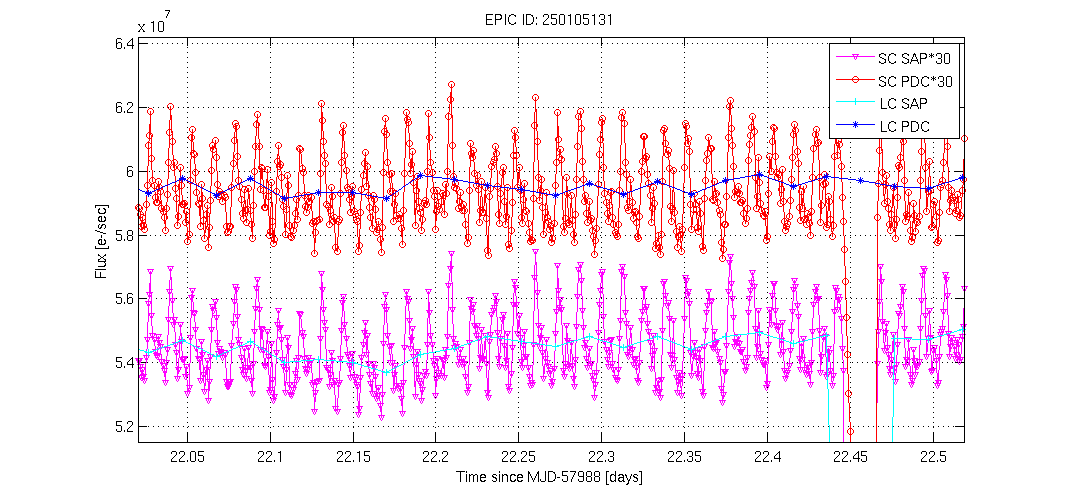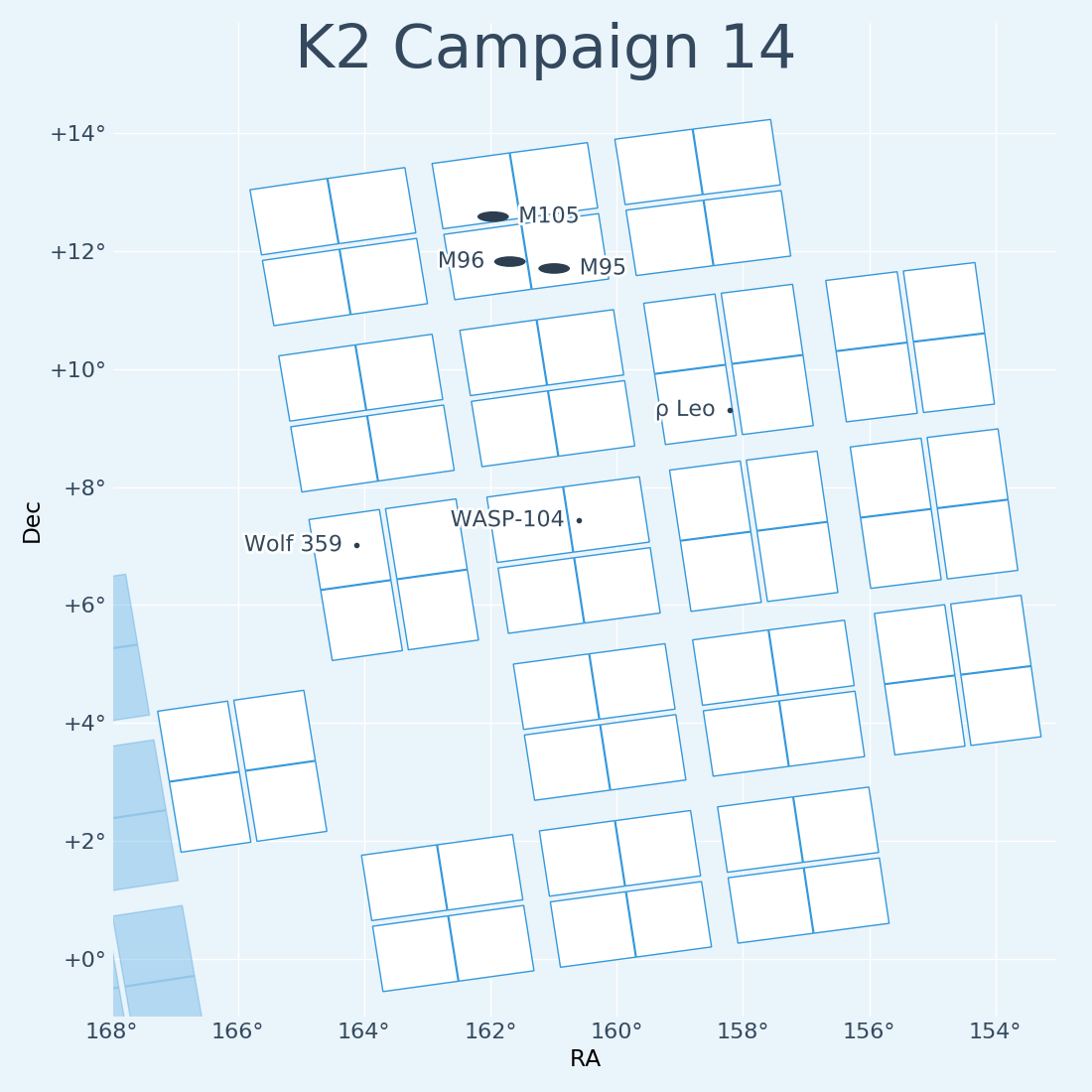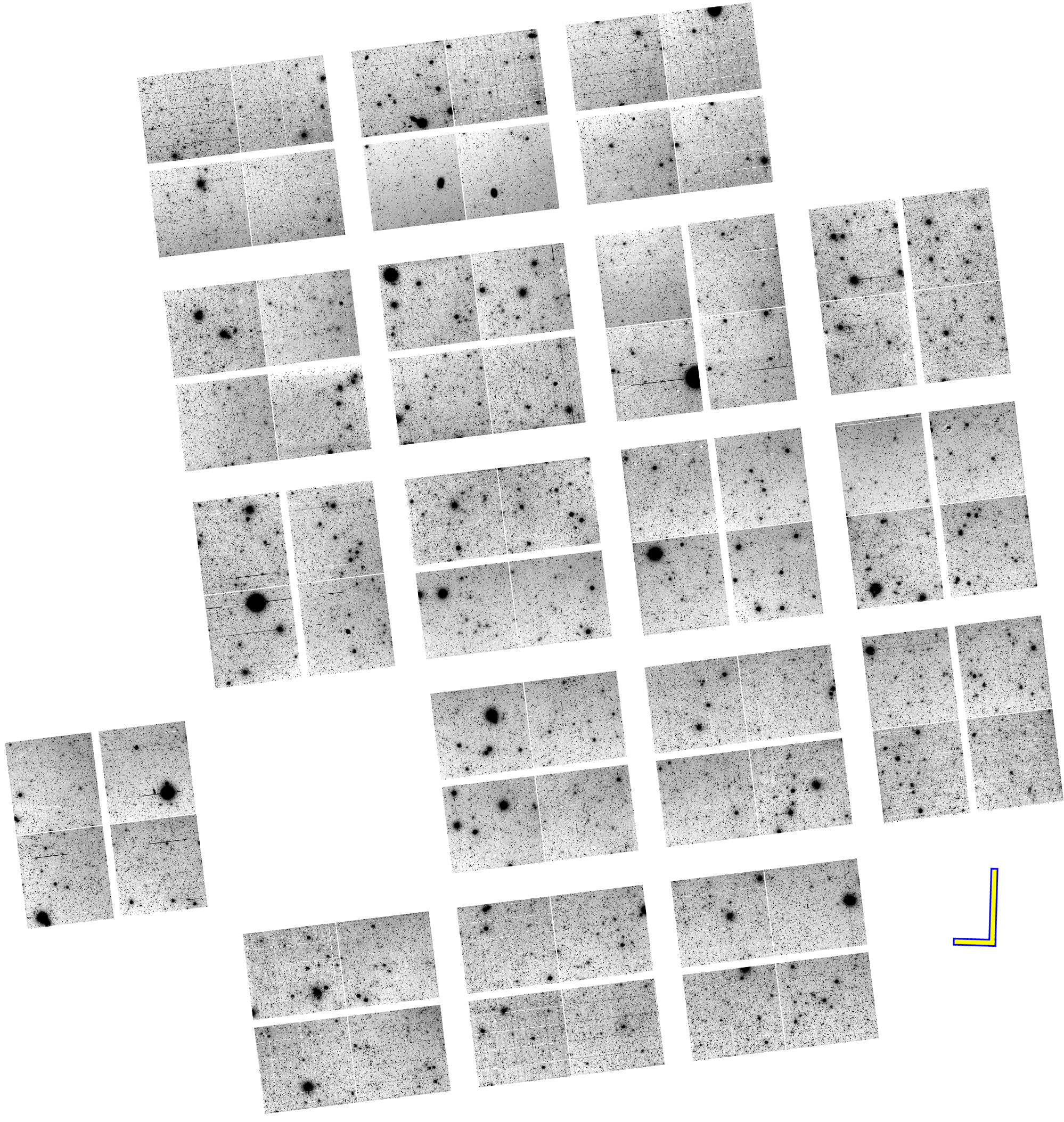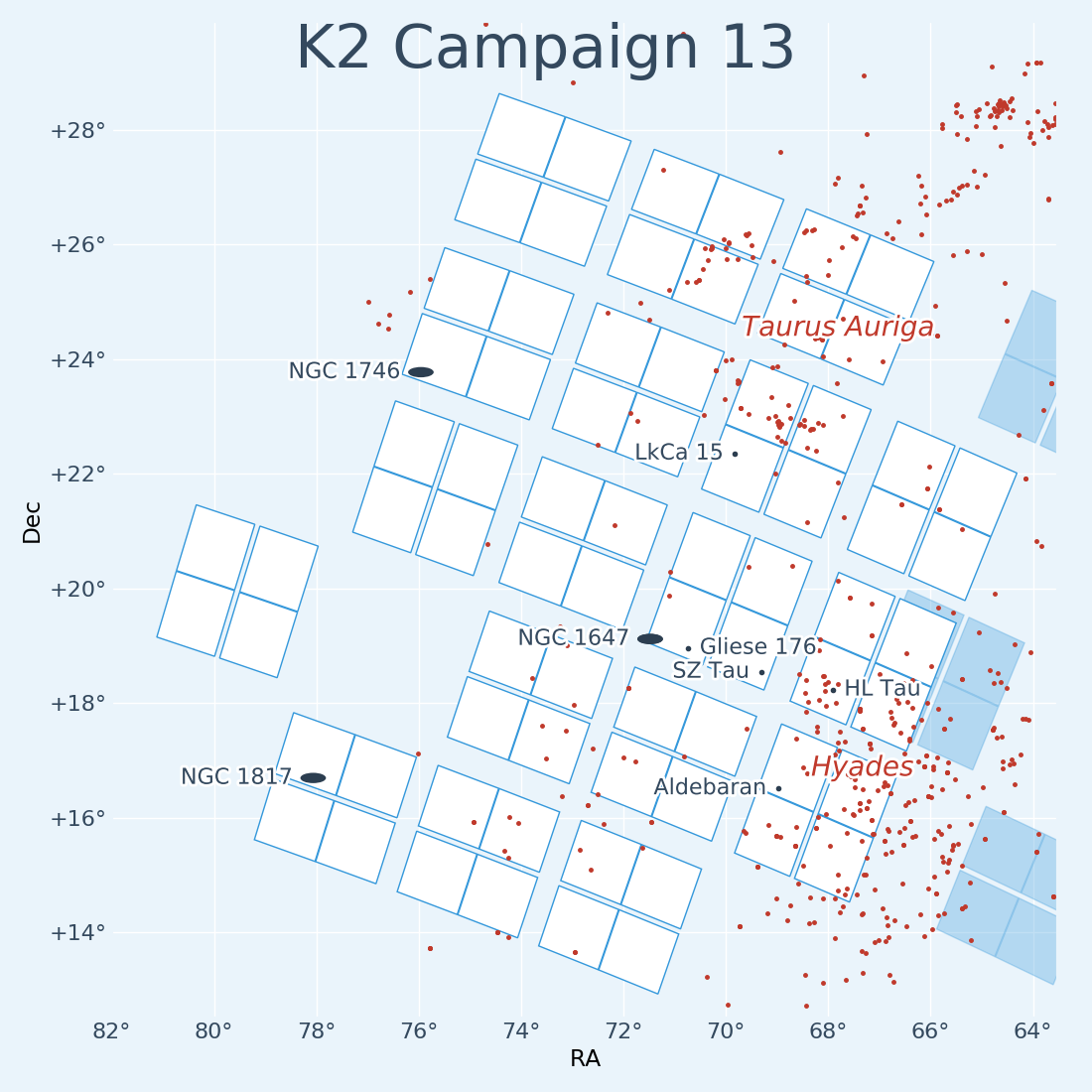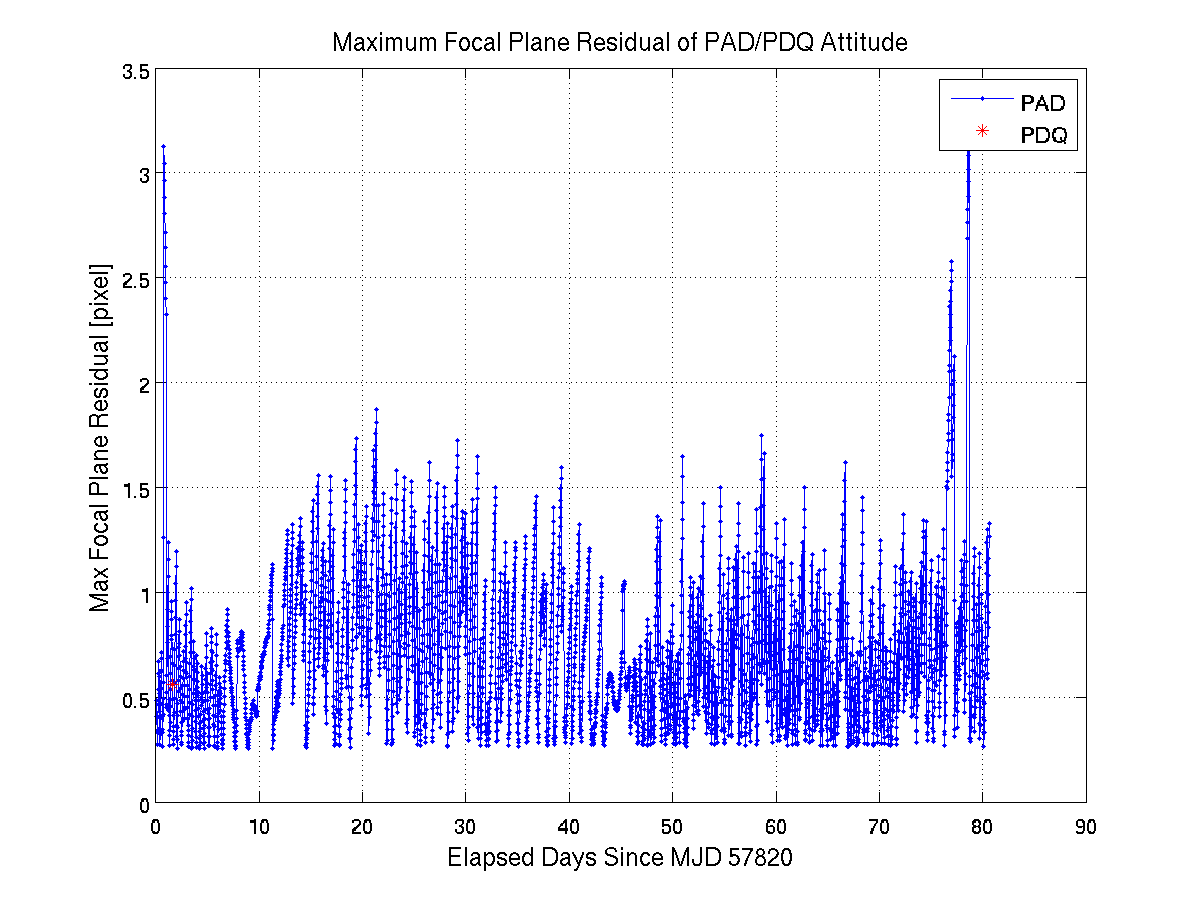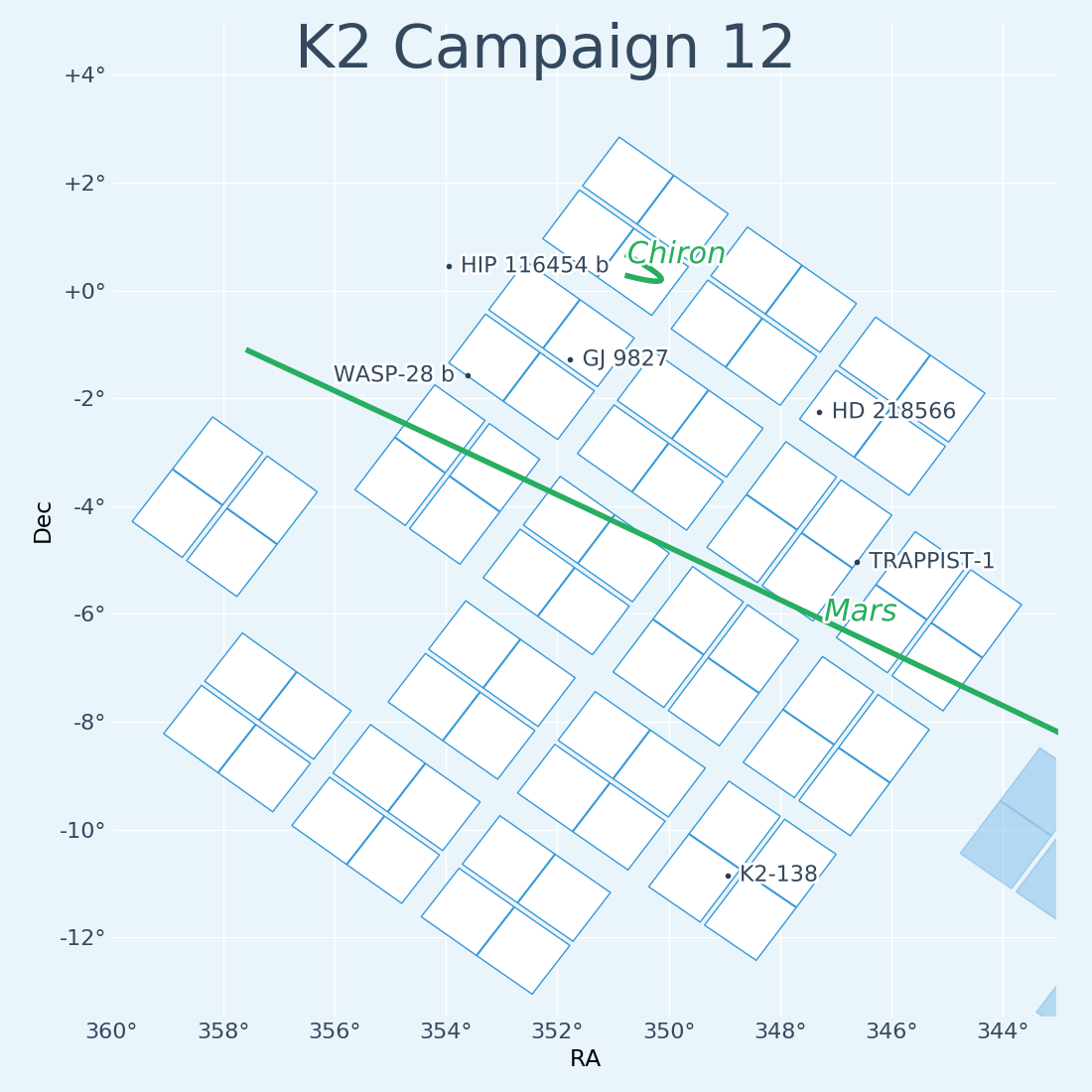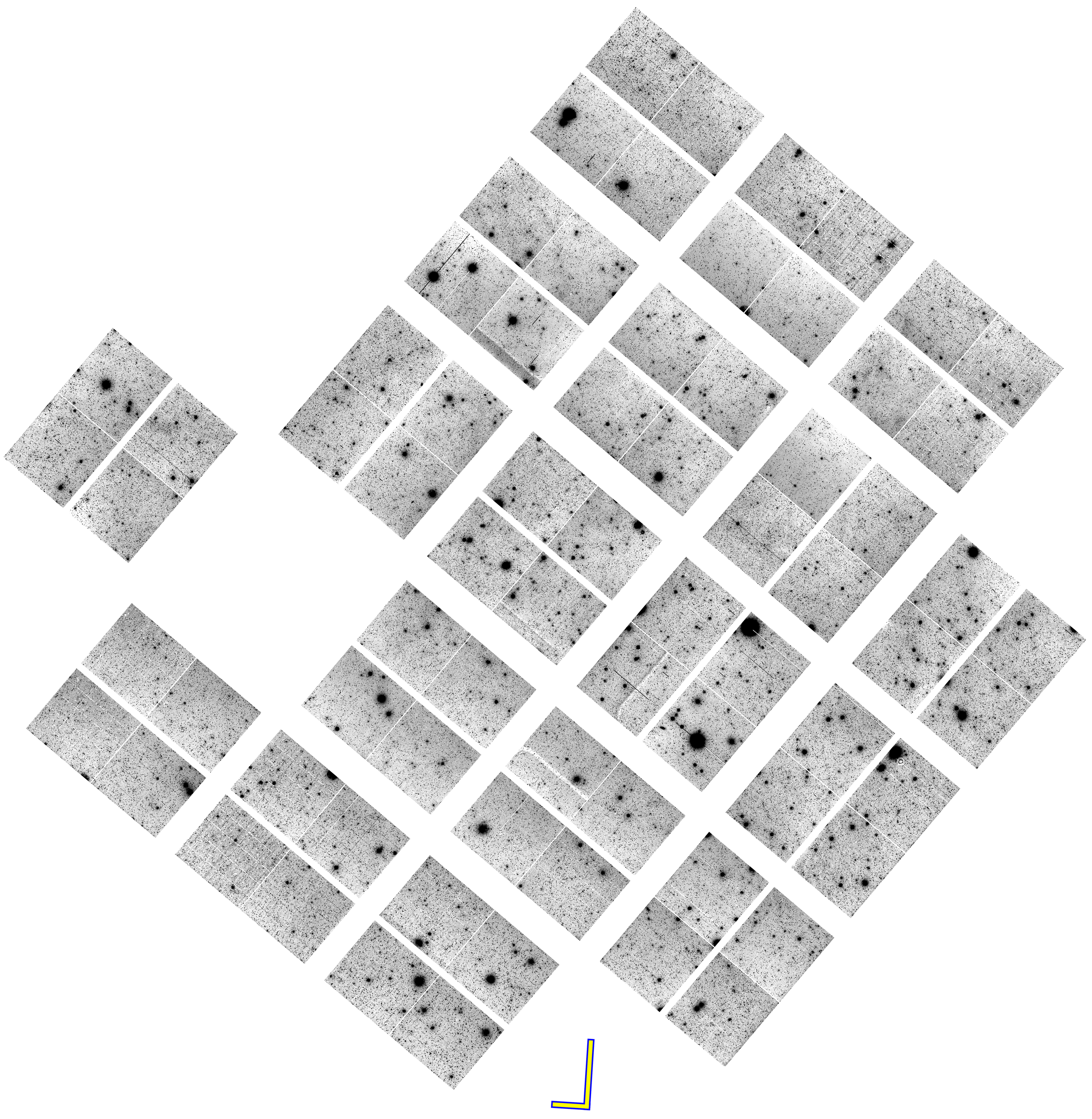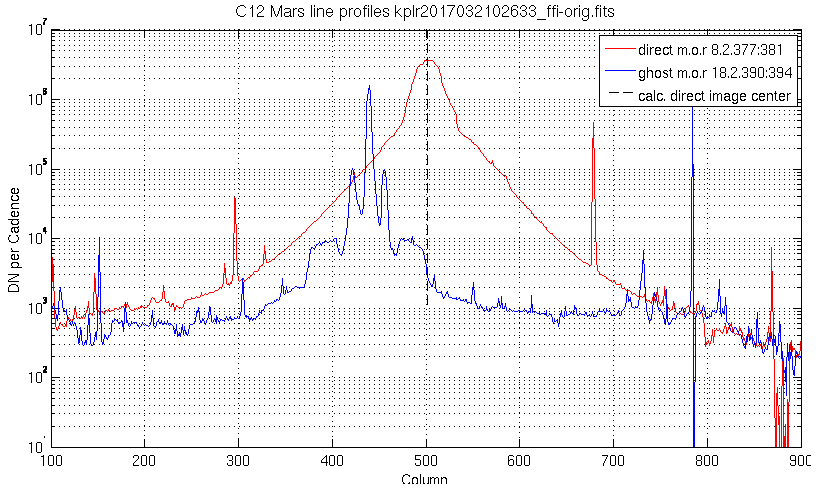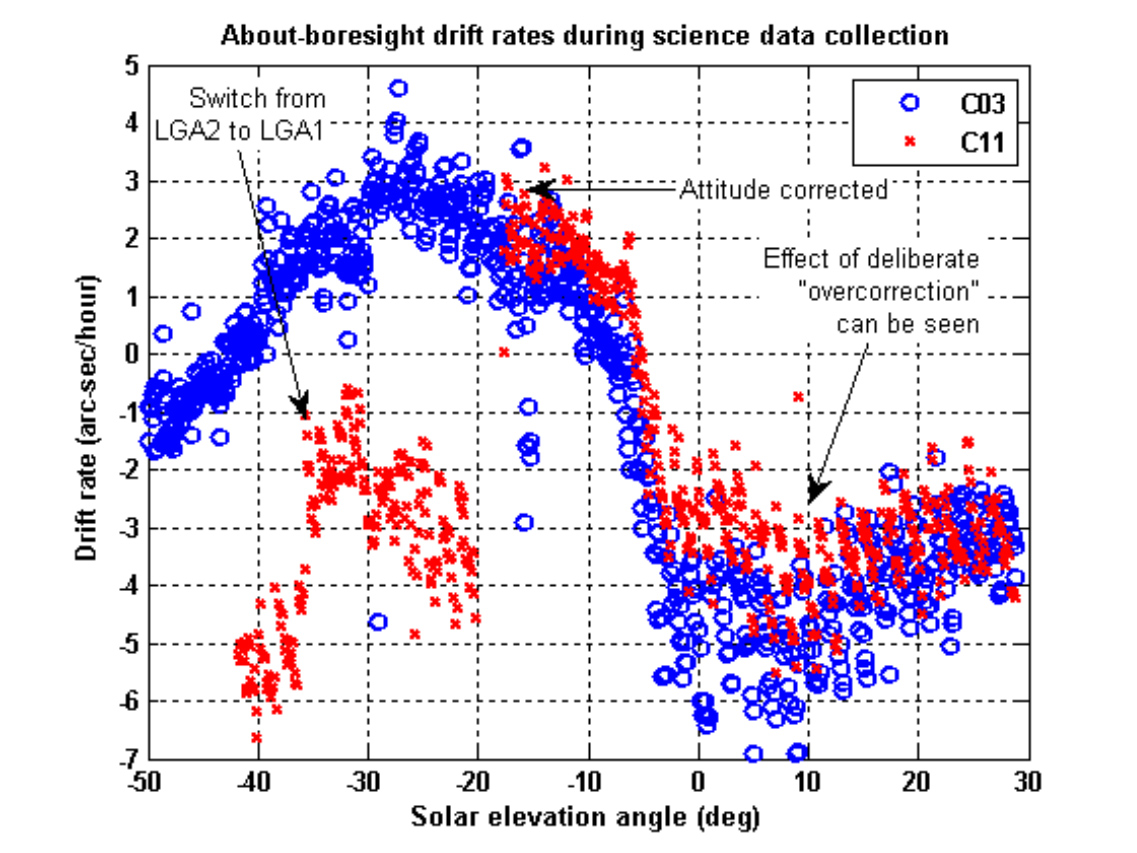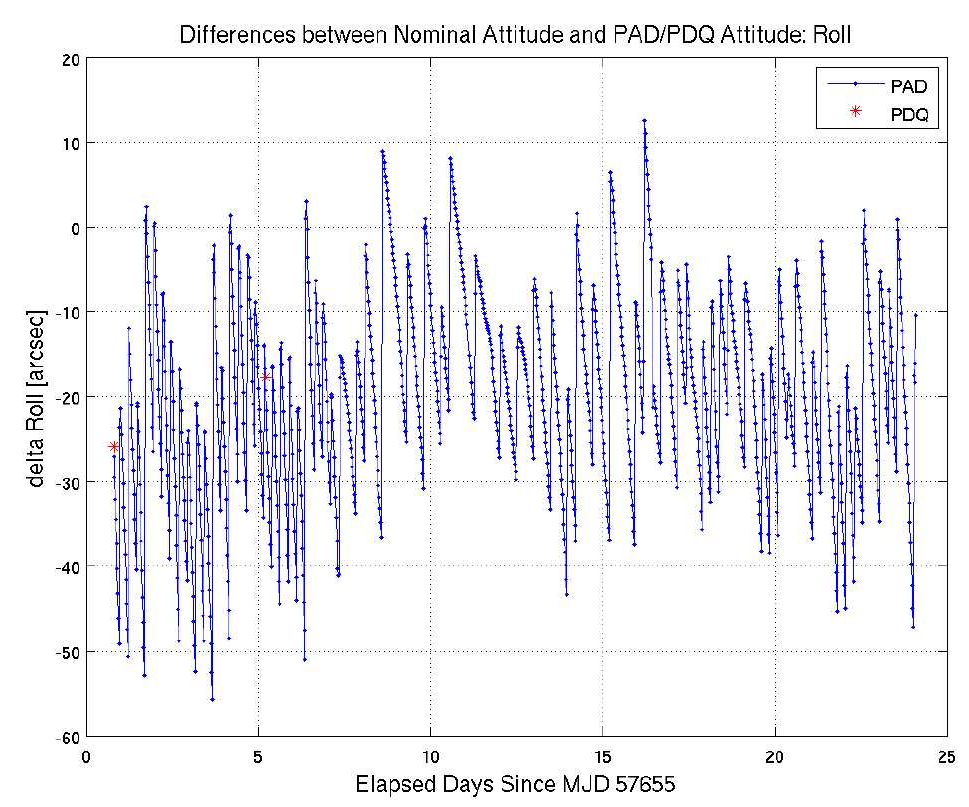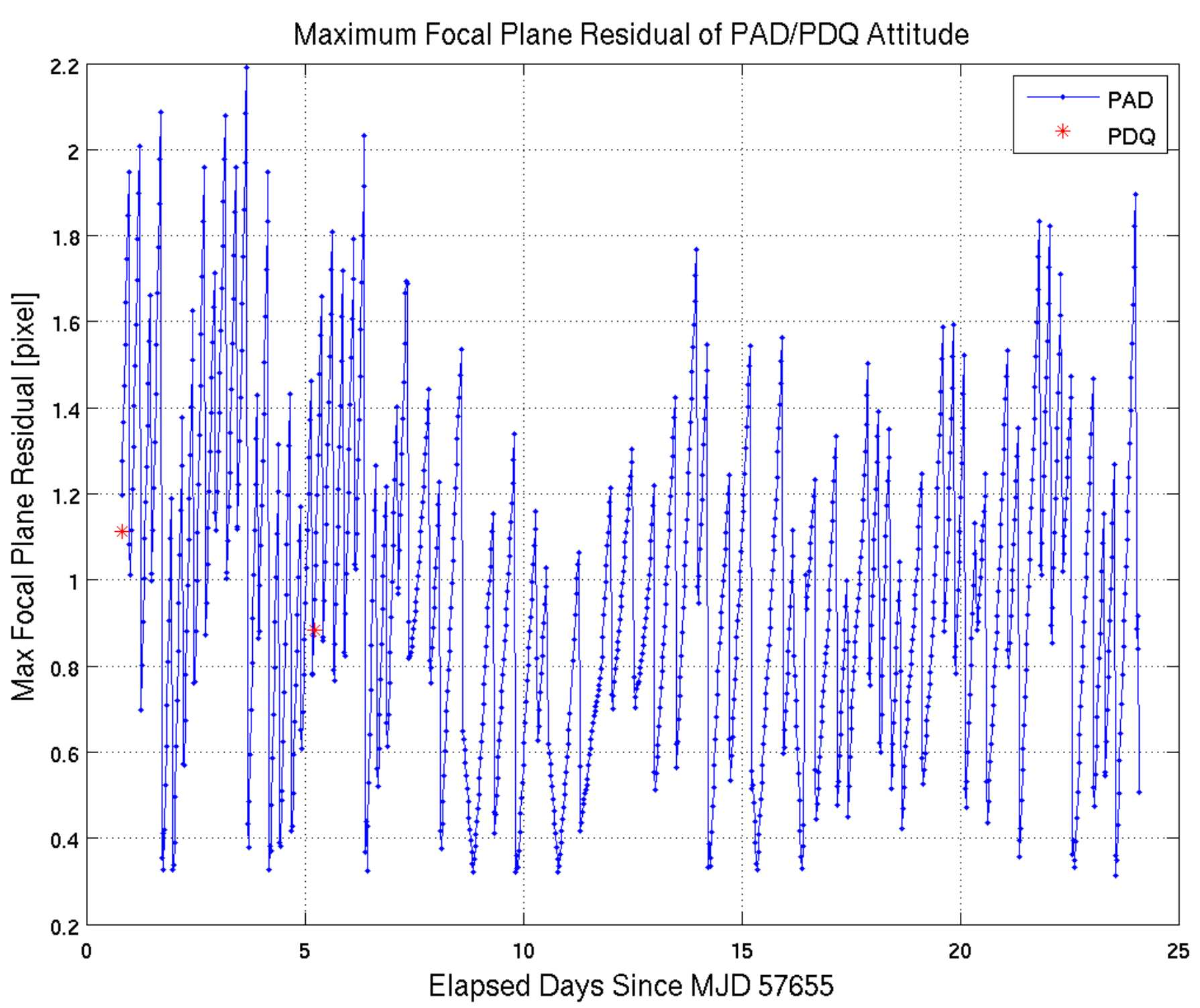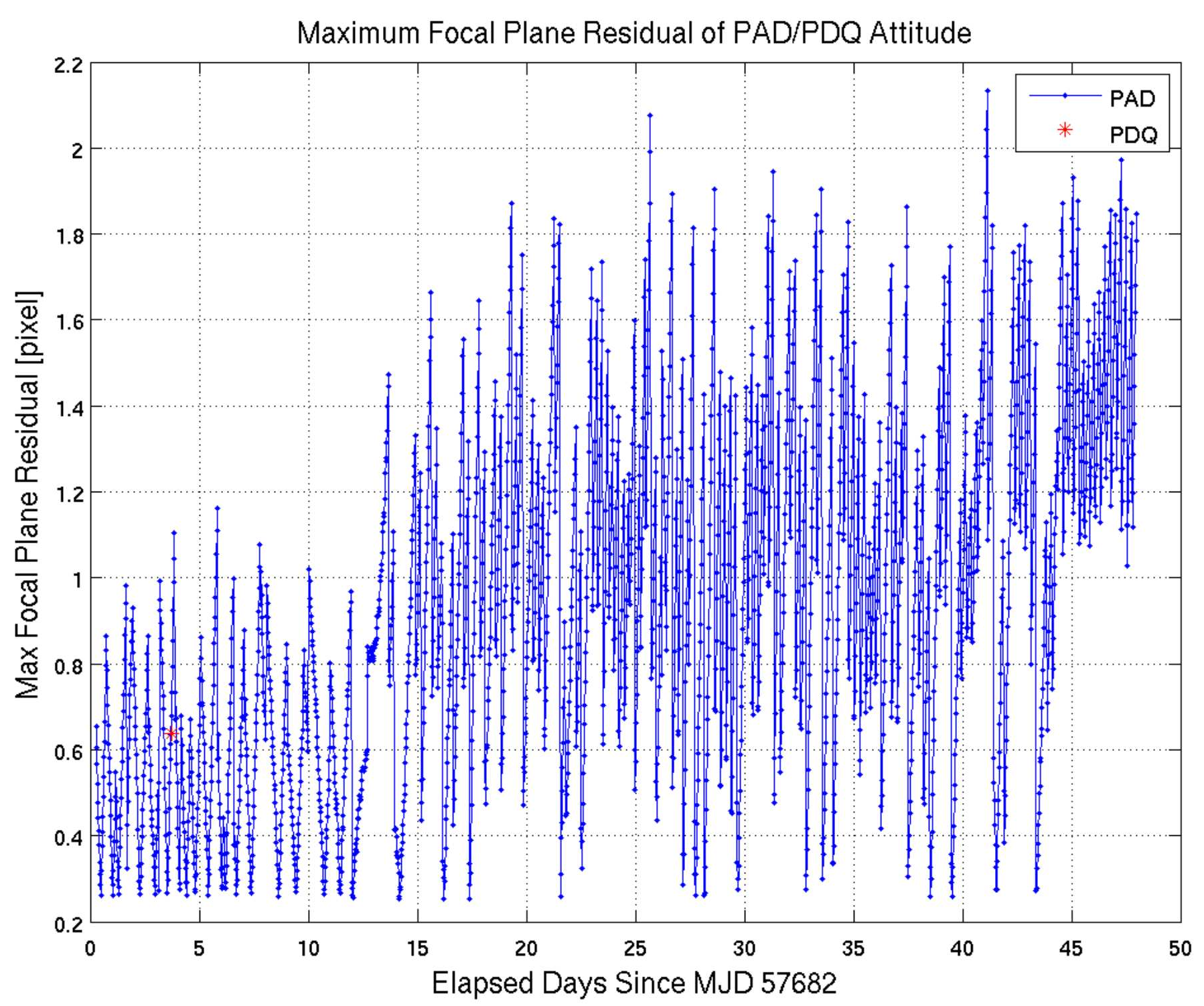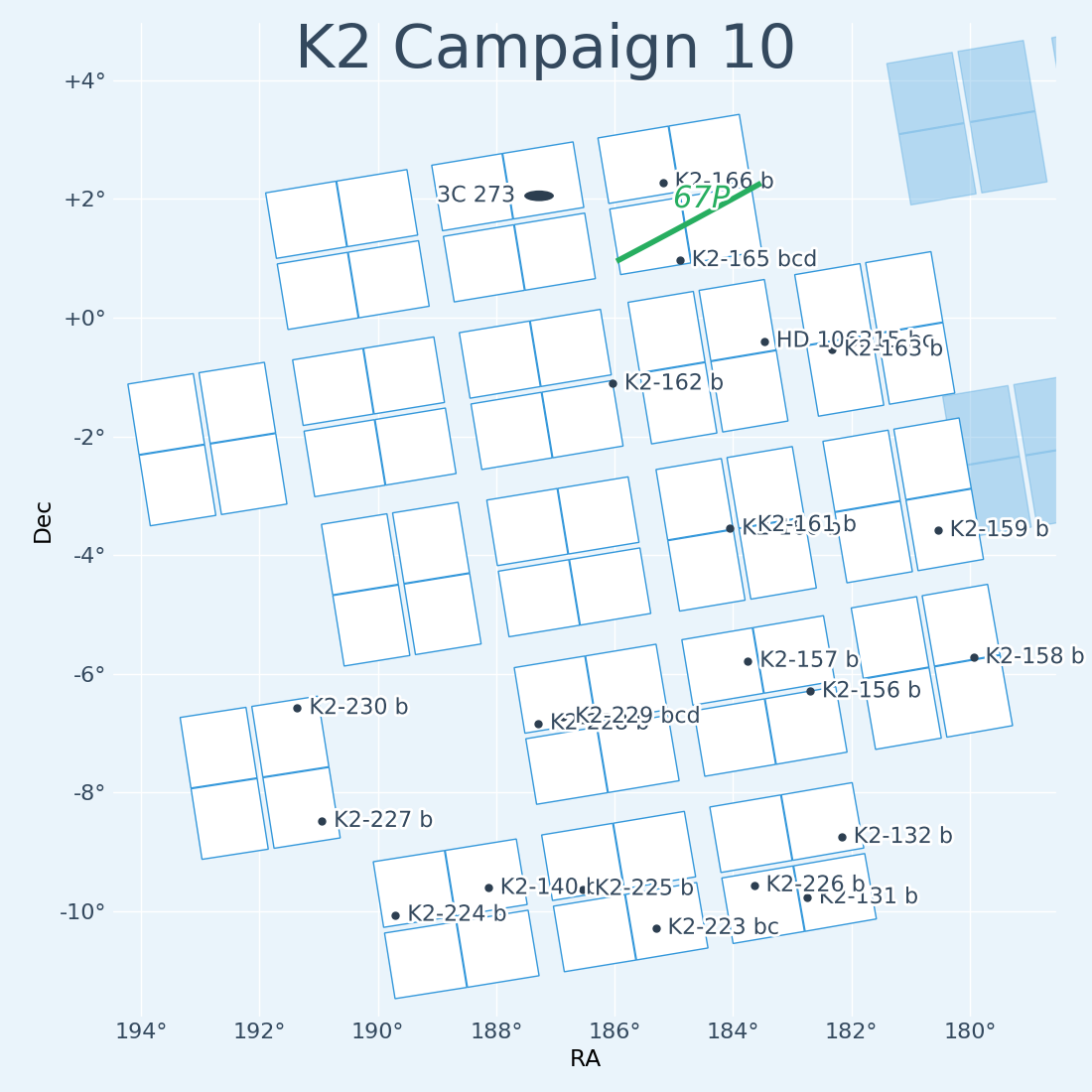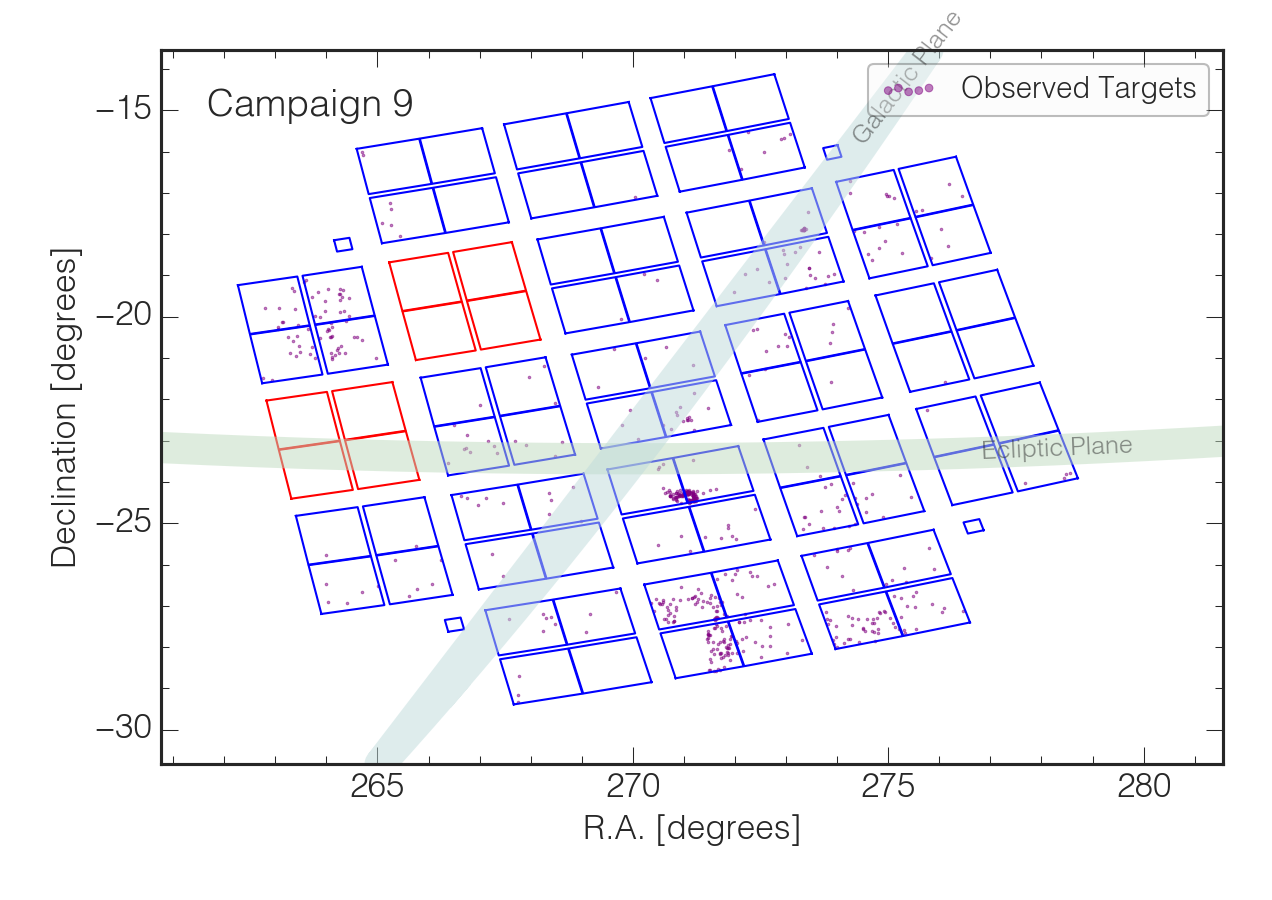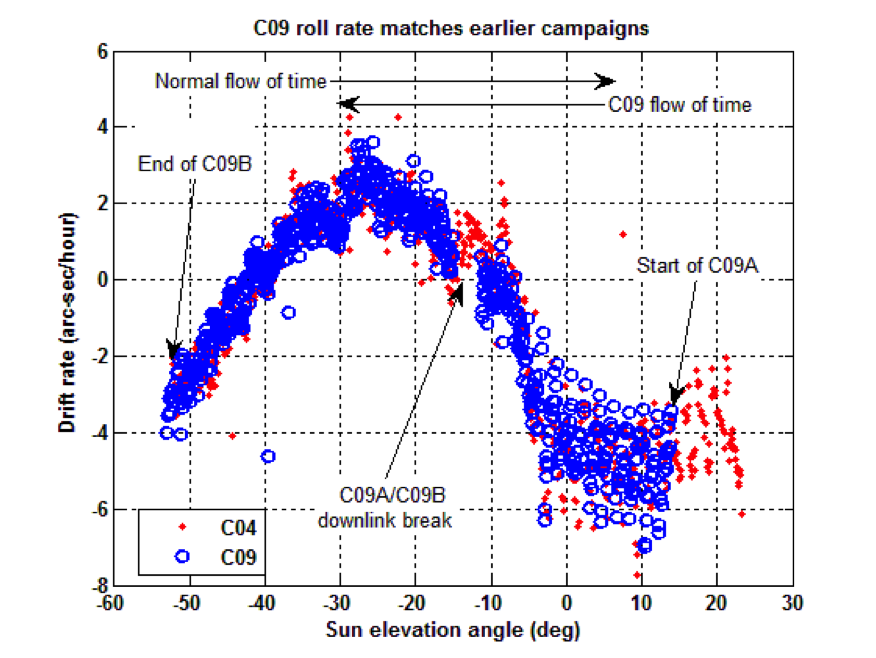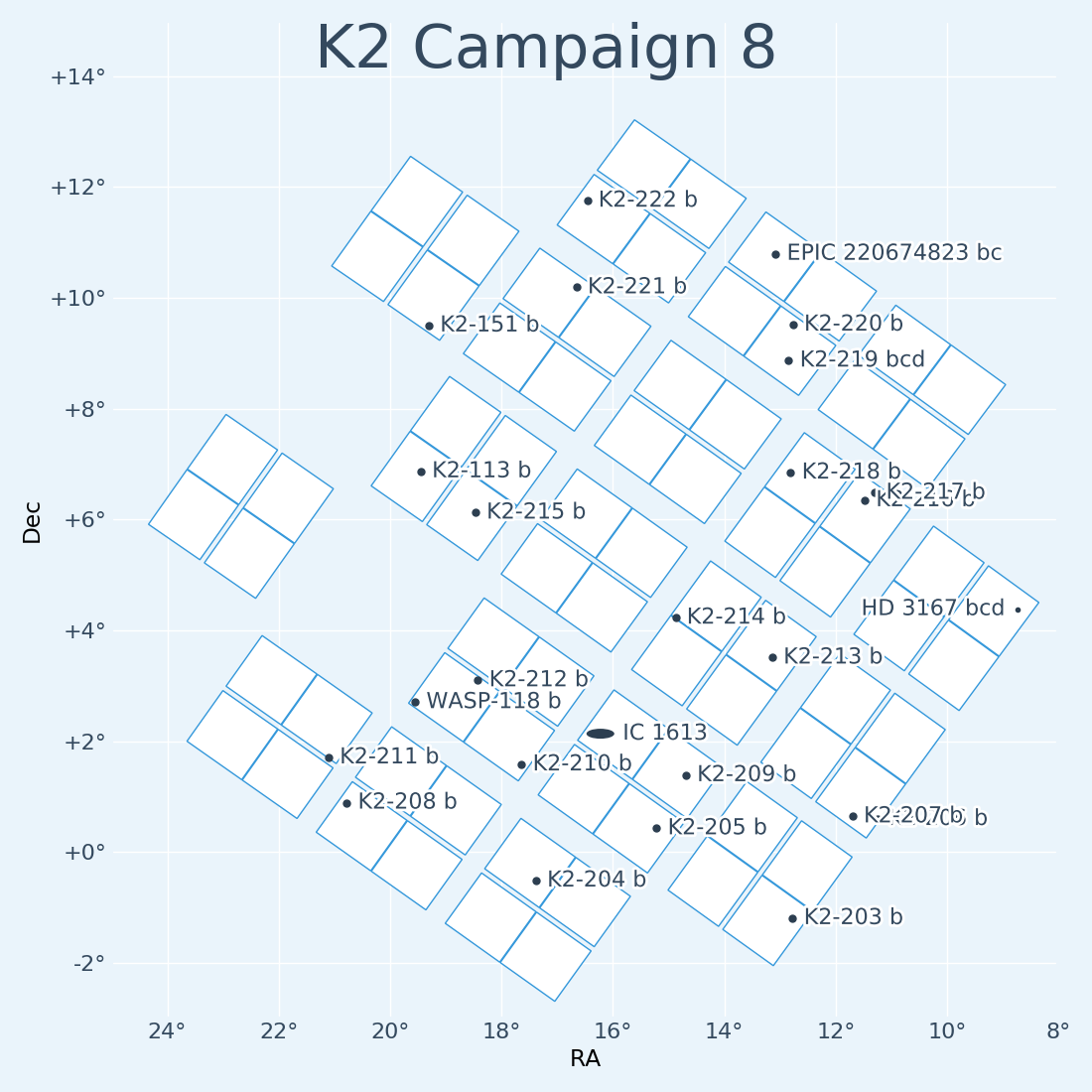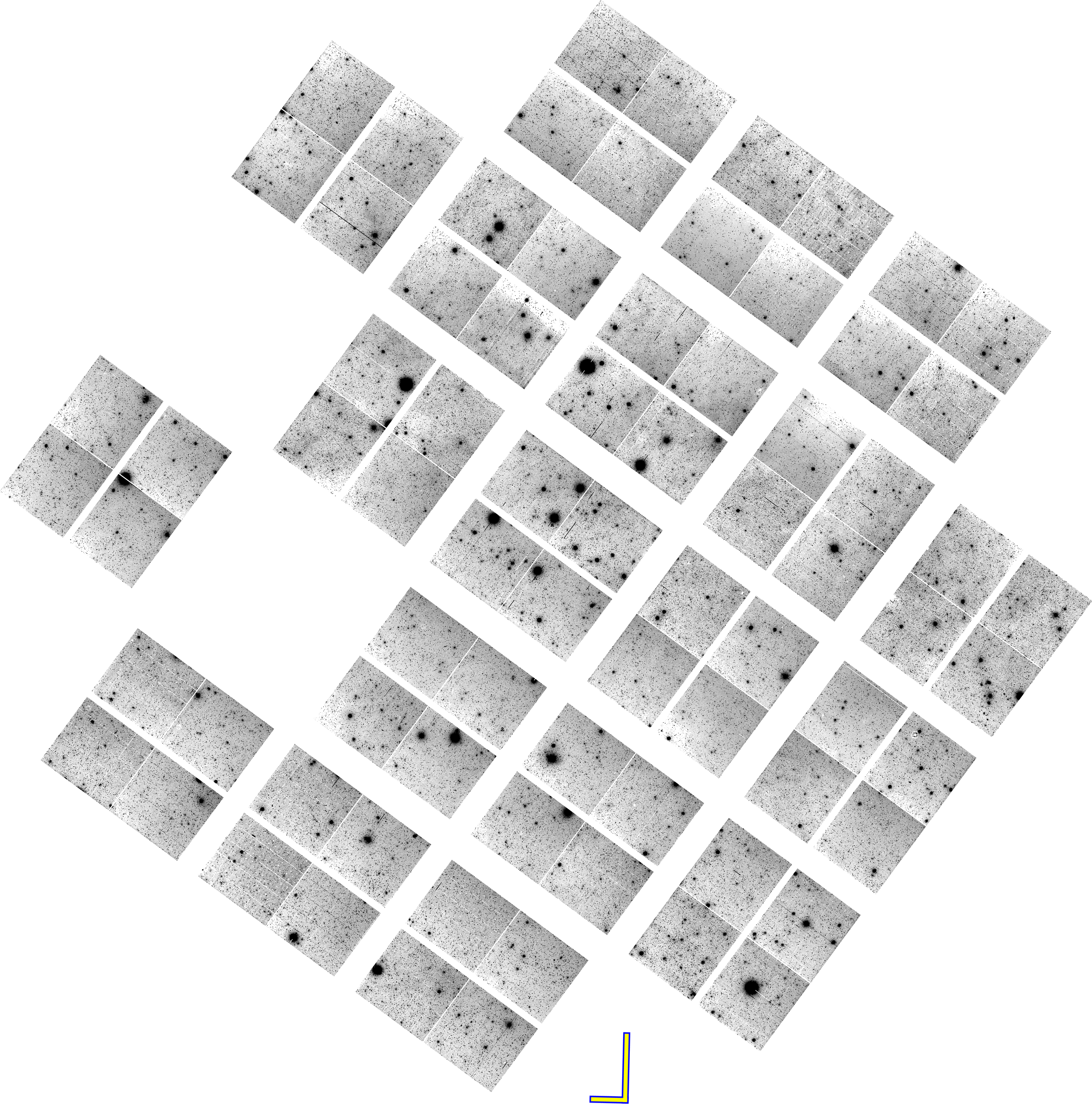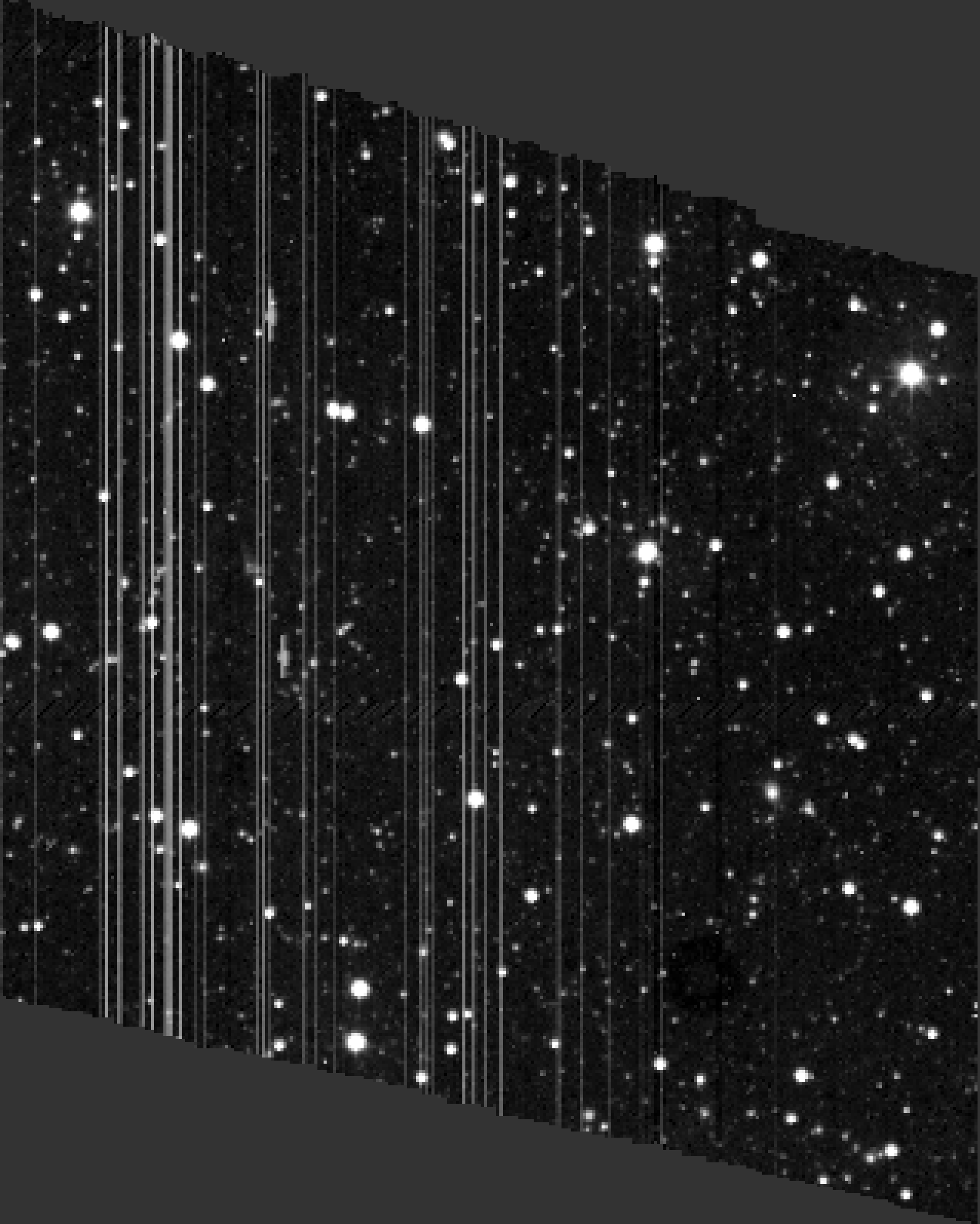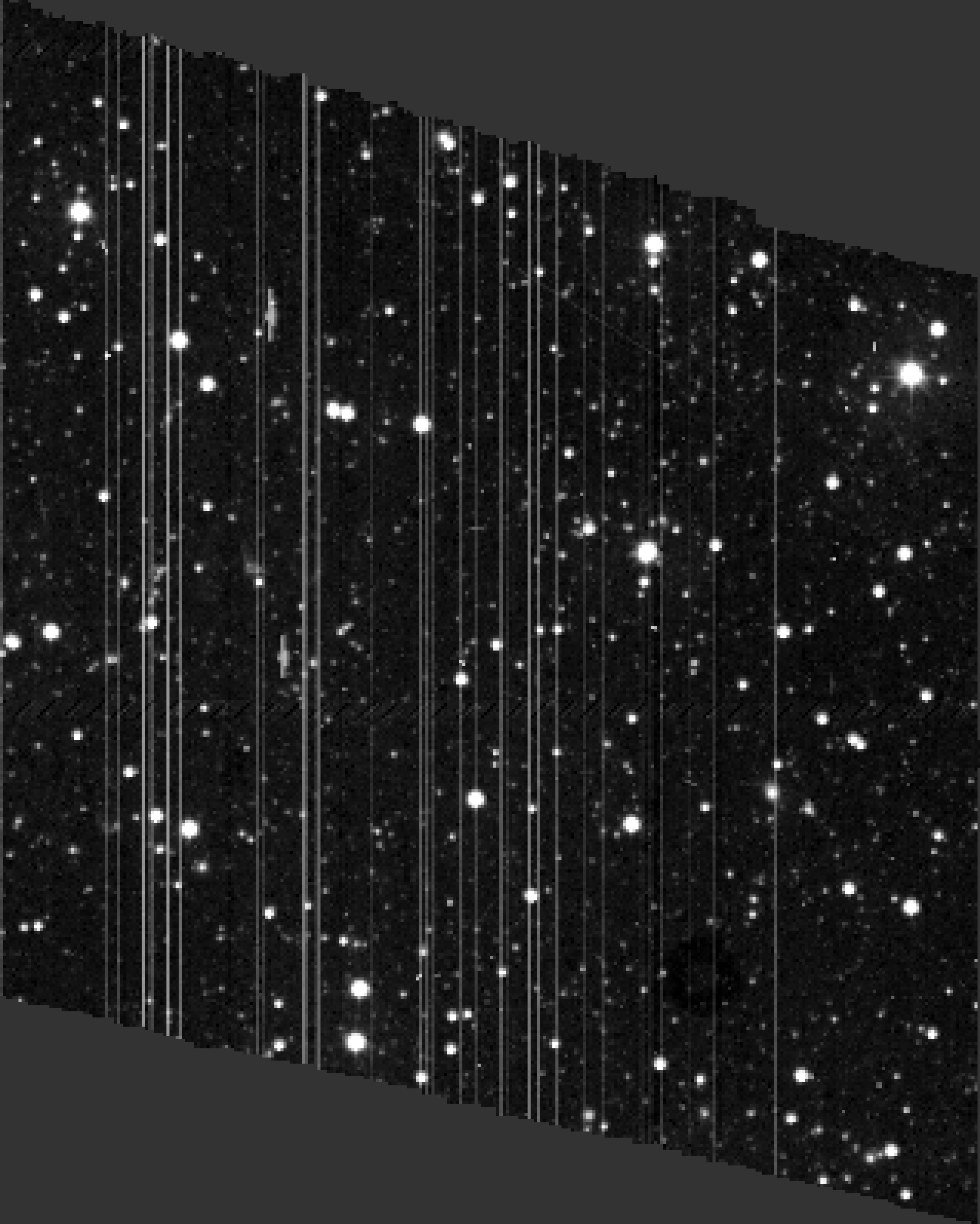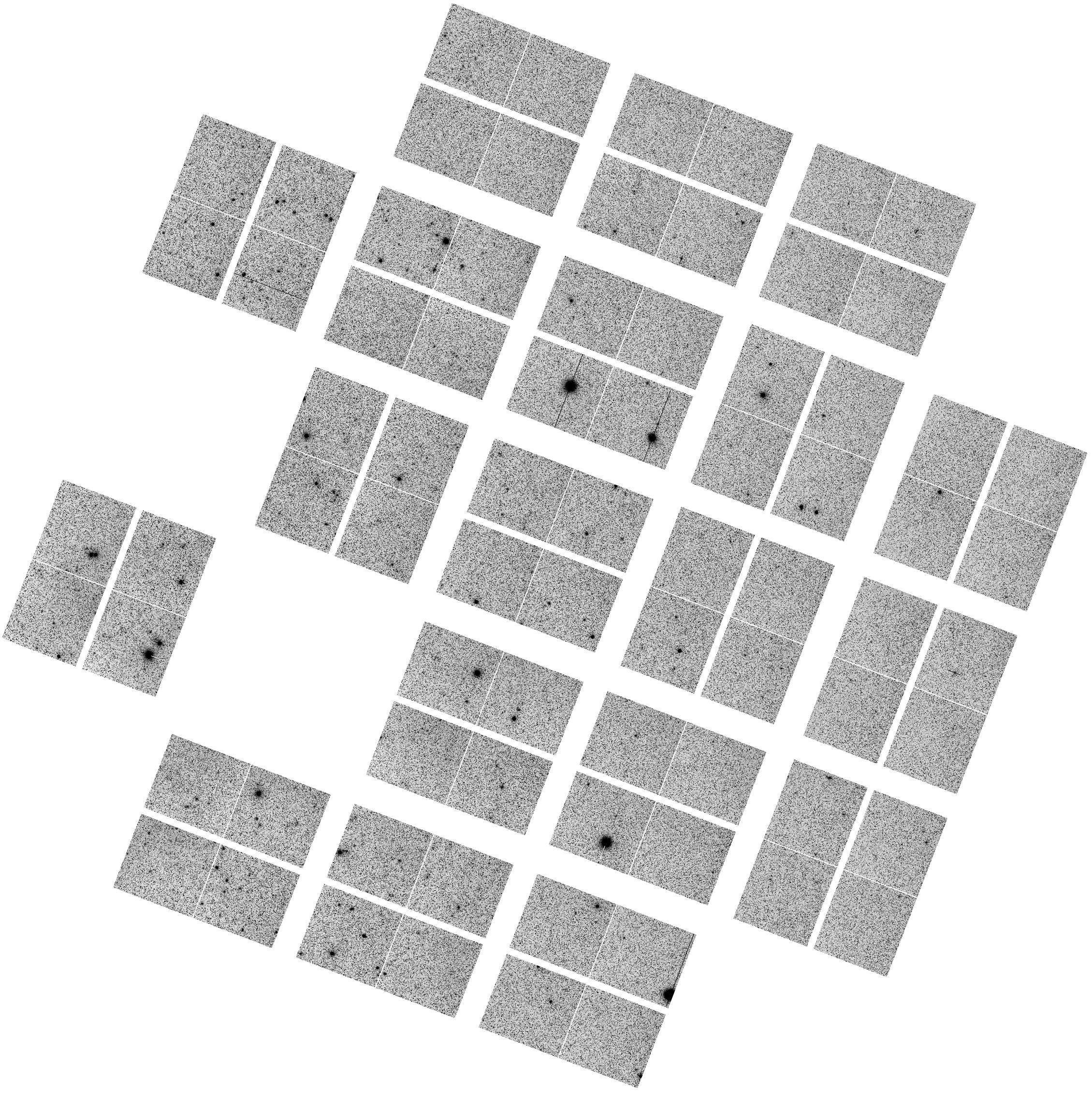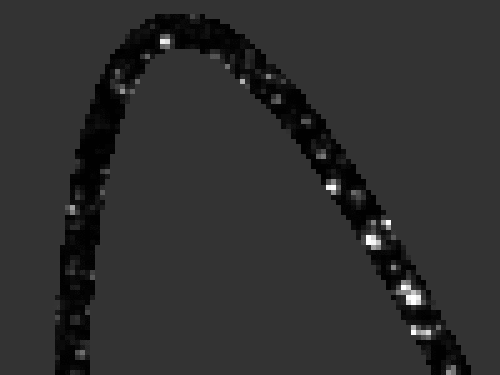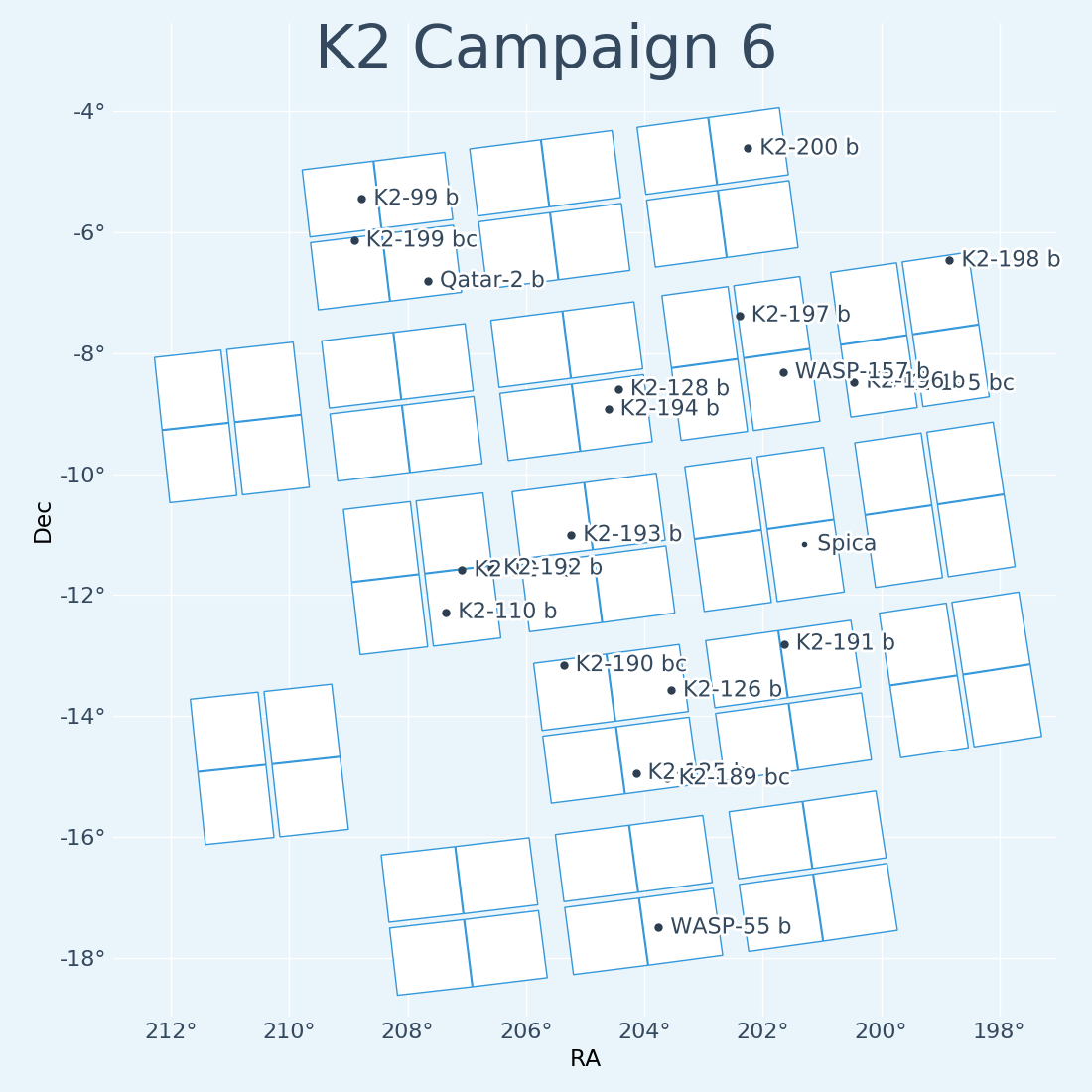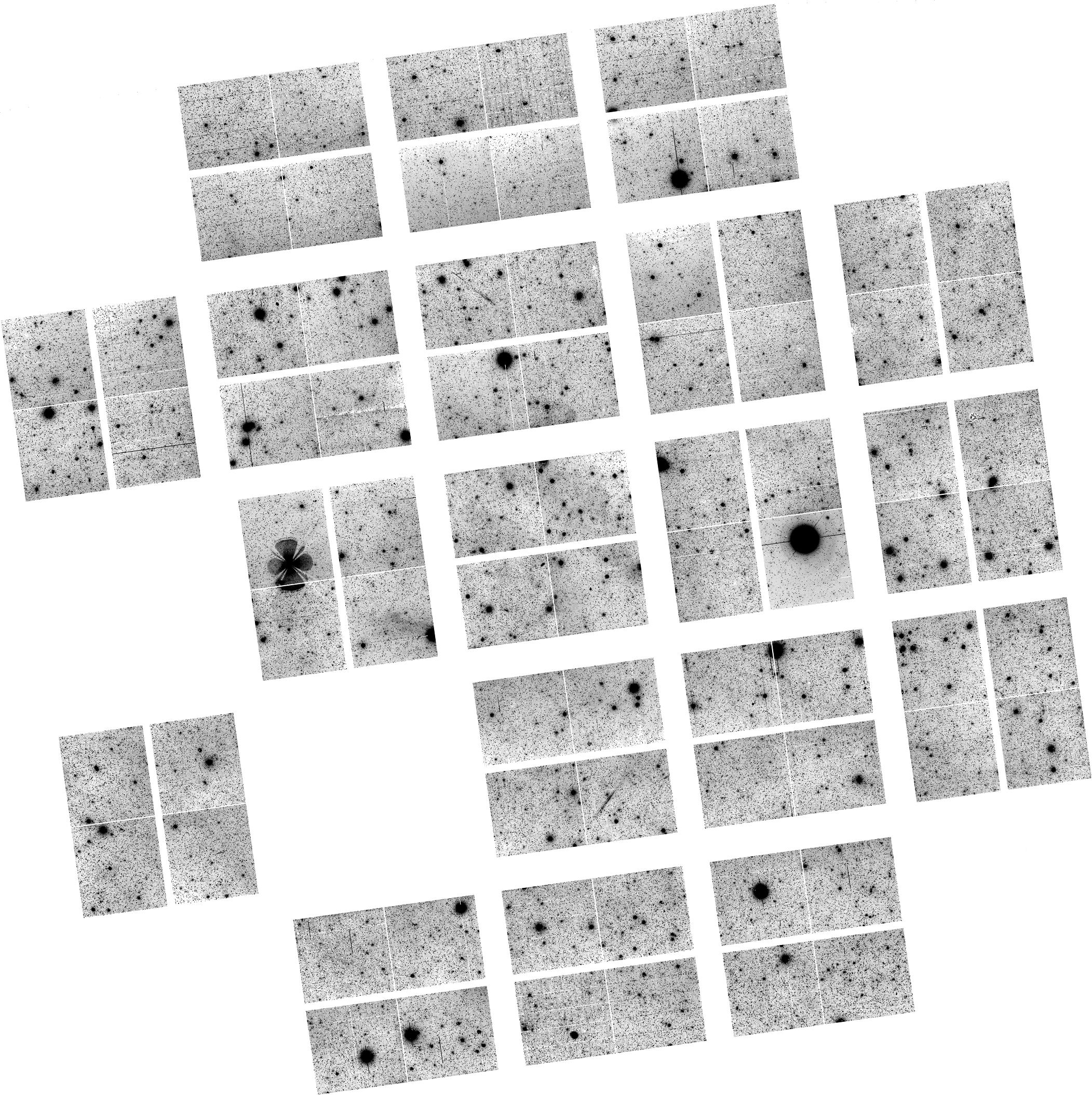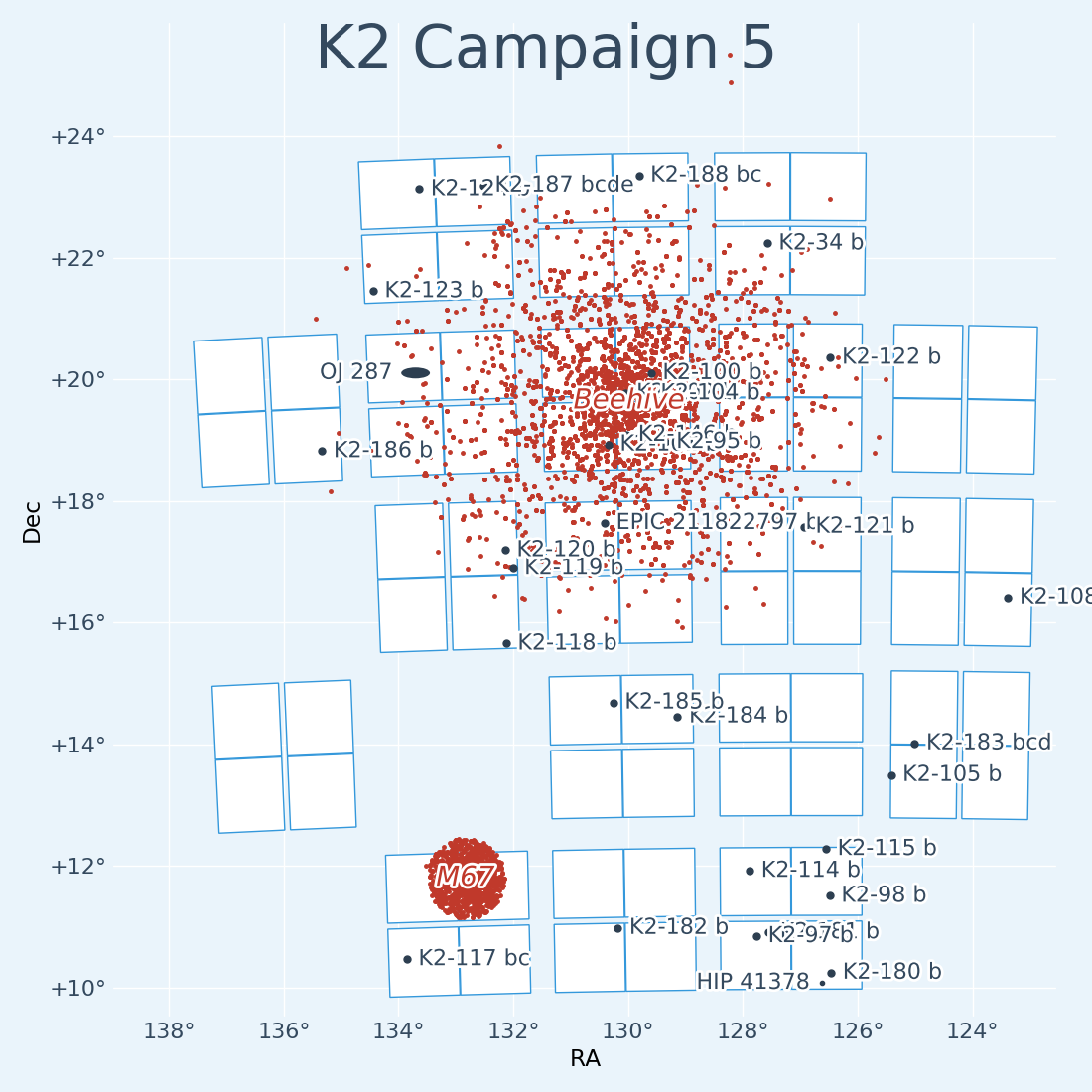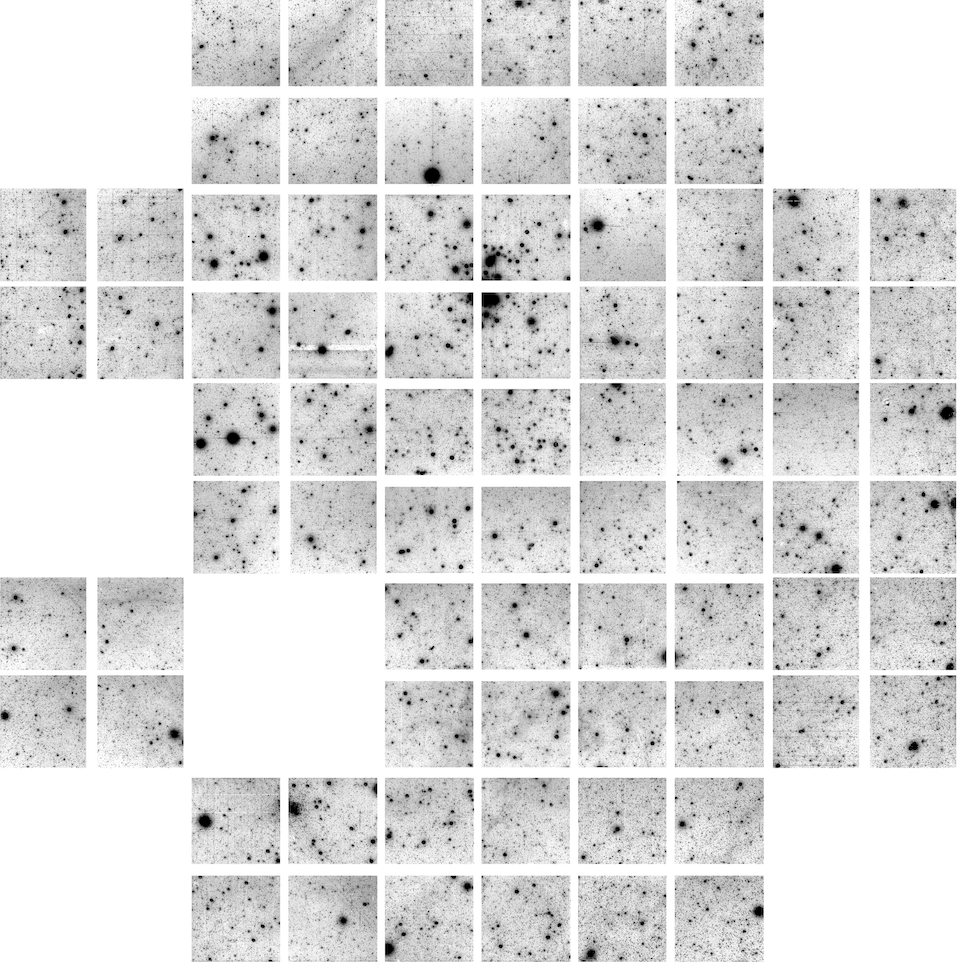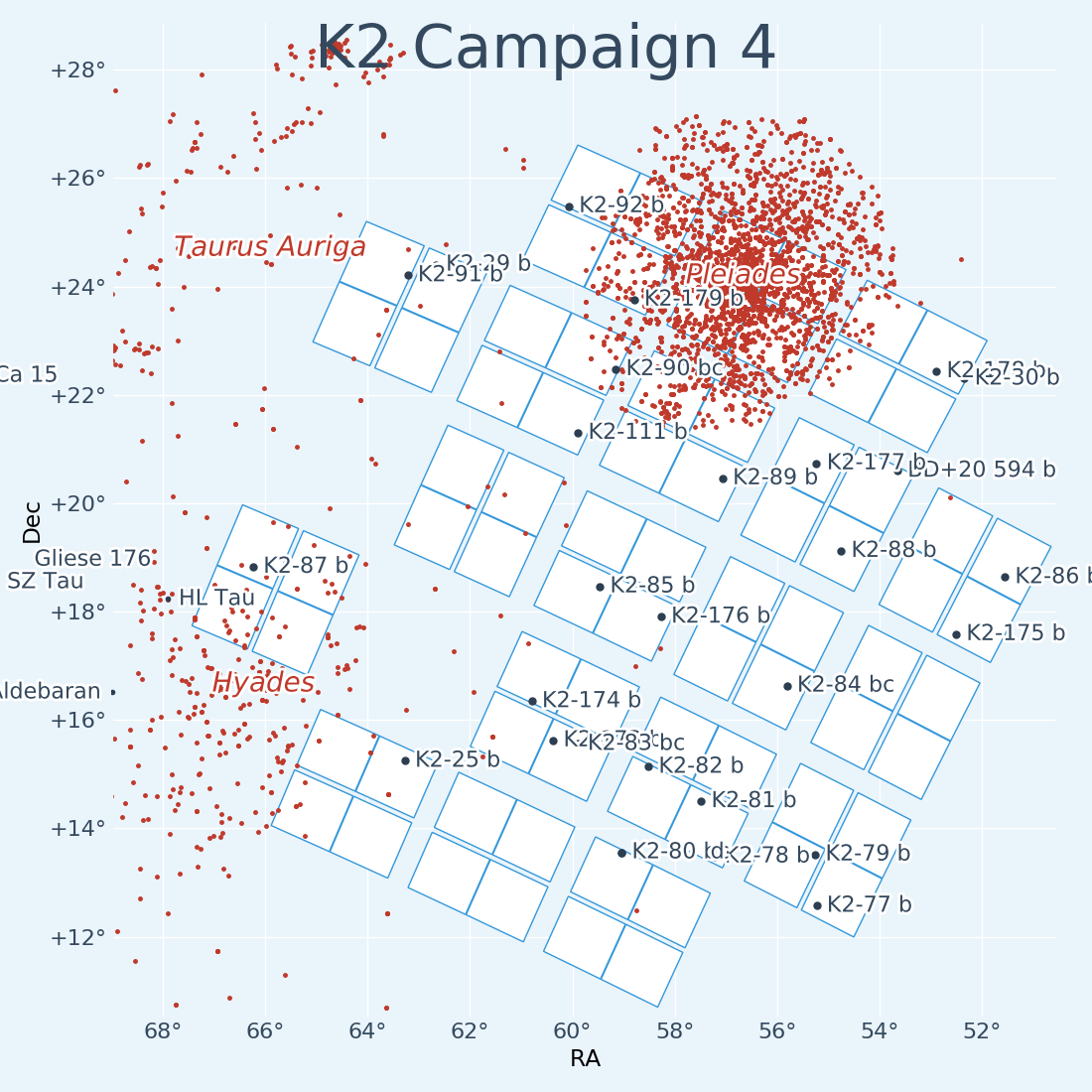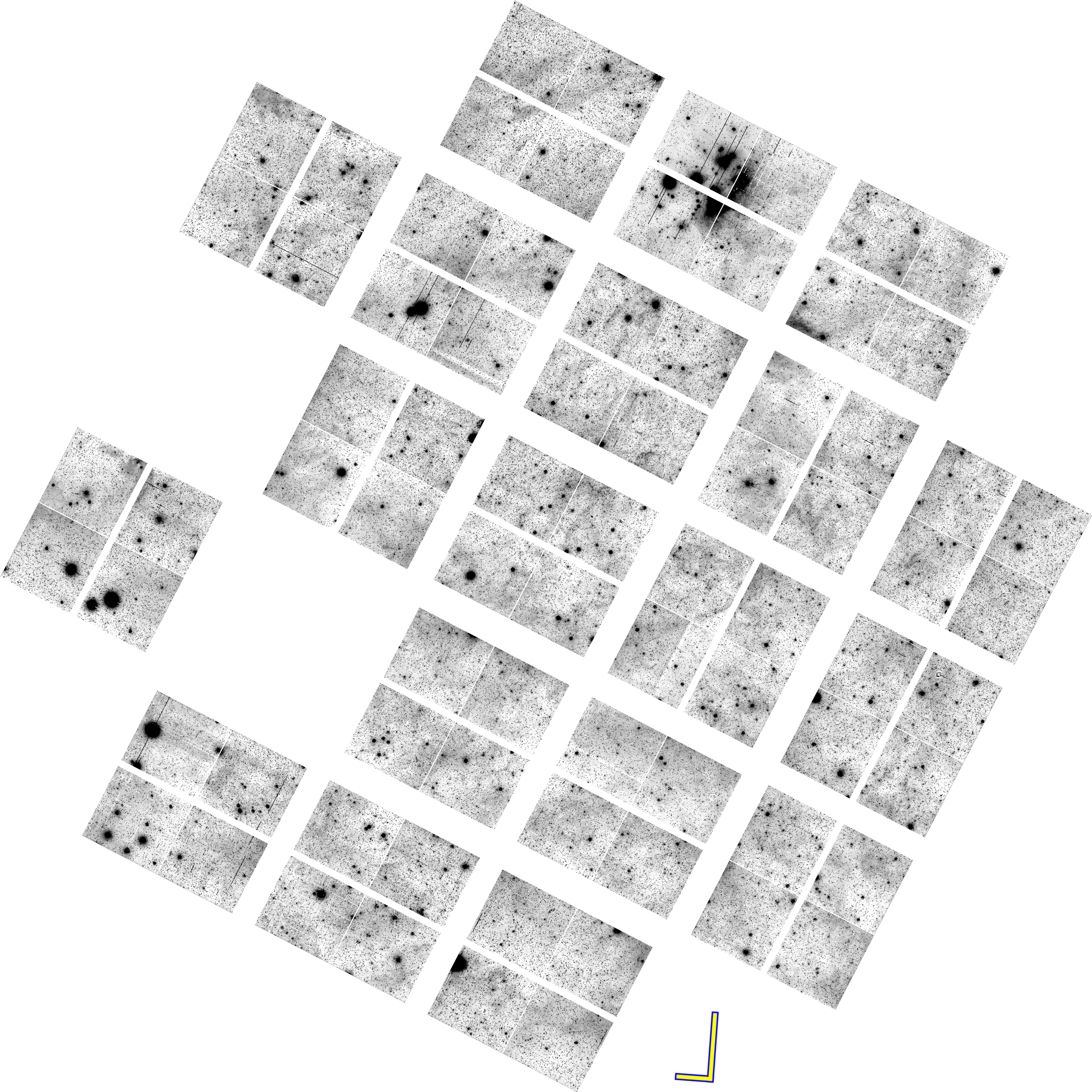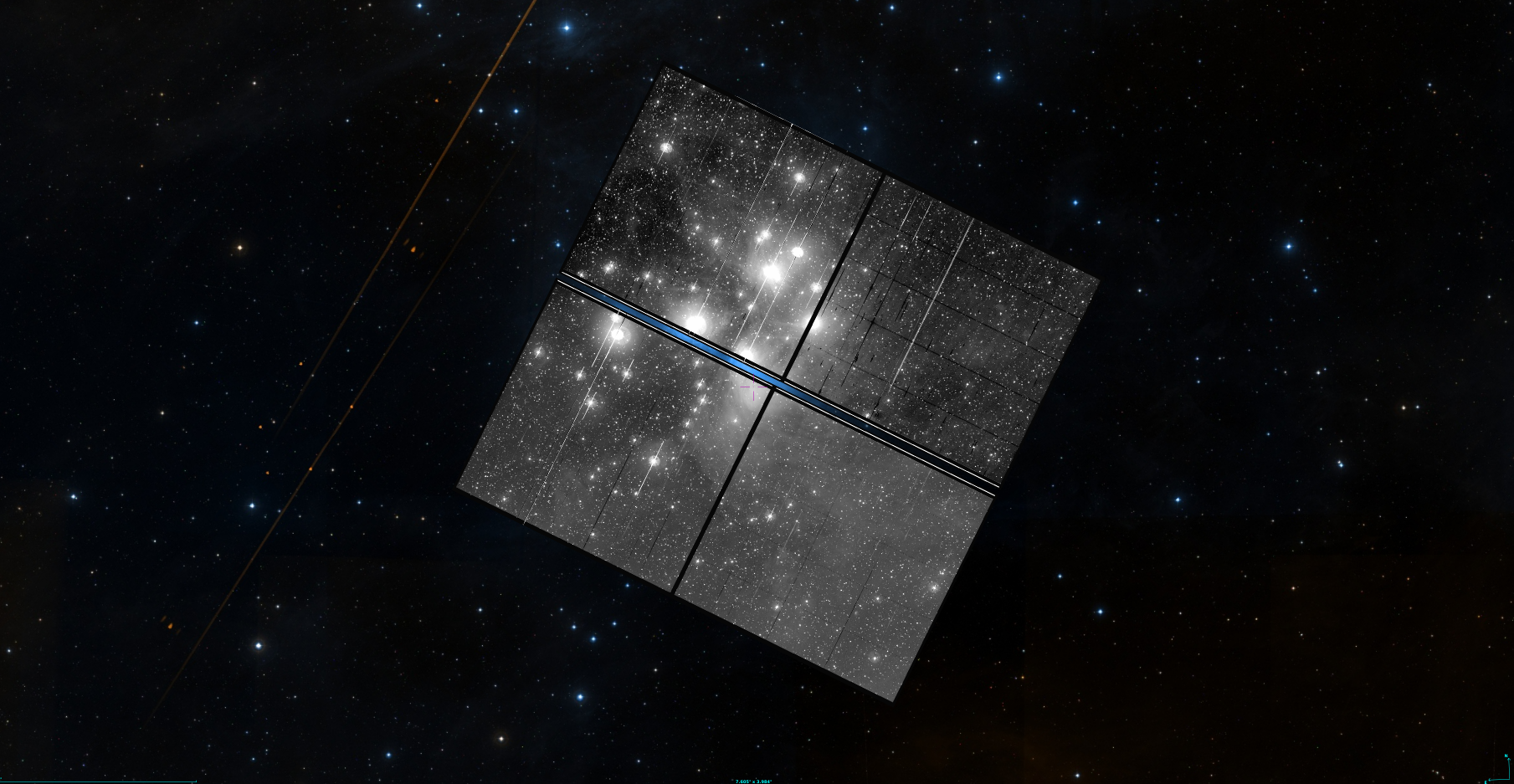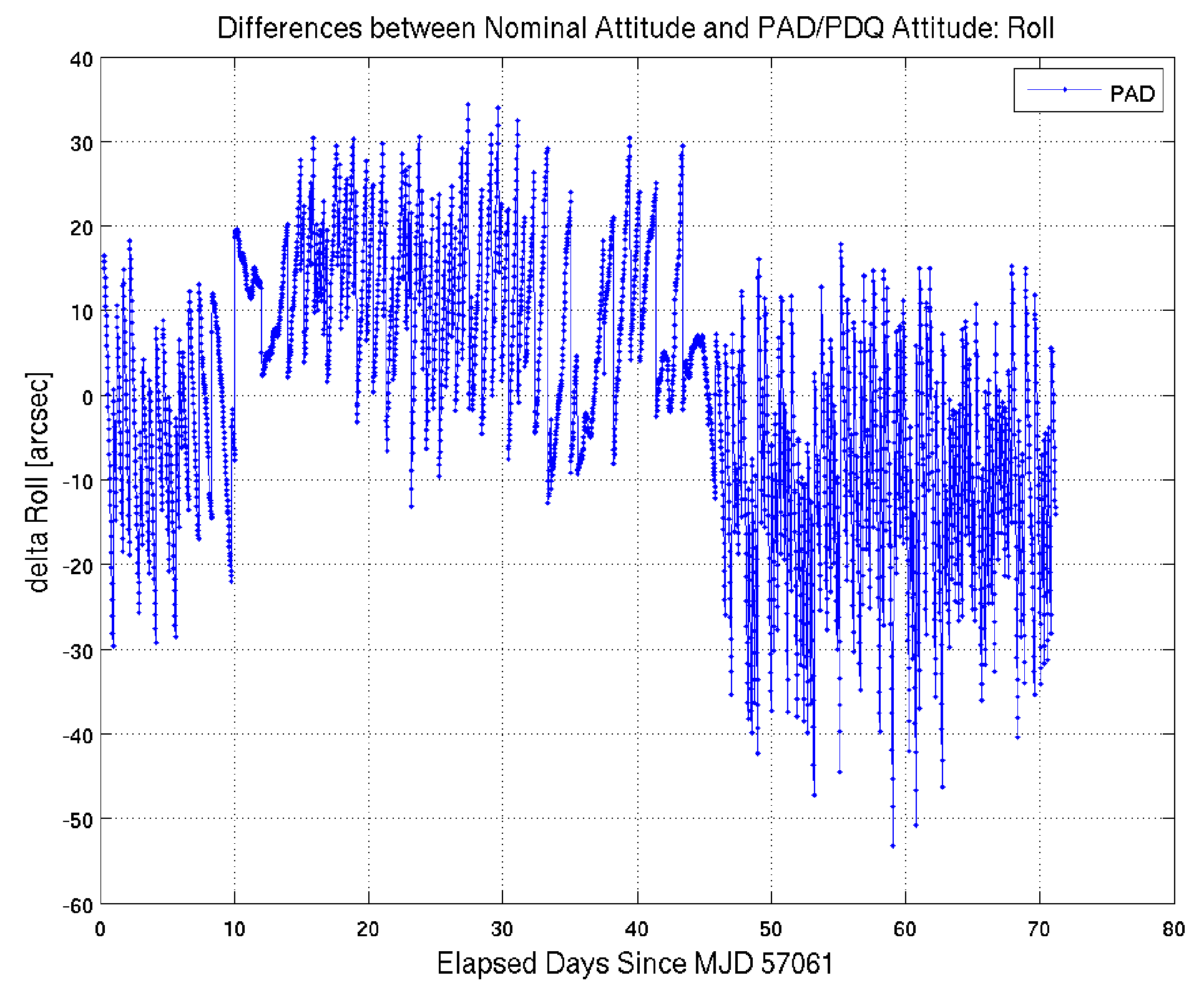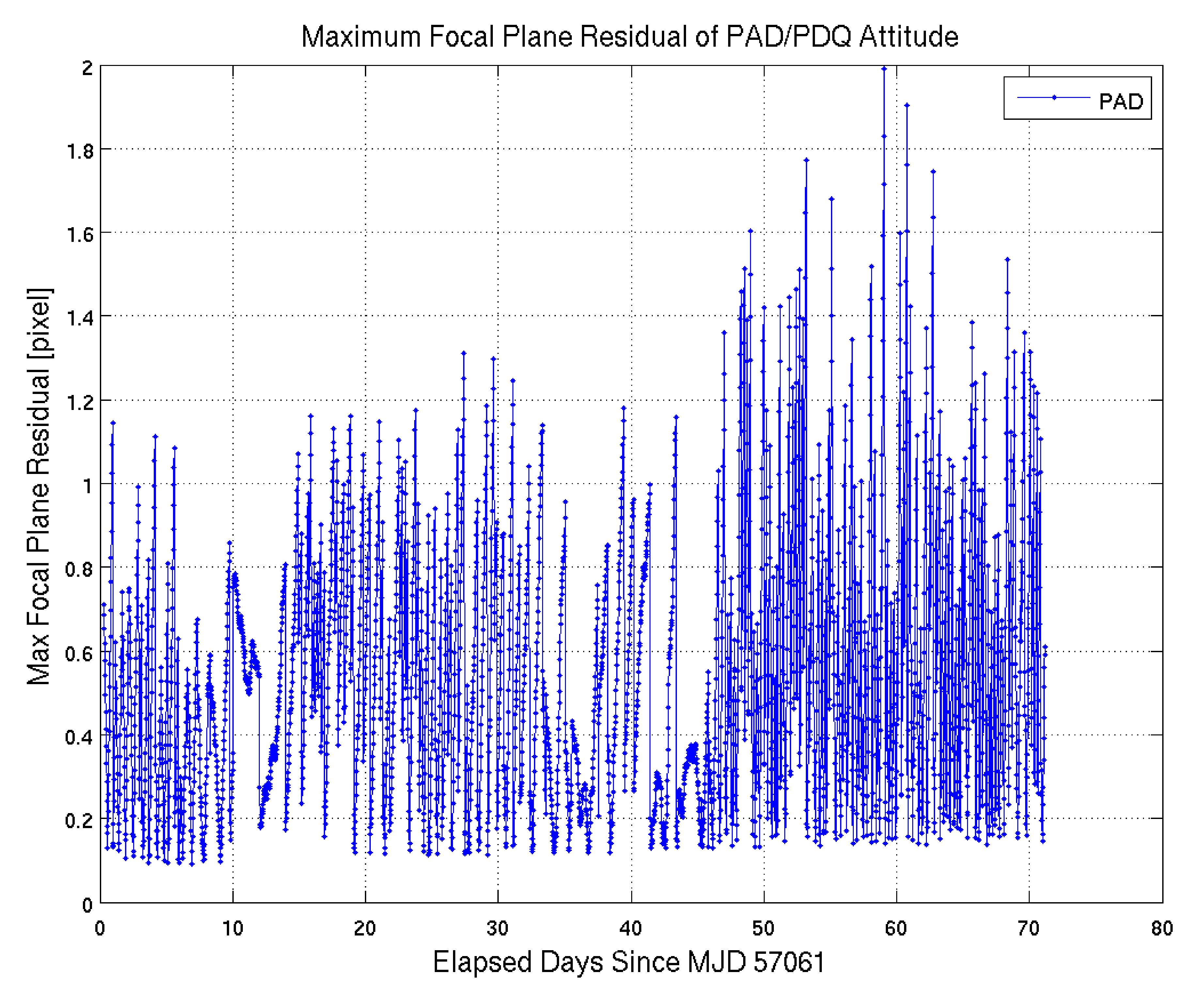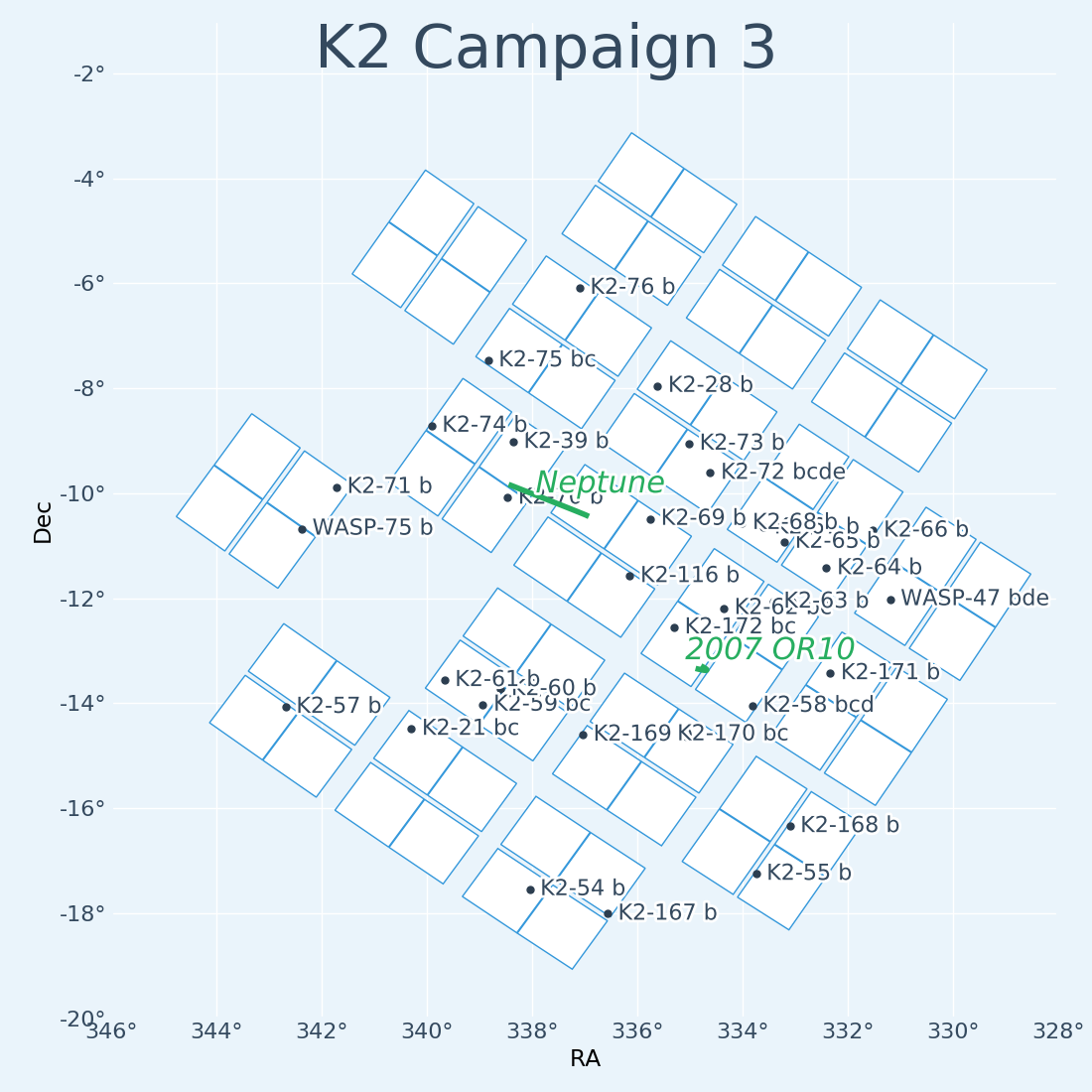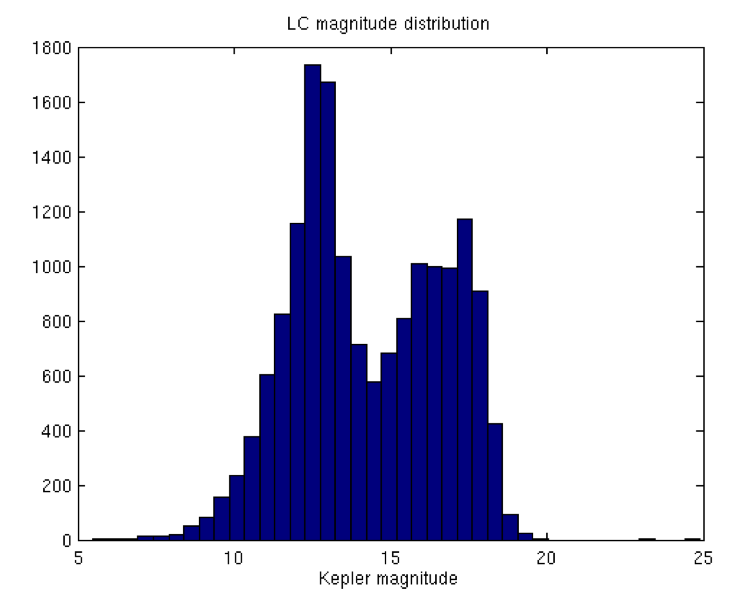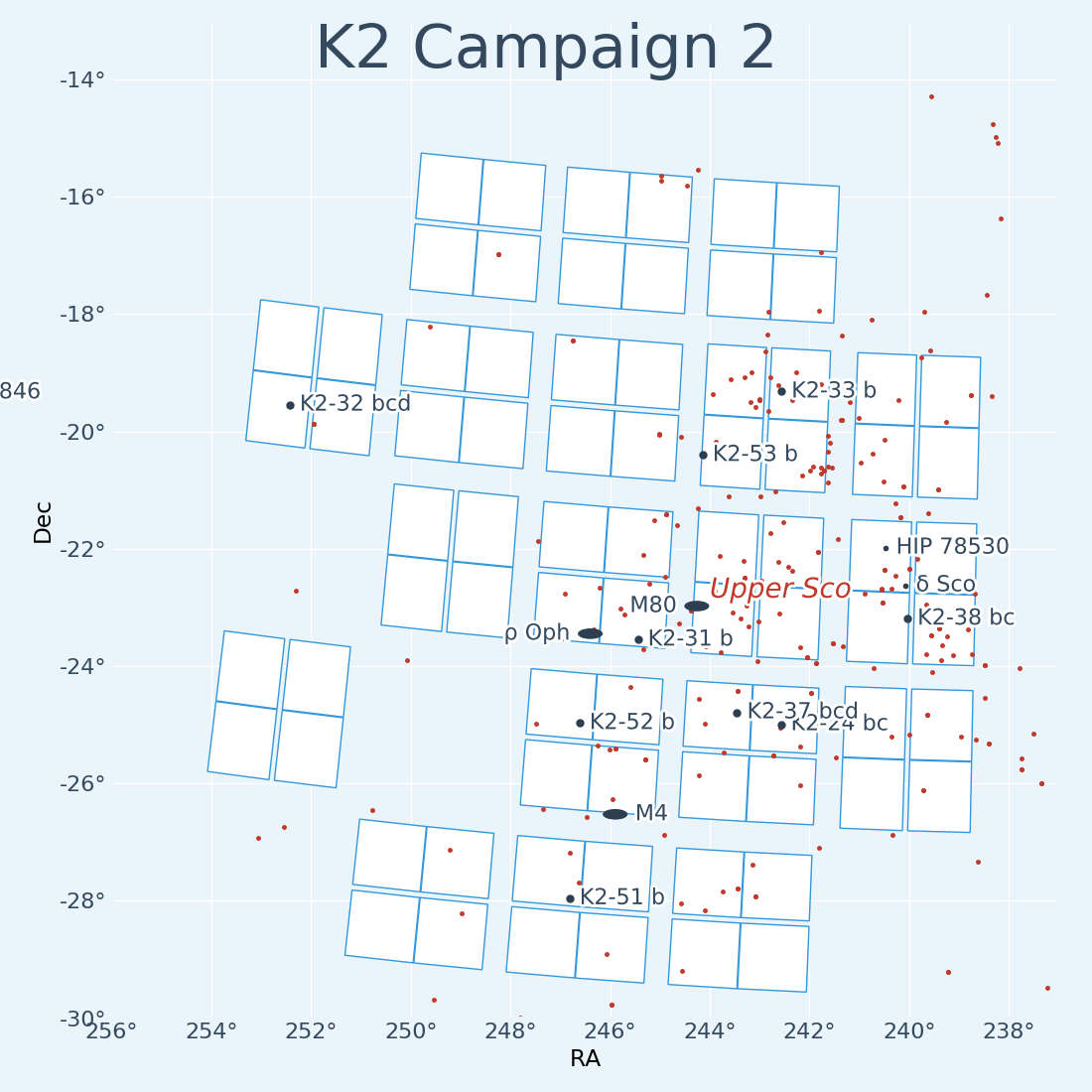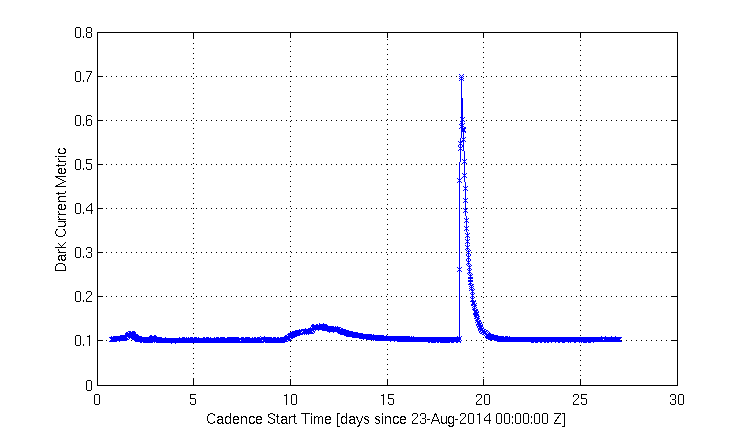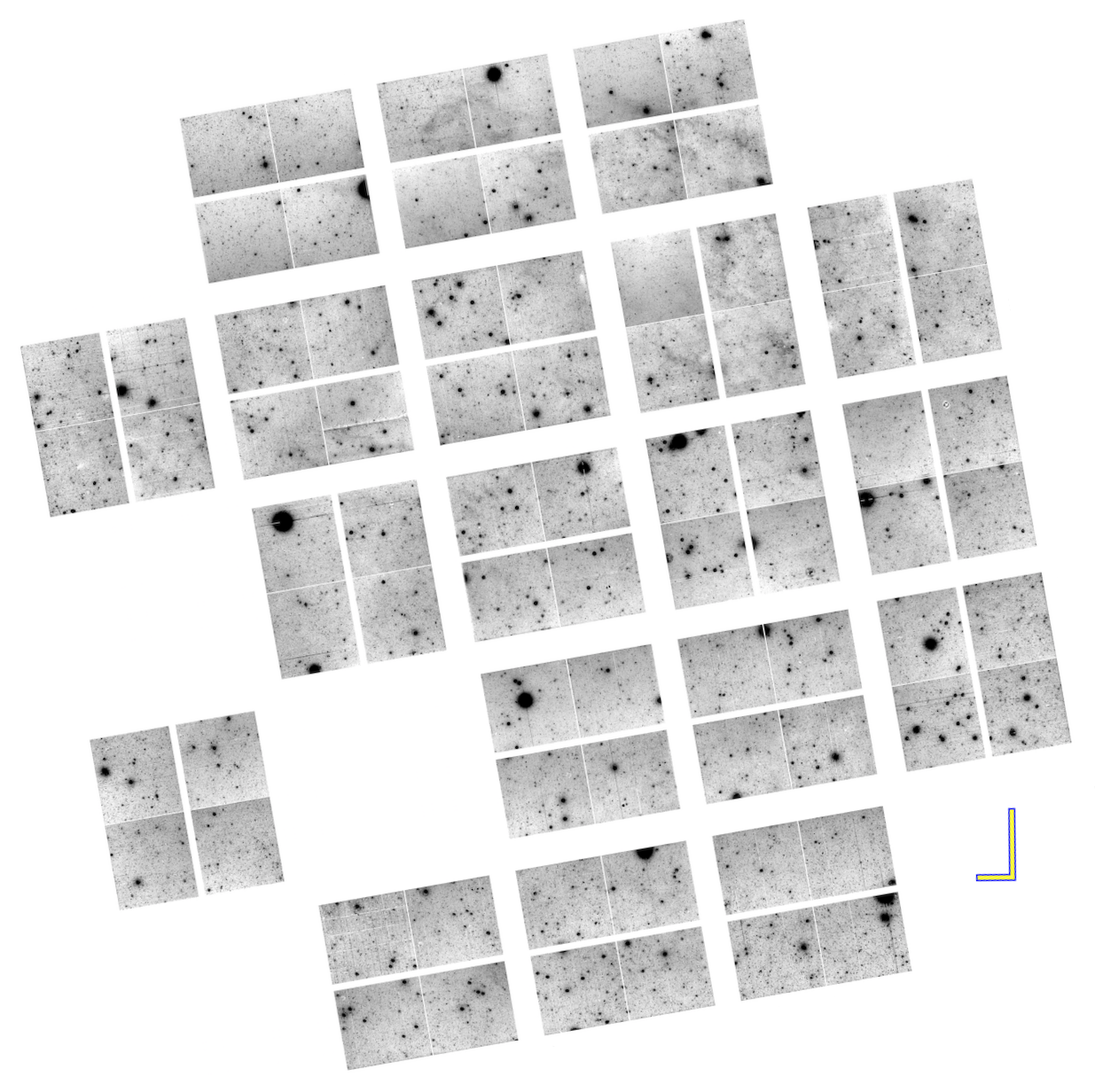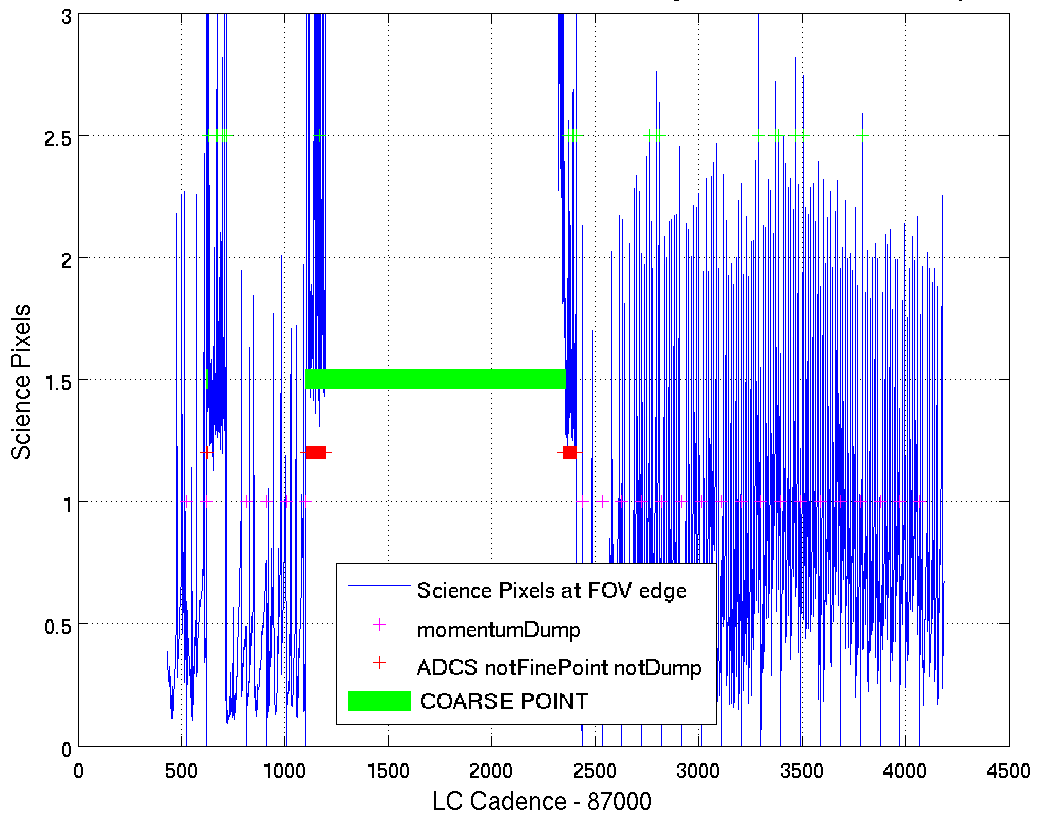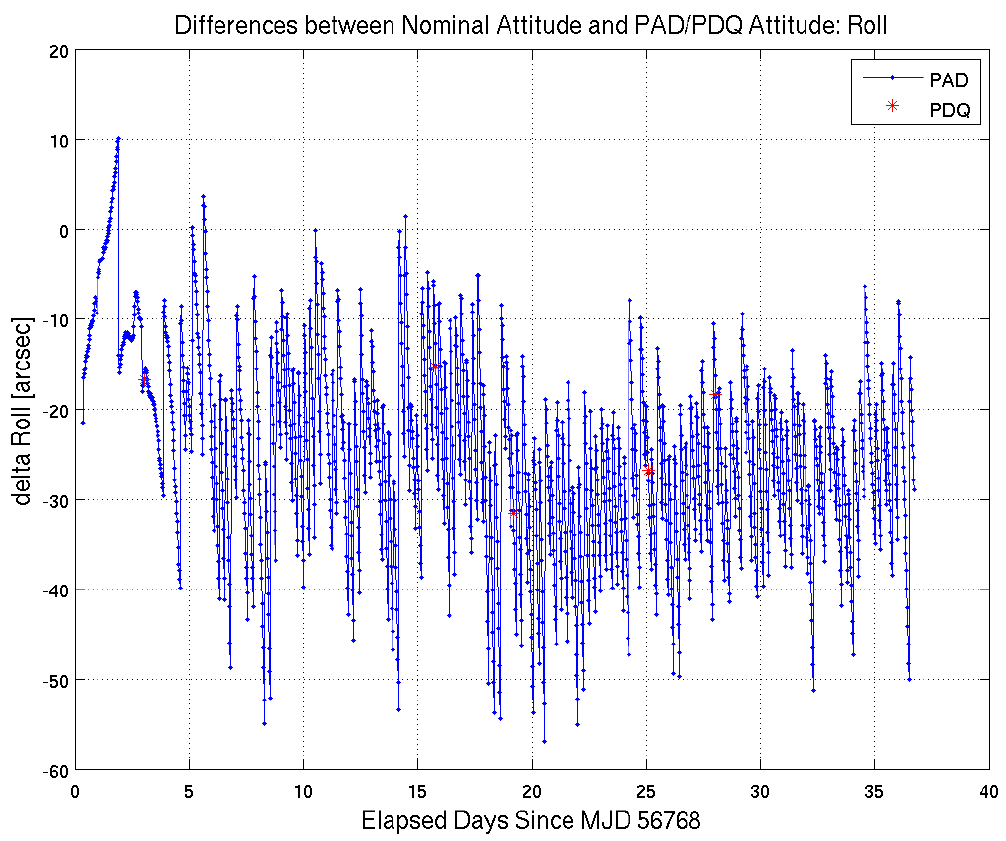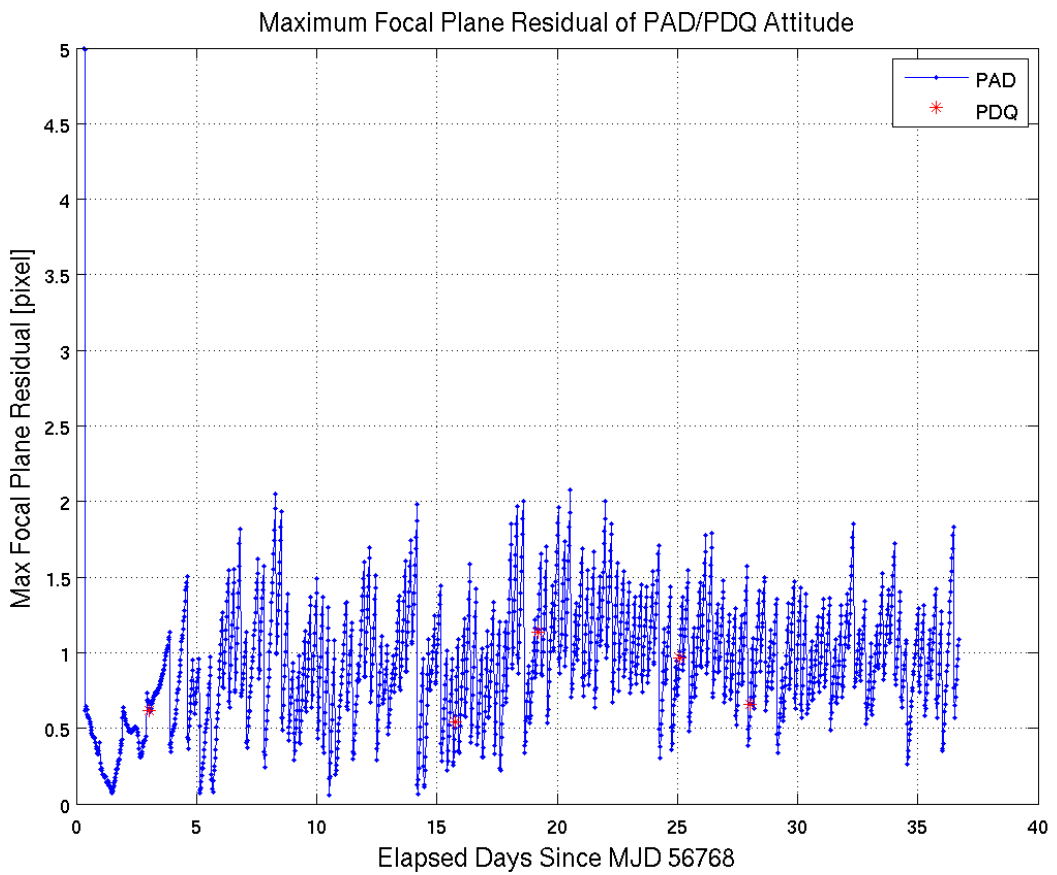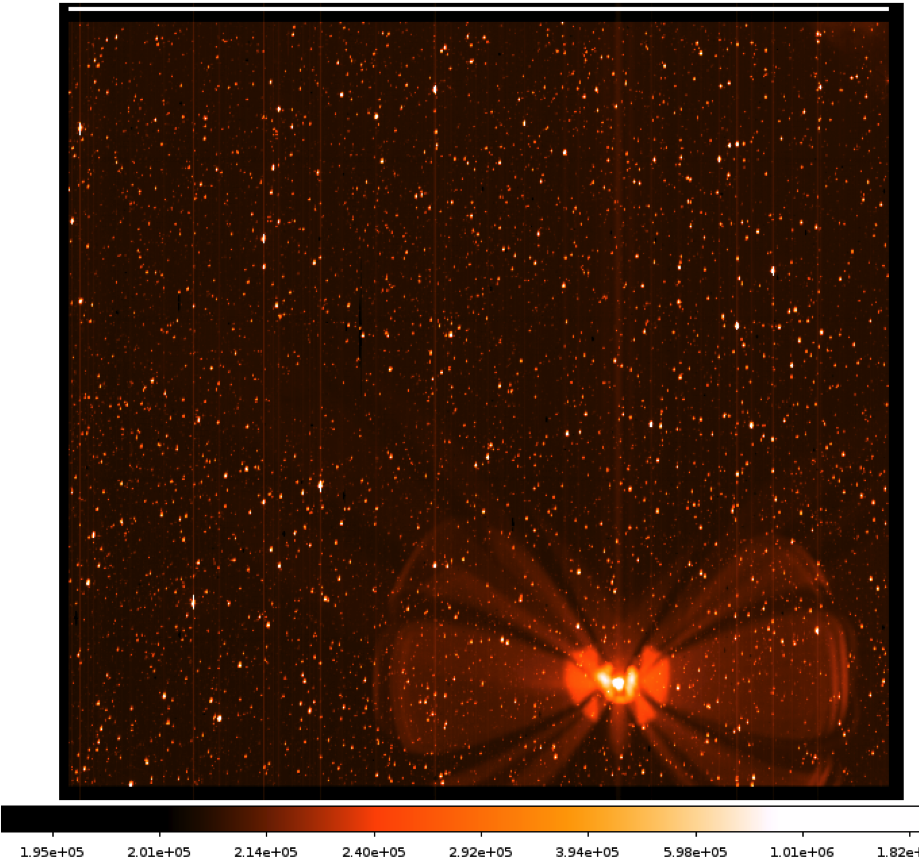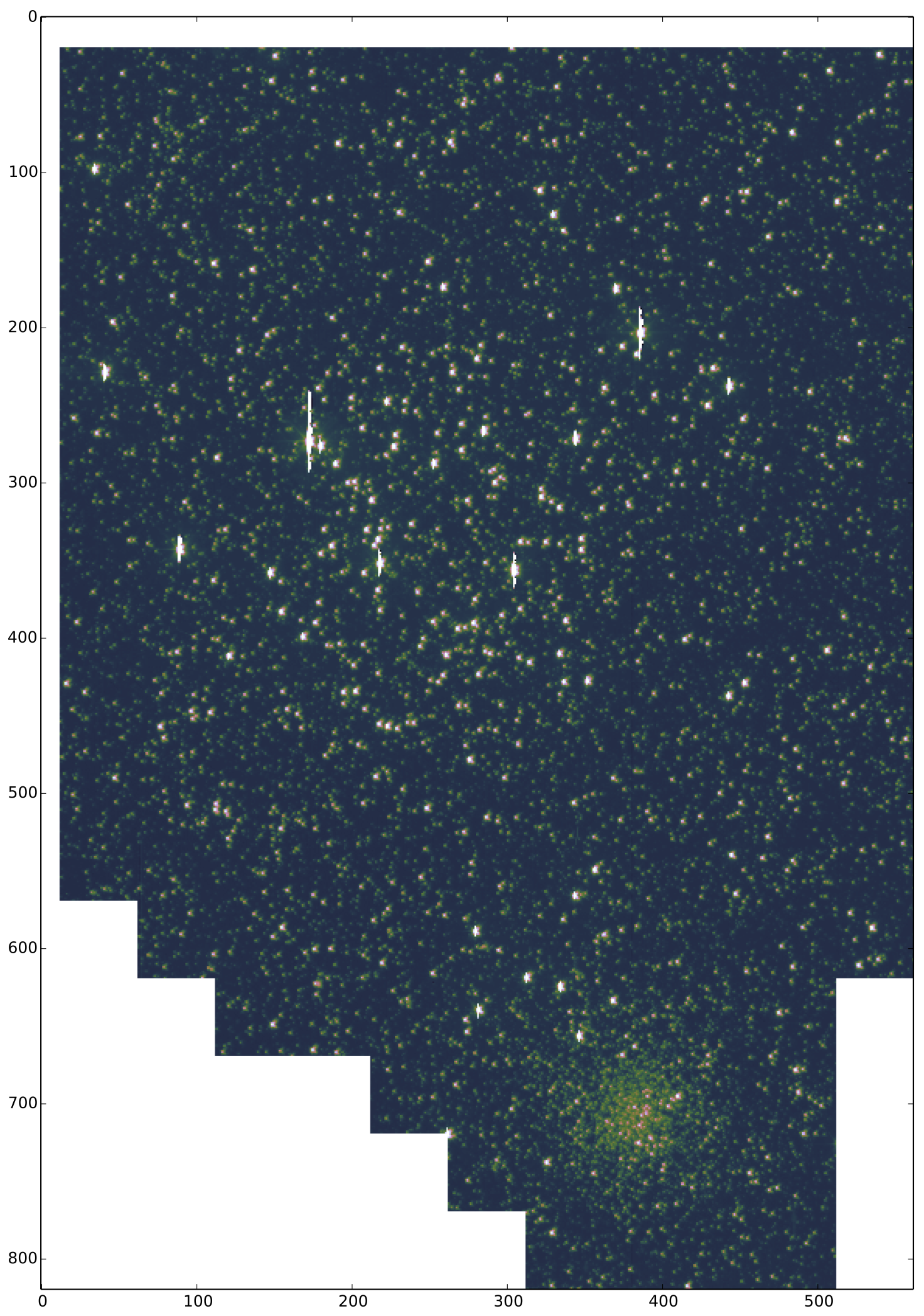This page details the key features of the K2 data releases, including information on field pointing, target selection, observation times and cadences, processing version, unique observational features of each campaign, significant events that transpired during each campaign, data quality and processing features, and other descriptions of technical issues relevant to the scientific exploitation of the data.
K2 Campaign 19
At a glance
- RA: 347.2590265 degrees
- Dec: -4.2027029 degrees
- Roll: 22.8818335 degrees
- 44,152 EPIC IDs in long cadence (LC).
- 222 EPIC IDs in short cadence (LC).
- 31 moving objects (including Neptune) were tiled with LC custom strip apertures (see below for details).
- Start Time: 2018-08-30 15:17:05 UTC
- Long Cadence Number: 167333
- Short Cadence Number: 5008450
- End Time: 2018-09-26 00:23:59 UTC
- Long Cadence Number: 168623
- Short Cadence Number: 5047179
Most Recent Processing Version
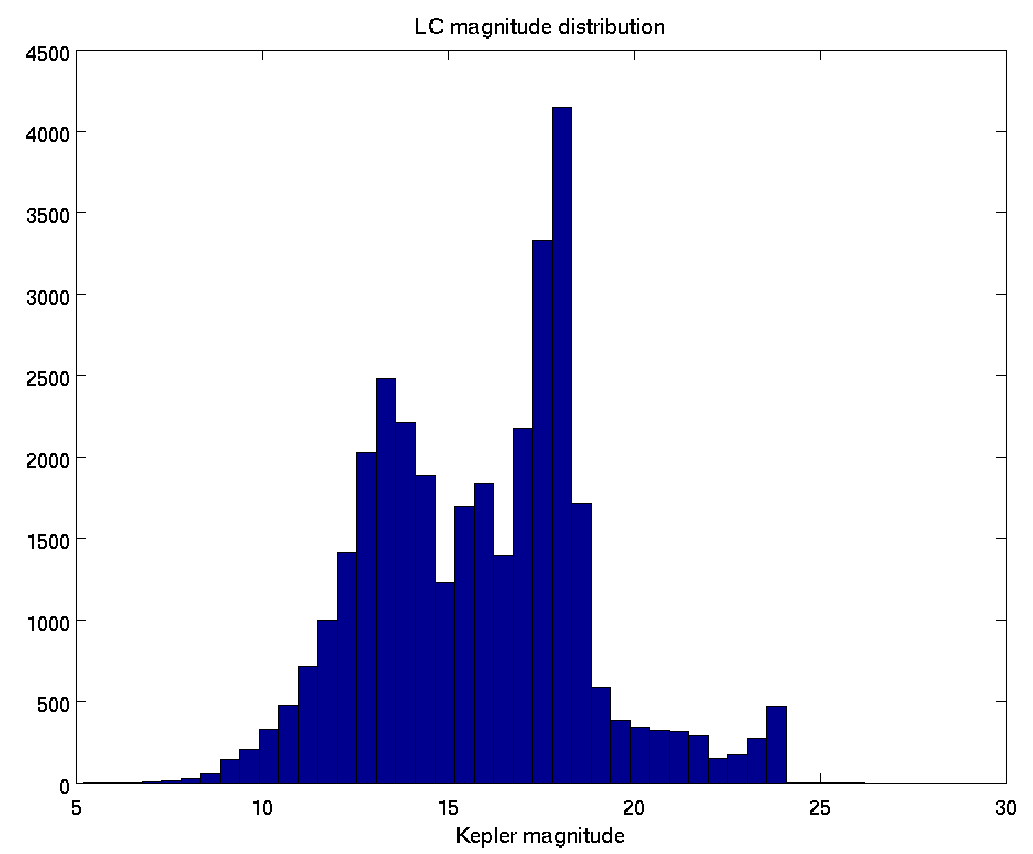
Features and Events
Overlap with C3, C12, and the Engineering Test Run
As shown in Figure C19-FOV, C19 field significantly overlaps with Campaign 12 and the Engineering Test Run, and partially overlaps with Campaign 3. Many targets observed in C19 were also observed in C3 and/or C12, thus establishing a several year temporal baseline that provides unique science opportunities.
Custom Targets
There were 11,495 galaxies targeted in the C19 field of view; all but six used standard aperture masks. The six large galaxies were covered with 35-pixel diameter large circular custom masks.
There were 15 bright stars that were assigned 24-pixel diameter LC disk apertures to capture the wings of the point spread function.
The C19 field of view includes 31 moving objects composed of 9 Asteroids, 20 faint Trans-Neptunian Objects, the planet Neptune, and the periodic comet 2P/Encke, all observed in long cadence. Neptune was also observed in short cadence approximately 20 days on each side of the stationary point of Neptune. Just as when Neptune was observed in Campaign 3, Neptune is expected to saturate the detector, resulting in spikes in the column direction as Neptune moves across the detector. The custom aperture numbers associated with Neptune are 200262135–200262467 for long cadence and 200262489—200262493 for short cadence. These observations were taken as part of Guest Observer Programs GO19009 (PI:Garcıa-Munoz), GO19061 (PI:Trafton), and GO19069 (PI:Smith).
See the csv file that maps the custom aperture number to the target name to find the apertures for a specific target.
Erratic Pointing Due to Fuel Exhaustion
Due to an anomalous drop in fuel pressure, the Kepler team paused the science observations for K2 Campaign 18 about 50 days into the campaign and then a month later successfully downloaded the C18 data. At the start of Campaign 19 the spacecraft configuration was modified in order to adapt to a change in thruster performance due to the low fuel pressure. Observations for C19 were collected for about a month, at which point the Kepler team received data showing that the spacecraft no longer had sufficient remaining fuel to point precisely enough to gather useful scientific data, and observations were again paused and then later successfully downloaded. While an attempt was made to start Campaign 20, without sufficient fuel end-of-flight was declared and the spacecraft was retired. Thus Campaign 19 is the final campaign for which scientific data is available.
Figure C19-Pointing-1 shows the pointing performance of the spacecraft over the duration of Campaign 19 via the observed deviation of targets from their expected location as a function of long cadence number — the blue line shows the deviation affecting all targets from displacement of the spacecraft boresight, while the red line shows the maximum deviation at the edge of the field of view due to the roll angle. Figure C19-Pointing-2 similarly shows the combined motion of a target at the edge of the field of view in science pixels, as well as some important data quality flags. Note that neither FFI was captured while in Fine Point and have noticeably different pointings (see Figure C19-FFI above).
As can be seen in these figures, for the first ~8.5 days (long cadences 167333–167742; short cadences 5008450–5020749), the spacecraft boresight was significantly off-nominal, and as a result nearly all targets were completely outside their observed pixel stamps, which had only 2- or 3-pixel halos — it is not expected that useable photometric data can be obtained for this time region for the pre-selected Campagin 19 targets. For the next ~7 days (long cadences 167743–168097; short cadences 5020750–5031399) the pointing due to boresight and roll was nominal compared to other K2 campaigns, and thus this ~7 day region should provide K2 data of quality comparable to other campaigns. For the final ~11 days (long cadences 168098–168623; short cadences 5031400–5047179) the boresight and roll fluctuated erratically — the 'well-behaved' portions of this timespan should provide useable photometric data for most targets, though careful analysis is encouraged --- the last likely useable long cadence is 168481.

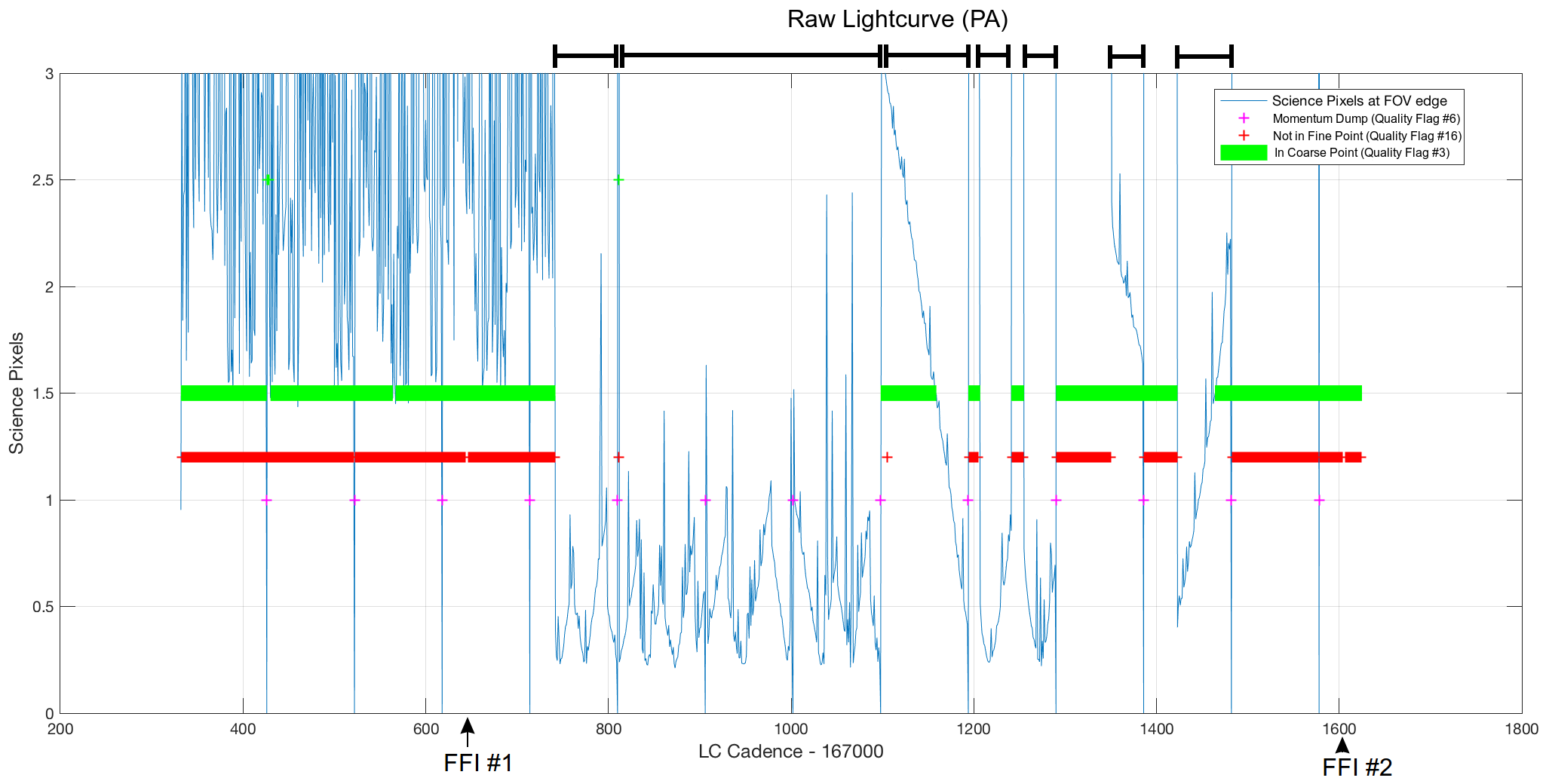
Pointing and Roll Performance During the Central ~7 days
Examining only the central ~7 days of continuously nominal pointing (long cadences 167743–168097; short cadences 5020750–5031399), the C19 pointing and roll behavior are very well behaved compared to most other K2 campaigns. The pipeline-calculated maximum distance between the derived and nominal positions for any target (the "maximum attitude residual", or MAR) for C19 in this time period is under 1.5 pixels, well under the 3-pixel limit accommodated by the aperture halos.
Data Quality and Processing Notes
Special Processing Parameters
In order to successfully process this unique campaign with the Kepler pipeline, and produce useful data of sufficient quality, the following approach was taken:
- The final long cadence observed by the spacecraft (168624) and the corresponding short cadences (5047180–5047209) were discarded due to data quality issues.
- For the rest of the campaign (long cadences 167333–168623 and short cadences 5008450–5047179), instead of the "Dynablack" calibration method that has been used for all other campaigns processed as part of the global uniform reprocessing effort, the simpler CAL method was used to calibrate pixels, due to the short duration of the observations. Rolling band flags (see the news post on global reprocessing) were still able to be computed and provided.
- When producing the raw / simple aperture (PA) lightcurves, unlike all other campaigns processed as part of the global uniform reprocessing effort, cadences marked as "Spacecraft is not in fine point" (QUALITY flag bit #16, decimal=32768) were discarded. This is illustrated in Figure C19-Pointing-2. The resulting PA cadence range is thus 167742–168481 (note that while 167742 is included, it is flagged as COARSE_POINT, i.e., QUALITY flag bit #4.)
- When producing the systematic-corrected (PDC) lightcurves, the cadence range was restricted to the central ~7 days of continuously stable pointing (long cadences 167743–168097 and short cadences 5020750–5031399). This is illustrated in Figure C19-Pointing-1. The corresponding time range is 2018-09-08 00:24:52 UTC to 2018-09-15 06:32:00 UTC.
As a result, users will have calibrated pixels for nearly the entire campaign, raw / simple aperture lightcurves (called PA or SAP_FLUX) for the last ~2/3 of the campaign during times when the spacecraft was in fine point, and systematic-corrected lightcurves (called PDC or PDCSAP_FLUX) for the central ~7 days of continuously good pointing.
Users producing their own lightcurves will likely want to make use of the "Spacecraft is not in fine point" (QUALITY flag bit #16, decimal=32768) and "Spacecraft is in coarse point" (QUALITY flag bit #3, decimal=4) to remove cadences with significant pointing deviations from nominal, while accounting for the location of their target on the focal plane (and thus observed motion due to spacecraft roll) and aperture size.
Light Curve Quality
Examining only the central ~7 days of continuously nominal pointing (long cadences 167743–168097; short cadences 5020750–5031399), the 6-hour spacecraft roll cycle dominates the systematic errors in the C19 simple aperture photometry light curves, similar to other campaigns. The pipeline CDPP 12th magnitude noise benchmark for C19 is technically the lowest of any campaign observed to-date — however, it is not necessarily correct to compare it to other campaigns, as there is only ~7 days of data analyzed here, compared to other campaigns that normally have ~50–80 days. It is likely that the PDC module is over-fitting the data to some extent. Users are cautioned that astrophysical variations, particularly those of long (~several days or more) period may be artificially suppressed in the PDCSAP_FLUX data. Users can examine the C19 cotrending basis vectors to check and see if they contain data trends that resemble astrophysical signals of interest.
The magnitude dependence of CDPP for the central ~7 days, and its distribution over the focal plane, are shown below in Figure C19-CDPP. Other CDPP benchmarks can be found in the table giving 6.5-hr CDPP as a function of magnitude.
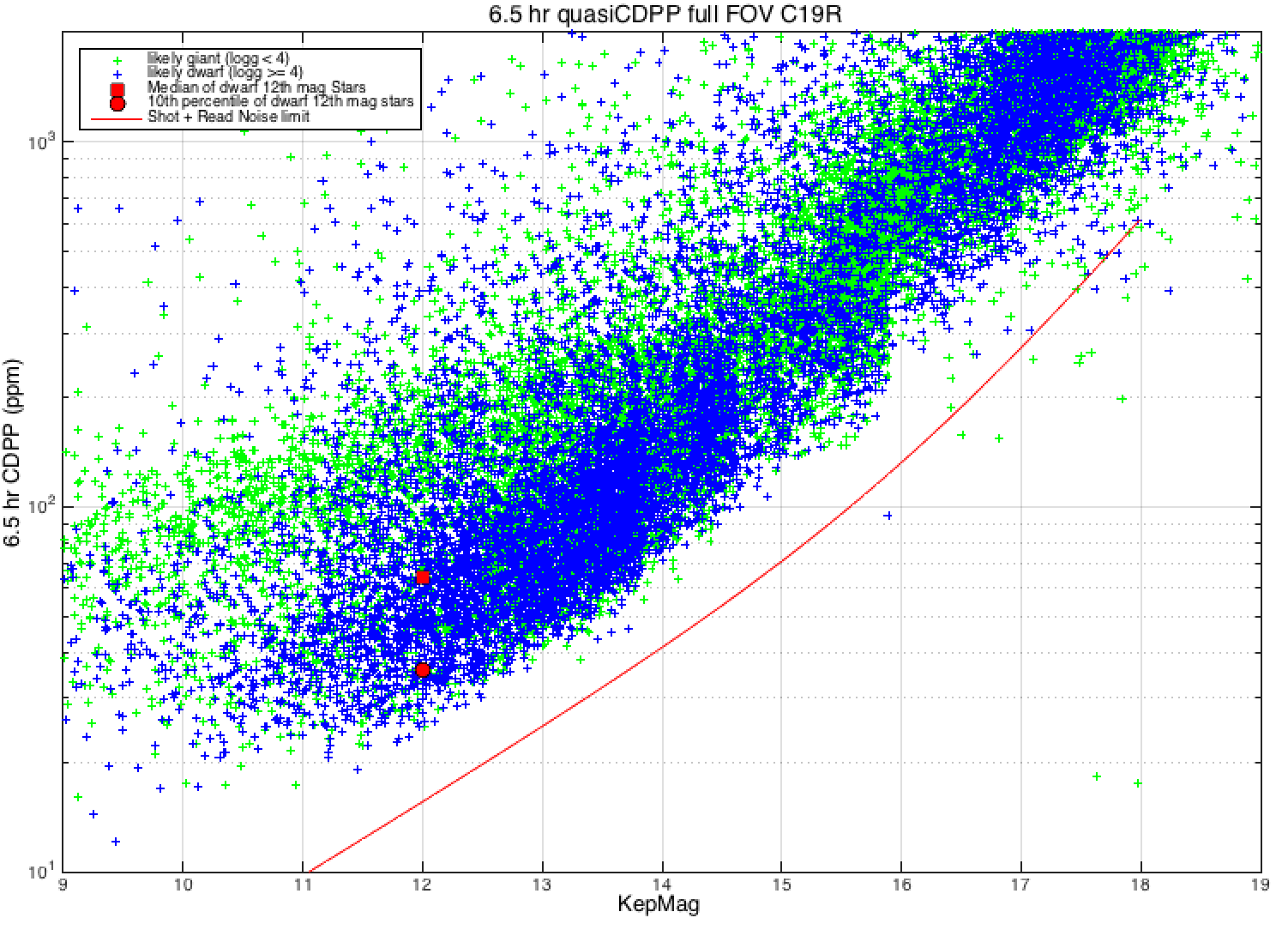
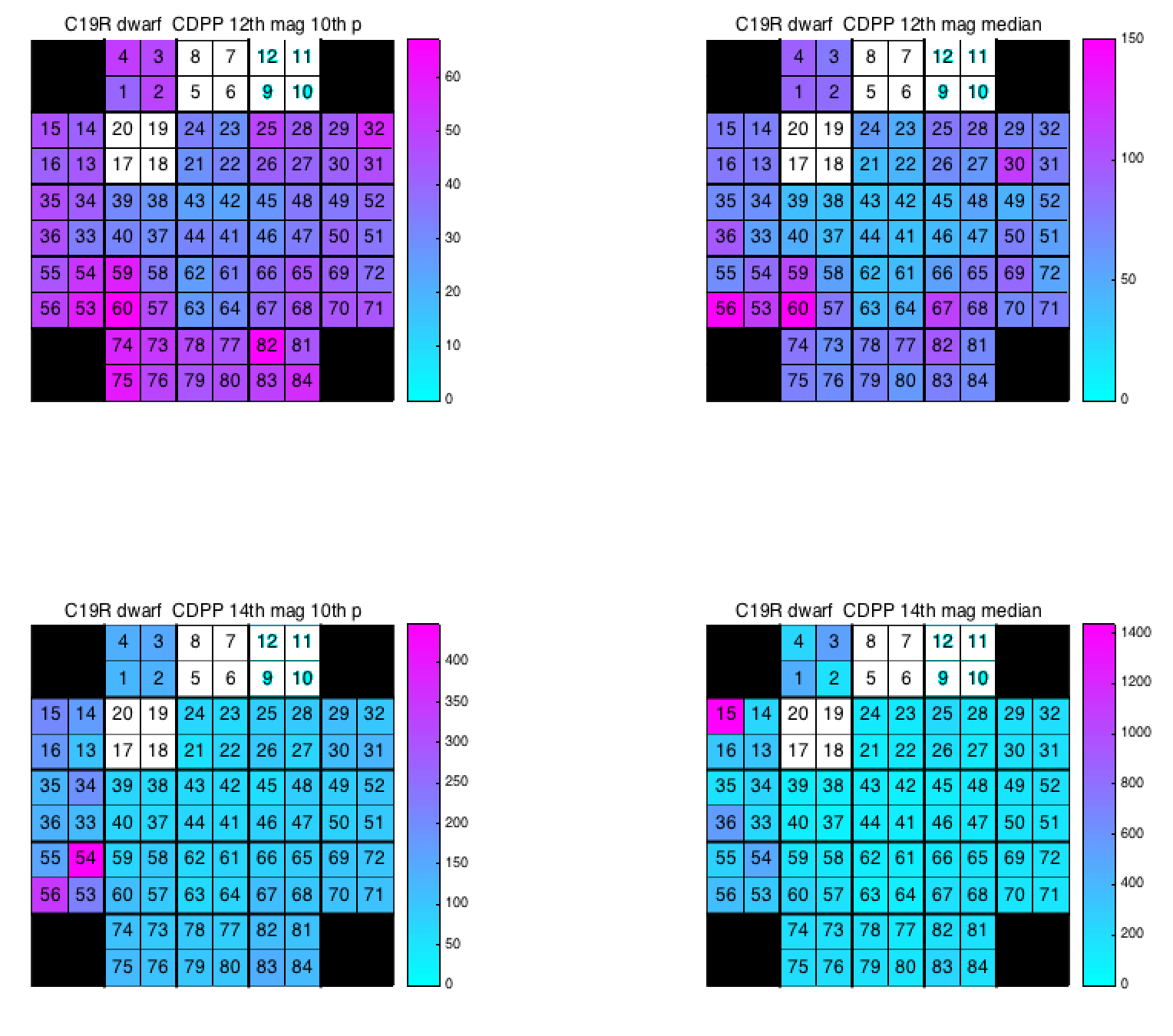
K2 Campaign 18
At a glance
- RA: 130.1610170 degrees
- Dec: 16.8278629 degrees
- Roll: 165.8977388 degrees
- 36,909 EPIC IDs in long cadence (LC).
- 237 EPIC IDs in short cadence (LC).
- 27 moving objects were tiled with LC custom strip apertures. 11 bright stars were assigned 24-pixel diameter LC disk apertures to capture the point spread function wings. See the csv file that maps the custom aperture number to the target name to find the apertures for a specific target.
- Start Time: 2018-05-13 00:44:43 UTC
- Long Cadence Number: 161969
- Short Cadence Number: 4847530
- End Time: 2018-07-02 21:51:26 UTC
- Long Cadence Number: 164458
- Short Cadence Number: 4922229
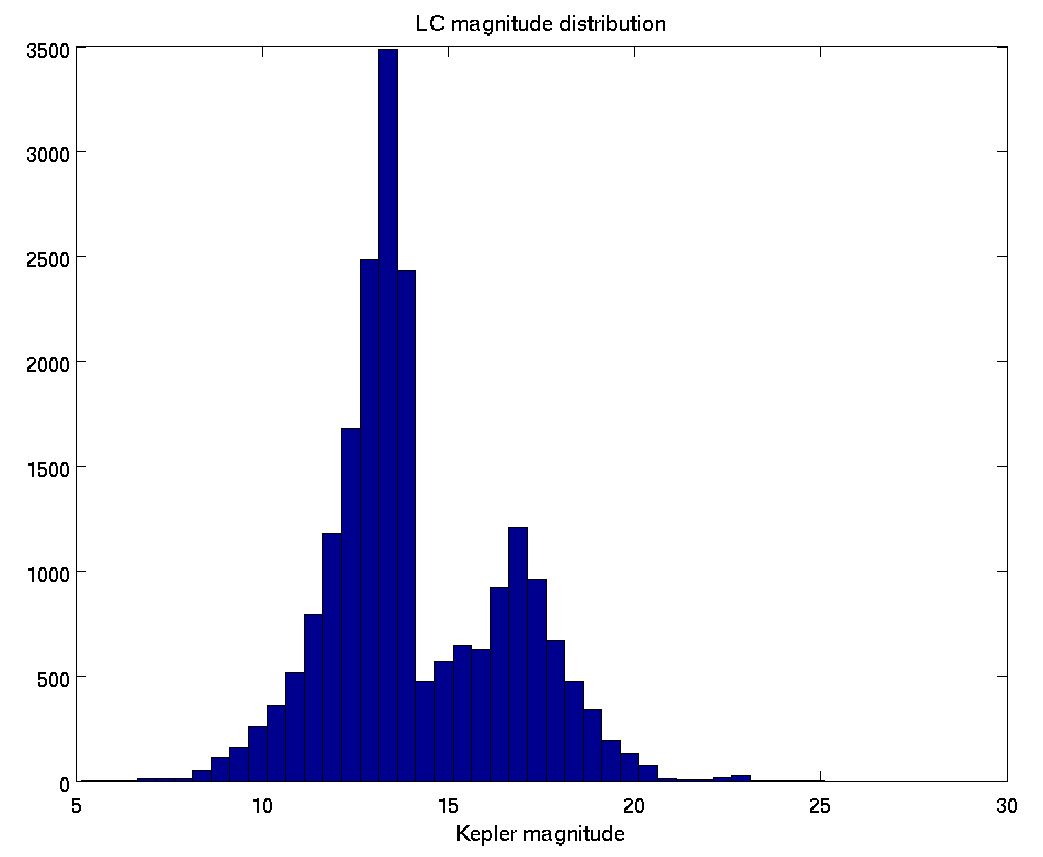
Features and Events
Overlap with C5 and C16
The C18 field is almost identical to that observed during Campaign 5, and overlaps substantially with Campaign 16. Many targets observed in C18 were also observed in C5 and C16, establishing a 3 year temporal baseline with an 8 month duty cycle that provides unique science opportunities.
Galaxies
There are 2,193 galaxies targeted in the C18 field of view; all but five used standard aperture masks. The five large galaxies were covered with 35-pixel diameter large circular custom masks.
Clusters
The C18 field of view includes the Beehive cluster (M44) and M67. M44 is one of the most nearby open clusters; its members were observed using standard masks. M67 was tiled with a series of 441 20 x 20 pixel tiles for a total of 176,400 pixels.
Solar System Objects
The C18 field of view includes 22 comets and trojan Asteroids, 9 faint Trans-Neptunian Objects, and the formerly potentially hazardous asteroid 99942 Apophis, all observed in long cadence.
Early End to Campaign 18
Due to indications that the spacecraft fuel tank was running very low ~50 days into Campaign 18, collection of science data was terminated on July 2, 2018 and the spacecraft was put in a hibernation-like state until the data was downloaded at the regularly scheduled time in early August. As a result, only one FFI was collected.
Pointing and Roll Performance
The C18 pointing and roll behavior are well within the limits of that seen in other K2 campaigns, with no degradation seen due to potentially low fuel levels. The pipeline-calculated maximum distance between the derived and nominal positions for any target (the "maximum attitude residual", or MAR) for C18 is less than 1.9 pixels for nearly the entire campaign, well under the 3-pixel limit accommodated by the aperture halos.
The exception is about a dozen long cadences just prior to BKJD 3432 / MJD 58264.5, where the pointing temporarily exceeded 4 pixels, as clearly seen in the plots below. Users are encouraged to discard long cadences 162613 – 162627 (short cadences 4866897 – 4867246) due to this pointing excursion. These cadences are flagged using QUALITY flag bit #3. Similarly, while not visible in the plots below, the very last long cadence of the campaign, 164458 (short cadences 4922216 – 4922230) had a very large pointing excursion and are also flagged using QUALITY flag bit #3.
As mentioned in the C14 release notes, a change in the on-board fine point fault logging threshold results in additional cadences being flagged as "Spacecraft is not in fine point" (QUALITY flag bit #16, decimal=32768). As a reminder, the project recommends that starting with C15, users look to QUALITY flag bit #3 as an accurate indicator of poor spacecraft pointing.
Data Quality and Processing Notes
Light Curve Quality
As in previous campaigns, the 6-hour spacecraft roll cycle continues to dominate the systematic errors in C18 simple aperture photometry light curves. The pipeline CDPP 12th magnitude noise benchmark for C18 is the second-lowest ever seen (just higher C5) at the time of this processing. The improved precision compared to most other campaigns is likely due to a combination of lower star density, stable pointing (compared to most other campaigns), and the updated pipeline version (in-particular the use of the coarse-point flags; see the global reprocessing effort announcement for details).
The magnitude dependence of CDPP and its distribution over the focal plane are shown below. Other CDPP benchmarks can be found in the table giving 6.5-hr CDPP as a function of magnitude.
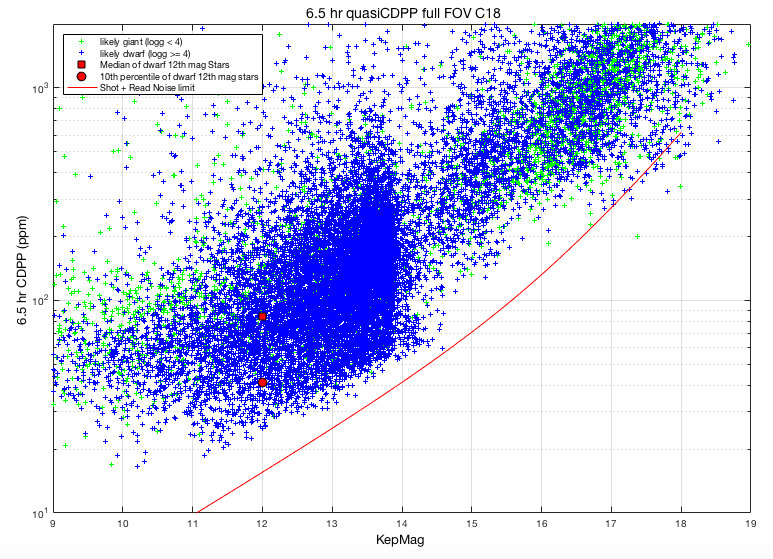
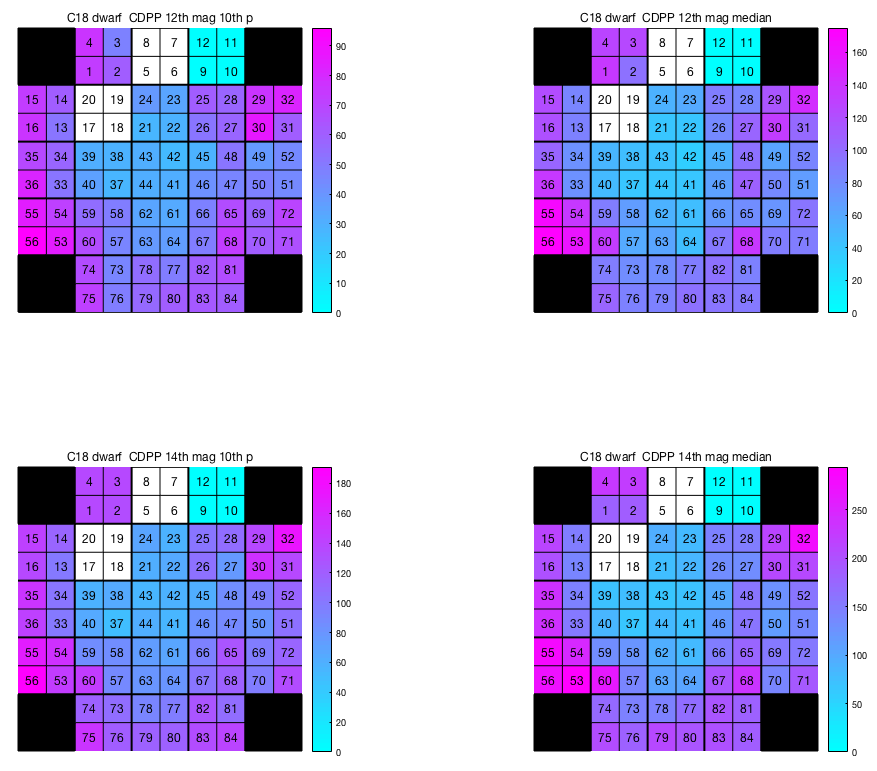
Target With Incomplete FITS Header: EPIC 200233235
The custom target EPIC 200233235 is missing centroid information and values for the following FITS headers in its target pixel and lightcurve files: RA_OBJ, DEC_OBJ, 1CRVL4, 2CRVL4, 1CRVL5, 2CRVL5, 1CRVL6, 2CRVL6, 1CRVL7, 2CRVL7, 1CRVL8, 2CRVL8, 1CRVL9, 2CRVL9, EXPOSURE, TELAPSE, LIVETIME, TSTART, TSTOP, CRVAL1, and CRVAL2. This was a custom target for which the entire 20x20 pixel stamp was selected as the aperture by the pipeline. As a result there were no background pixels available to compute the centroid information, and thus the values for the listed FITS headers. This issue appears unique to this custom target and no other targets are affected. Users wanting to analyze this target are encourage to create their own lightcurve using software such as the lightkurve Python package, PyKE software tool suite, or other packages.
K2 Campaign 17
At a glance
Campaign 17 was flown in the forward velocity vector direction in order to enable simultaneous K2 and ground-based observations of numerous targets (supernovae, variable stars, exoplanets, etc.) in the C17 field of view.
Pointing- RA: 202.5496152 degrees
- Dec: -7.7210759 degrees
- Roll: -20.7870925 degrees
- 46,230 EPIC IDs in long cadence (LC).
- 179 EPIC IDs in short cadence (LC).
- 24 moving objects were tiled with LC custom strip apertures. 6 bright stars were assigned 24-pixel diameter LC disk apertures to capture the point spread function wings. See the csv file that maps the custom aperture number to the target name to find the apertures for a specific target.
- Start Time: 2018-03-02 00:33:12 UTC
- Long Cadence Number: 158445
- Short Cadence Number: 4741810
- End Time: 2018-05-08 02:33:28 UTC
- Long Cadence Number: 161727
- Short Cadence Number: 4840299
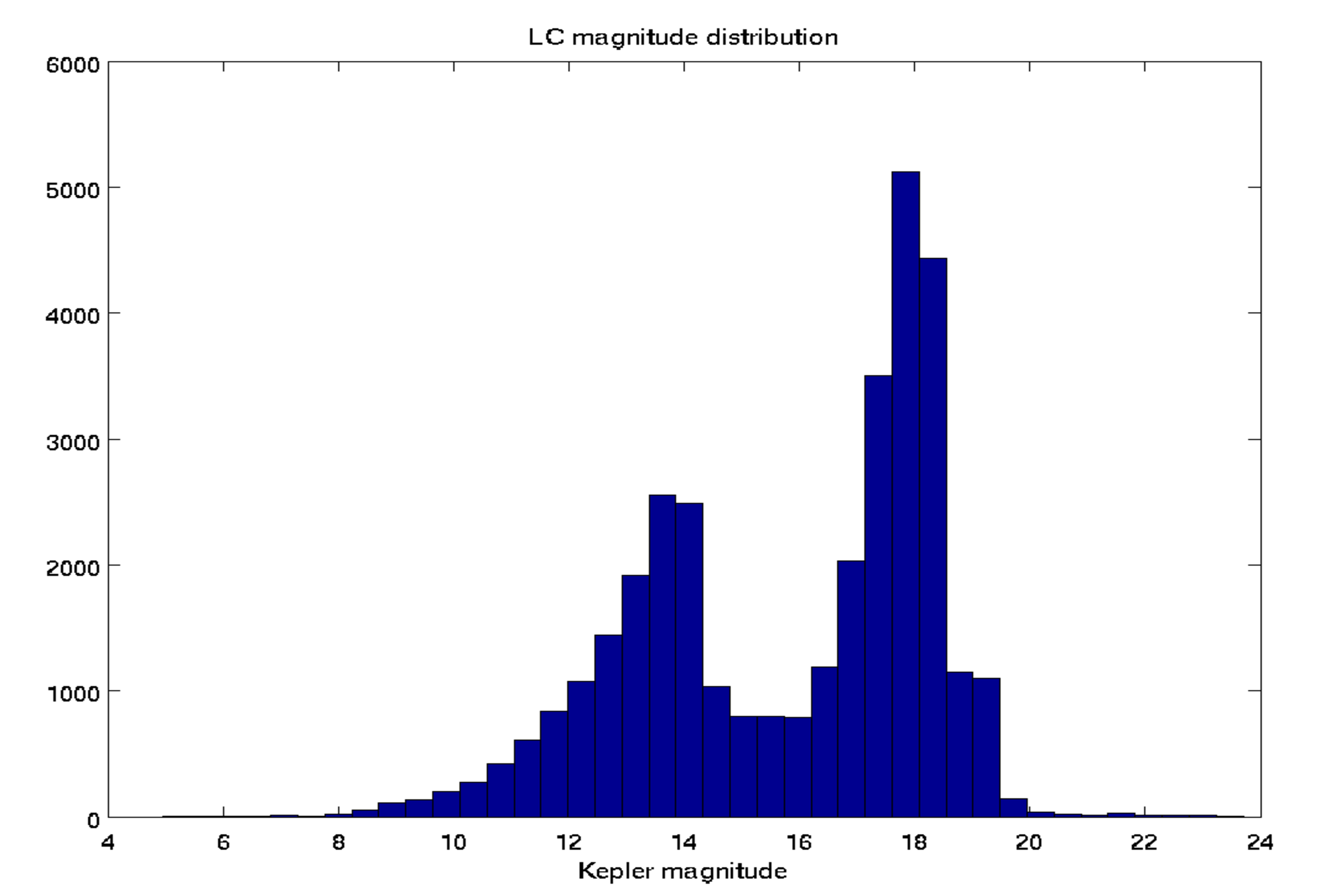
Features and Events
Galaxies
There are 14,314 galaxies targeted in the C17 field of view; all but eight used standard aperture masks. The eight large galaxies were covered with large circular custom masks. The very large number of galaxies observed was due in part to the K2 Supernova Experiment (see below).
Supernovae
The forward velocity vector orientation during C17 allowed for simultaneous ground-based observations of K2 targets. As shown in Figure C17-FOV, numerous supernovae were observed by Kepler and ground-based observatories during C17. More details of the supernova campaign can be found at the Supernova Experiment site.
Spica
The first magnitude star Spica fell on channel 48 for the entirety of campaign 17. Spica's optical ghost (due to reflection off the telescope's Schmidt corrector plate) is seen on the opposite side of the focal plane on channel 40. (See this schematic of the Kepler detector layout for the positions of channels 40 and 48.) As can be seen in the FFI images below, the light from both Spica and its ghost cover a large portion of channels 48 and 40. As well Spica bleeds along its central columns, resulting in poor CCD calibration along those columns. Users with targets near Spica or its ghost are encouraged to take this information into account when interpreting observations of those targets, or if performing their own data reduction.
Pointing and Roll Performance
The C17 pointing and roll behavior are well within the limits of that seen in other K2 campaigns, with no degradation seen due to potentially low fuel levels. The pipeline-calculated maximum distance between the derived and nominal positions for any target (the "maximum attitude residual", or MAR) for C17 is less than 2.0 pixels, well under the 3-pixel limit accommodated by the aperture halos.
As mentioned in the C14 release notes, a change in the on-board fine point fault logging threshold results in additional cadences being flagged as "Spacecraft is not in fine point" (QUALITY flag bit #16, decimal=32768). As a reminder, the project recommends that starting with C15, users look to QUALITY flag bit #3 as an accurate indicator of poor spacecraft pointing.
Data Quality and Processing Notes
Light Curve Quality
As in previous campaigns, the 6-hour spacecraft roll cycle continues to dominate the systematic errors in C17 simple aperture photometry light curves. The pipeline CDPP 12th magnitude noise benchmark for C17 is the lowest seen since C6 and the third-lowest overall (just higher than C6 and C5) at the time of this processing. The improved precision compared to most other campaigns is likely due to a combination of lower star density, stable pointing (compared to most other campaigns), and the updated pipeline version (in-particular the use of the coarse-point flags; see the global reprocessing effort announcement for details).
The magnitude dependence of CDPP and its distribution over the focal plane are shown below. Other CDPP benchmarks can be found in the
table giving 6.5-hr CDPP as a function of magnitude.
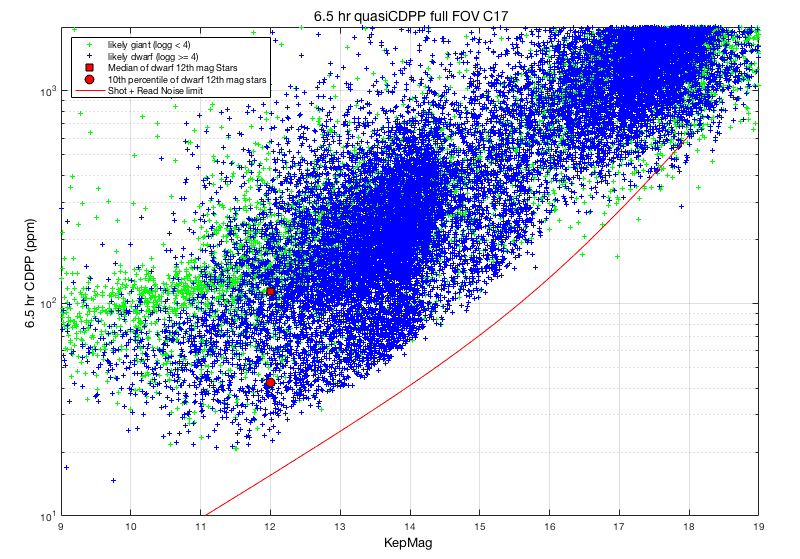
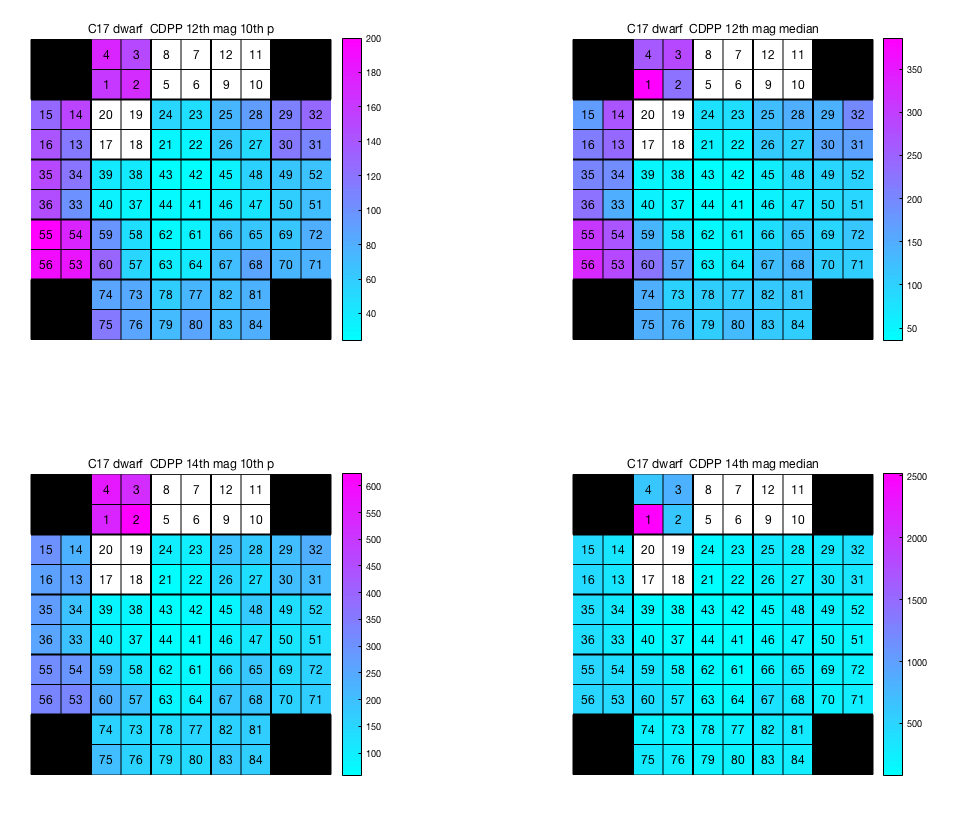
K2 Campaign 16
At a glance
Campaign 16 was flown in the forward velocity vector direction in order to enable simultaneous K2 and ground-based observations of numerous targets (supernovae, variable stars, exoplanets, etc.) in the C16 field of view.
Pointing- RA: 133.7099689 degrees
- Dec: 18.5253931 degrees
- Roll: -15.0605959 degrees
- 35,571 EPIC IDs in long cadence (LC).
- 131 EPIC IDs in short cadence (LC).
- 20 moving objects were tiled with LC custom strip apertures. 7 bright stars were assigned 24-pixel diameter LC disk apertures to capture the point spread function wings. See the csv file that maps the custom aperture number to the target name to find the apertures for a specific target.
- ktwo2017344214411-c16_ffi-cal.fits This FFI, collected on 2017-12-10, has the Earth-Moon system in the field of view on channel 83. There is also a prominent optical ghost on channel 3.
- ktwo2018030100110-c16_ffi-cal.fits
- Start Time: 2017-12-07 23:01:18 UTC
- Long Cadence Number: 154331
- Short Cadence Number: 4618390
- End Time: 2018-02-25 12:39:52 UTC
- Long Cadence Number: 158224
- Short Cadence Number: 4735209
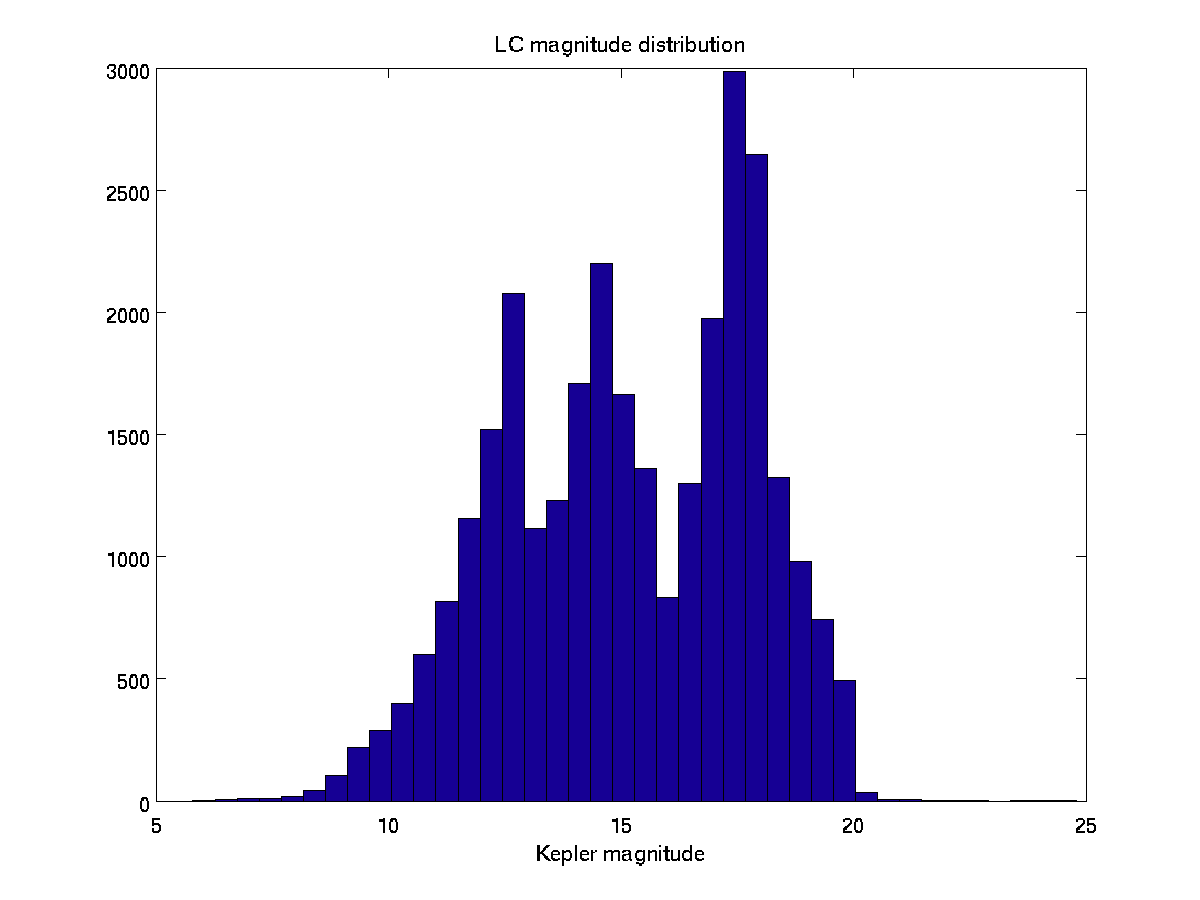
Features and Events
Earth!
C16 was a forward velocity vector campaign, so Earth passed through the FOV at the start of the campaign from 2017-12-07 23:01:18 to 2017-12-11 07:27:11 UTC. Earth traversed channel 67 (long cadence numbers 154331 - 154347) channel 82 (LC 154367 - 154431) and channel 83 (LC 154429: 154491). The saturated image of Earth resulted in a series of saturated columns from the core of the image and significant scattered light over the entire focal plane, as evidenced by the background flux level metric. In addition to the direct image of Earth, there is a optical ghost image on the opposite side of the focal plane (channels 2, 3, 19) whose core is near saturation. Users are cautioned to check carefully for interference from Earth in their data during the first three days of the campaign.
Galaxies
There are 9,245 galaxies targeted in the C16 field of view; all but three used standard aperture masks. The three large galaxies were covered with large circular custom masks.
Clusters
The C16 field of view includes the Beehive cluster (M44) and M67. M44 is one of the most nearby open clusters; its members were observed using standard masks. M67 was tiled with a series of 20 x 20 pixels tiles for a total of 144,000 pixels.
Supernovae
The forward velocity vector orientation during C16 allowed for simultaneous ground-based observations of K2 targets. Numerous supernovae were observed by Kepler and ground-based observatories. More details of the supernova campaign can be found at the Supernova Experiment site.
Pointing and Roll Performance
The C16 pointing and roll behavior are well within the limits of that seen in other K2 campaigns, with no degradation seen due to potentially low fuel levels. The pipeline-calculated maximum distance between the derived and nominal positions for any target (the "maximum attitude residual", or MAR) for C16 is less than 2.3 pixels, well under the 3-pixel limit accommodated by the aperture halos.
As mentioned in the C14 release notes, a change in the on-board fine point fault logging threshold results in additional cadences being flagged as "Spacecraft is not in fine point" (QUALITY flag bit #16, decimal=32768). As a reminder, the project recommends that starting with C15, users look to QUALITY flag bit #3 as an accurate indicator of poor spacecraft pointing.
Data Quality and Processing Notes
Light Curve Quality
As in previous campaigns, the 6-hour spacecraft roll cycle continues to dominate the systematic errors in C16 simple aperture photometry light curves. The pipeline CDPP 12th magnitude noise benchmark for C16 is the lowest seen since C6. It is comparable to that seen in early campaigns with similar star density (C6, C8, C10), but is well below that seen in C12, also with similar star density. While we do not have a definitive cause the for the improved precision, it is likely due to a combination of the relatively low star density, the return to more stable pointing (compared to recent campaigns), and the updated pipeline version (in-particular the use of the coarse-point flags; see the global reprocessing effort announcement for details).
The magnitude dependence of CDPP and its distribution over the focal
plane are shown below. Other CDPP benchmarks can be found in the
table giving 6.5-hr CDPP as a function of magnitude.
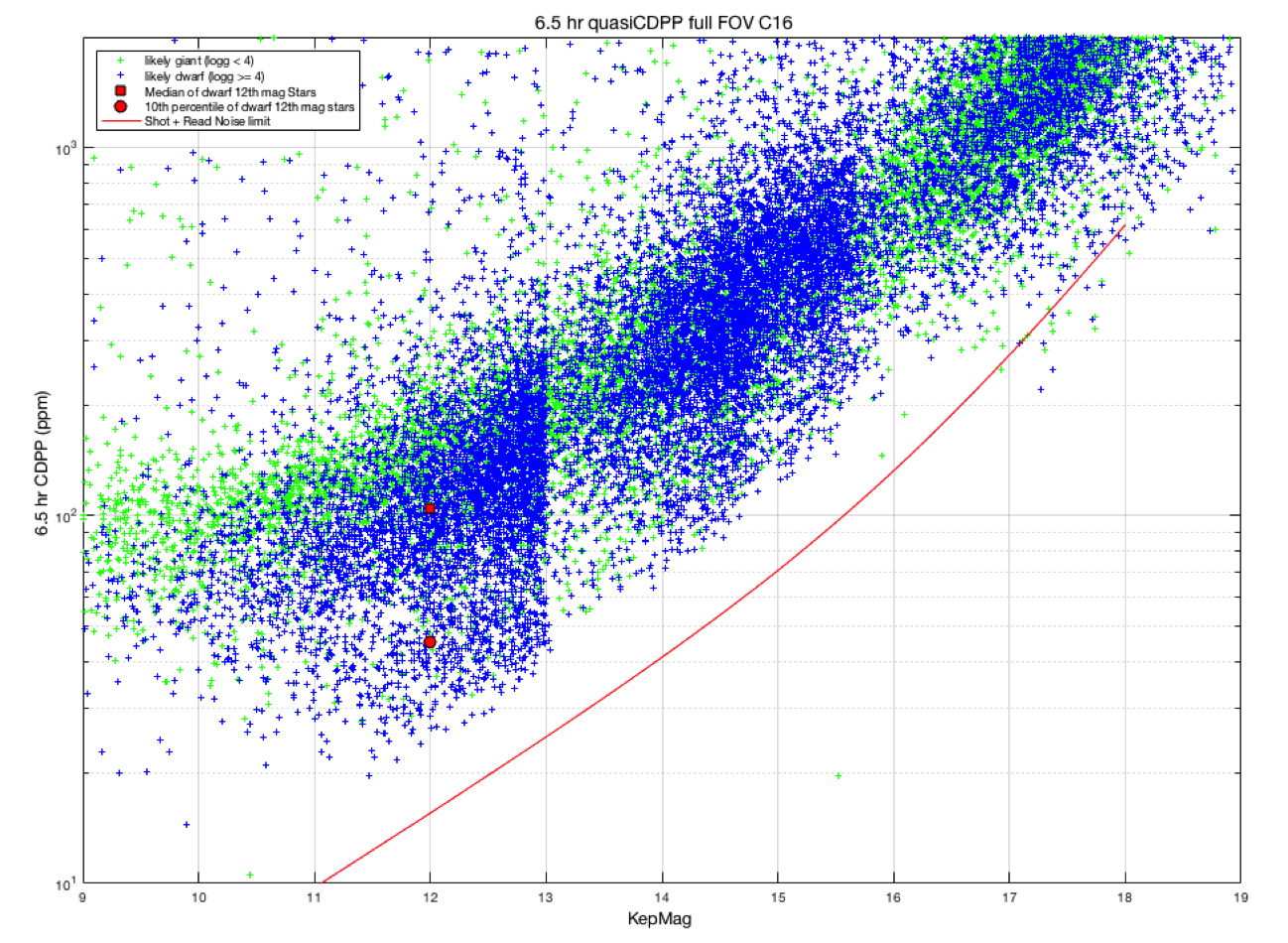
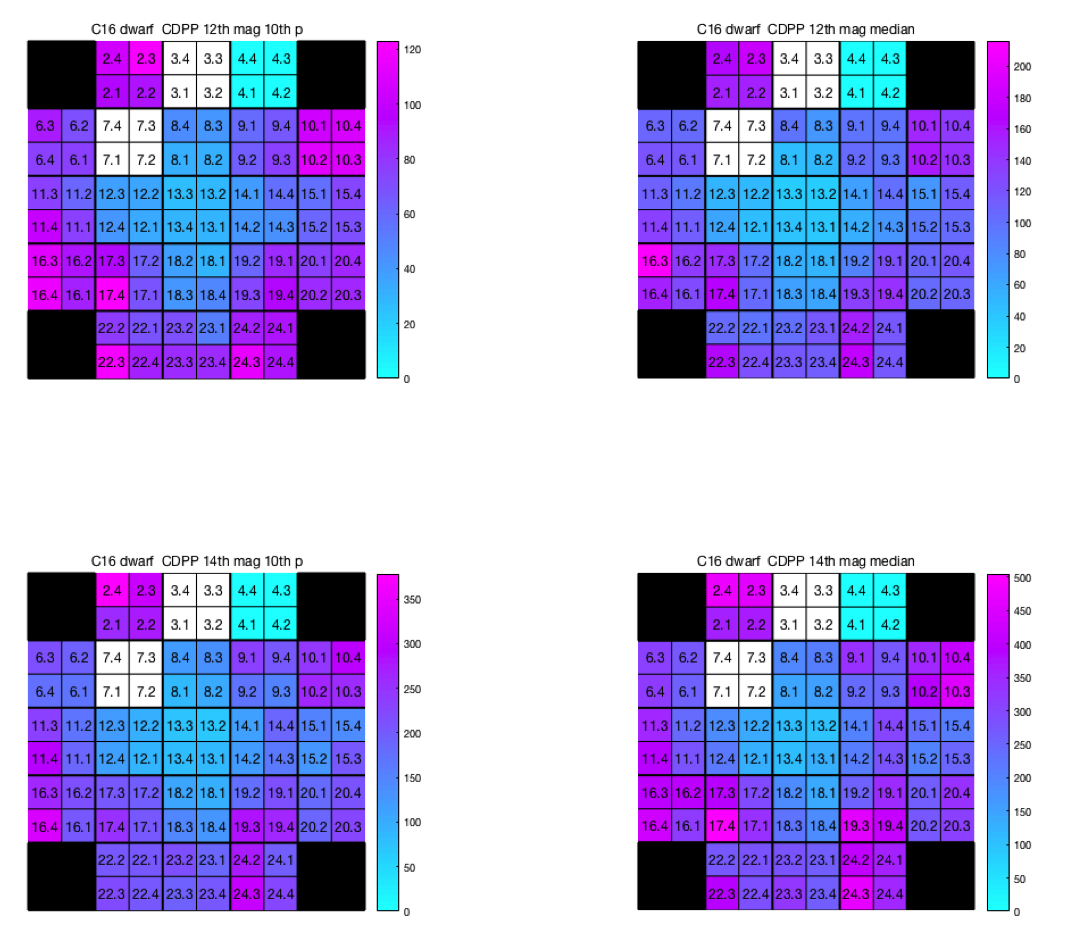
Short-Cadence Target With no PDC Flux
The target HD 76333 (EPIC 200200727), a nearby high proper-motion F3V star, failed short-cadence PDC processing due to it being a custom target and the only target on its channel. The short-cadence light curve file includes the (nominal and unaffected) SAP flux, but the PDC_SAP flux is all zeros. Note that the long-cadence data for this target is unaffected and is nominal.
K2 Campaign 15
At a glance
- RA: 233.6175730 degrees
- Dec: -20.0792397 degrees
- Roll: 166.7780778 degrees
- 35,078 EPIC IDs in long cadence (LC).
- 118 EPIC IDs in short cadence (LC).
- 38 moving objects were tiled with LC custom strip apertures. 13 bright stars were assigned 24-pixel diameter LC disk apertures to capture the point spread function wings. See the csv file that maps the custom aperture number to the target name to find the apertures for a specific target.
- ktwo2017246053350-c15_ffi-cal.fits Note: only one FFI was collected during C15.
- Start Time: 2017-08-23 22:18:11 UTC
- Long Cadence Number: 149142
- Short Cadence Number: 4462720
- End Time: 2017-11-19 22:58:27 UTC
- Long Cadence Number: 153449
- Short Cadence Number: 4591959
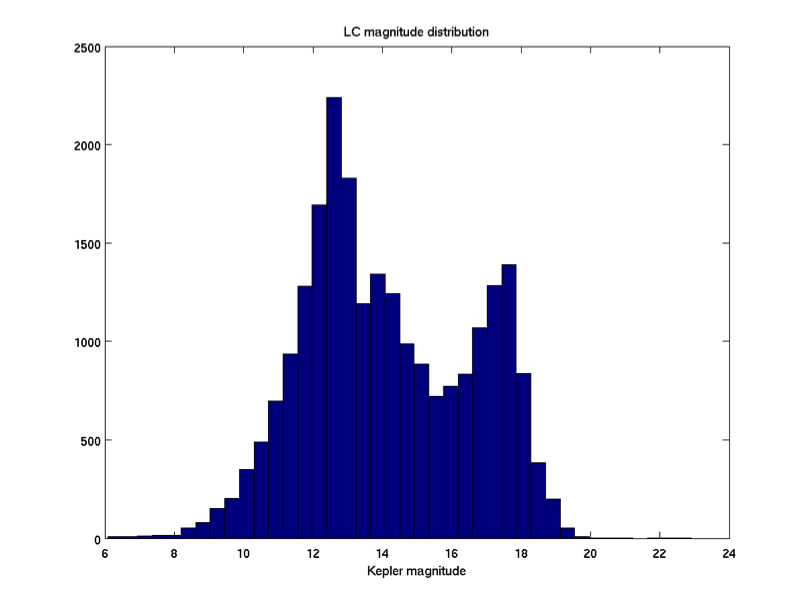
Features and Events
Galaxies and Clusters
There are 3,485 galaxies targeted in the C15 field of view all of which used standard aperture masks.
The C15 field of view overlaps a portion of the young star association Upper Sco. The FOV also contains the old globular cluster NGC 5897, which was tiled with a 6x6 array of 15x15 pixel tiles for a total of 8100 pixels.
Pointing and Roll Performance
The C15 pointing and roll behavior are well within the limits of that seen in other K2 campaigns for the majority of the campaign. The pipeline calculated maximum distance between the derived and nominal positions for any target (the "maximum attitude residual", or MAR) for C15 is less than 2.5 pixels, well under the 3-pixel limit accommodated by the aperture halos. There were far fewer anomalous thruster firing events in C15 than were seen in recent campaigns prior to C14.
As mentioned in the C14 release notes, a change in the on-board fine point fault logging threshold results in additional cadences being flagged as "Spacecraft is not in fine point" (QUALITY flag bit #16, decimal=32768). Starting with C15, the pipeline is now ignoring the spacecraft not-in-fine-point flag, and instead is using the "Spacecraft is in coarse point" flag (QUALITY flag bit #3, decimal=4). This flag is set by the project based on the measured pointing error exceeding 1.5 pixels for 4 or more continuous cadences, or exceeding 2.5 pixels for a single cadence. The pipeline will treat these "coarse-point" cadences just as "not-in-fine-point" cadences were treated in previous campaigns up to and including C14, i.e., there will be calibrated pixels, but light curve data will be gapped for the flagged cadences. The project recommends that starting with C15, users look to QUALITY flag bit #3 as an indicator of poor spacecraft pointing.
Solar Flares and Coronal Mass Ejections (CMEs) During Observations
From September 6—10, 2017 (during C15 observations) the Sun emitted 27 M-class and four X-class flares and released several powerful coronal mass ejections, or CMEs. The effect of these flares and CMEs is visible in K2 data during C15, most notably in the measured dark current level for all channels; we provide examples for channels 15 and 25 below. Peak dark current emission occurred around long cadences 149142 + 675, 901, and 957, respectively, corresponding to BJD 2458003.23, 2458007.85, and 2458009.00. Uses are urged caution in interpreting astrophysical events in observed targets that have similar timing and duration to these CME events.
Data Quality and Processing Notes
Light Curve Quality
As in previous campaigns, the 6-hour spacecraft roll cycle continues to dominate the systematic errors in C15 simple aperture photometry light curves. The pipeline CDPP 12th magnitude noise benchmark for C15 is the lowest seen since C6. It is comparable to that seen in early campaigns with similar star density (C6, C8, C10), but is well below that seen in C12, also with similar star density. While we do not have a definitive cause the for the improved precision, it is likely due to a combination of the relatively low star density, the return to more stable pointing (compared to recent campaigns), and the updated pipeline version (in-particular the use of the coarse-point flags).
The magnitude dependence of CDPP and its distribution over the focal
plane are shown below. Other CDPP benchmarks can be found in the
table giving 6.5-hr CDPP as a function of magnitude.
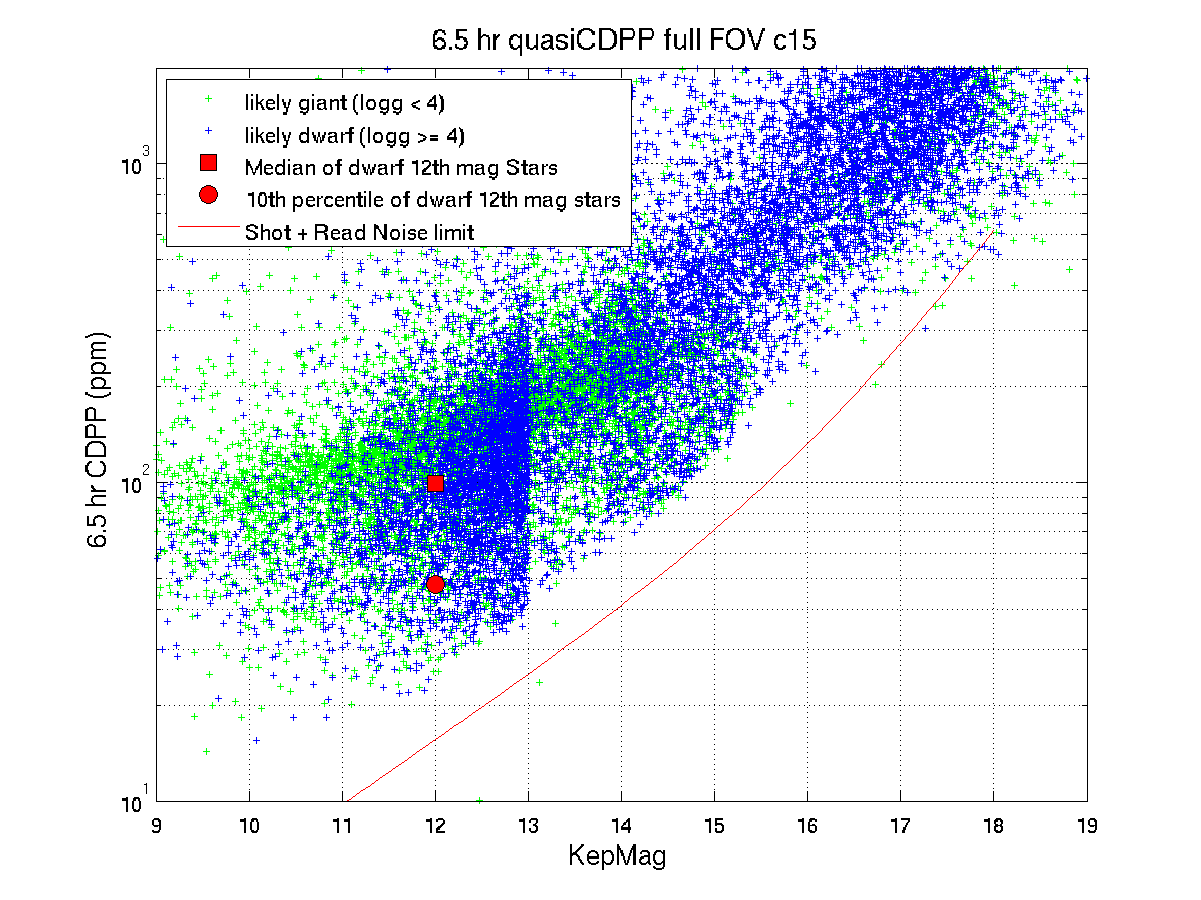
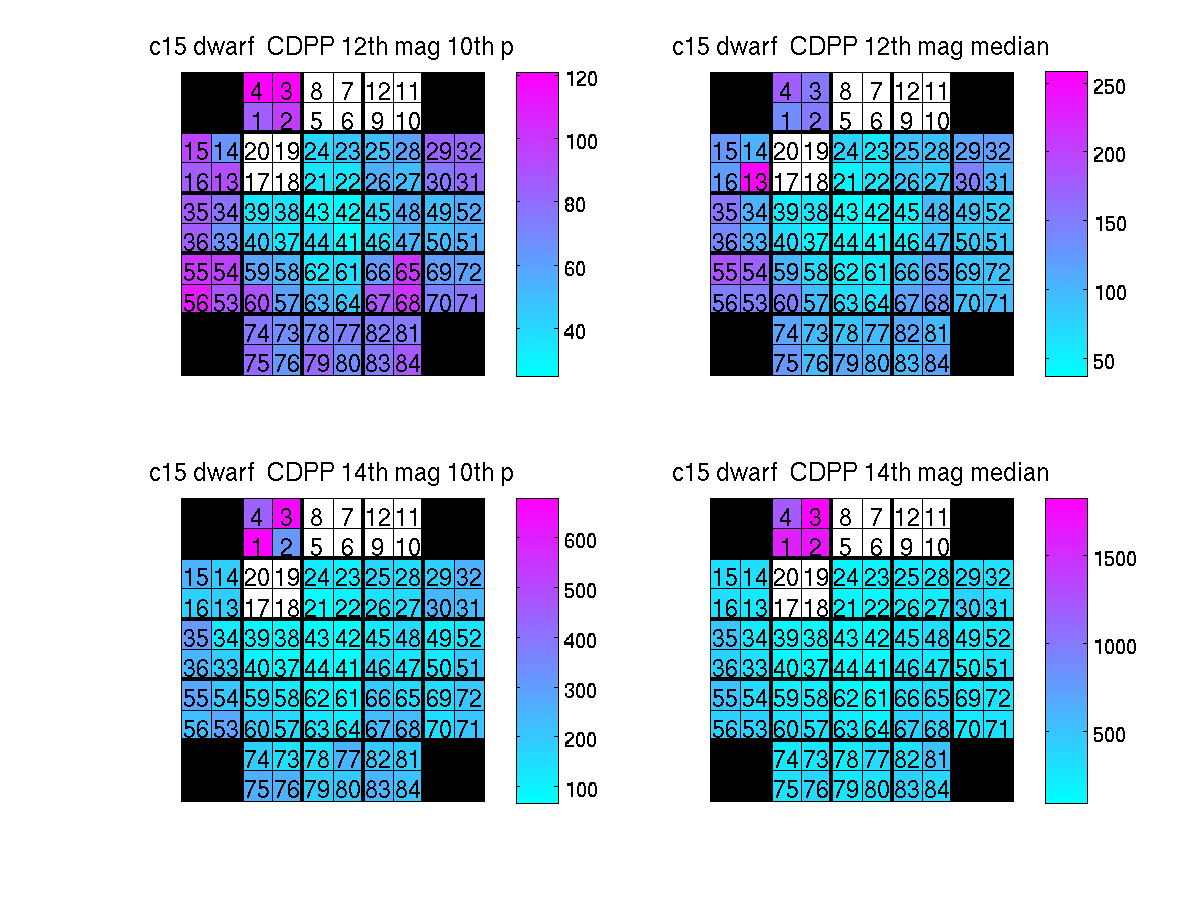
Targets With Incorrect Flux Scaling
During the analysis of C15 data, the Science Office uncovered an inconsistency in how targets with high proper motion are handled. We noted that there is a target with an anomalously high average value for the PDC corrected flux, corresponding to a Kp=7.5 mag star when it should be a magnitude Kp=12 star. The issue was traced to the fact that the target EPIC 250111823, (Ross 802) is a high-proper motion star (-448, -624 mas/yr) that is ~12 arcsec from its J2000 catalog position. The photometric analysis code (PA-COA) was not supplied with proper motion information and did not find a star at the catalog position. The code correctly reverted to the flight target aperture (which does account for proper motion), but computed the flux-fraction in aperture (FFIA~0.03) and crowding metric based on the assumption that the target was well outside the flight aperture. The low flux-fraction in aperture caused the PDC flux time series (PDCSAP_FLUX) to be scaled up by a factor of ~1/0.03, or ~33. The time variation of the PDCSAP_FLUX is correct for the target aperture, only mis-scaled. The SAP_FLUX is unaffected by this bug.
The Science Office is assessing the impact of this issue in K2, but there is a potential mis-scaling for any targets with accumulated proper motion since J2000 that is larger than ~1.5 pixels (~6 arcseconds). Users should check for potentially mis-scaled PDCSAP_FLUX for any of the C15 targets with accumulated proper motion ≥ 1 pixel (~4 arcseconds).
Targets Affected by CAL Bug
Due to a bug in the smear tables, column 928 on channel 33, and column 1008 on channel 47, had both their real and virtual smear values gapped, which resulted in values of "0.0" for the flux along the entire column. This might potentially affect the light curves of the following targets, which contain the affected column in their pixel-stamp image. Users may want conduct custom photometry that excludes or accounts for the affected column.
The EPIC IDs of the affected targets are 249868223, 249921937, 249924613, 249934130, and 249198204.
Dynamic Black Correction
A new feature of the Kepler pipeline that was implemented for K2 processing, starting with C15, is the use of Dynamic Black Correction, or "Dynablack", which is essentially a more sophisticated algorithm to perform the CCD pixel-level calibration that accounts for time varying, instrument-induced artifacts when calibrating the data.
Dynablack uses the full-frame images and collateral pixels to provide two main benefits compared to traditional pixel calibration:
-
Correct thermally dependent fine guidance sensor crosstalk pixels.
-
Identify rolling-band artifacts (see §6.7 of the Instrument Handbook) with flags in the target pixel files.
For the latter case, users can use the new RB_LEVEL flags in the FITS files. See §A.1.1 of the Kepler Data Release 25 Notes and §2.3.2 of the Kepler Archive Manual for information on how to interpret and utilize the RB_LEVEL flags. Users should note that the RB_LEVEL test at the shortest duration (3 hours) is overly sensitive to instrument noise and does not offer a reliable indicator of the presence of rolling band pattern noise. Because the binary "Rolling Band Detected" QUALITY and SAP_QUALITY flags (bits 18, 19) in the target pixel files and light curve files are based on a rolling band detection at any of the test durations, they also do not provide a reliable indicator of the presence of rolling band pattern noise. The RB_LEVEL flags at durations of 6 hours and longer provide the best indication of the presence of rolling band artifacts.
Short Cadence Light Curves
Starting with C15, short-cadence light curves are now produced and available at MAST, though we strongly caution users that no work was done to adapt the Kepler pipeline's detrending module (PDC), developed for Kepler data, to work well on K2 data. Thruster firings are especially poorly corrected for most short-cadence targets, and other systematic features may not be corrected well. See Figure C15-SC-Example-1 below for an example of remaining systematics in short-cadence data around thruster firings. However, some targets do have adequate detrending in short-cadence, and even in the cases of poor detrending, short-term astrophysical variation can be seen for targets where such astrophysical variation exists. See Figure C15-SC-Example-2 below where the ~18 min periodic variations of the AM CVn type binary HP Lip are readily apparent in the C15 short-cadence light curve. The hope is that producing these short-cadence light curves overall benefits the community compared to not producing them, even if they may only be used for initial inspection of the short-cadence data, which might prompt users to perform their own short-cadence detrending, or better adapt the existing long-cadence Cotrending Basis Vector (CBV) files for use in detrending the short-cadence data.
K2 Campaign 14
These release notes are for the C14 data currently available at MAST (Data Release 40) in the nominal K2 data locations, which have been processed with the final version of the K2 pipeline as part of the K2 global uniform reprocessing effort. The original release notes corresponding to the previous versions of C14 data (Data Release 20) can be found in the archived data release notes page.
At a glance
- RA: 160.6824762 degrees
- Dec: 6.8509316 degrees
- Roll: 158.7573464 degrees
- 39,024 EPIC IDs in long cadence (LC).
- 147 EPIC IDs in short cadence (LC).
- 42 moving objects were tiled with LC custom strip apertures. 7 bright stars were assigned 24-pixel diameter LC disk apertures to capture the point spread function wings. See the csv file that maps the custom aperture number to the target name to find the apertures for a specific target.
- Start Time: 2017-06-01 05:06:29 UTC
- Long Cadence Number: 145045
- Short Cadence Number: 4339810
- End Time: 2017-08-19 22:11:02 UTC
- Long Cadence Number: 148945
- Short Cadence Number: 4456839
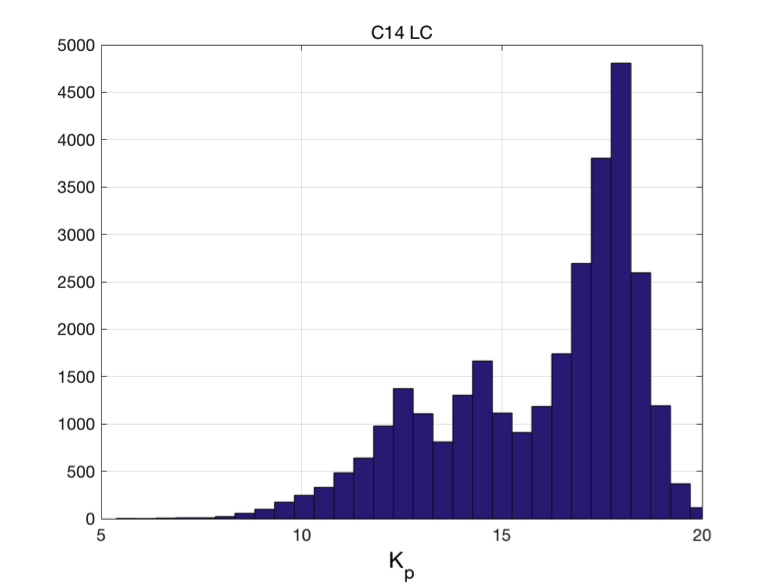
Features and Events
Galaxies
The C14 field of view sits at 53° N Galactic latitude in the North Galactic cap. There are 14,691 galaxies targeted in the C14 field of view. 47 of the Galaxies with radii > 40 arcseconds were covered with large circular masks. Twelve galaxies were covered with 15x15 pixel square masks. Six galaxies (M95, M96, M105, NGC3384, NGC3423, NGC3412) were covered by 40x40 pixel square masks consisting of 16 tiles of 10x10 pixel sub-masks.
The MAST K2 Data Search and Retreival Page has an option to select data by Object Type, including a section for Galaxies, which includes all the large galaxies mentioned above. The corresponding custom EPIC IDs for the masks can also be found in the custom aperture file hosted at MAST.
In addition to the many galaxies, a number of notable targets were observed during C14, including Wolf 359, a nearby late M-dwarf.
Pointing and Roll Performance
The C14 pointing and roll behavior are well within the limits of that seen in other K2 campaigns for the majority of the campaign. The pipeline calculated maximum distance between the derived and nominal positions for any target (the "maximum attitude residual", or MAR) for C14 is less than 1.8 pixels, well under the 3-pixel limit accommodated by the aperture halos. There were far fewer anomalous thruster firing events in C14 than were seen in other campaigns.
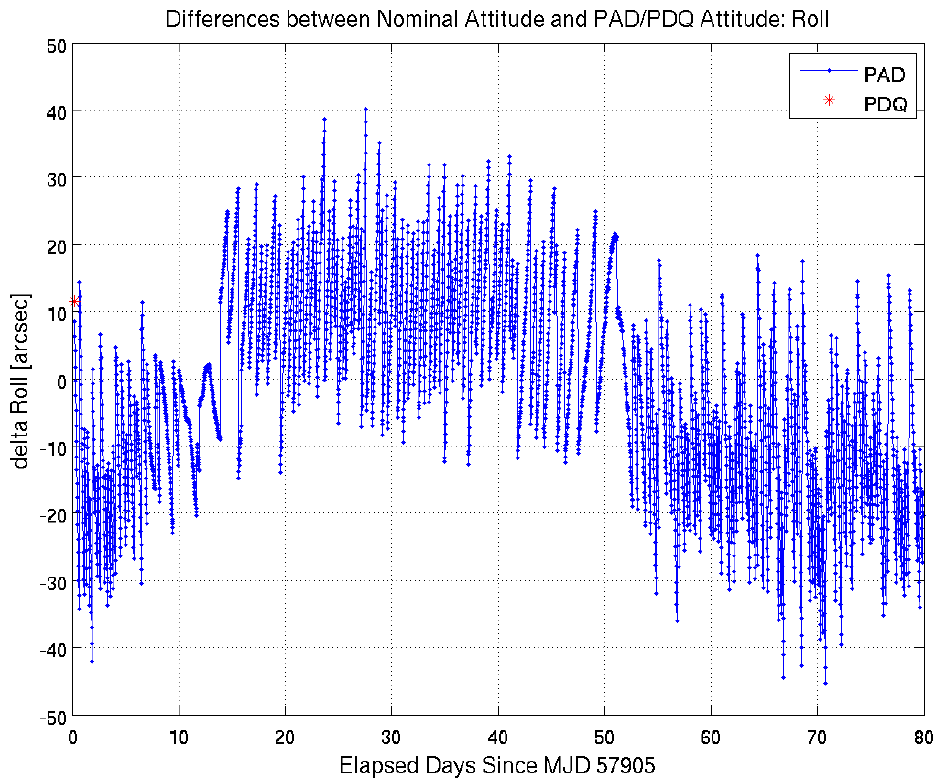
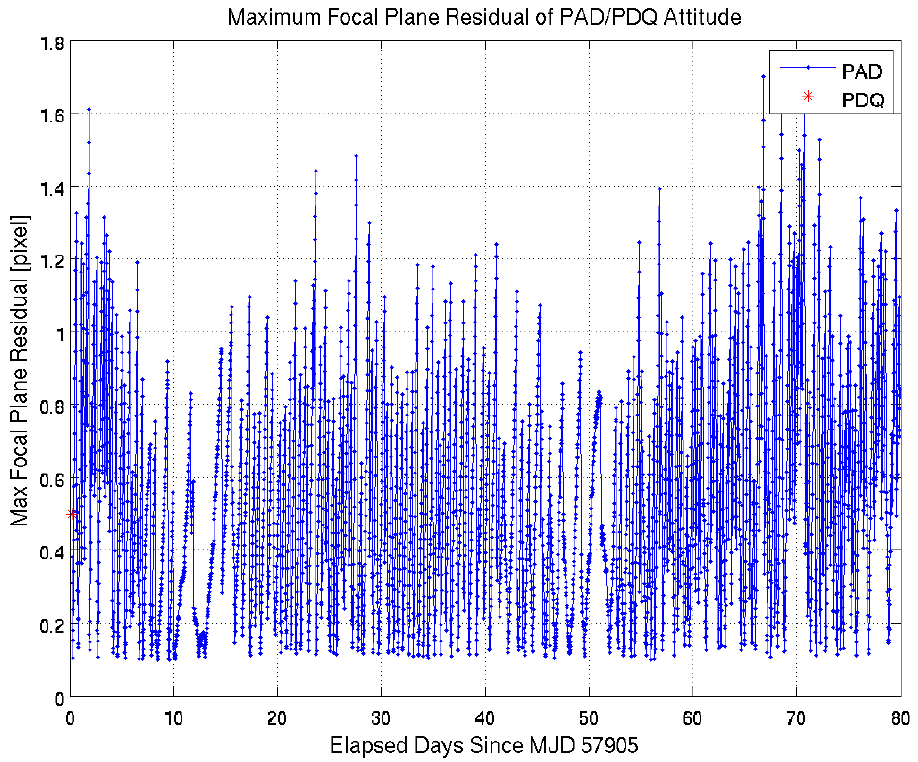
Data Quality and Processing Notes
Light Curve Quality
As in other campaigns, the 6-hour spacecraft roll cycle dominates the systematic errors in C14 simple aperture photometry light curves. The pipeline CDPP 12th magnitude noise benchmark for C14 (DR40) is comparable to that seen in other campaigns with similar star density.
The magnitude dependence of CDPP and its distribution over the focal plane are shown below. Other CDPP benchmarks can be found in the table giving 6.5-hr CDPP as a function of magnitude.
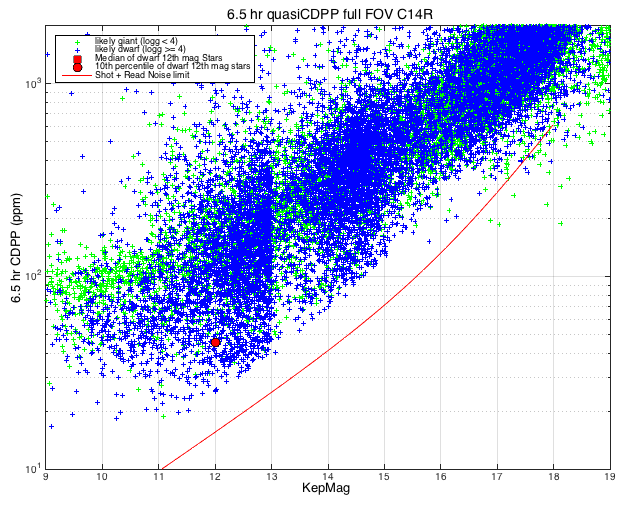
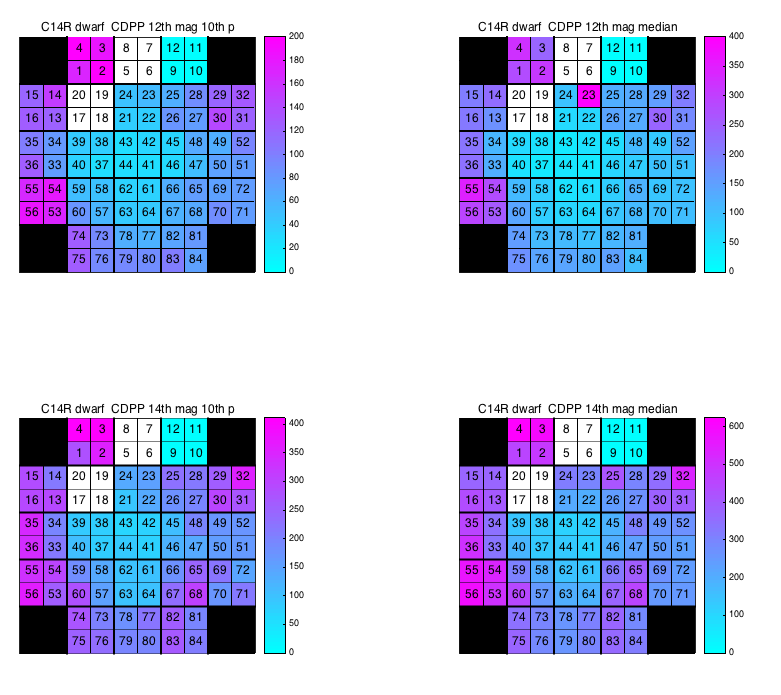
No Lightcurve Files for Wolf 359
Due to an error in pipeline configuration for the data release 40 processing, the proper motion of Wolf 359 (~4.7 arcseconds/yr, or >1 Kepler pixel per year) was not taken into account. As a result, there was no optimal aperture generated for the target, and thus no long- or short-cadence lightcurve files were produced. The target pixel files, aside from not having any pixels identified as belonging to an optimal aperture, were not affected.
Users are encouraged to create their own lightcurves for this object from target pixel files using software such as the lightkurve Python package, PyKE software tool suite, or other packages.
Improper Smear Correction for Channel 74
For data release 40, channel 74 in campaign 14 had an improper smear correction that results in an additive effect at the pixel-level, with two step-wise discontinuities.
The cause of this improper correction appears to be unexpected behavior from the Dynablack pixel-level calibration algorithim (see news post here) that was used for data release 40. Outliers unique to this channel and campaign caused Dynablack to improperly bias-correct the smear calibration region, which in turn led to an improper smear correction for the entire channel.
As shown in Figure C14-DR40-Smear, this results in an additive effect of ~5E4 electrons per cadence per pixel, with a step discontinuity at cadences ~510 and ~2600 (MJD ~57905 and ~57958) of an extra ~1.5E4 electrons per cadence per pixel. The discontinuities correspond to when the spacecraft crossed the roll pointing zero-points. This effect is for every pixel in channel 74. As it is an additive effect, only faint targets should be significantly affected, depending on the number of pixels used for the photometric aperture relative to the target's flux. Users are cautioned to be aware of this effect when interpreting any signals for their science.
Note that, at some level, this effect influences the creation of the CBVs for all channels in the same PDC unit of work as channel 74 (channels 73–84). If the CBVs have this signal present, then all PDC lightcurves for all targets on those channels could have it present. However, inspection of PDC lightcurves on these channels did not reveal any significantly visible effect, and thus users should not have to worry about this signal being present in lightcurves for channels other than 74.
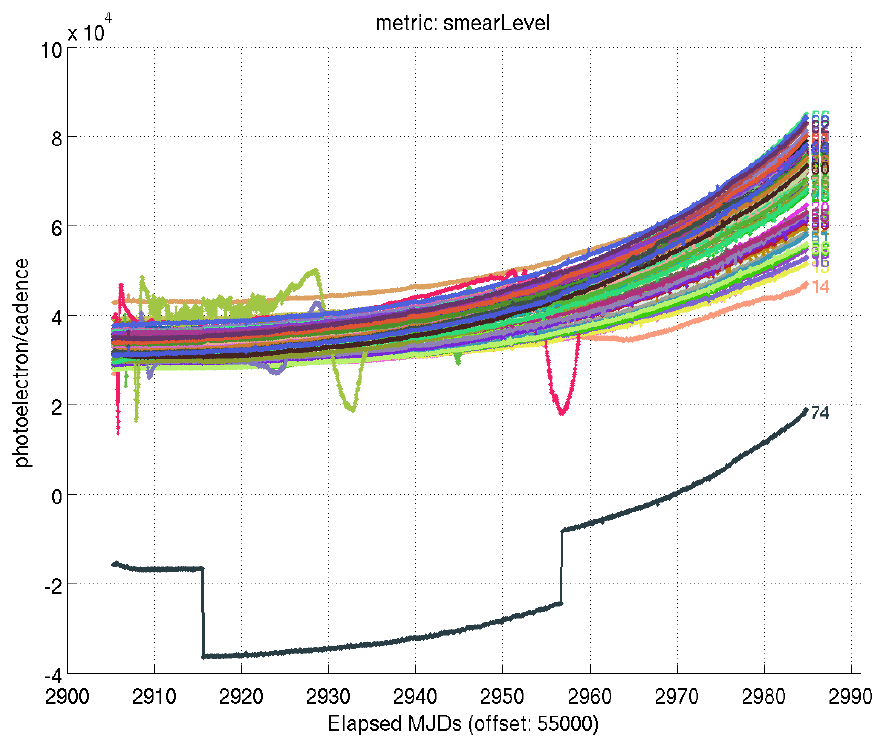
K2 Campaign 13
These release notes are for the C13 data currently available at MAST in the nominal K2 data locations, which have been processed with the final version of the K2 pipeline as part of the K2 global uniform reprocessing effort. The original release notes corresponding to the previous version(s) of C13 data can be found in the archived data release notes page.
At a glance
- RA: 72.7971166 degrees
- Dec: 20.7870759 degrees
- Roll: -172.7995758 degrees
- 26,170 EPIC IDs in long cadence (LC).
- 118 EPIC IDs in short cadence (LC).
- 15 moving objects were tiled with LC custom strip apertures. 33 bright stars, including Aldebaran, were assigned 40-pixel diameter LC disk apertures to capture the point spread function wings. Nine bright Hyades cluster stars were assigned 24-pixel diameter SC disk apertures. See the csv file that maps the custom aperture number to the target name.
- ktwo2017079075530-c13_ffi-cal.fits Note: only one FFI was collected during C13.
- Start Time: 2017-03-08 01:35:06 UTC
- Long Cadence Number: 140878
- Short Cadence Number: 4214800
- End Time: 2017-05-27 15:44:53 UTC
- Long Cadence Number: 144821
- Short Cadence Number: 4333119

Features and Events
Clusters and Star Forming Regions
The C13 field of view encompasses part of the Taurus star forming region, including the well known T-Tauri stars HL Tau (EPIC 210690913) and LkCa 15 (EPIC 247520207). The field of view also covers a portion of the Hyades star cluster along with the distant clusters NGC 1647, NGC 1746, and NGC 1817.
Galaxies
There are 33 galaxies targeted in the C13 field of view.
Pointing and Roll Performance
The C13 pointing and roll behavior are within the limits of that seen in other K2 campaigns for the majority of the campaign. The pipeline calculated maximum distance between the derived and nominal positions for any target (the "maximum attitude residual", or MAR) for C13 is well under the 3-pixel limit accommodated by the aperture halos, except for three periods with anomalous thruster firings. One is in the first day of the campaign lasting for 6 hours starting at 2017-03-08 17:46:06 UTC (cadence numbers 140911-140922). Two periods of anomalous pointing occur in the final five days of the campaign: 18 hours starting at 2017-05-23 12:11:44 UTC (cadence numbers 144619-144654), and 6 hours starting at 2017-05-25 11:16:28 UTC (cadence numbers 144715-144726).
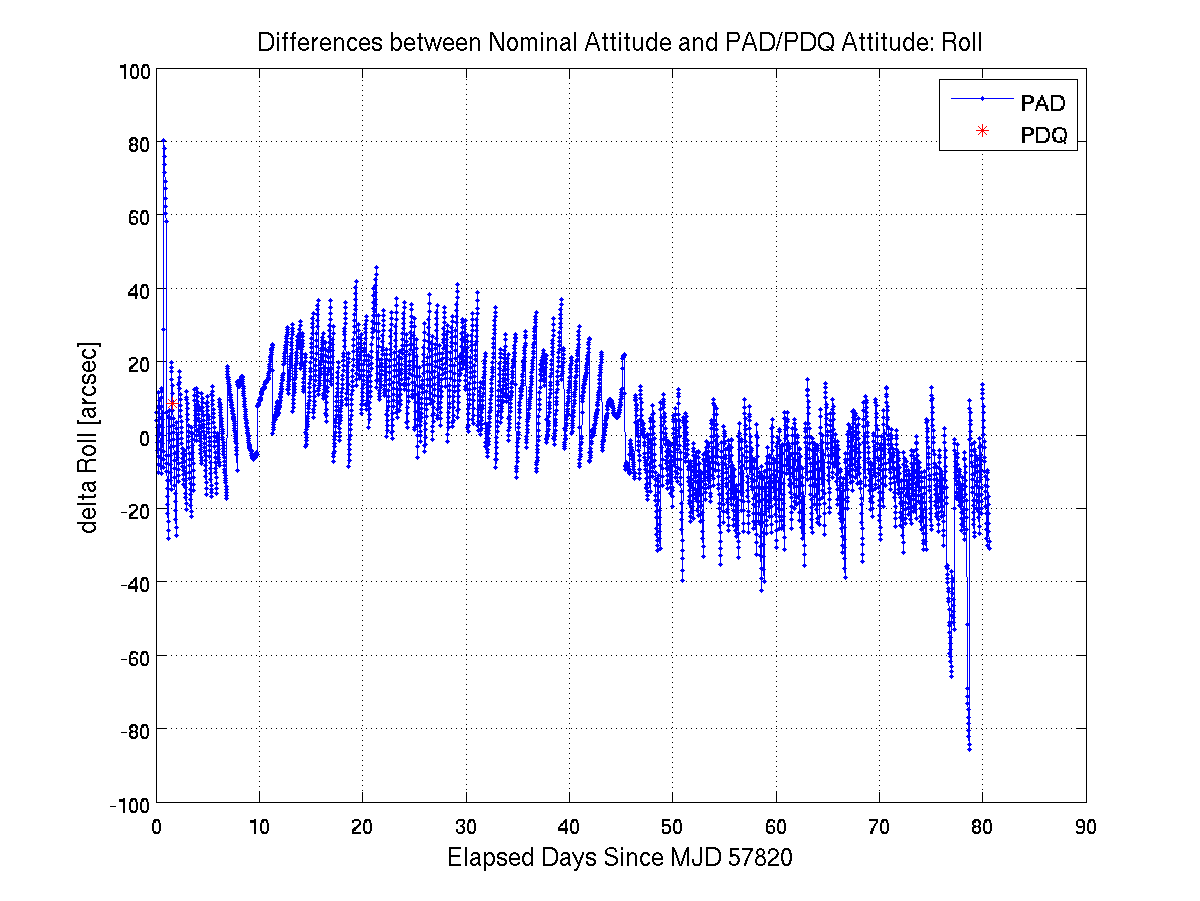
Data Quality and Processing Notes
Light Curve Quality
As in previous campaigns, the 6-hour spacecraft roll cycle continues to dominate the systematic errors in C13 simple aperture photometry light curves. The pipeline CDPP 12th magnitude noise benchmark is similar to star fields of comparable star density (e.g., C4, C5, C16).
The magnitude dependence of CDPP and its distribution over the focal
plane are shown below. Other CDPP benchmarks can be found in the
table giving 6.5-hr CDPP as a function of magnitude.
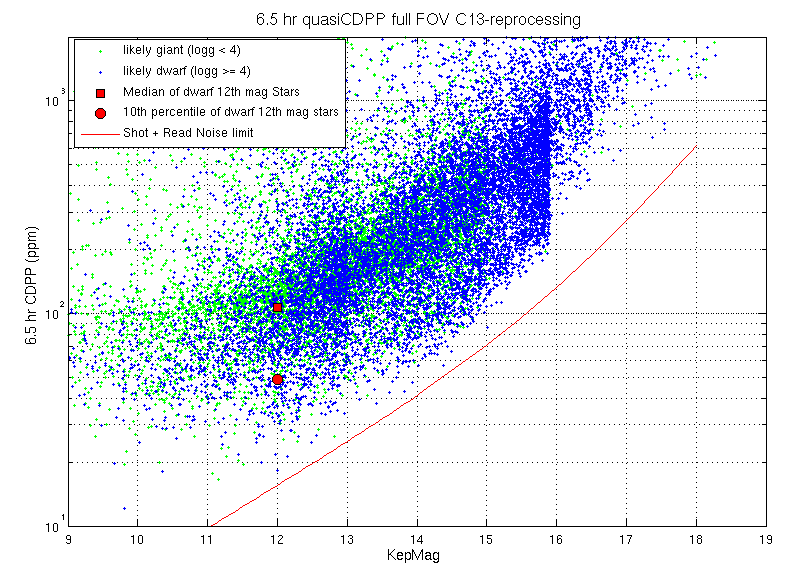
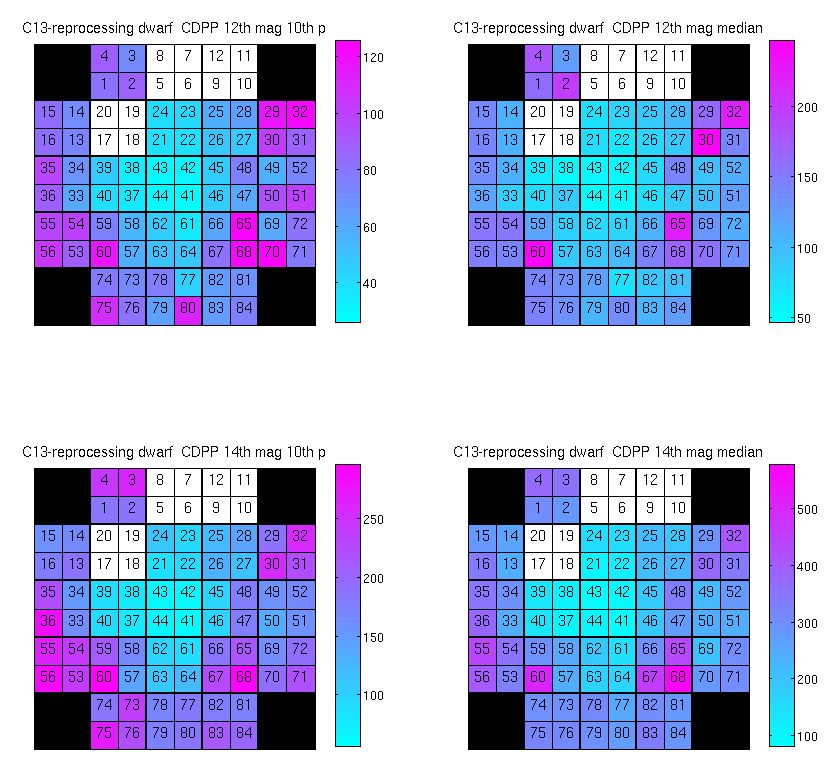
Short-Cadence Targets With no PDC Flux
The following four targets failed short-cadence PDC processing due to them being custom targets and the only targets on their channel. The short-cadence light curve files include the (nominal and unaffected) SAP flux, but the PDC_SAP flux is all zeros. Note that the long-cadence data for these targets are unaffected and are nominal.
- 200173880
- 200173881
- 200173884
- 200173885
K2 Campaign 12
These release notes are for the C12 data currently available at MAST (Data Release 39) in the nominal K2 data locations, which have been processed with the final version of the K2 pipeline as part of the K2 global uniform reprocessing effort. The original release notes corresponding to the previous versions of C12 data (Data Release 18) can be found in the archived data release notes page.
At a glance
- RA: 351.6588124 degrees
- Dec: -5.1023328 degrees
- Roll: -156.8808419 degrees
- 45,951 EPIC IDs in long cadence (LC).
- 234 EPIC IDs in short cadence (LC).
- 42 unique LC custom targets were selected, along with two SC custom target apertures for Chiron and Trappist-1. See the csv file that maps the custom aperture number to the target name.
- Start Time: 2016-12-15 20:40:49 UTC
- Long Cadence Number:136855
- Short Cadence Number: 4094110
- End Time: 2017-03-04 18:37:47 UTC
- Long Cadence Number: 140716
- Short Cadence Number: 4209969
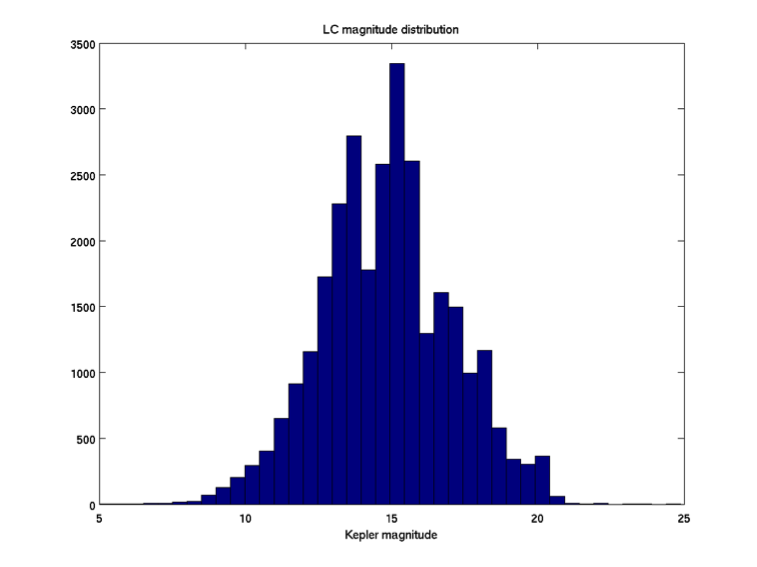
Features and Events
Mars
Mars passed through the focal plane during C12, entering active silicon on module 24 output 3 (channel 83) on 2017-01-16 (relative cadence index 1550) and moving off of module 3 output 4 (dead channel 8) on 2017-02-09 (relative cadence index 2728). In order, Mars fell on the active channels 83, 82, 67, 66, 41, 42, 22, and 23 (see this figure for the detector channel layout). The movie C12-Mars-at-LC below shows the direct image of Mars passing over channel 83. With an average visual magnitude of V ~ -0.2, the image of Mars is highly saturated and introduces significant scattered light. It also creates a video crosstalk signal in each of the other three channels of each module on which it falls. In addition, there is a ghost image of Mars caused by reflection off of the field-flattener lens and CCD then off of the Schmidt correcter and back to the focal plane. This ghost image appears approximately on the opposite side of the boresight from the direct Mars image. An example of the direct image with crosstalk and the ghost image is shown in the figures below (C12-Module-8 Mars FFI Image, C12-Channel-62 Mars Ghost Image) taken from the second FFI: ktwo2017032102633-c12_ffi-cal.fits.

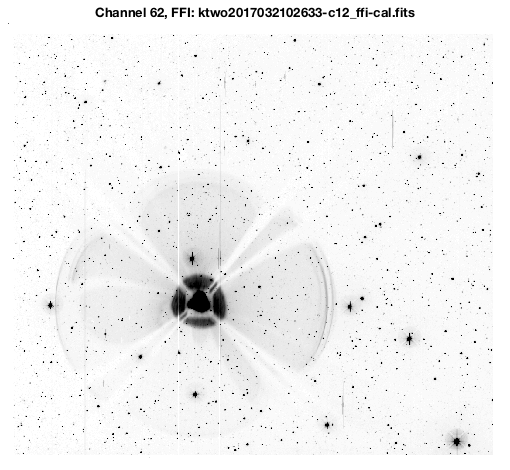
A more quantitative understanding of the signals from Mars can be gained from the raw flux profiles below of Mars and its ghost image, taken from the same FFI. The profile shows a slice through the direct image for a rough guide to the azimuthally-averaged part of the image. Note that the saturation spills across all CCD rows for the central columns of the Mars image and the diffraction spikes extend over multiple channels. Spikes in the profile plot are caused by stray stars. Users should also note that the median rate of motion of Mars is 11 pixels per Long Cadence.
For users wishing to have a better idea when Mars may have affected the data from particular targets, pipe-delimited text files for the path of Mars c12_mars_direct.txt and its ghost c12_mars_ghost.txt during the middle of C12 have been generated using the JPL Horizons website. The location of Mars was calculated from the Kepler-o-centric (NAIF Id = -227) RA and DEC. The location of Mars and its ghost in the FFI are in the headers of the respective files.
The location of the ghost was calculated by rotating the RA and DEC of Mars around the boresight by 180 degrees and is approximate due to variations of the CCD and field-flattener lens positions and orientations from the ideal focal plane. Based on the FFI and the long cadence pixel data, the ghost can vary in position by up to ~100 pixels from the locations given in the table. Given this variation and the large size of the ghost image, users might be advised to use caution if their target is within 200 pixels from the (predicted) ghost image and 350 pixels from the direct image of Mars.
Galaxies
There are 2576 galaxies targeted in the high Galactic latitude (-60º) C12 field of view.
Pointing and Roll Performance
The C12 pointing and roll behavior are within the limits of that seen in other K2 campaigns for the majority of the campaign. The pipeline calculated maximum distance between the derived and nominal positions for any target (the "maximum attitude residual", or MAR) for C12 is less than 2.0 pixels for nearly the entire campaign, well under the 3-pixel limit accommodated by the aperture halos. The exception is one 6-hour period starting at 2017-03-03 19:05:24 (MJD 57815.79542) right near the end of the campaign, as can be seen in Figures C12-Roll-Error and C12-MAR. Cadence numbers 140670–140681 have a roll error of more than -50 arcseconds, though roll performance returned to normal at the subsequent thruster firing and remained nominal for the rest of the campaign.
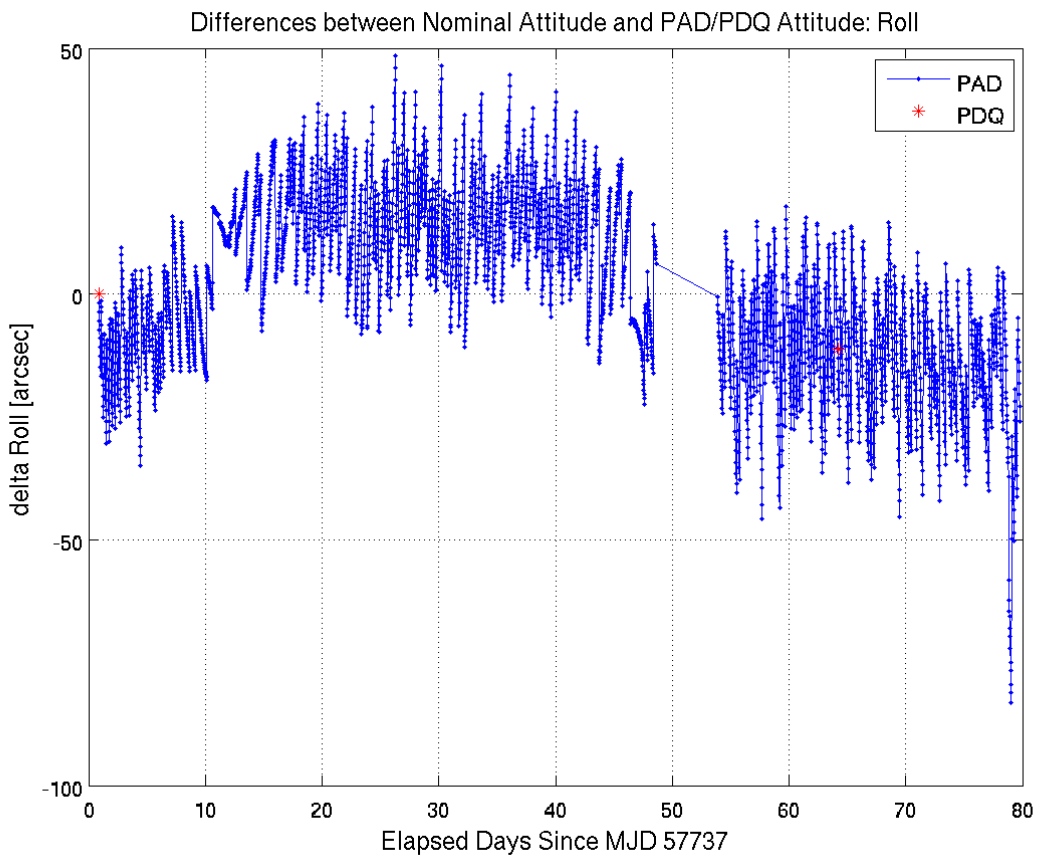
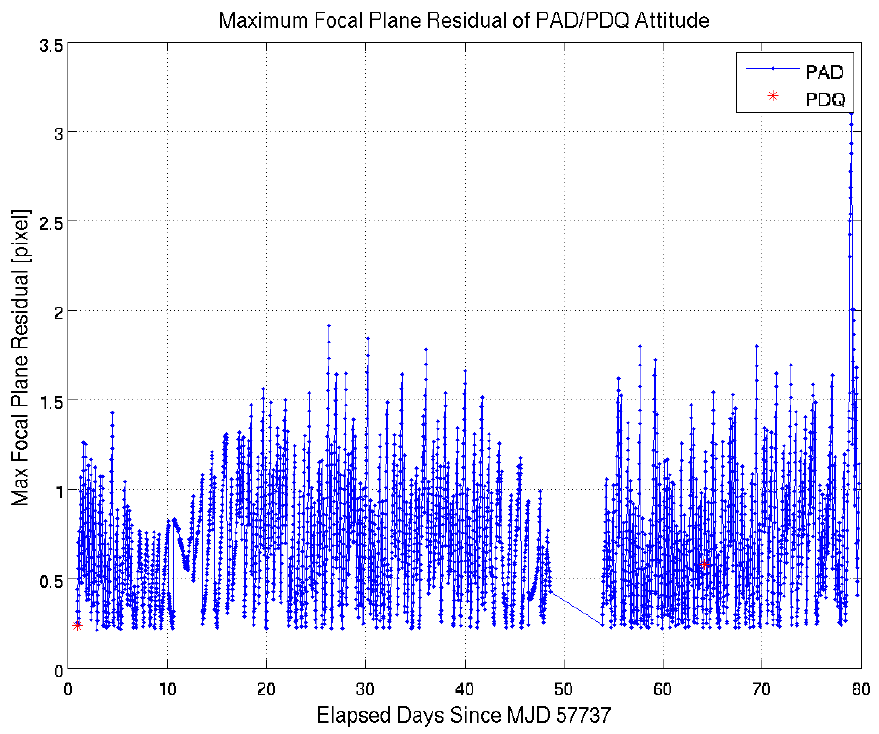
Safe Mode and Loss of Engineering Data On 2017-02-01 15:06 UTC (MJD 57785.62917) the spacecraft entered safe mode. The safe mode was likely due to a flight software reset, which occurred several times during the Kepler/K2 mission. The recovery from this safe mode was routine and the spacecraft resumed science data collection at 2017-02-06 20:47 UTC (MJD 57790.86597). The total time lost to this safe mode was 5.25 days.
In order to minimize the science data loss, the project decided not to downlink stored engineering data during during the safe mode recovery. This decision resulted in the loss of ~10 days of engineering data, starting 2017-01-25 08:16 UTC (MJD 57778.344) and extending into the safe mode. No stored science data were lost. The engineering data includes the thruster firing data, so there is no thruster firing information from the spacecraft for this time period. In order to fill in the thruster firing information in the archive data files, the short cadence pointing history was used to detect likely thruster firings during the data gap. If the thruster firing could be unambiguously identified within a SC interval, a thruster firing was flagged in the QUALITY and SAP_QUALITY fields (bit 21). If the thruster firing appeared to span SC intervals, both intervals would be flagged with a possible thruster firing (bit 20). Users should be alert to possible missed thruster firings in the interval from 2017-01-25 08:16 UTC (MJD 57778.344) to the start of the safe mode at 2017-02-01 15:06 UTC (MJD 57785.62917).
Data Quality and Processing Notes
Light Curve Quality
As in other campaigns, the 6-hour spacecraft roll cycle continues to dominate the systematic errors in C12 simple aperture photometry light curves. In spite of the sparse nature of the C12 field of view, the pipeline CDPP 12th magnitude noise benchmark is a bit higher than what was seen in star fields of comparable star density (53 ppm in C12 vs 42 ppm in C6 and 47 ppm in C8). The passage of Mars most significantly affected CDPP on the channels with the direct and ghost images; however, excluding these channels does not significantly lower the 12th magnitude CDPP benchmark value. It is unknown exactly why the noise benchmark is higher.
The magnitude dependence of CDPP and its distribution over the focal
plane are shown below. Other CDPP benchmarks can be found in the
table giving 6.5-hr CDPP as a function of magnitude.
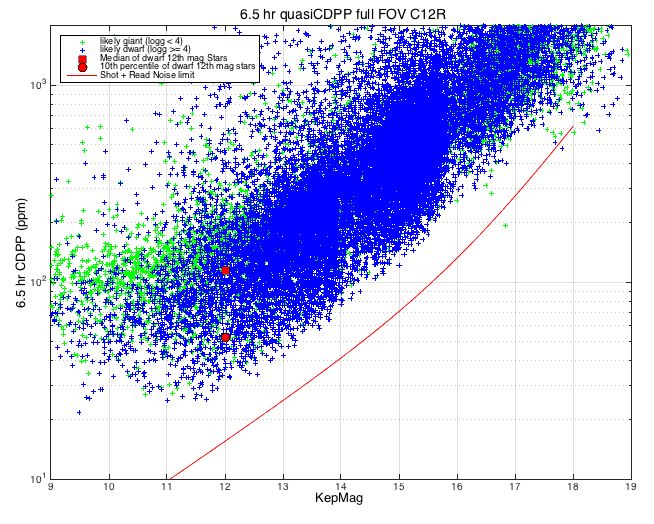
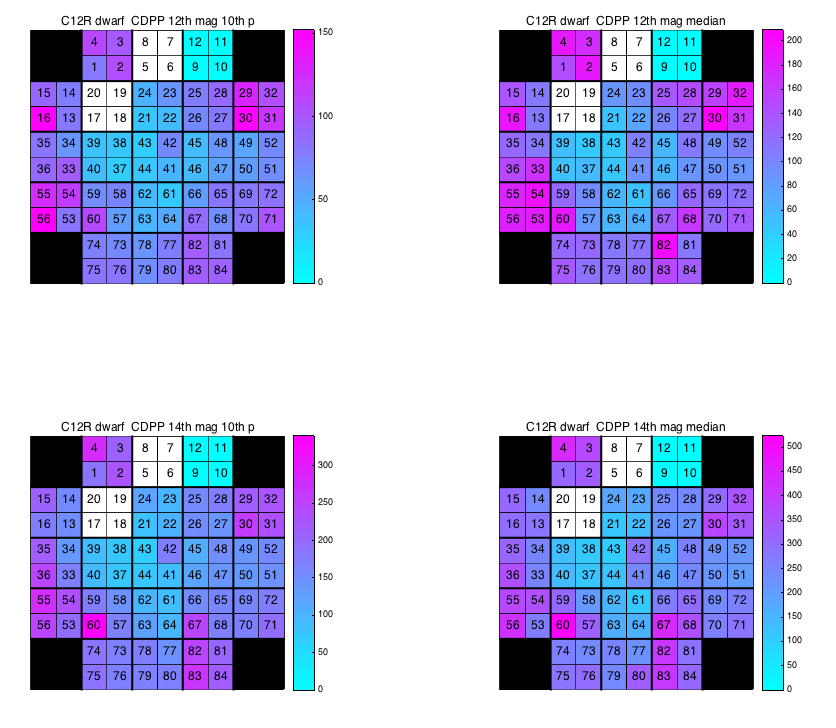
K2 Campaign 11
These release notes are for the C11 data currently available at MAST (Data Release 30) in the nominal K2 data locations, which have been processed with the final version of the K2 pipeline as part of the K2 global uniform reprocessing effort. The original release notes corresponding to the previous version(s) of C11 data (Data Release 17) can be found in the archived data release notes page.
At a glance
Campaign 11 was operationally separated into two segments as a result of an error in the initial roll-angle used to minimize solar torque on the spacecraft. The larger than expected roll motion seen at the start of the campaign meant that the targets would be rolling out of their pixel apertures by the end of the campaign. The excess roll motion was corrected twenty-three days into the campaign by applying a -0.32º roll offset. The size of this correction meant that new target aperture definitions had to be used for the second part of the campaign. The two segments, colloquially called C11a and C11b, are identified in the archive products as C111 and C112, respectively.
C11a Pointing- RA: 260.3880064 degrees
- Dec: -23.9759578 degrees
- Roll: 176.7437075 degrees
- RA: 260.3880064 degrees
- Dec: -23.9759578 degrees
- Roll: 176.4237075 degrees
- delta-RA: 0.0 degrees
- delta-Dec: 0.0 degrees
- delta-Roll: -0.32 degrees
- 32,812 EPIC IDs in long cadence (LC).
- 67 EPIC IDs in short cadence (LC).
- 72 Custom targets (see below).
- 32,508 EPIC IDs in long cadence (LC).
- 66 EPIC IDs in short cadence (LC).
- 72 Custom targets (see below).
- No new targets were added for C11b. Because of the change in pointing, 304 long cadence targets and 1 short cadence target fell off active silicon and thus were dropped in C11b.
The two C11 FFIs were taken at the C11a and C11b pointings respectively. The -0.32 degree roll offset is evident when comparing the two images.
C11a First cadence- Time: 2016-09-24 19:12:30 UTC
- Long Cadence Number: 132839
- Short Cadence Number: 3973630
- Time: 2016-10-18 02:16:19 UTC
- Long Cadence Number: 133979
- Short Cadence Number: 4007859
- Time: 2016-10-21 06:17:05 UTC
- Long Cadence Number: 134134
- Short Cadence Number: 4012480
- Time: 2016-12-07 23:23:03 UTC
- Long Cadence Number: 136469
- Short Cadence Number: 4082559
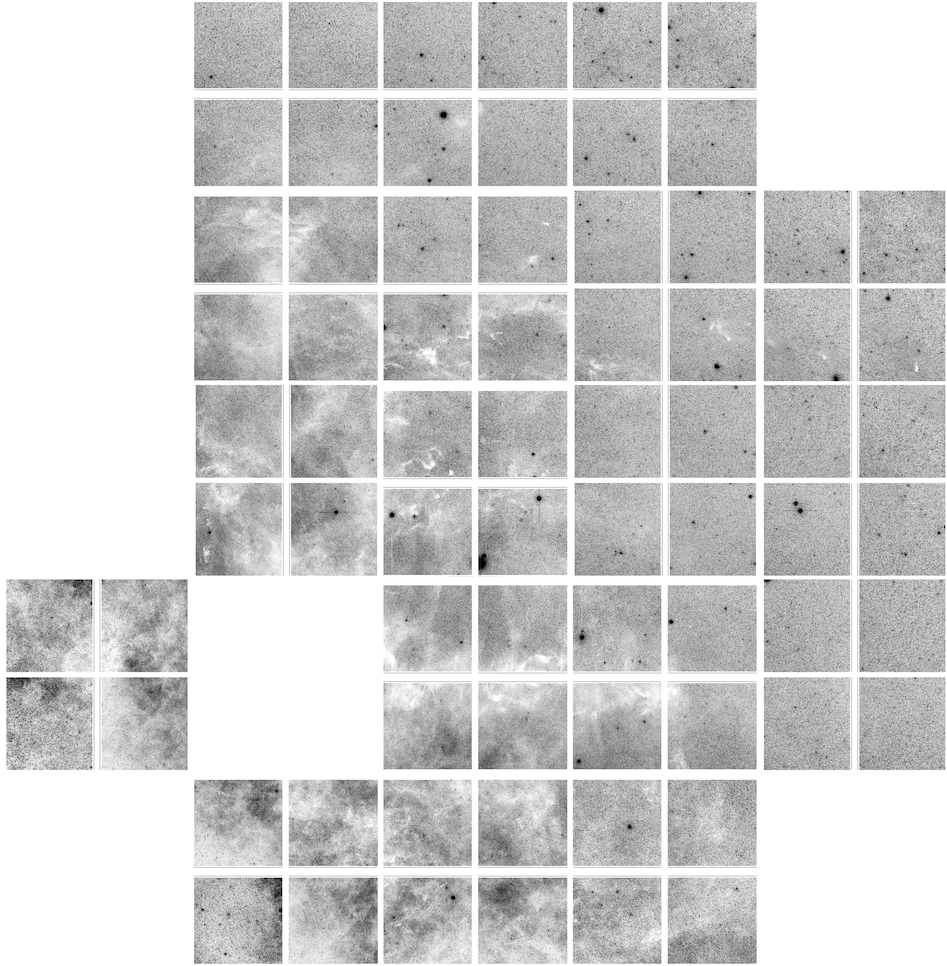
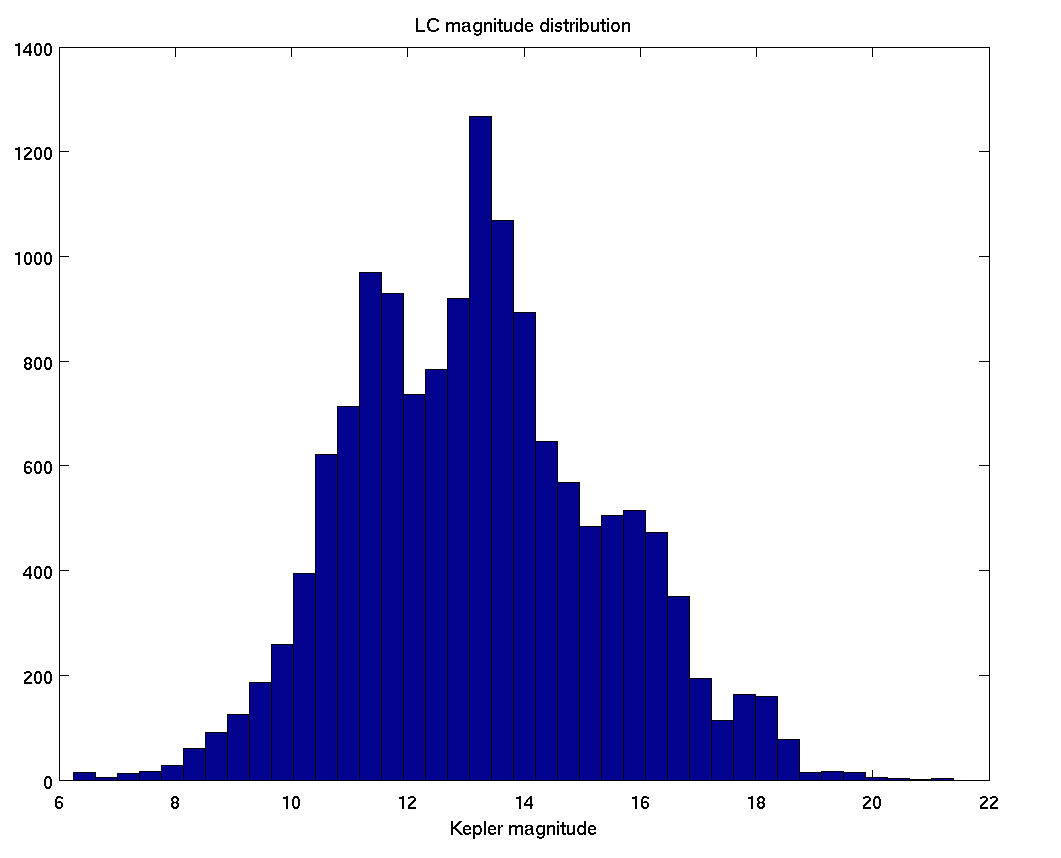
Features and Events
Galactic Bulge
The C11 field of view is the densest star field for which pipeline light curves have been created. The average density of stars with magnitude 11.5 < Kp < 14.5 over the field of view is 6,959 stars/deg2. Detector channels covering the galactic bulge have densities as high as 25,000 stars/deg2. For comparison the average density of stars in this magnitude range for the Kepler field of view is 900 stars/deg2. As a result of the high star density, many of the pipeline algorithms are operating outside of their design range. Users are cautioned to treat the pipeline background, centroid, and aperture photometry results with care, especially on channels covering the Galactic Bulge.
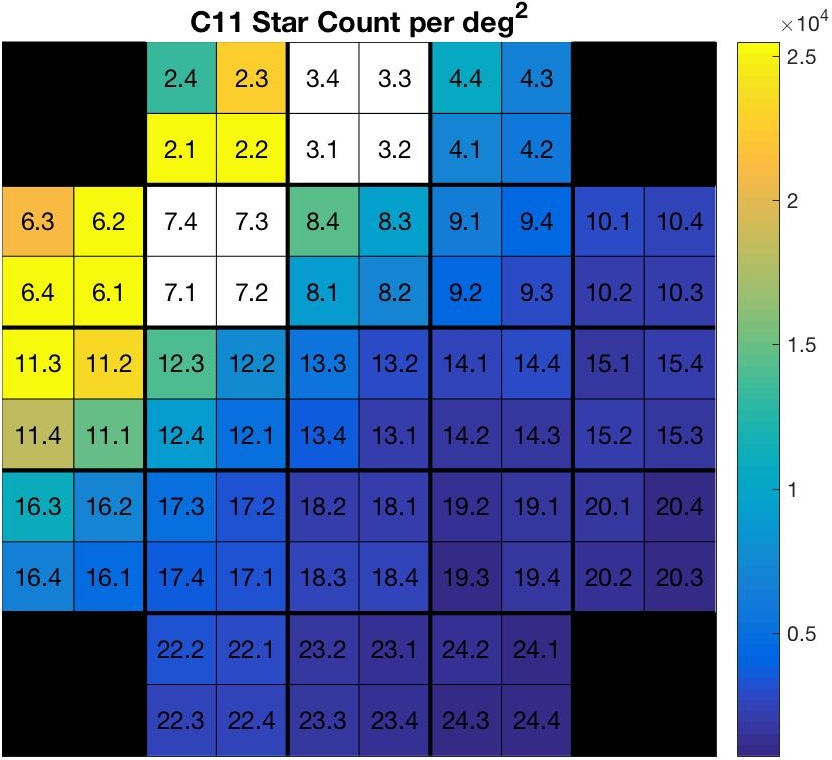
Saturn
Saturn (V = +1) and its bright moons Titan (V = +9), and Enceladus (V = +12) entered channel 84 near the end of the campaign (Dec 3, ~12h UT) allowing ~4.5 days of observations. Titan is ~18 pixels away from Saturn, while Enceladus is only 2-4 pixels from Saturn and regularly passed through Saturn's saturated charge spill columns. Both Titan and Enceladus were tiled with custom aperture masks.
Custom targets
Many custom targets were selected, composed of:
- 64 Solar System moving objects tiled with multiple apertures, featuring Titan and Enceladus
- 9 bright stars covered with disk apertures to capture the PSF wings
- 22 late microlensing targets
- 5 galaxy targets
See the C11a csv file and C11b csv file to map the Solar system object custom aperture numbers to the target names.
Attitude Offset and Segmenting of C11 Data
The spacecraft attitude was adjusted by -0.32º in roll on 2016-10-21 to correct the initial roll-offset error. Because this attitude offset was large enough to require new target pixel apertures, the C11 data were processed through the pipeline in two separate parts:
- C11a: the first 23 days of the campaign
- C11b: the remaining 48 days of the campaign
The C11a files are found in the archive under Campaign number 111. The C11b files have Campaign number 112. A search for Campaign 11 will return both sets of files. Users should take care when combining data from C11a and C11b. Because the targets have changed pixels — and in some cases detectors — there is no guarantee that the C11a and C11b fluxes will match in absolute value, or even slope across the C11a–C11b boundary. The C11a and C11b data likely need to be treated as coming from two separate campaigns. The figures below give some examples of the behavior of SAP flux over C11.
In some cases, the updated C11b target apertures extended off the edge of the active CCD and included rows of collateral smear, or columns of collateral black data. These collateral data are evident in the TPFs and should not be used when doing photometry on the target.
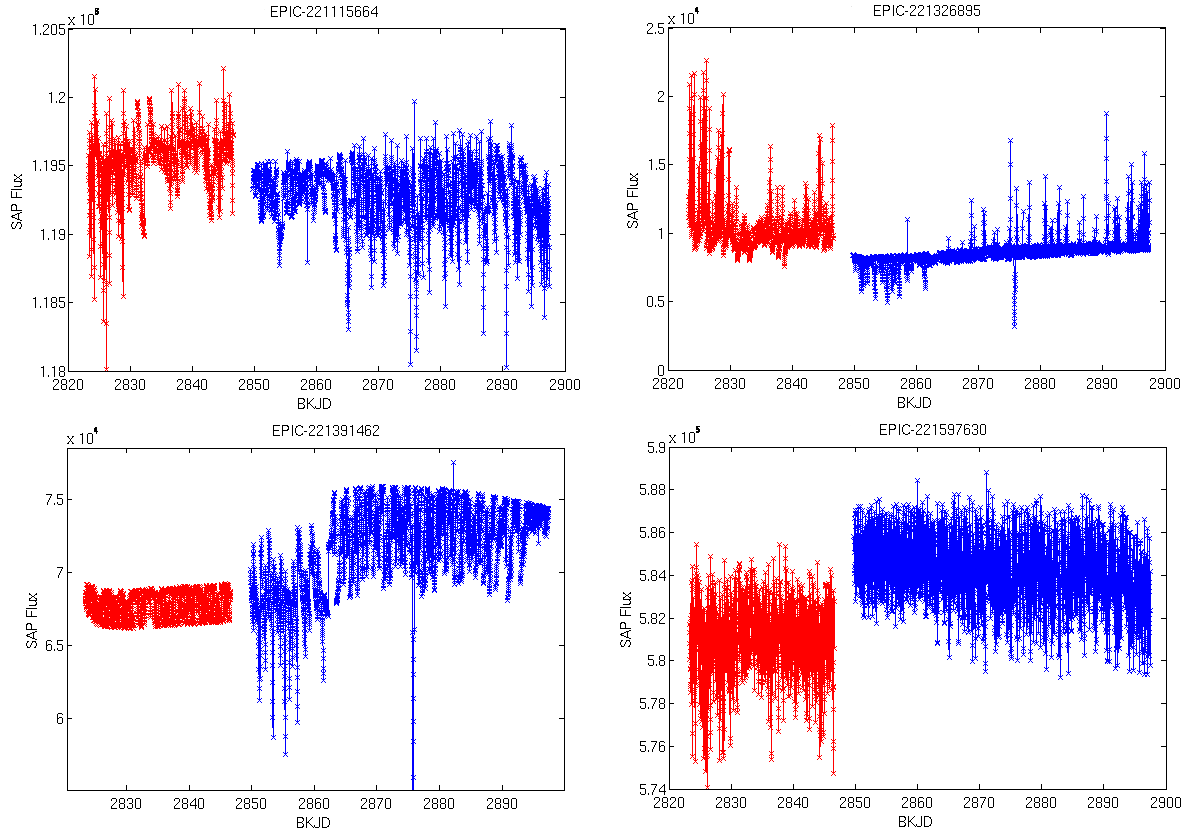
Pointing and Roll Performance
The C11a and C11b pointing and roll behavior are within the limits of that seen in other K2 campaigns. The pipeline calculated maximum distance between the derived and nominal positions for any target (the "maximum attitude residual", or MAR) for C11 never exceeds 2.2 pixels — well under the 3-pixel limit accommodated by the aperture halos. See Figures C11a-MAR and C11b-MAR.
The C11a attitude error started at a relatively high value and large roll amplitude, due in part to the initial roll offset error. The negative going roll offsets along with the large negative roll rate at the start of C11a indicated that, without correction, the roll would have been unacceptably large in the 6-hours between thruster firing windows by the end of the campaign. The large roll would have caused targets at the edge of the focal plane to roll out of their apertures. The roll offset was corrected during the gap starting around 2016-10-16 seen in Figure C11-Pointing-History, resulting in a roll profile for C11b that is more typical of past campaigns. Similarly, the C11a maximum attitude residual was somewhat high — though well within the aperture limits — while the C11b starting maximum attitude residual was more typical of K2 behavior.
There was a smaller related change in roll behavior during C11a when the spacecraft X-band communications were switched from low gain antenna 2(LGA-2) to LGA-1. The antenna switch resulted in different thermal torque on the spacecraft and somewhat mitigated the initial C11a roll pointing error. The improvement is most evident in the roll rate at a solar elongation angle of -35º (see Figure C11-Roll-Rate), but can be seen in the roll error at around 2016-10-02 (see Figure C11-Pointing-History).
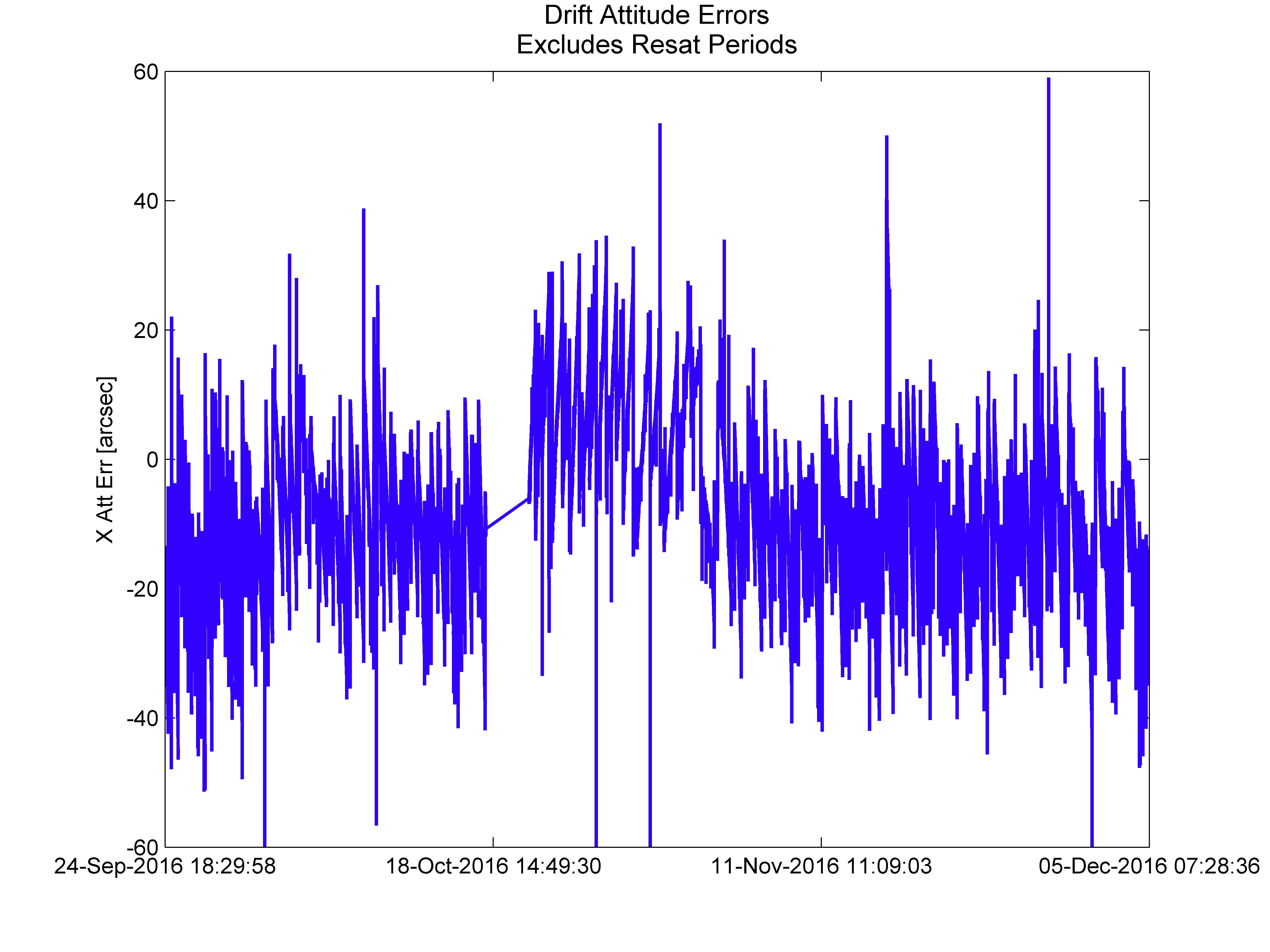
Data Quality and Processing Notes
Light Curve Quality
We consider the C11a and C11b pipeline-generated light curves separately for noise analysis and comparison with previous campaigns. As in previous campaigns, the 6-hour spacecraft roll cycle continues to dominate the systematic errors in C11 simple aperture photometry light curves.
The magnitude dependence of CDPP and its distribution over the focal plane are shown below. Other CDPP benchmarks can be found in the table giving C11a 6.5-hr CDPP as a function of magnitude and the C11b 6.5-hr CDPP table.
The stellar properties for each target, available from the EPIC catalog, were used to distinguish dwarf and giant stars. The C11 CDPP values are in family with C7, the next most crowded K2 FOV for which pipeline light curves were generated.

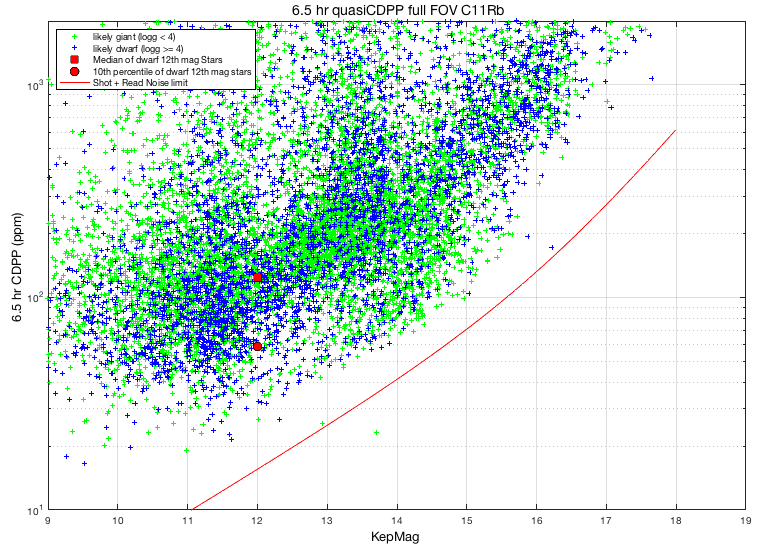
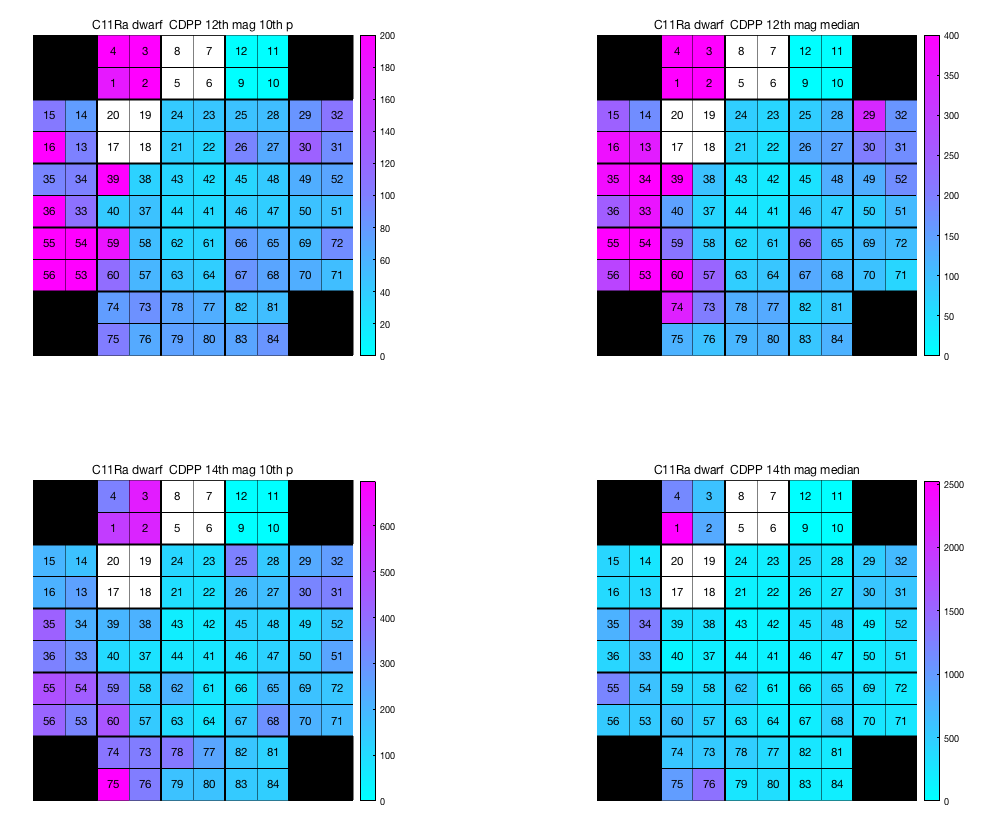

Short-Cadence Target With No PDC Flux
The target EPIC 200147465 (36 Ophiuchi; a bright, nearby triple star system) failed short-cadence PDC processing due to it being a custom target and the only target on its channel. The short-cadence light curve file includes the (nominal and unaffected) SAP flux, but the PDC_SAP flux is all zeros. Note that the long-cadence data for this target is unaffected and is nominal.
Targets With Incomplete FITS Header
There are 13 custom targets in C11a and 3 in C11b (see list below) that are missing centroid information and values for the following FITS headers in thier target pixel and lightcurve files: RA_OBJ, DEC_OBJ, 1CRVL4, 2CRVL4, 1CRVL5, 2CRVL5, 1CRVL6, 2CRVL6, 1CRVL7, 2CRVL7, 1CRVL8, 2CRVL8, 1CRVL9, 2CRVL9, EXPOSURE, TELAPSE, LIVETIME, TSTART, TSTOP, CRVAL1, and CRVAL2. This situation typically for a very small fraction of custom targets, where the entire pixel stamp is erroneously selected as the aperture. As a result there are no background pixels available to compute the centroid information, and thus the values for the listed FITS headers. Users wanting to analyze this target are encouraged to create their own lightcurve using software such as the lightkurve Python package, PyKE software tool suite, or other packages.
The list of the affected targets are:
C11a
- 200108002
- 200109390
- 200109391
- 200111995
- 200112045
- 200112066
- 200117957
- 200121136
- 200121176
- 200121179
- 200122458
- 200124751
- 200125354
C11b
- 200134507
- 200136321
- 200129342
Poor Smear Correction - Bright Stars
There were several very bright stars observed in C11 with saturation spilling over all rows of the array on three channels, corrupting the smear measurement for the affected columns. For these columns the virtual smear measurement is used for smear correction, though it is known that this value is invalid and will corrupt data on the affected columns. Given the normal motion of the stars in K2 due to roll and differential velocity aberration, it is likely that adjacent columns will be corrupted at some times during the campaign. The smear corruption is complicated in C11 due to the roll offset: stars at the edge of the array moved up to 30 pixels from C11a to C11b, while stars in the center modules moved only slightly. The channels and affected columns in C11a and C11b are given below.
| Channel | C11a columns | C11b columns |
|---|---|---|
| 35 | 888-892 | 858-861 |
| 43 | 162-165 | 160-162 |
| 58 | 167-169 | 154-158 |
LDE Flags
During the last three days of C11b the detector experienced a large number of parity errors coming from the photometer's local detector electronics (LDE). These LDE parity errors can occur when a very bright object saturates and spills charge into the CCD serial readout register, causing an overflow at the input to the analog-to-digital converter. The LDE parity errors were likely caused by the image of Saturn on the focal plane. These errors do not affect the quality of data from pixels on the active focal plane, and the pipeline as run in this most recent processing does not discard data based on this flag.
The LDE parity error triggers a flag (bit 15, decimal=16384) in the QUALITY column of the target pixel files. Most of the cadences from long cadence number 136276 (2016-12-4 00:58 UTC) to LC 136426 (2016-12-7 02:32 UTC) have the parity error flag set.
K2 Campaign 10
These release notes are for the C10 data currently available at MAST (Data Release 37) in the nominal K2 data locations, which have been processed with the final version of the K2 pipeline as part of the K2 global uniform reprocessing effort. The original release notes corresponding to the previous versions of C10 data (Data Release 15) can be found in the archived data release notes page.
At a glance
Campaign 10 was operationally separated into two segments as a result of a 3.5-pixel initial pointing error at the start of the campaign. The offset was corrected six days into the campaign. The two segments are identified in the archive products as c101 and c102, respectively.
C10 Pointing- RA: 186.7794430 degrees
- Dec: -4.0271572 degrees
- Roll: 157.6280500 degrees
- delta-RA: 12.12951918 arcsec
- delta-Dec: -4.12973550 arcsec
- delta-Roll: -8.00606815 arcsec
- 41,531 EPIC IDs in long cadence (LC).
- 138 EPIC IDs in short cadence (LC).
- Custom targets include 16 Solar System moving objects tiled with multiple apertures, 8 bright stars covered with disk apertures to capture the PSF wings, and 27 large galaxies. See the csv file that maps the Solar system object custom aperture numbers to the target names.
Both C10 FFIs were taken at the C10b pointing. The first includes data from module 4, the second does not.
C10a First cadence- Time: 2016-07-06 19:45:29 UTC
- Long Cadence Number: 128925
- Short Cadence Number: 3856210
- Time: 2016-07-13 01:19:55 UTC
- Long Cadence Number: 129230
- Short Cadence Number: 3865389
- Time: 2016-07-13 01:49:21 UTC
- Long Cadence Number: 129231
- Short Cadence Number: 3865390
- Time: 2016-07-20 06:26:44 UTC
- Long Cadence Number: 129583
- Short Cadence Number: 3875979
- Time: 2016-08-03 06:51:51 UTC
- Long Cadence Number: 130269
- Short Cadence Number: 3896530
- Time: 2016-09-20 04:52:03 UTC
- Long Cadence Number: 132614
- Short Cadence Number: 3966909
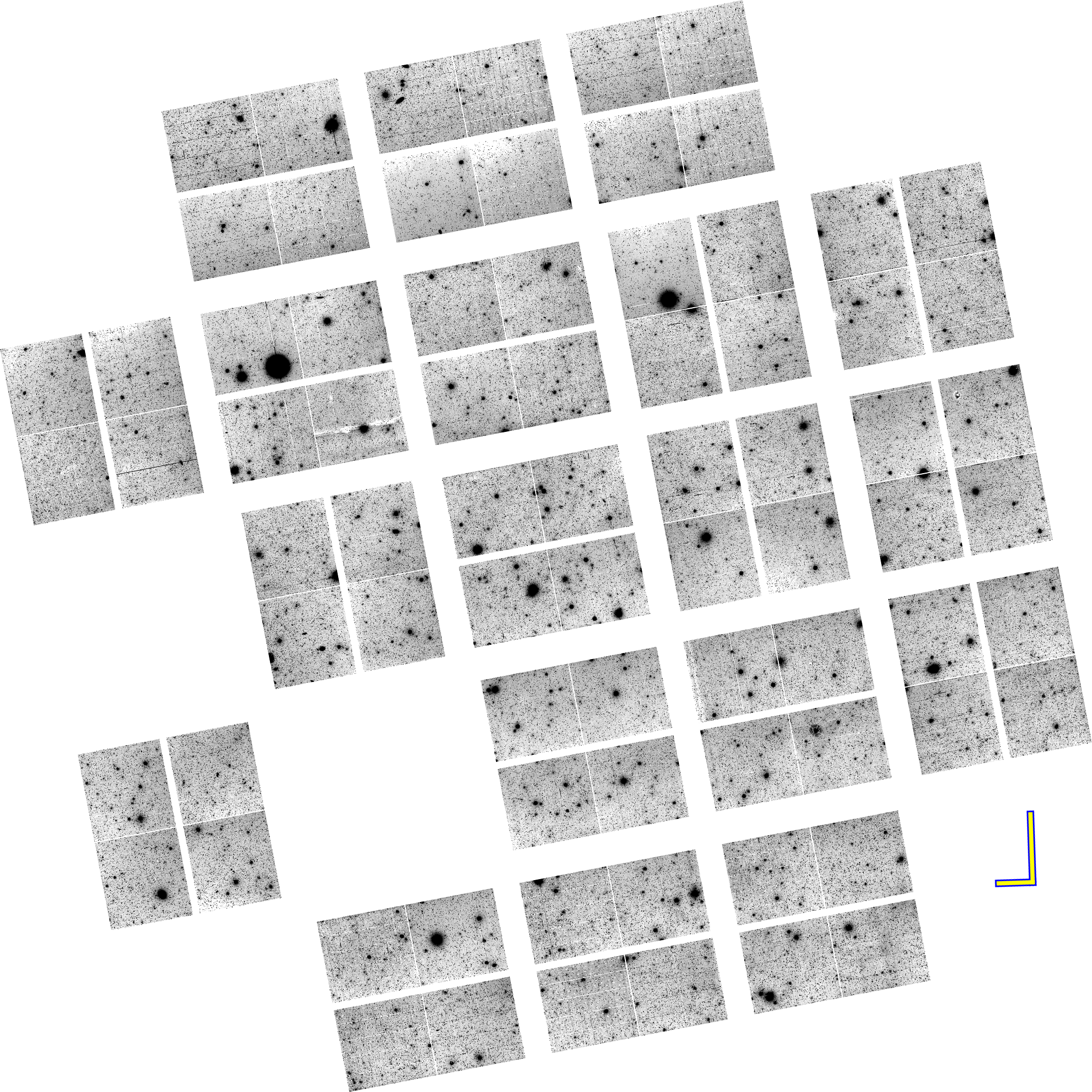
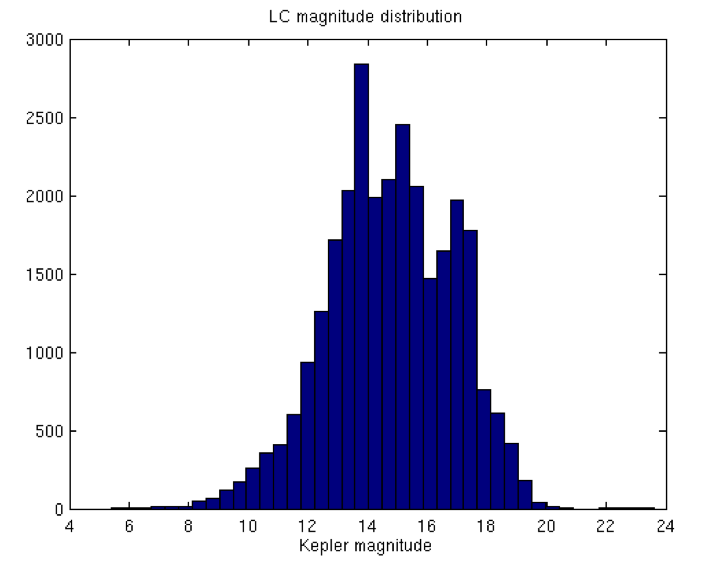
Features and Events
Galaxies
With its high Galactic latitude, Campaign 10 observed 4,977 galaxies. Twenty-seven large galaxies were each covered using 1,500 pixel custom masks. The extragalactic targets include the well-known quasar 3C 273 (EPIC 229151988).
Comet 67P: Churyumov-Gerasimenko
Comet 67P was observed in C10b from September 7 through September 20 2016 as it crossed channels 69 and 70. The comet was observed using 2200 custom aperture tiles.
Segmenting of C10 Data
The C10 data were processed through the pipeline in two separate sets:
- The first six days of data, dubbed C10a, were collected with a pointing error of 3.5 pixels from the nominal field-of-view, so they were only processed through CAL to make Type 1 target pixel files and collateral data files.
- The remainder of the campaign, dubbed C10b, was processed through the entire pipeline, creating Type 2 target pixel files, light curves, and collateral data files.
The C10a files are found in the archive under Campaign number 101, and the C10b files have Campaign number 102. A search for Campaign 10 will return both sets of files.
Attitude Offset in C10a
C10a data collection started with a pointing error from the intended C10 attitude of 3.5 pixels. This pointing offset potentially invalidates many of the target pixel apertures. The apertures for data collection include the pixels needed for photometry plus additional halos to allow for pointing errors or target catalog errors. Two halos are used in the center of the array and three halos are used in the outer portions to account for the increased roll-induced motion of targets further from the center of the array. Since the C10a initial pointing error was 3.5 pixels, it is likely that significant flux from target stars fell outside their aperture during the K2 roll cycle. Users should check the validity of the aperture for their particular target in C10a before interpreting the flux measurements.
The spacecraft attitude was adjusted at 2016-07-13 01:49:21 UTC to correct the pointing error, marking the start of C10b.
Loss of Module 4
An additional complication arises in the C10b data due to the loss of module 4 seven days into C10b (around 2017-07-20 07:00 UT), which powered off the photometer resulting in a 14-day data gap. The cause of the module 4 failure is not known, but the sequence of telemetry faults leading up to the failure and the post-recovery behavior of the focal plane are similar to those seen around the failures of module 7 (January 2014) and module 3 (January 2010). These failures were attributed to a blown fuse in the focal plane local detector electronics (LDE) driver boards, likely due to the failure of an upstream component creating an over-current load.
The C10b spacecraft pointing on either side of this data gap was consistent and at the correct C10 attitude, so flux values should be consistent across the gap. Note that PDC corrected fluxes may show inconsistent systematic error corrections across the 14-day gap, as the cotrending basis vectors can be dominated by systematics present on one side of the gap but not the other side.
Pointing and Roll Performance
Apart from the initial pointing error in C10a, the C10a and C10b pointing and roll behavior were typical of K2 campaigns. The cross-boresight pointing during C10b was well-behaved outside of the coarse point portion caused by the failure of module 4 — since the photometer was off during the coarse point portion, no coarse-point science data were collected. The roll behavior during C10a and C10b was also nominal. The pipeline calculated maximum distance between the derived and nominal positions for any target (the "maximum attitude residual", or MAR) for C10b was well under the 3-pixel limit accommodated by the aperture halos.
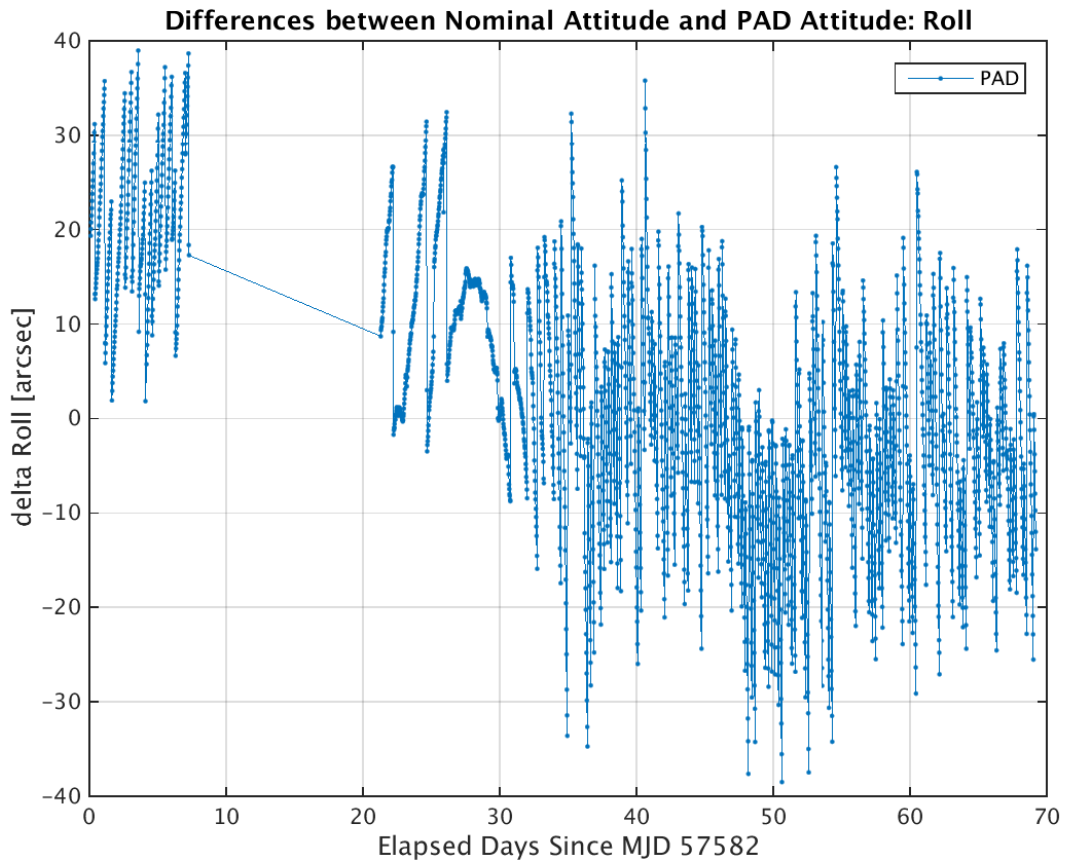
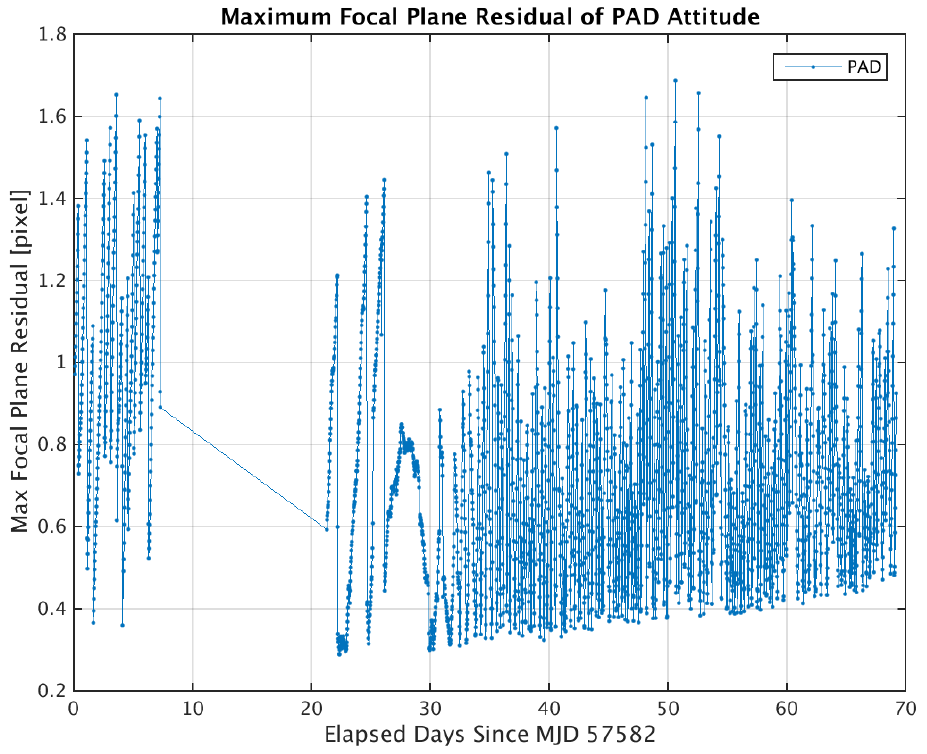
Data Quality and Processing Notes
Calibrated Target Pixel Files
This data release consists of calibrated target pixel files (TPFs) and supporting calibration files for C10a, as well as a full set of archive files (TPFs, calibration files, and light curve files) for C10b. The two separate sets of calibrated TPFs for C10a and C10b have filenames that contain "c101" and "c102" respectively.
Because the full pipeline was not run, the C10a TPFs are Type-1 files. The C10b TPFs are Type-2 and contain all the nominal calibration information. See section 2.4 of the K2 Handbook for details on the contents of the Type-1 versus Type-2 files.
Since the thruster firing flags are not populated in FITS quality flags for the C10a Type-1 TPFs, they are delivered as separate long-cadence (thruster_firing_flags_C10_lc.csv) and short-cadence (thruster_firing_flags_C10_sc.csv) thruster firing tables for the combined C10a + C10b campaign. Thruster firing flags are populated in the FITS quality flag in the C10b Type-2 TPFs.
Light Curve Quality
We consider only the C10b pipeline-generated light curves for noise analysis and comparison with previous campaigns. As in previous campaigns, the 6-hour spacecraft roll cycle continues to dominate the systematic errors in C10b simple aperture photometry light curves.
The magnitude dependence of CDPP and its distribution over the focal plane are shown below. Other CDPP benchmarks can be found in the table giving 6.5-hr CDPP as a function of magnitude.
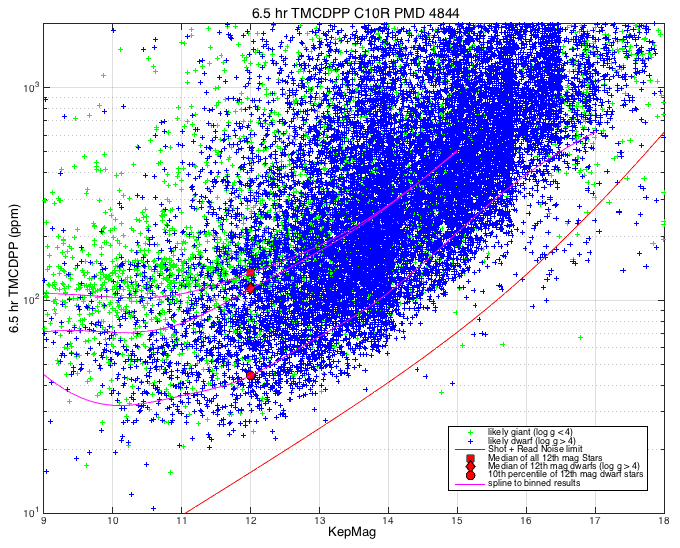

Targets With No Lightcurve Files
The following three targets do not have lightcurve files available for data release 37. All three targets are faint M dwafs with significant proper motion, which appears to have resulted in corner cases where the pipeline selected an optimal aperture that was just outside the observed pixels. As a result neither SAP_FLUX nor PDC_SAPFLUX were able to be computed for these targets, and thus no lightcurve files exist for them. Users are encouraged to produce their own lightcurves for these objects from the target pixel files.
- 201288233
- 201482905
- 228849156
Poor Smear Correction - Bright Stars
There are two channels in C10 containing very bright stars with saturation spilling over all rows of the array, corrupting the smear measurement. On channel 28 (mod.out 9.4) saturated charge from HD 110380 (V=3.5) spills across all rows of columns 829 & 830 in C10a and 831 & 832 in C10b. On channel 65 (19.1) saturated charge from HD 107259 (V=3.9) spills across all rows of columns 961 & 962 in C10a and 962 & 963 in C10b. In both cases, the virtual smear measurement is used for smear correction, though it is known that this value is invalid and will corrupt data on these columns. Given the normal motion of the stars in K2 due to roll and differential velocity aberration, it is likely that adjacent columns will be corrupted at some times during the campaign.
K2 Campaign 9
At a glance
Campaign 9 was flown in the forward velocity vector direction to observe the star-rich region around the Galactic bulge in search of microlensing events. In order to maximize data collection capabilities, the campaign was conducted in two parts with a mid-campaign data downlink and a ~0.6 pixel offset between the two subfields known as C9a and C9b, identified in the archive products as C91 and C92, respectively.
C9a Pointing- RA: 270.3544823 degrees
- Dec: -21.7798098 degrees
- Roll: 0.4673417 degrees
- RA: 270.3543824 degrees
- Dec: -21.7804700 degrees
- Roll: 0.4673417 degrees
- 3,417 EPIC IDs in long cadence (LC)
- 12 EPIC IDs in short cadence (SC)
- 76 unique custom targets were selected in C9. Three million of the total 3.3 million C9 target pixels were used to construct microlensing super apertures on 5 channels around the Galactic bulge. See the csv file that maps the custom aperture number to the target name.
- 3,550 EPIC IDs in long cadence (LC)
- 13 EPIC IDs in short cadence (SC)
- 132 additional long-cadence microlensing targets and 1 short-cadence target were added to the C9a target list for C9b. See the csv file that maps the custom aperture number to the target name.
- Time: 2016-04-22 14:04:59 UTC
- Long Cadence Number: 125243
- Short Cadence Number: 3745750
- Time: 2016-05-18 22:42:26 UTC
- Long Cadence Number: 126532
- Short Cadence Number: 3784449
- Time: 2016-05-22 14:58:45 UTC
- Long Cadence Number: 126713
- Short Cadence Number: 3789850
- Time: 2016-07-02 22:34:52 UTC
- Long Cadence Number: 128734
- Short Cadence Number: 3850509
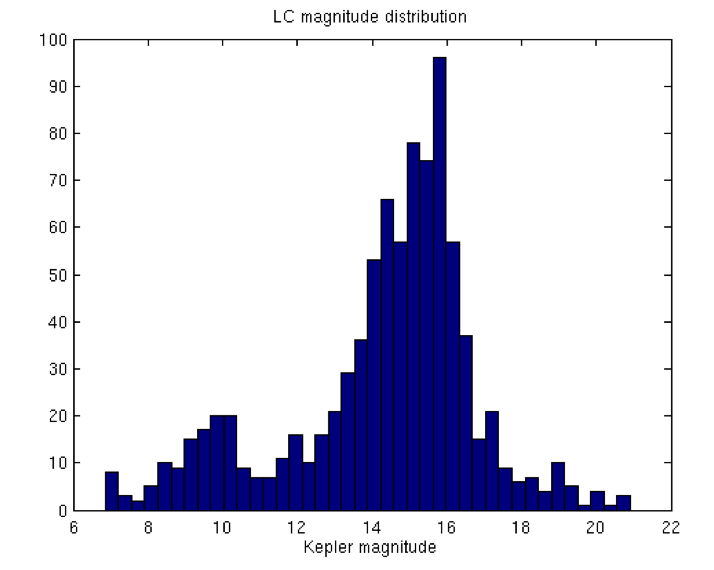
Features and Events
Microlensing Toward the Galactic Bulge
The C9 campaign was dedicated to a microlensing study of targets in the direction of the Galactic Bulge. As such, there were a number of unique aspects to the campaign:
- The spacecraft observed in the forward velocity vector direction to allow for simultaneous observations of targets from Earth.
- Three million of the 3.3 million pixels were in dedicated super apertures around the Galactic Bulge. Because these pixels do not have traditional star target apertures, light curves were not generated by the pipeline and we are delivering calibrated pixels only. In addition, there were a number of individual targets outside the super apertures that were added late as they showed microlensing signatures detected by ground-based surveys.
- The campaign was split into two parts in order to double the available on-board data storage, enabling coverage of the entire high-priority bulge region. This also accomodated the addition of late high-value microlensing targets and allowed for a mid-campaign subpixel pointing offset.
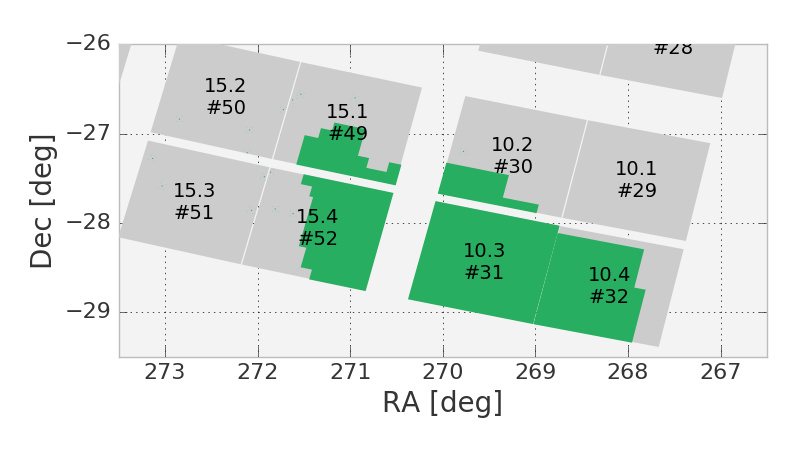
Emergency Mode
Prior to the start of C9a, the spacecraft entered Safemode on 2016-04-07 00:05:06 UTC following a glitch on a data bus that left the spacecraft in an unstable configuration. As a result of this misconfiguration, large attitude excursions during Safemode led to a Sun-avoidance fault that caused the spacecraft to enter Emergency mode approximately two hours later.
In Emergency mode the spacecraft computer is powered off, resetting all configurations and emptying stored science and engineering data. The spacecraft is operated by a low-level controller that maintains a Sun-safe attitude using thrusters. Since Kepler had never been in Emergency mode, the operations team was careful in restoring the spacecraft first to Safemode, which uses significantly less fuel, and then to normal operations. The recovery was completed and C9a observations began on 2016-04-22, 14 days after the planned 2016-04-08 start, shortening the C9a portion of the campaign by two weeks.
During Emergency mode the spacecraft clock was reset, so an updated time was loaded to the clock prior to the start of C9a data collection. Subsequent timing observations on the ground determined that there was a 4 second error in the uploaded spacecraft time. The Mission Operations Center made a retroactive clock kernel update after C9a data collection was completed, changing the time on-board the spacecraft by 4.2 seconds and allowing the C9a data to be correctly time stamped once it hit the ground. As a result, both the C9a and C9b data have the nominal 50 msec absolute accuracy, but the two sets of cadences have an offset of 4.2 sec relative to each other. The C9a data were collected 4.2 seconds later than expected based on a uniform cadence interval across C9a and C9b.
Pointing and Roll Performance
The C9a and C9b pointing and roll behavior were typical of K2 campaigns despite the forward velocity vector orientation. There were two notable pointing excursions during the campaign: a commanded pointing offset for C9b, and an uncommanded impulsive roll offset observed during C9b.
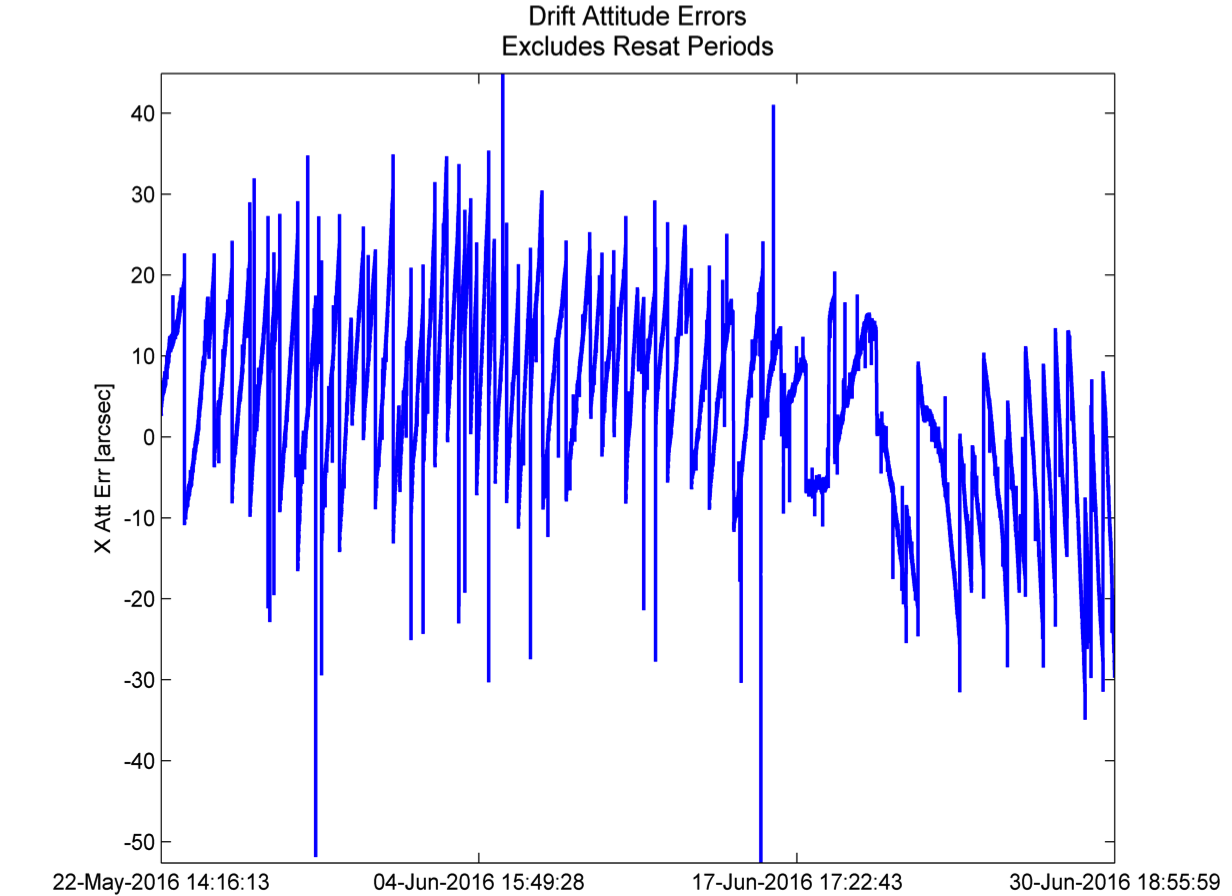
Commanded Pointing Offset for C9b
The Microlensing Science Team (MST) requested that a subpixel pointing offset be introduced between C9a and C9b. The intent of the offset was to move the star images 0.64 pixels (2.4 arc seconds) perpendicular to the K2 roll-induced image motion in the microlensing super apertures. The offset causes the image motion in the combined C9a + C9b campaign to better span the subpixel space, facilitating image reconstruction photometry. Based on preliminary pointing measurements collected from the spacecraft, the C9b offset met the intended goal.
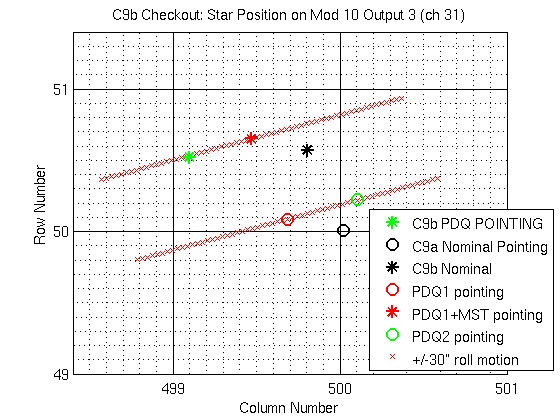
Impulsive Roll offset in C9b
A small uncommanded movement of the spacecraft of about -20 arc seconds in roll was observed at 2016-06-18 02:17:30, during long-cadence number 128008. The movement appears to have been due to a short impulse applied to the spacecraft that the reaction wheel momentum nulled out over a period of 2 minutes, resulting in the -20 arc second roll offset. The roll offset was corrected 22.5 hours later by thrusters as part of the normal K2 roll management cycle.

Data Quality and Processing Notes
Calibrated Target Pixel Files
This data release consists of calibrated target pixel files (TPFs) and supporting calibration files. With the use of large super apertures to collect the vast majority of the pixels and the resulting small number of standard targets, no light curve files were generated for the C9 data. These calibrated TPFs are intended to replace the raw uncalibrated cadence pixel files currently available at the MAST. These raw files
- long cadence target data - lcs-targ
- long cadence collateral data - lcs-col
- long cadence processing history - lcs-history
We recommend that the calibrated TPFs delivered in Data Release 12 be used in place of these raw files for scientific publications. The raw data will continue to be available at the MAST until Jan 1, 2017, three months after the delivery of Data Release 12, after which point it will no longer be available.
In normal K2 processing, later stages of the pipeline are used to reconstruct the pointing history and associate thruster firings with specific long- and short-cadence numbers. These products are then included in the exported target pixel and light curve FITS files. Because the C9 processing only used the pipeline pixel-level calibration, these products are not available in the usual format.
The C9 TPFs, known as "Type-1 TPFs" are like those released early in K2 for C0 (DR2), C1 (DR3), and C2 (DR4). These TPFs have world coordinate system (WCS) coordinates based on the ra_dec_2_pix focal plane model and commanded pointing, rather than using a reconstructed pointing history. We expect that the Type-1 WCS coordinates can be wrong by up to ~1 pixel given the unmodeled roll motion and discrete pointing offsets.
The standard Type-2 TPFs (campaigns C3-C8) contain WCS coordinates based on the reconstructed pointing determined from the measured PRF centroid motion of a number of bright unsaturated stars across each channel. The "motion polynomial" model tracks the roll drift and any impulsive pointing offsets, resulting in position errors at or below 0.1 pixel.
Since the thruster firing flags are not populated in FITS quality flags for the
Type-1 TPFs, they are being delivered in separate
long-cadence (thruster_firing_flags_c91_lc.csv, thruster_firing_flags_c92_lc.csv)
and short-cadence (thruster_firing_flags_c91_sc.csv, thruster_firing_flags_c92_sc.csv)
thruster firing tables.
Large Target Pixel Files
Note that due to an oddly-shaped aperture, the target pixel files for EPIC-200070438 contain 795x411 pixels for each cadence, despite the fact that only ~800 of these pixels were actually observed. Users are cautioned that these target pixel files are quite large and may cause memory problems when accessed:
- ktwo200070438-c91_lpd-targ.fits = 10GB
- ktwo200070438-c92_lpd-targ.fits = 15GB.
K2 Campaign 8
These release notes are for the C8 data currently available at MAST (Data Release 38) in the nominal K2 data locations, which have been processed with the final version of the K2 pipeline as part of the K2 global uniform reprocessing effort. The original release notes corresponding to the previous versions of C8 data (Data Release 11) can be found in the archived data release notes page.
At a glance
- RA: 16.3379975 degrees
- Dec: 5.2623459 degrees
- Roll: -157.3538761 degrees
- 29,939 EPIC IDs in long cadence (LC).
- 63 EPIC IDs in short cadence (LC).
- 26 unique LC custom targets were selected. See the csv file that maps the custom aperture number to the target name.
- Time: 2016-01-04 13:16:25 UTC
- Long Cadence Number:119907
- Short Cadence Number: 3585670
- Time: 2016-03-23 06:48:35 UTC
- Long Cadence Number: 123759
- Short Cadence Number: 3701259
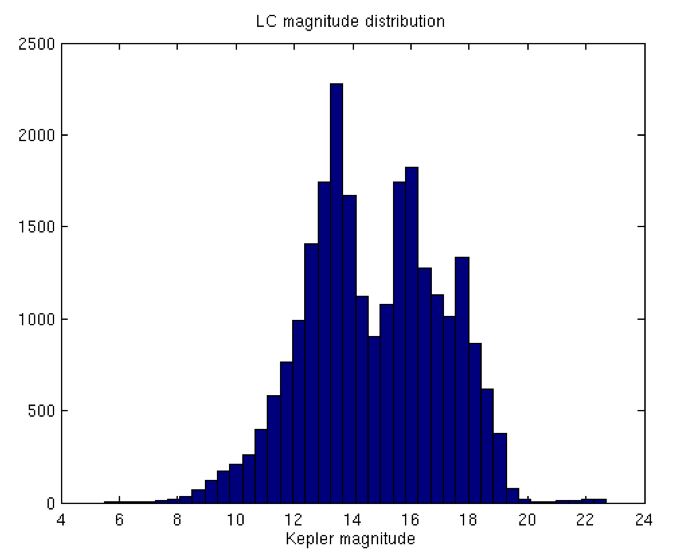
Features and Events
Uranus
Uranus and four of its moons were observed with custom masks during Campaign 8. The path of Uranus was tiled with 245 single column target definitions at long cadence and with nine 9 x 307 trapezoidal masks at short cadence. The moons Caliban, Prospero, Setebos, and Sycorax were observed with separate custom masks. Uranus is one of the brightest moving objects observed by K2.
Galaxies
With its high Galactic latitude, Campaign 8 was ideal for observing galaxies. There were 2750 galaxies targeted, including IC 1613 (Caldwell 51), an irregular dwarf galaxy in the Local Group. IC 1613 was tiled with 48 20 x 20 pixel masks for a total of 19,200 pixels.
Pointing and Roll Performance
Based on the C7 degraded roll performance, the Mission Operations Center switched back to low-gain antenna LGA1 for spacecraft communication during most of C8. The switch resulted in a return to nominal K2 roll performance and drift rates. The campaign was started using LGA2, as was used in C7, and then starting around 23 Jan 2016 23:50 UTC (MJD 57410.99) operations were switched to LGA1. The antenna swap can be seen in the roll drift attitude error.
On 2016-02-01 16:40 UTC (MJD 57419.69) the spacecraft dropped out of fine point control. Observations continued in coarse point, with much degraded pointing performance, until 2016-02-02 22:27 UTC (MJD 57420.94) when the spacecraft reacquired fine point during a resat period. This resulted in 29 hours and 48 minutes of coarse point data collection. These cadences (121284—121344) are flagged as both "spacecraft is not in fine point" (QUALITY flag bit #16, decimal=32768) and "spacecraft is in coarse point" flag (QUALITY flag bit #3, decimal=4). The loss of fine point occurred following a thruster firing fine tweak that resulted in the spacecraft rolling in the wrong direction. The next tweak was unable to correct the attitude before the loss of fine point fault was triggered, but fine pointing control was restored automatically at the next momentum wheel resaturation. There were several other instances of anomalous thruster firing tweaks in C8, none of which resulted in loss of fine point.
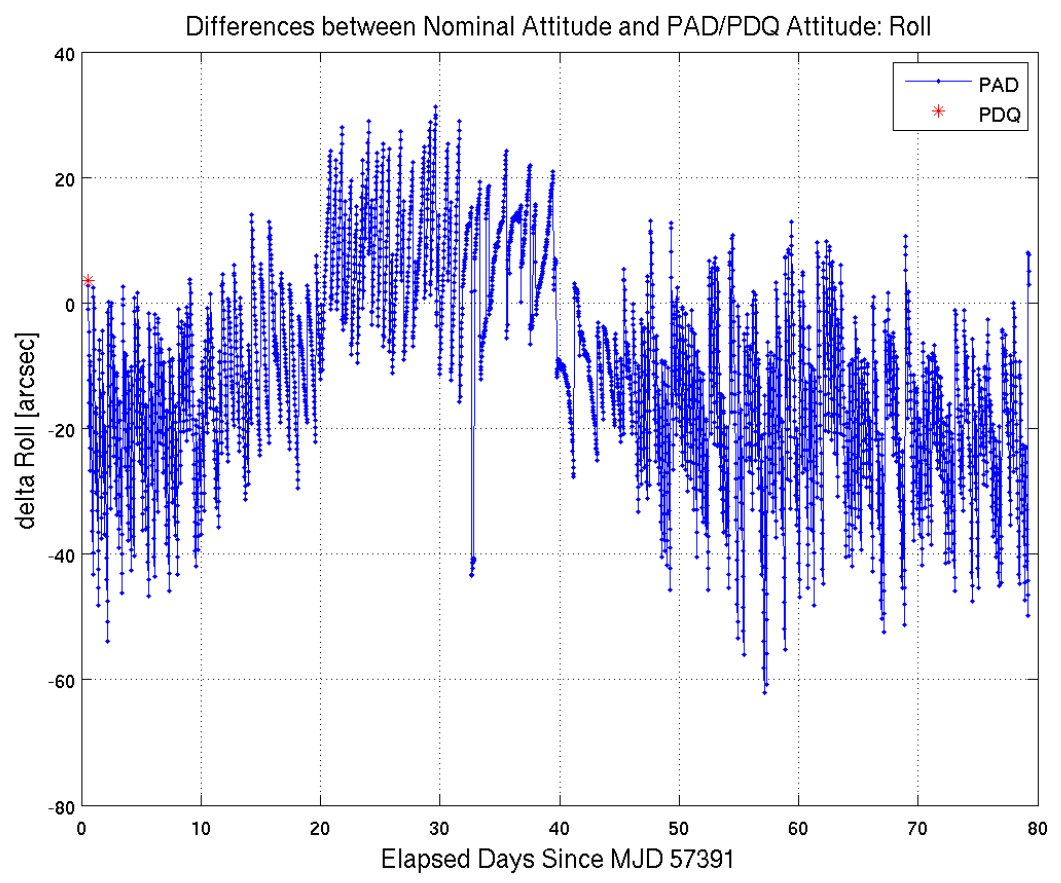

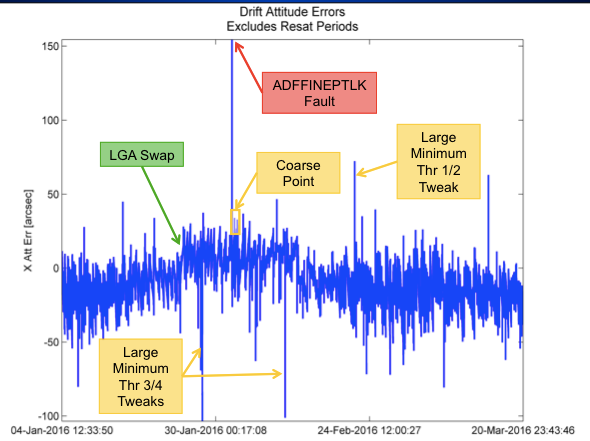
Data Quality and Processing Notes
Light Curve Quality
As in other campaigns, the 6-hour spacecraft roll cycle dominates the systematic errors in C8 simple aperture photometry light curves. The pipeline CDPP 12th magnitude noise benchmark for C8 (DR38) is comparable to that seen in other campaigns with similar star density.
The magnitude dependence of CDPP and its distribution over the focal plane are shown below. Other CDPP benchmarks can be found in the table giving 6.5-hr CDPP as a function of magnitude.
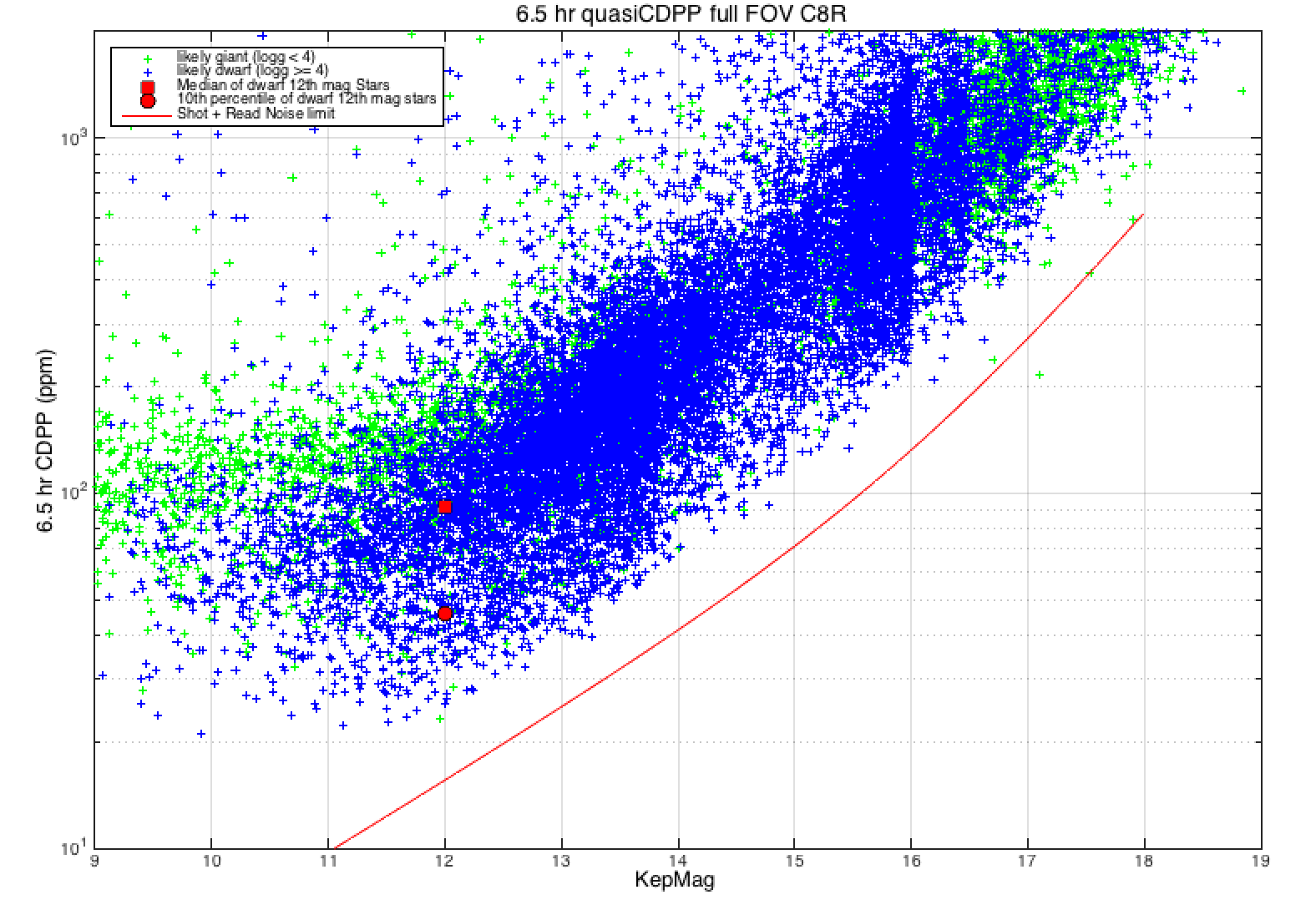
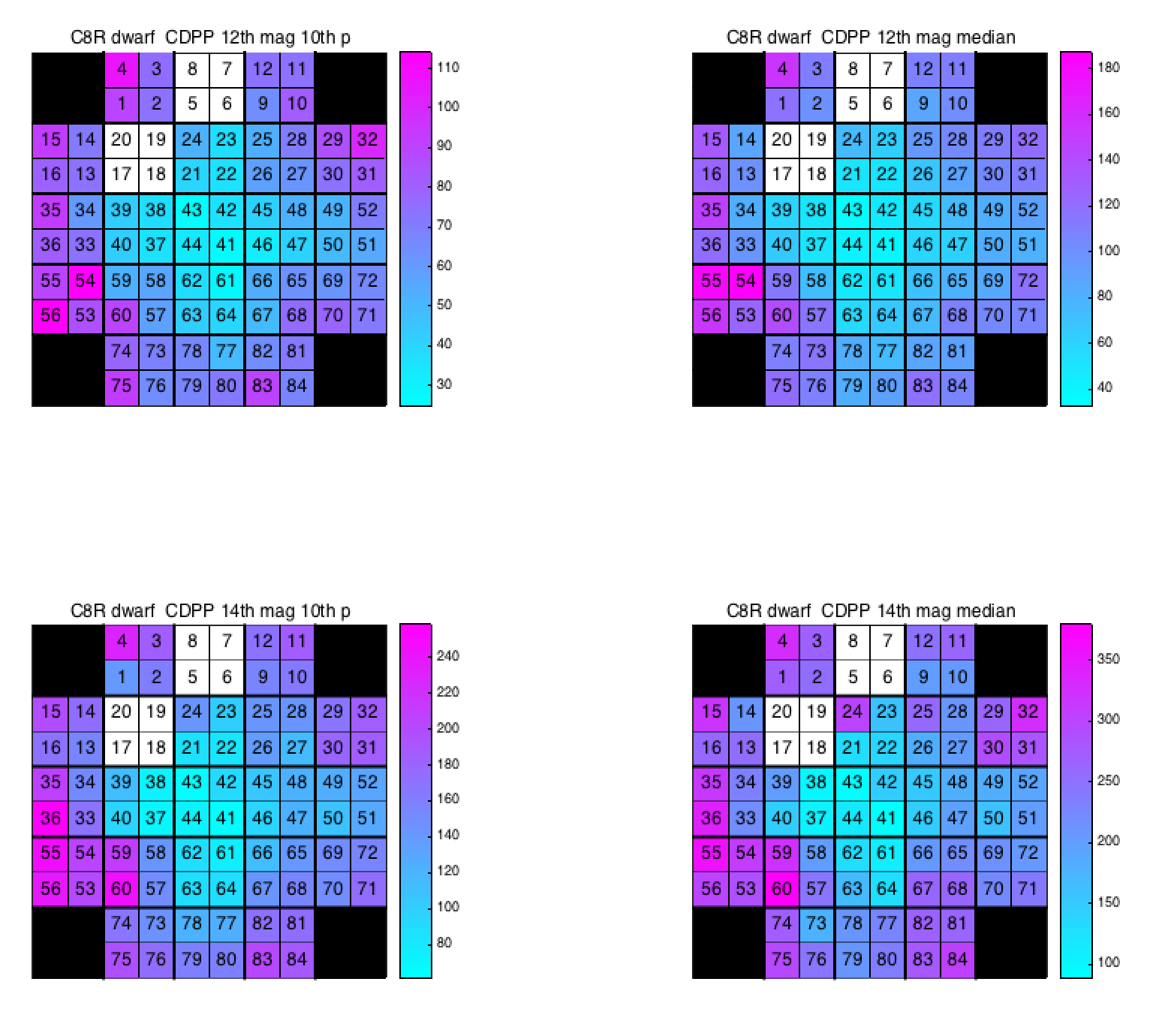
Short-Cadence Targets With no PDC Flux
The following nine targets failed short-cadence PDC processing due to them being custom targets and the only targets on their channel. The short-cadence light curve files include the (nominal and unaffected) SAP flux, but the PDC_SAP flux is all zeros. Note that the long-cadence data for these targets are unaffected and are nominal.
- 200068647
- 200068648
- 200068649
- 200068650
- 200068651
- 200068652
- 200068653
- 200068654
- 200068655
Poor Smear Correction on Channel 42
In the original C8 processing (data release 11), it was noted that there were episodic smear correction errors on channel 42 (mod.out 13.2) — the channel containing the Uranus supermask. Nearly every long cadence in the supermask appeared to contain between 2 and 20 columns which were brightened by 10–20 counts. The brightening of a column lasted only for a single cadence, with no obvious patterns as to which columns are affected in a given cadence. Two example cadences which are particularly affected are 119980 and 119982 (see Figures C8-Ch42-DR11-Cad119980 and C8-Ch42-DR11-Cad119982) below.
Preliminary investigation indicated that the streaking was caused by false cosmic ray detections in the smear collateral data. Because similar streaking was not seen in the supermask for IC 1613, located on channel 58, it was believed that the poor cosmic ray detector performance was due to the bright signal from Uranus moving across columns and altering the cosmic ray detector's dynamic threshold. When false cosmic rays are removed from the smear signal, the pixel data in that column is under-corrected, resulting in a brightening of that column for a given cadence.
For the final processing of C8 (data relase 38), as for all reprocessed campaigns, the detection threshold of the cosmic ray detector was increased (see the news post on global reprocessing). While this did reduce the number of false cosmic ray detections for nearly all campaigns and channels, it did not appear to help for channel 42 in C8. In fact, the situation appears worse for channel 42 in C8 for DR38 than DR11. The maximum value of the smear offsets appear to range up to 60 counts in DR38, compared to 20 counts in DR11, and with perhaps a higher frequency of occurrence (see Figures C8-Ch42-DR11-Smear and C8-Ch42-DR38-Smear below.) While the exact cause of the worsening of the false cosmic ray flagging is not yet known, possibilities include the use of Dynablack as well as processing the entire campaign through the CAL module of the pipeline at once for DR38, whereas Dynablack was not used for DR11 and CAL was run in three separate time chunks — regardless, the root cause remains Uranus' bright, moving signal.
Just as was advised for DR11, for DR38, since the streaks are not in the raw data, users may wish to do their own smear correction on this channel, or at least use the data release 11 version of the files available here.

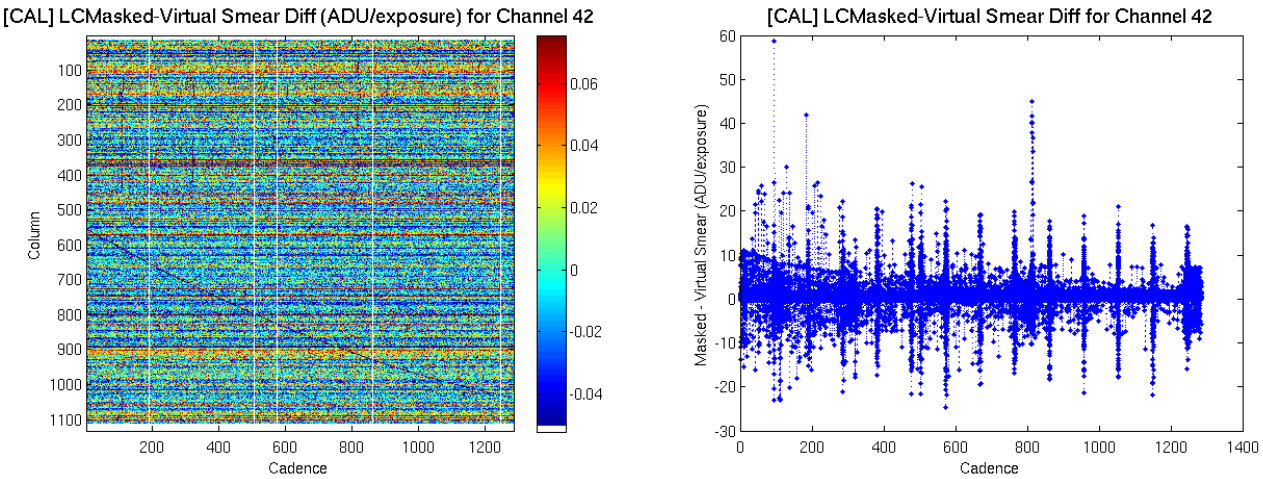
K2 Campaign 7
These release notes are for the C7 data currently available at MAST (Data Release 36) in the nominal K2 data locations, which have been processed with the final version of the K2 pipeline as part of the K2 global uniform reprocessing effort. The original release notes corresponding to the previous versions of C7 data (Data Release 9) can be found in the archived data release notes page.
At a glance
- RA: 287.82850661 degrees
- Dec: -23.36001815 degrees
- Roll: -172.78037532 degrees
- 15,085 EPIC IDs in long cadence (LC).
- 72 EPIC IDs in short cadence (LC).
- Several custom targets were selected. See the csv file that maps the custom aperture number to the target name.
- Time: 2015-10-04 17:52:39 UTC
- Long Cadence Number:115414
- Short Cadence Number: 3450880
- Time: 2015-12-26 08:35:28
- Long Cadence Number: 119456
- Short Cadence Number: 3572169
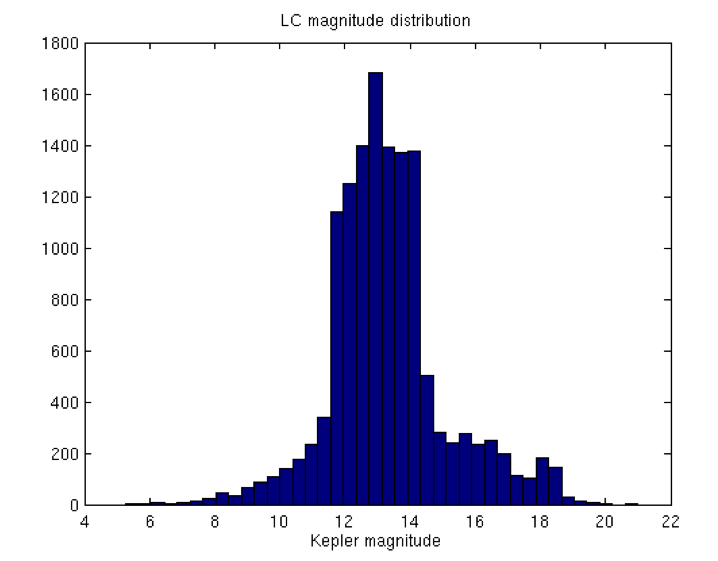
Features and Events
Pluto
Pluto, a dwarf planet in the Kuiper belt, and one of the largest trans-Neptunian objects, was observed during Campaign 7. The path of Pluto was tiled with 1 x n pixel target definitions, where n ranges from 1 to 217. The range of custom aperture numbers for Pluto is 200062954 – 200062827. The animated gif below shows Pluto as observed by K2.
Ruprecht 47
Ruprecht 47 is an open cluster observed with K2 during Campaign 7. It was observed using a super-aperture, tiled with 60 51 x 51 masks, totaling 156,060 pixels. The custom aperture numbers range from 200062524 – 200062583.
Pointing and Roll Performance
For the first ~30 hours of the campaign, the telescope was in coarse point — one of the guide stars was brighter than expected, preventing fine point lock, and an update to the fine guidance sensor was issued to accommodate the higher signal count. The span of coarse point is long cadences 115414 – 115474 (corresponding short cadences 3450880 – 3452680. See Figure C7-MAR below.
The C7 roll behavior is worse than typically seen in other K2 campaigns. For C7, an alternate low-gain antenna was active during science data collection. The previously used LGA1 was replaced by LGA2 (see Figure 2 of the Kepler Instrument Handbook), as the latter was slightly better oriented with respect to earth. (This partially compensated for the increasing distance to the spacecraft in its Earth-trailing orbit, then at 0.8 AU.) Since the two antennas are mounted on opposite sides of the spacecraft, this antenna swap produced a change in radiation pressure that placed an additional (unbalanced) torque about the boresight on the spacecraft. The resulting increase in roll drift is illustrated in Figure C7-RollDrift, which compares the drift rates for C4, C6, and C7.
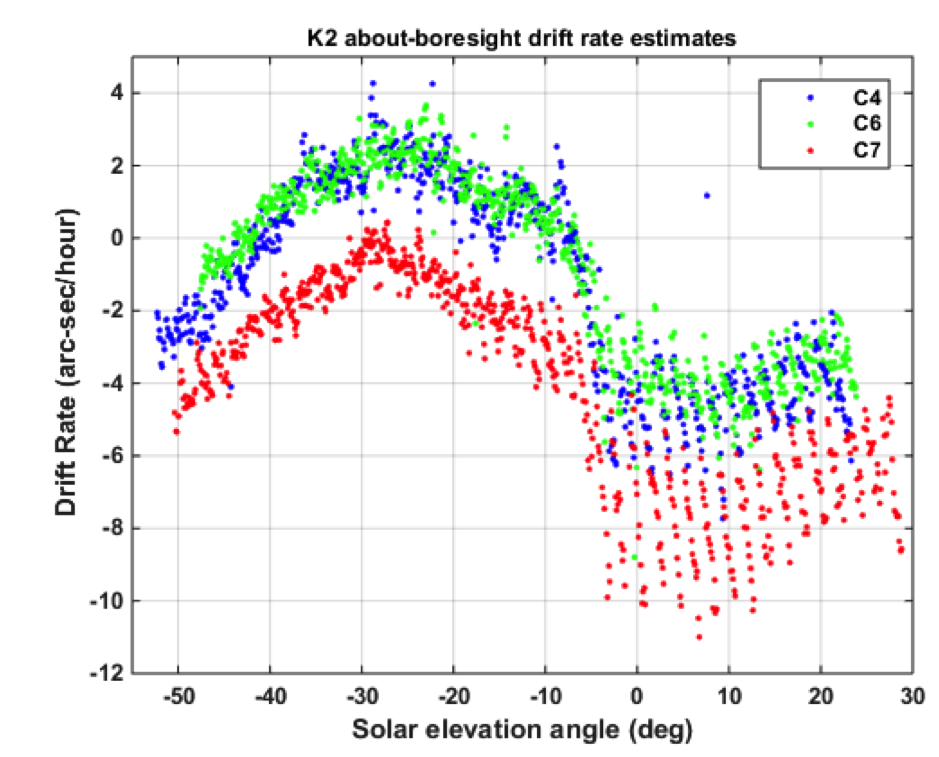
As a result of this increased roll drift (see Figure C7-Roll-Error), the maximum excursion of any pixel from its nominal position is significantly larger for C7 than for other campaigns. The pipeline-calculated maximum distance between the derived and nominal positions for any target (the "maximum attitude residual", or MAR) for C7 is as large as 3.4 pixels, as shown in Figure C7-MAR — most campaigns have a MAR of ~2. As described below, since target apertures were designed with a maximum 3-pixel halo, this results in lost light for some targets.
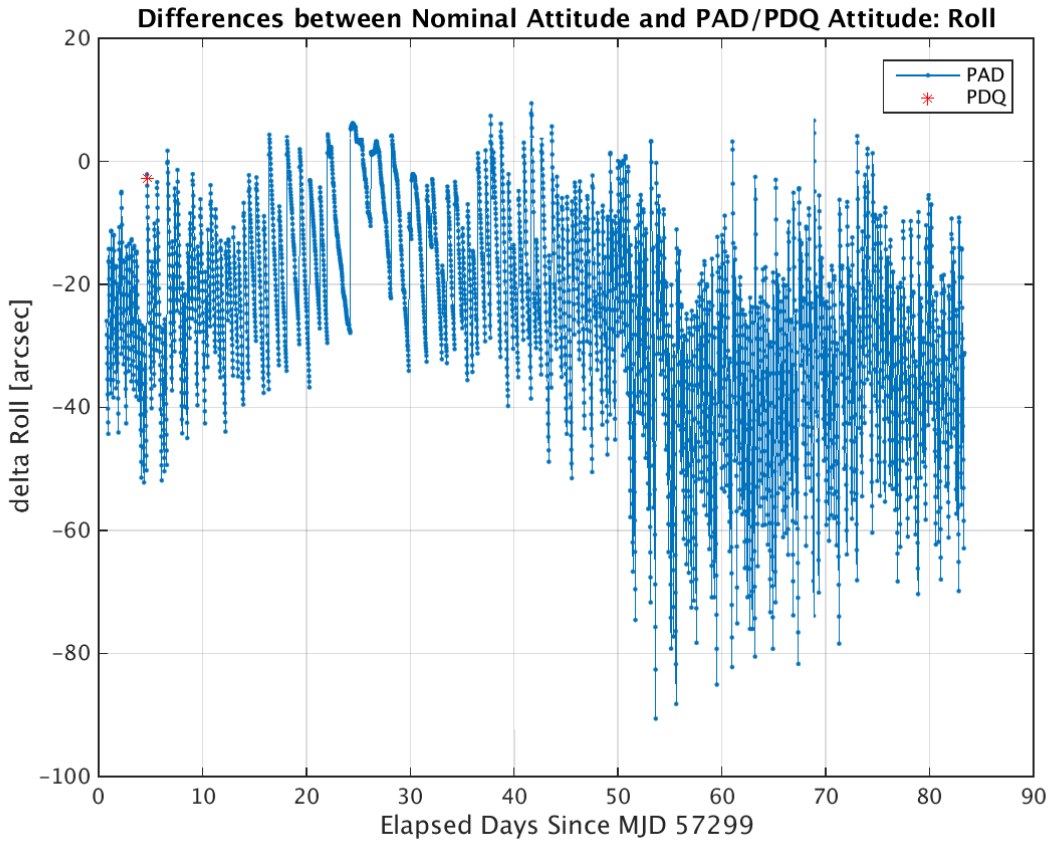
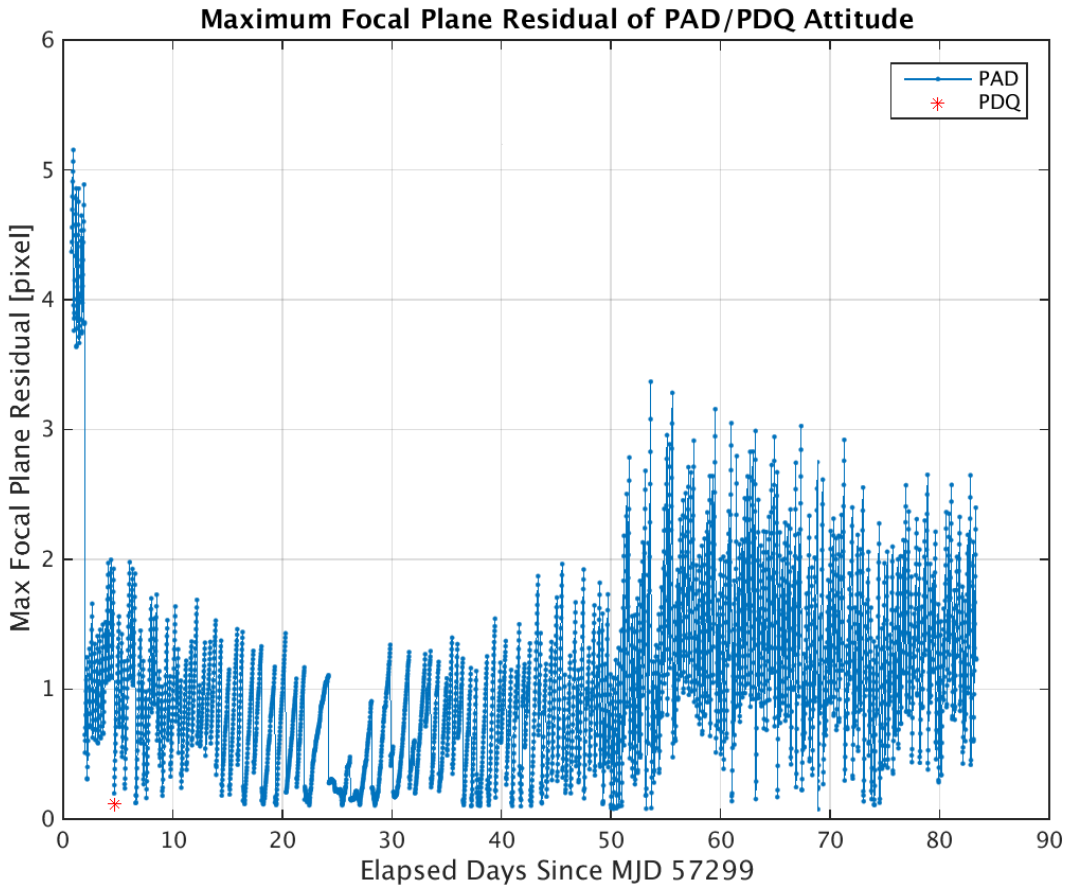
Data Quality and Processing Notes
Light Curve Quality
For the first ~30 hours of the campaign when the spacecraft was in coarse point, most stars are expected to be significantly outside of their optimal aperture. While the raw light curve (PA / SAP_FLUX) is processed and provided in the lightcurve FITS files for these cadences, the data was excluded from the PDC detrending module in order to improve performance across the campaign, and thus there is no PDC_SAPFLUX values in the provided lightcurve FITS files. Users wishing to attempt to utilize these ~30 days of coarse point should also note that the black level in the target-pixel files will be off by a constant value compared to the rest of the campaign — subtraction or addition of a flux constant will likely be required if combining with data from the rest of the campaign.
As in other campaigns, the 6-hour spacecraft roll cycle dominates the systematic errors in C7 simple aperture photometry light curves. The unusually large roll motion in C7, combined with an extremely crowded field, had a particularly strong impact on photometry compared to other campaigns, especially for targets near the edge of the focal plane — such targets have lower photometric precision. Also, background estimates based on background polynomials were strongly polluted by stars rolling in and out of the background apertures. This is especially true for channels near the edge of the focal plane (more roll) and near the Galactic plane (more stars). As a result, the background is strongly over-corrected, with short-time background variations strongly correlated with roll motion. These background variations have been subtracted from all pixels on the channel.
Despite the extra roll motion, the motion polynomials generally did a reasonable job tracking the large roll motion, and this enabled the computation of photometric apertures that significantly reduced the impact of roll motion in many cases. In other cases though, the roll motion was too large for the recovery of high-quality photometry using the standard pipeline processing. As part of the K2 global uniform reprocessing effort the spacecraft telemetry was used to identify pointing outliers and remove associated cadences from the PDC detrending module. This resulted in significantly better common basis vectors and PDC detrended lightcurves (PDC_SAPFLUX) than the previous processing.
While the previous processing resulted in a CDPP dwarf 12th magnitude noise benchmark that was increased by ~30% compared to the median value for all campaigns, as a result of reprocessing the benchmark is only ~15% higher, i.e., now within the normal range of campaign-to-campaign variation. The magnitude dependence of CDPP and its distribution over the focal plane are shown below. Other CDPP benchmarks can be found in the table giving 6.5-hr CDPP as a function of magnitude.
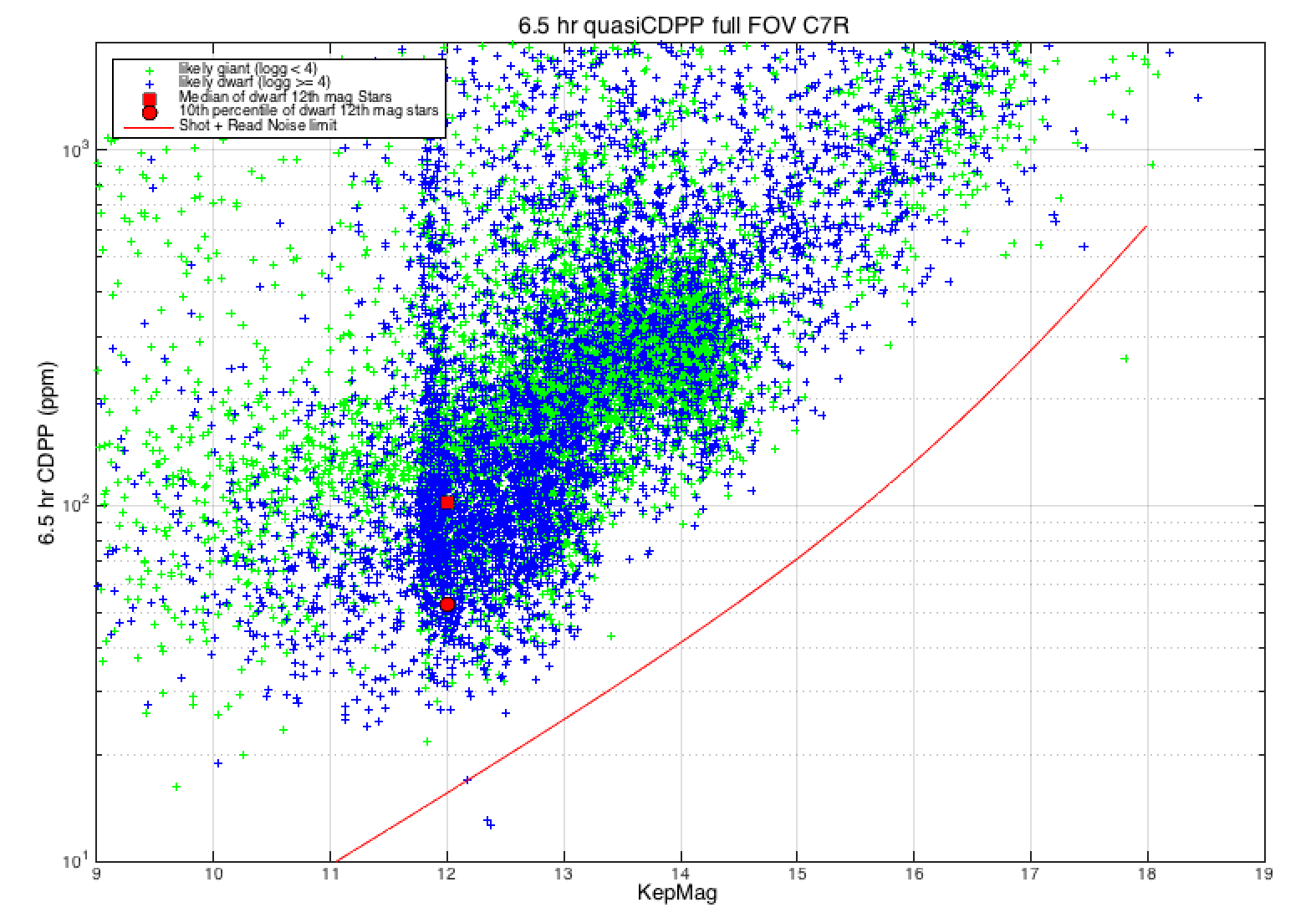
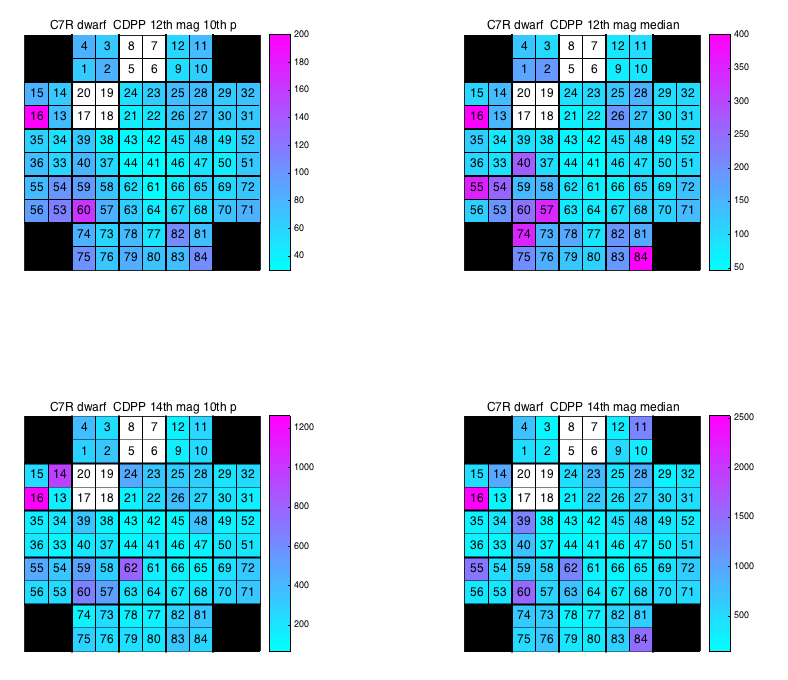
In addition to the issues with unusually large roll and crowding, stars selected for observation were unusually distributed in C7, with some channels having many targets and other channels having relatively few targets (see Figure C7-FOV-Targets). The result was that some channels had few target stars in the range of magnitudes used to characterize field motion via motion polynomials. A particularly dramatic example is channel 24.4, where all the targets used to create the motion polynomial for this channel are in one corner, resulting in a very inaccurate motion polynomial. Because motion polynomials are used in the creation of the photometric aperture, photometry for some targets on Mod.Out 24.4, and to a lesser extent 12.3, may be particularly poor.
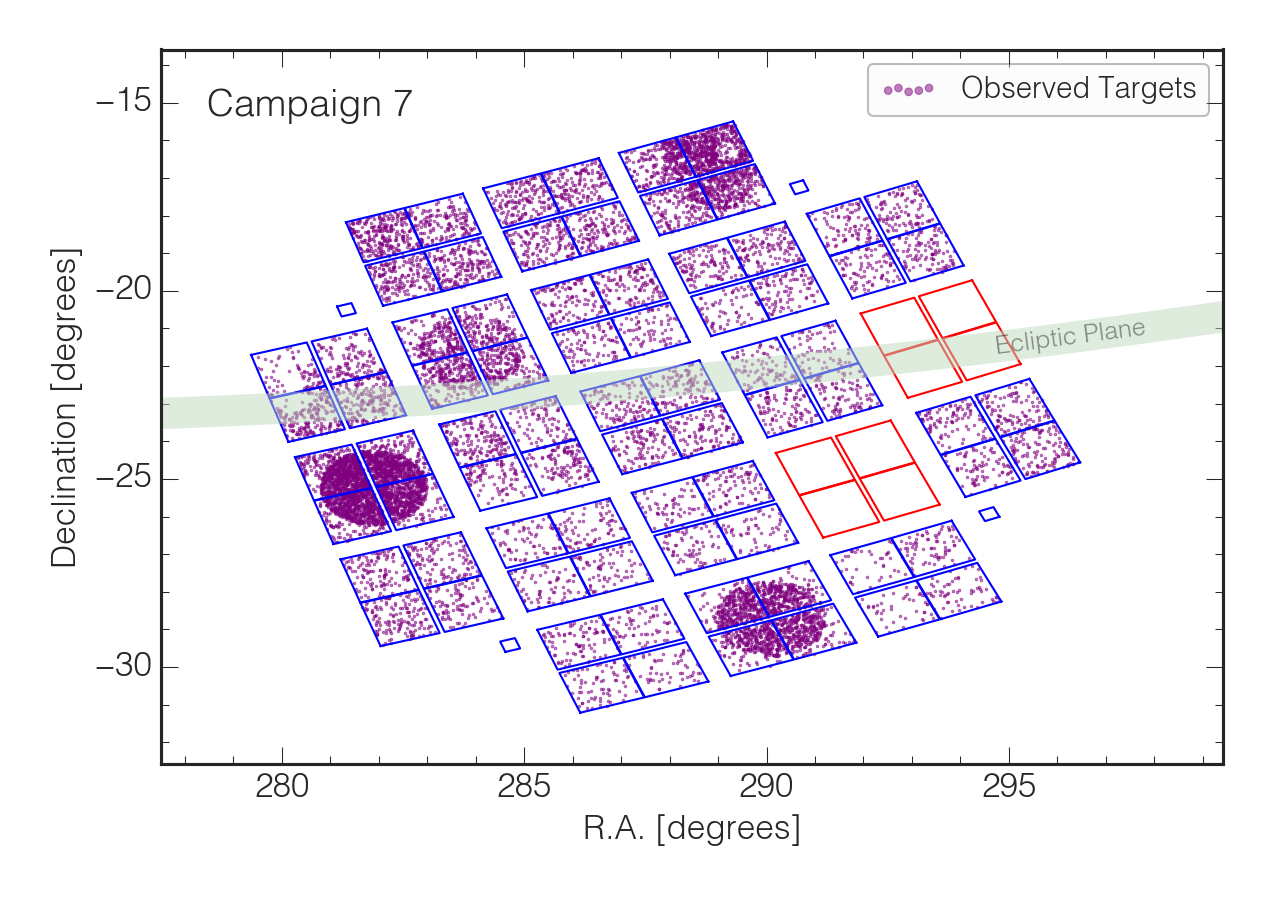
Poor Smear Correction
There are 4 channels in C7 for which the saturation spill due to very bright stars spans all CCD rows for one or more columns, corrupting both the masked and virtual smear measurements for these columns. In these cases, in order to allow the pipeline calibration to complete, we flag the masked smear as bad and process the data with only the virtual smear. As a result, the smear correction will be poor for the channel/column combinations listed below, and will be suspect for the same columns on other outputs on the same module as the indicated channel due to video crosstalk.
| Channel | Columns |
|---|---|
| 45 | 685:691 |
| 53 | 42:51 |
| 65 | 819:828 |
| 67 | 234:242 |
K2 Campaign 6
These release notes are for the C6 data currently available at MAST (Data Release 35) in the nominal K2 data locations, which have been processed with the final version of the K2 pipeline as part of the K2 global uniform reprocessing effort. The original release notes corresponding to the previous versions of C6 data (Data Release 8) can be found in the archived data release notes page.
At a glance
- RA: 204.8650344 degrees
- Dec: -11.2953585 degrees
- Roll: 159.6356000 degrees
- 47,550 EPIC IDs in long cadence (LC).
- 84 EPIC IDs in short cadence (LC).
- Several custom targets (see below)
- Time: 2015-07-13 22:45:04 UTC
- Long Cadence Number: 111362
- Short Cadence Number: 3329320
- Time: 2015-09-30 21:11:29 UTC
- Long Cadence Number: 115224
- Short Cadence Number: 3445209
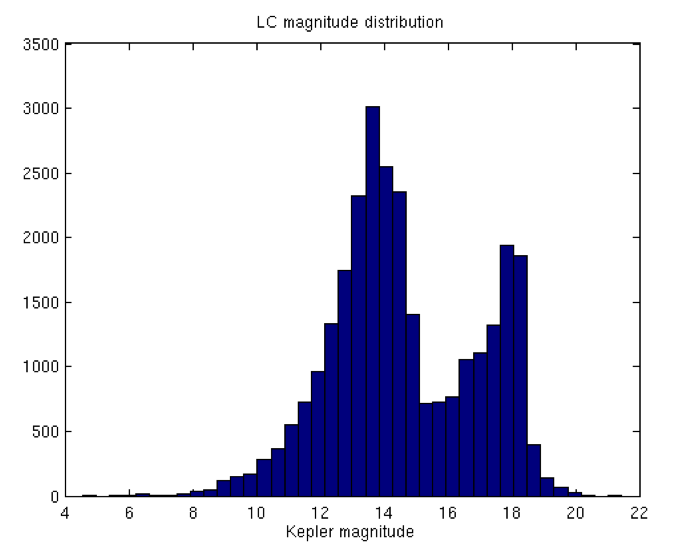
Features and Events
Spica
The star Spica (α Virginis, EPIC 212573842), the 15th brightest star in the sky, is on silcon during Campaign 6. As can be seen on the FFI above, Spica is on mod.out 18.3 (channel 63) and its Schmidt-corrector reflection lies on mod.out 8.3. (See this image for the module/channel layout.) The star bleeds into both smear regions, preventing proper smear correction on columns 805–816 on channel 63. Also, because of cross-talk, the Spica signal appears on all channels of module 18 at the same row and column position, but to a lesser degree. For more information on cross-talk, see the Instrument Handbook.
Observed Trojans
During Campaign 6, K2 observed 65 Trojan asteroids. Each was tiled with 1 x n pixel target definitions, where n ranges from 1 to 217. The tiled regions for three examples are shown in the figure below. The range of custom aperture numbers given to the Trojans is 200041889 – 200061149. A mapping of the minor planet designation numbers to the custom aperture numbers can be downloaded here.
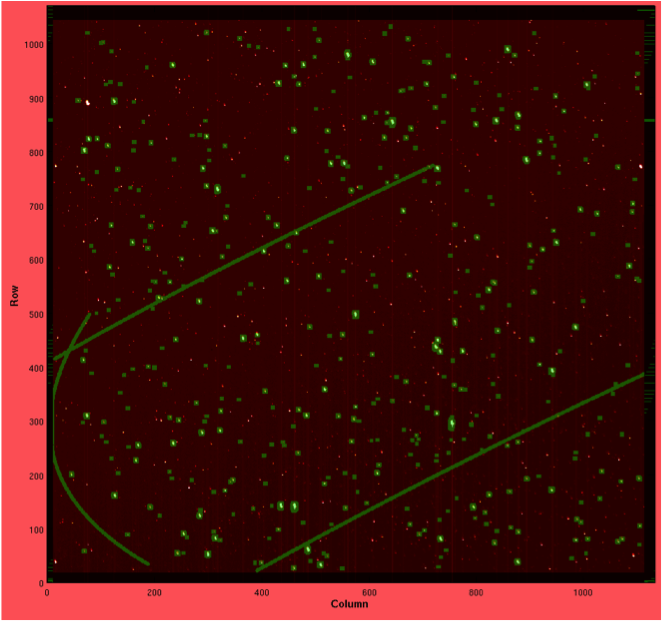
Variable Guide Star
The star on Module 25 used for guiding during C6 was highly variable, appearing to be a contact binary with a period of 14.5 hours and a depth of approximately 40 percent. A signal with the same period and phase is seen in a large number of long cadence, PDC light curves with an amplitude as large as 0.1 per cent. Please see the folded light curve and normalized BLS spectra below, and read this document, written for the previous processing release, for a detailed explanation. In short, the variable guide star caused periodic pointing errors of ±10 mas in RA and Dec, resulting in photometric variations in all targets and PDC cotrending basis vectors. Note that we expect the current data release (35) to be affected in the same way as the previous data release (8).
To help users understand and mitigate the effects of this guide star, we make available the module 25 guide star fluxes in a csv file. This data can also be found as part of the K2 Fine guidance sensor delivery. The guide star was selected from the USNO catalog and has an RA of 200.6867 degrees, Dec of -6.0353 degrees, and R magnitude of 9.51.
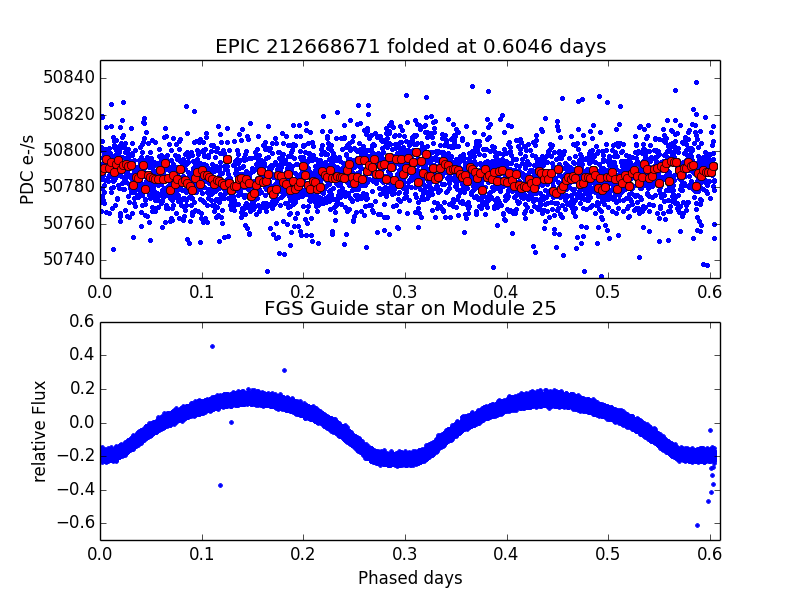
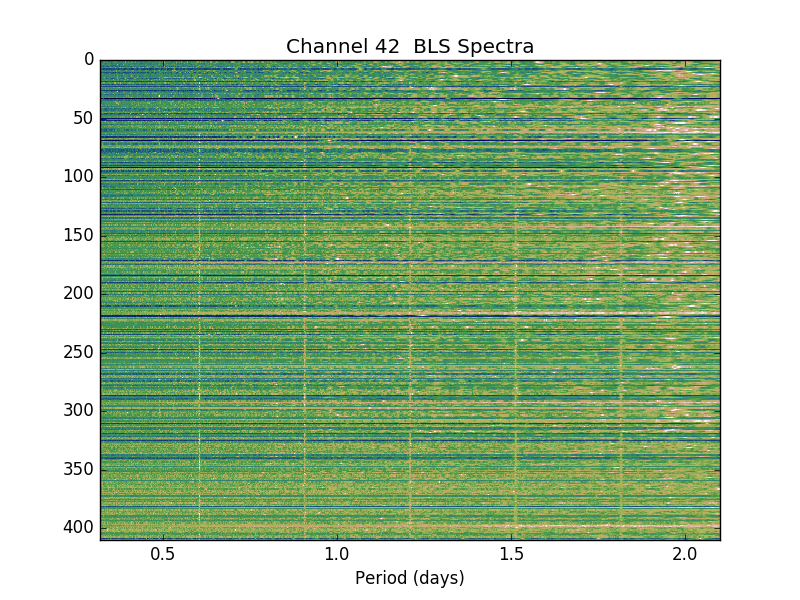
Pointing and Roll Performance
The C6 pointing and roll behavior are well within the limits of that seen in other K2 campaigns. The pipeline-calculated maximum distance between the derived and nominal positions for any target (the "maximum attitude residual", or MAR) for C6 is less than 2.2 pixels for nearly the entire campaign, well under the 3-pixel limit accommodated by the C6 aperture halos.
Users should note a significant ~6.5-hour pointing excursion that occurred just after mid-campaign, which encompasses long cadences 113663 – 113676 (short cadences 3398351 – 3398711). While these cadences are gapped in the delivered PDC lightcurve data, they are intentionally not gapped in the PA lightcurve data.
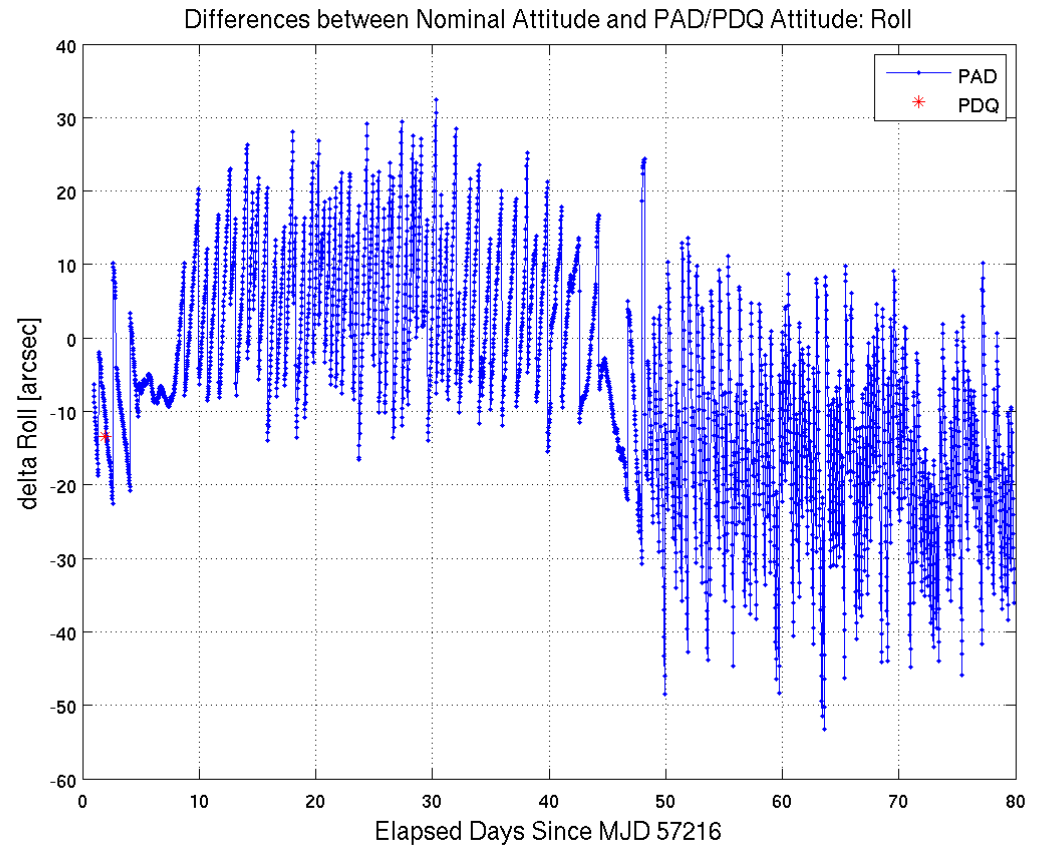
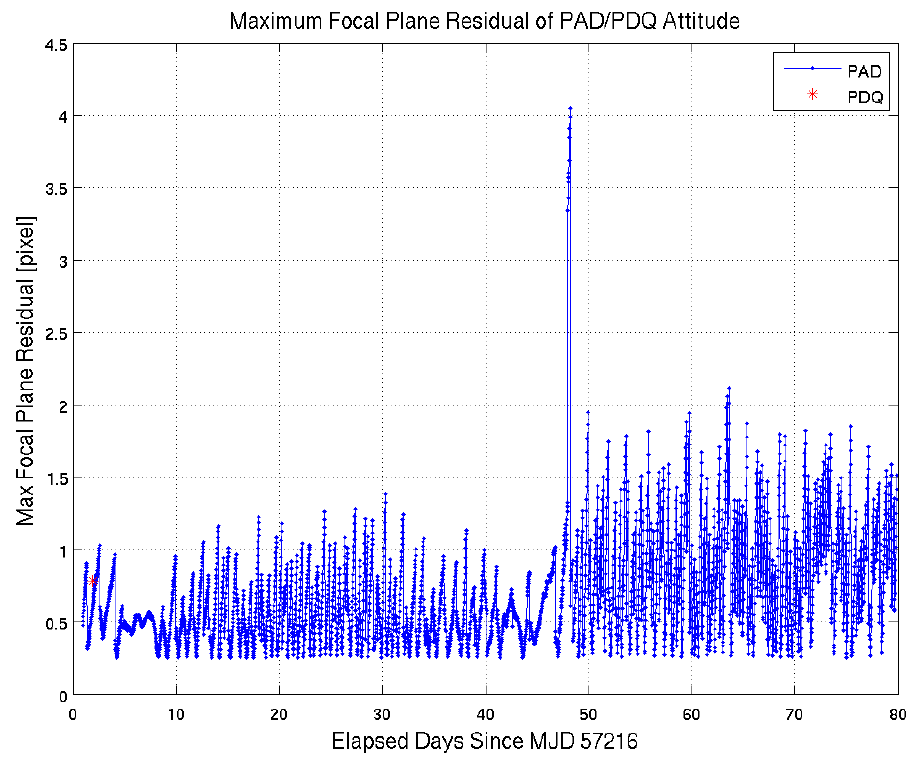
Data Quality and Processing Notes
Light Curve Quality
As in other campaigns, the 6-hour spacecraft roll cycle dominates the systematic errors in C6 simple aperture photometry light curves. The pipeline CDPP 12th magnitude noise benchmark for C6 (DR35) is comparable to that seen in other campaigns with similar star density.
The magnitude dependence of CDPP and its distribution over the focal plane are shown below. Other CDPP benchmarks can be found in the table giving 6.5-hr CDPP as a function of magnitude.
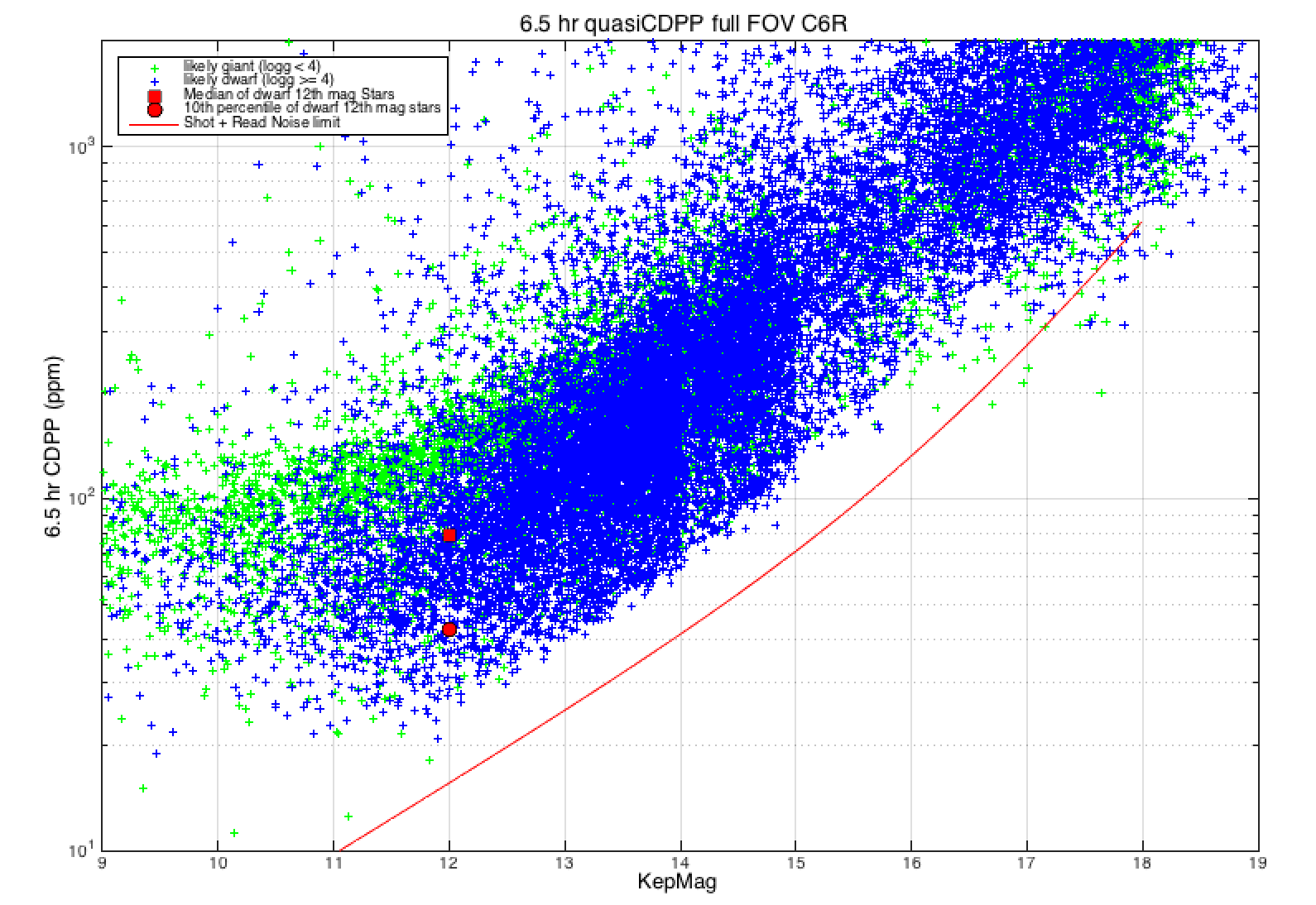
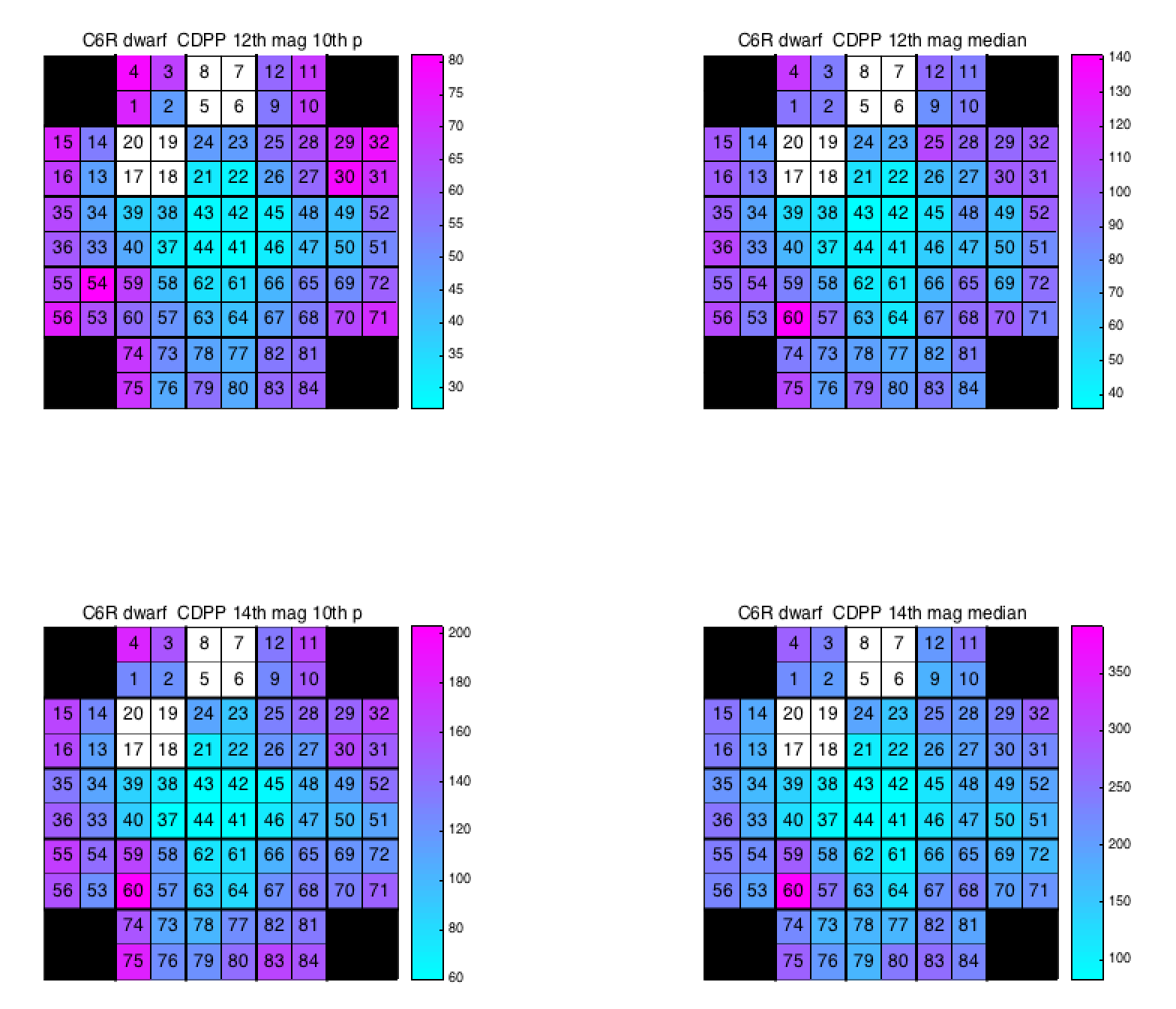
Missing PDC Data for Short-Cadence Lightcurves
Due to a processing bug, in this data release there is no PDC (PDCSAP_FLUX) data for all short-cadence lightcurves starting with short cadence 3345210 until the end of the campaign, i.e., the last ~86% of the PDCSAP_FLUX values are NaN. This bug only affected this campaign and only the short-cadence PDC data — the long-cadence data is unaffected, and the PA (SAP_FLUX) lightcurve data for short-cadence is unaffected.
Users of the short-cadence lightcurve data are encouraged to do their own detrending, starting with the PA (SAP_FLUX) photometric data. For example, see https://docs.lightkurve.org/api/correctors.html#module-lightkurve.correctors.
K2 Campaign 5
These release notes are for the C5 data currently available at MAST (Data Release 31) in the nominal K2 data locations, which have been processed with the final version of the K2 pipeline as part of the K2 global uniform reprocessing effort. The original release notes corresponding to the previous version(s) of C5 data (Data Releases 5 and 7) can be found in the archived data release notes page.
At a glance
- RA: 130.1576478 degrees
- Dec: 16.8296140 degrees
- Roll: 166.0591297 degrees
- 25,774 EPIC IDs in long cadence (LC).
- 204 EPIC IDs in short cadence (LC).
- Several custom targets (see below)
- Time: 2015-04-27 02:18:11.949 UTC
- Long Cadence Number: 107552
- Short Cadence Number: 3215020
- Time: 2015-07-10 22:39:43.571 UTC
- Long Cadence Number: 111214
- Short Cadence Number: 3324909
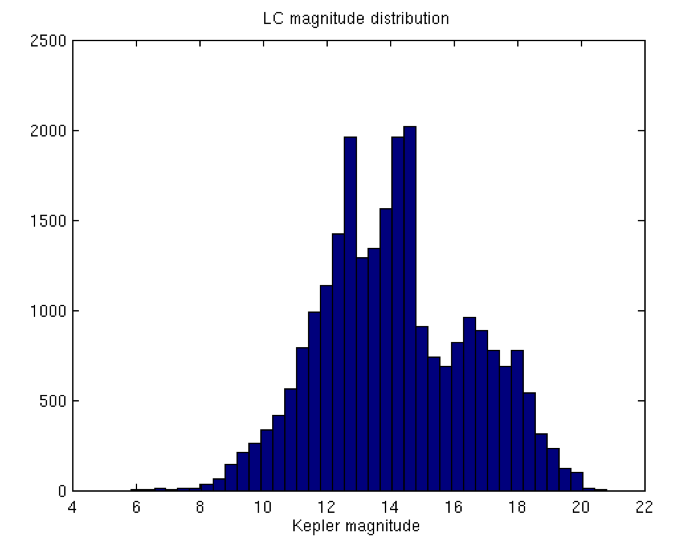
Features and Events
M67
The open cluster M67 was observed by collecting a 400x400 region of sky near the core of the cluster in modules 6.1 and 6.2. See Figures M67-Tile and M67-FFI below. These data are grouped into 72 custom apertures, each with a 50x50 pixel mask or smaller. Their data are listed by custom aperture number at the MAST in the range 200008644–200008715.

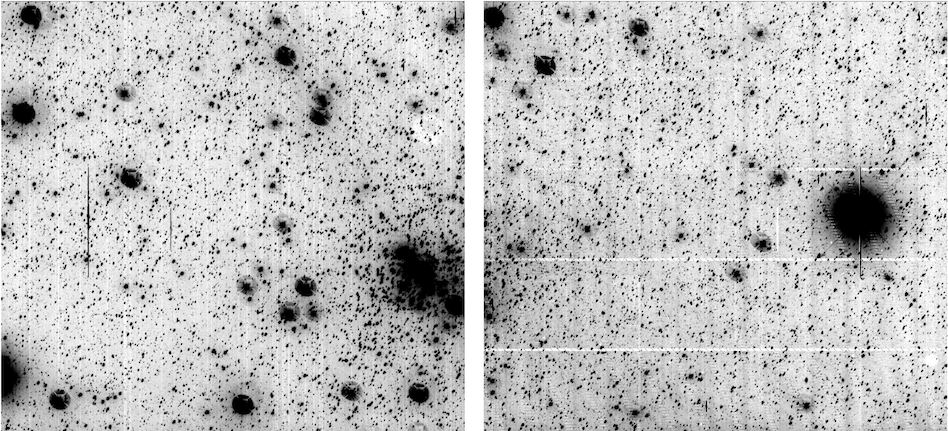
Trans-Neptunian Object
The Trans-Neptunian Object TNO (126154) 2001 YH140 was observed in Campaign 5 by creating 565 1xn pixel target definitions (where n ranges from 4 to 21) that cover the path of the TNO. The custom aperture numbers range from 200008716 to 200009280.
Noted Data Anomalies
Approximately 55.5 days after the start of C5, we note a small (~4000 electrons per cadence) increase in the median dark level that lasts approximately a day. The event is likely caused by a Coronal Mass Ejection, and its size is small compared to other normal variations seen in the dark level. This change in dark level is part of the normal calibration process that occurs in the CAL module.
One Argabrightening event was seen in the observed background level approximately 38 days into the campaign and affects a majority of the channels. This event is flagged on bit 13 in the QUALITY column of the light curve and target pixel files for those targets on the affected channels.
Data Quality and Processing Notes
Light Curve Quality
As in other campaigns, the 6-hour spacecraft roll cycle dominates the systematic errors in C5 simple aperture photometry light curves. The pipeline CDPP 12th magnitude noise benchmark for C5 (DR31) is comparable to that seen in other campaigns with similar star density.
The magnitude dependence of CDPP and its distribution over the focal plane are shown below. Other CDPP benchmarks can be found in the table giving 6.5-hr CDPP as a function of magnitude.
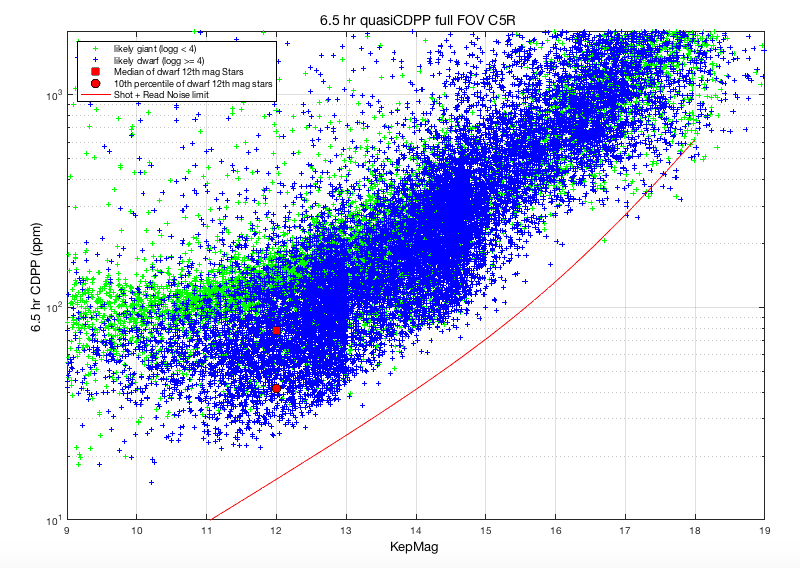
Incorrect pixel-level calibration of some short-cadence TPFs
Due to a processing error in Data Release 31, there are 74 C5 short-cadence targets that had incorrect calibration of their short-cadence pixel-level data. (Long cadence data is unaffected.) The list of affected C5 targets is below. Although it is estimated that only ~25% of them are affected at a non-negligible level, users are strongly encouraged to examine their target, if it is on the list below, to check the severity level and evaluate potential science impact. For a more detailed description of this issue, along with per-target diagnostics and a link to short-cadence TPFs from a previous processing that was not affected by this error, please read this news post.
211383343 211401610 211403555 211407836 211408116 211408138 211408522
211408990 211409011 211409345 211409348 211409376 211409644 211410664
211410931 211412077 211412252 211414203 211416577 211417812 211427749
211429653 211480655 211529191 211565467 211569404 211596649 211623711
211630249 211642294 211686003 211696659 211708181 211730342 211765471
211779126 211808853 211846489 211888384 211892034 211902739 211909987
211912407 211916015 211918335 211918500 211920612 211927867 211929178
211931736 211934173 211936827 211948678 211950227 211950703 211951863
211952381 211954226 211954550 211957988 211972627 211975006 211979334
211980170 211980688 211988287 211992776 211995547 212001099 212100422
212104541 212160442 212173112 228682517
K2 Campaign 4
These release notes are for the C4 data currently available at MAST (Data Release 33) in the nominal K2 data locations, which have been processed with the final version of the K2 pipeline as part of the K2 global uniform reprocessing effort. The original release notes corresponding to the previous versions of C4 data (Data Releases 6 and 10) can be found in the archived data release notes page.
At a glance
- RA: 59.0759116 degrees
- Dec: 18.6605794 degrees
- Roll: -167.6992793 degrees
- 15,847 EPIC IDs in long cadence (LC).
- 122 EPIC IDs in short cadence (LC).
- Several custom targets (see below)
- Time: 2015-02-08 06:50:09.177 UTC
- Long Cadence Number: 103744
- Short Cadence Number: 3100780
- Time: 2015-04-20 04:32:47.045 UTC
- Long Cadence Number: 107213
- Short Cadence Number: 3204879
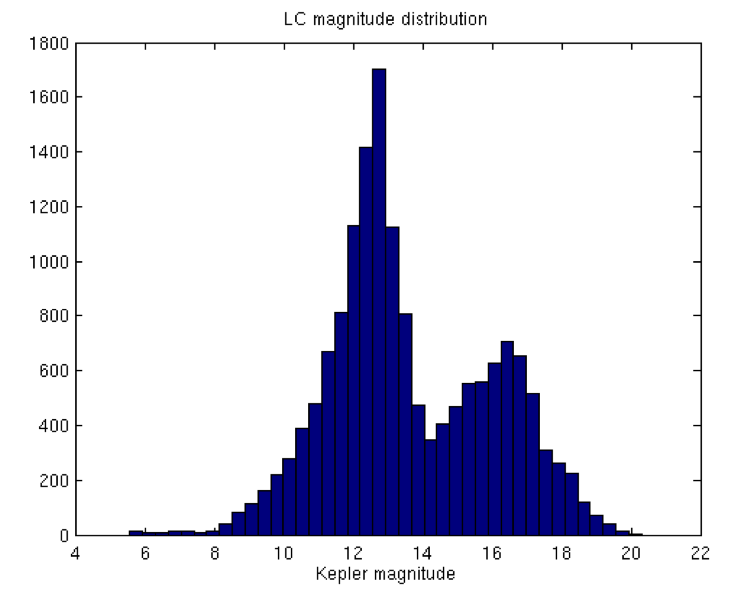
Features and Events
Pleiades and Hyades
The Pleidaes and Hyades are notable features in Campaign 4, and include several bright stars that significantly saturate the detector.
One Director's Discretionary Target program (GO4901, PI:White) was approved in Campaign 4 which observes the nine 3–5 mag B-stars and red giants in the Pleiades and Hyades open clusters. The targets were observed using circular pixel masks (20 pixels in radius) that cover the wings of the PSF but not the entire saturation bleed.
The two stars in the Hyades are γ Tau and δ1 Tau. The seven stars in the Pleiades are: Alcyone (η Tau), Atlas (27 Tau), Electra (17 Tau), Maia (20 Tau), Merope (23 Tau), Taygeta (19 Tau) and Pleione (28 Tau). These stars are all listed in the EPIC, however their data are listed by custom aperture number at the MAST in the range 200007765–200007773.
The Figures C4-Pleiades and C4-Pleiades-Inv below show an FFI of module 15, which covers the Pleiades cluster, in two different flux scalings.
Trans-Neptunian Object
The Trans-Neptunian Object 2002 KY14 was observed in Campaign 4 by creating 1340 masks that cover the path of the TNO. The custom aperture numbers range from 200006425–200007764. These observations were taken as part of Guest Observer program GO4110 (PI:Schwamb).
Pointing and Roll Performance
The C4 pointing and roll behavior are well within the limits of that seen in other K2 campaigns. The pipeline-calculated maximum distance between the derived and nominal positions for any target (the "maximum attitude residual", or MAR) for C4 is less than 2 pixels, well under the 4-pixel limit accommodated by the C4 aperture halos. Users should note that, while within limits, the roll error does increase towards the end of the campaign and may result in increased photometric noise.
Data Quality and Processing Notes
Non-Optimal Background Correction near the Pleiades
Background removal for channels near the Pleiades has larger than normal residuals. These large residuals occur on mod.outs 10.3 and 15.1 through 15.4 due to the background on these channels being dominated by dust clouds near the Pleiades. The rich spatial structure of the Pleiades' dust clouds is poorly captured by the low order (≤ 4) polynomial model used to fit the background flux, with the best fit for these channels being given by a constant. This fit is done for every cadence, and the result is higher than normal background residuals, with residuals as large as 7 times the standard deviation of the background pixel values. (Normal residuals are typically less than the background standard deviation.)
We recommend caution when using light curves or the background model on these channels. Note that the FLUX column of the target pixel files contains calibrated pixels with the background subtracted. The amount of background that was subtracted per pixel can be found in the FLUX_BKG column and restored, if desired.
Local background estimates per star may produce higher-quality results. The change in the constant background level on these channels over time is in family with the median background change on other channels.
Large Number of Saturated Stars
Due to the Hyades and Pleiades clusters, there is a large number of bright stars that saturate the detector in Campaign 4. Users are cautioned to ensure that their target(s) are not affected by these bright, bleeding stars prior to analysis. For example, Figure C4-Chan15 highlights the number and extent of bleed trails on channel 52. Figure C4-Sat-Example shows an example of a typical target that is severely affected by the bleed from a bright star on the same column — examining a target's TPF image in this manner will reveal if it is affected directly by a bright stars' bleed.
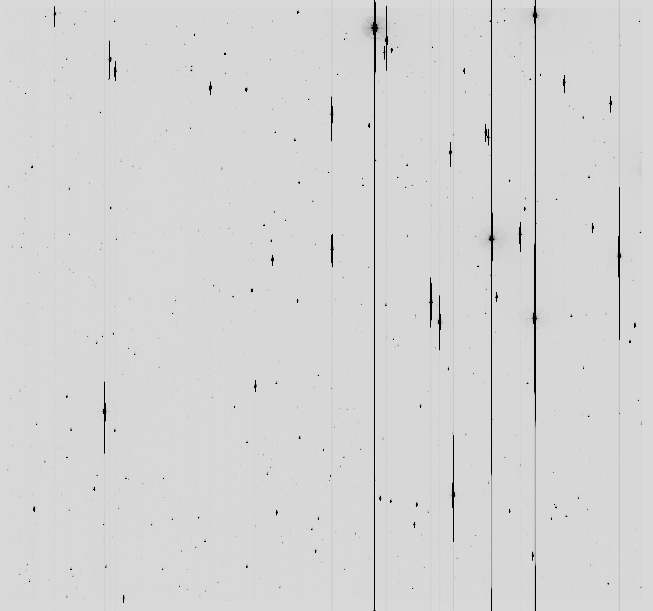
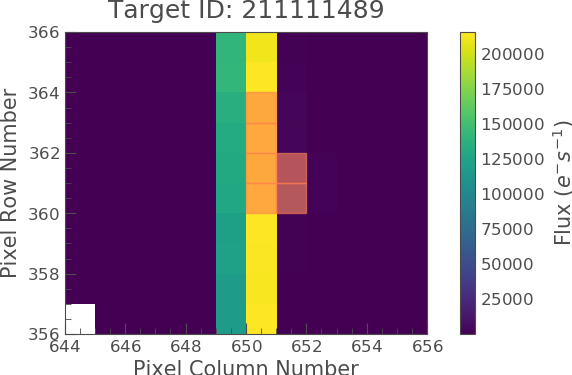
Poor Smear Correction on Channel 25, Column 777
The very bright (Kp=5.775), nearby (55.2 ly) solar-like star 39 Tauri was observed in Campaign 4. It it so bright that it saturates the smear calibration columns, and thus smear correction for column 777, and possibly neighboring columns, is not optimal. Caution is encouraged when analyzing other targets on this column as a result of the saturation and poor calibration, especially those at lower row numbers.
39 Tauri was only observed with a typical 4-halo aperture (instead of a dedicated disk as is more typical for bright stars). Thus, any analysis of 39 Tauri itself will be more challenging compared to analysis of other bright stars with dedicated disks.
Several Stars Show Higher Than Expected Flux
There is a group of target stars whose measured flux is more than twice that expected from their EPIC Kepler magnitudes. The figure below shows that these stars fall into spatial groups that are aligned with RA and Dec, rather than focal plane coordinates, strongly indicating that the cause of this anomaly is catalog error. The source of this error is presently unknown and is not correlated with Kepflag values. The optimal apertures used to generate light curves for these targets may be smaller than optimal, reducing their photometric precision.
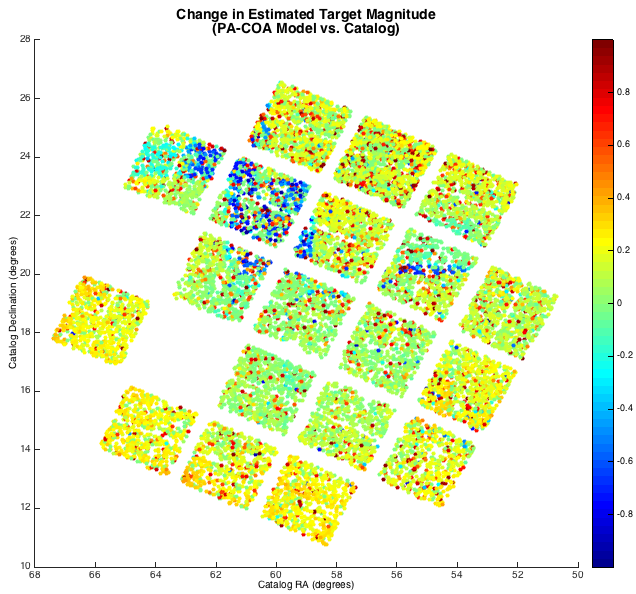
Stars Show Lower Than Expected Flux
The comparison of the measured flux to the flux based on their Kepler magnitudes in the EPIC catalog shows that ~3,752 stars (23.8% of all stellar targets) are too bright by about a magnitude. The EPIC catalog field Kepflag gives the provenance of the Kepler magnitude estimate by listing the catalog magnitudes used to estimate the Kepler magnitude. Stars with Kepflag = “JHK” or “J” have Kepler magnitudes that are generally overestimated. These stars appear at all magnitudes, but predominantly have EPIC Kepler magnitudes dimmer than 14. The optimal apertures used to generate light curves for these “JHK” or “J” targets may be larger than optimal, reducing their photometric precision.
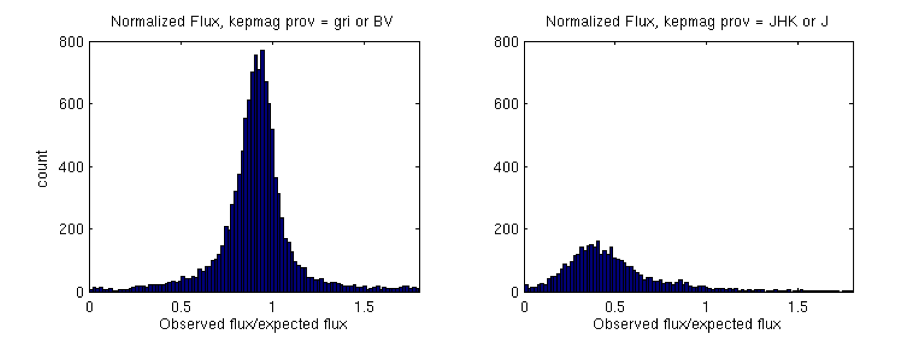
Stellar Targets with Negative Lightcurve Values
Seventy-four stellar targets show negative flux values in their SAP_FLUX light curves, which is somewhat more than normally seen. Most of these are very dim, near background level targets at the edge of the focal plane where K2 roll has the largest impact, so it is not surprising that the roll causes negative flux values after background removal. The bright targets with negative flux values either have isolated negative flux outliers or are on the Pleiades channels, where there are large background residuals due to the constant background model on these channels, see above.
Light Curve Quality
As in other campaigns, the 6-hour spacecraft roll cycle dominates the systematic errors in C4 simple aperture photometry light curves. The pipeline CDPP 12th magnitude noise benchmark for C4 (DR33) is comparable to that seen in other campaigns with similar star density.
The magnitude dependence of CDPP and its distribution over the focal plane are shown below. Other CDPP benchmarks can be found in the table giving 6.5-hr CDPP as a function of magnitude.
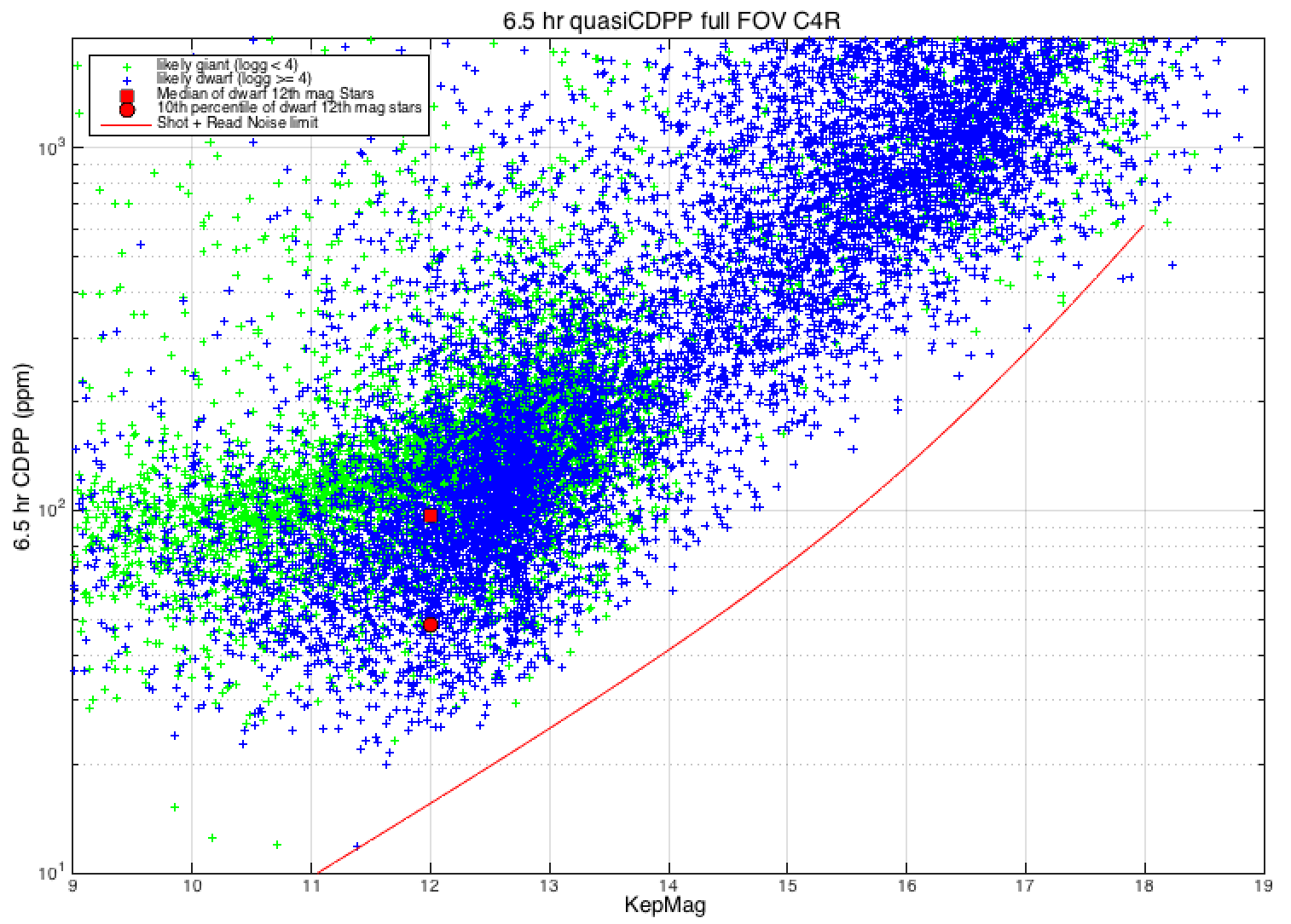
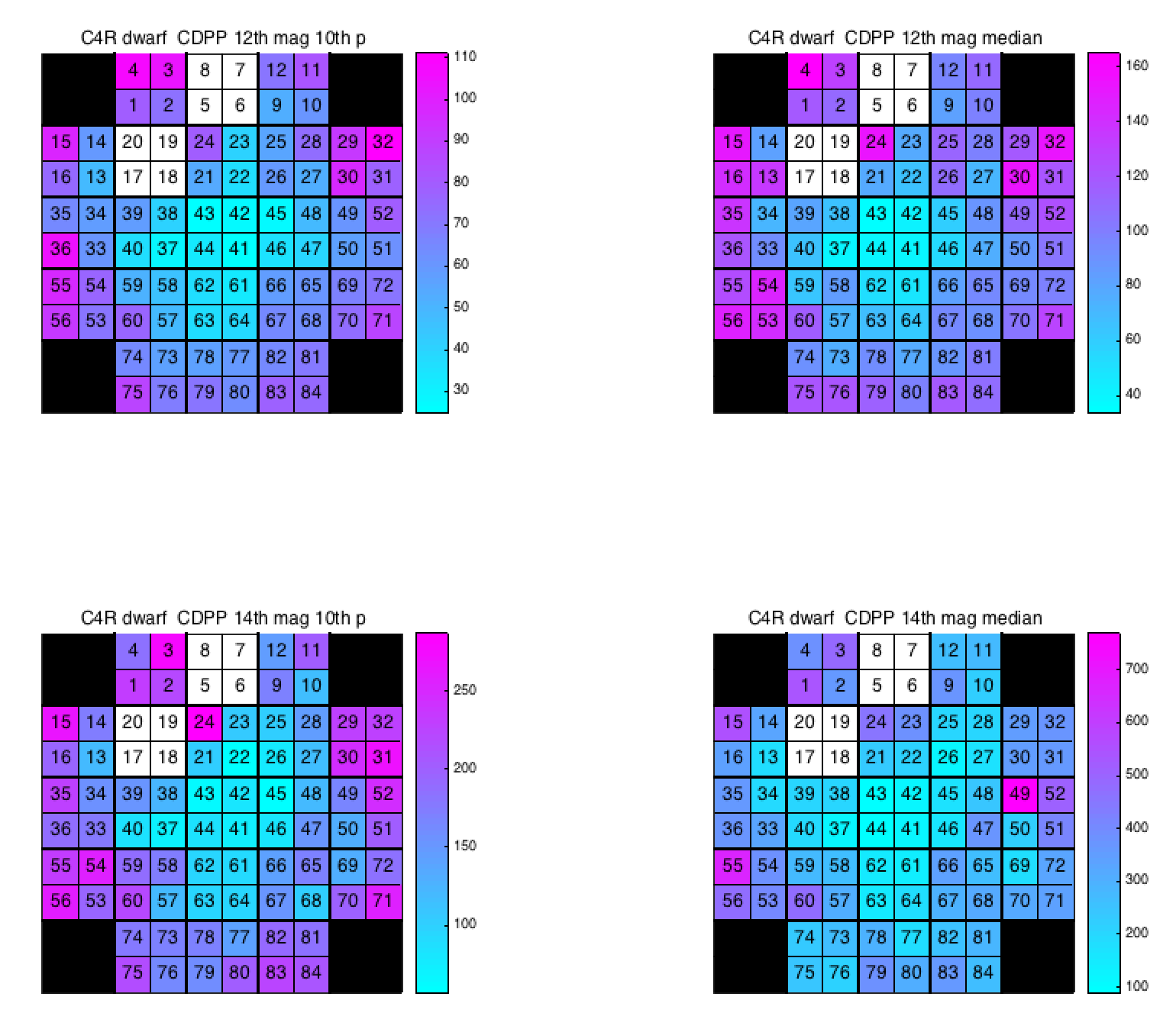
K2 Campaign 3
These release notes are for the C3 data currently available at MAST (Data Release 26) in the nominal K2 data locations, which have been processed with the final version of the K2 pipeline as part of the K2 global uniform reprocessing effort. The original release notes corresponding to the previous version(s) of C3 data (Data Releases 5 and 10) can be found in the archived data release notes page.
At a glance
- RA: 336.66534641439 degrees
- Dec: -11.096663792177 degrees
- Roll: -158.494818065985 degrees
- 16,833 EPIC IDs in long cadence (LC).
- 216 EPIC IDs in short cadence (LC).
- Several custom targets (see below)
- Time: 2014-11-15 14:06:05.515 UTC
- Long Cadence Number: 99599
- Short Cadence Number: 2976430
- Time: 2015-01-23 18:37:04.488 UTC
- Long Cadence Number: 102984
- Short Cadence Number: 3078009
Features and Events
Neptune
Neptune moved across the field of view during C3 and K2 observed it in both long and short cadence. Short cadence data were obtained approximately 20 days on each side of the stationary point of Neptune. The movie below shows Neptune and its moons, Triton and Nereid, as they move across the detector over approximately 50 days. Note that Neptune saturates the detector, which results in the observed spikes in the column direction as Neptune moves across the detector. The custom aperture numbers associated with Neptune are 200004468--200004923. These observations were taken as part of Guest Observer Programs GO3060 (PI:Rowe) and GO3057 (PI:Gaulme).
Trans-Neptunian Object
The Trans-Neptunian Object (225088) 2007 OR10 was observed with 2 masks and given custom aperture numbers 200004466 and 200004467. This target was observed as part of Guest Observer Program GO3053 (PI:Szabo).
Premature End
Campaign 3 had a nominal duration of 80 days, but an actual duration of 69.2 days. The campaign ended earlier than expected because the on-board storage filled up faster than anticipated due to poorer than expected data compression.
Aperture Halos
In order to ensure that the flux from each target is adequately captured in the presence of the K2 roll motion, for C3, 3-pixel halos were included around each target in the center half of the field of view, and 4-pixel halos around each target in the outer half of the field of view, as shown below. In comparison, many later campaigns were flown with only 2- and 3-pixel halos.
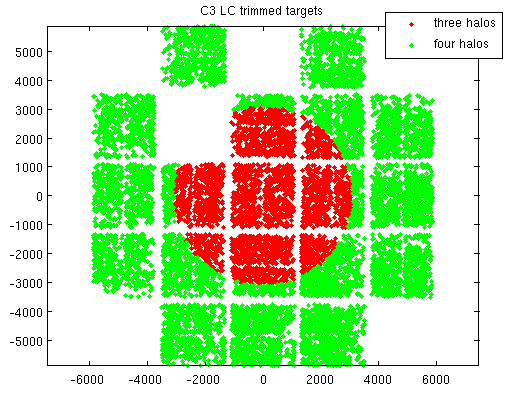
Data Quality and Processing Notes
Light Curve Quality
As in other campaigns, the 6-hour spacecraft roll cycle dominates the systematic errors in C3 simple aperture photometry light curves. The pipeline CDPP 12th magnitude noise benchmark for C3 (DR26) is comparable to that seen in other campaigns with similar star density.
The magnitude dependence of CDPP and its distribution over the focal plane are shown below. Other CDPP benchmarks can be found in the table giving 6.5-hr CDPP as a function of magnitude.
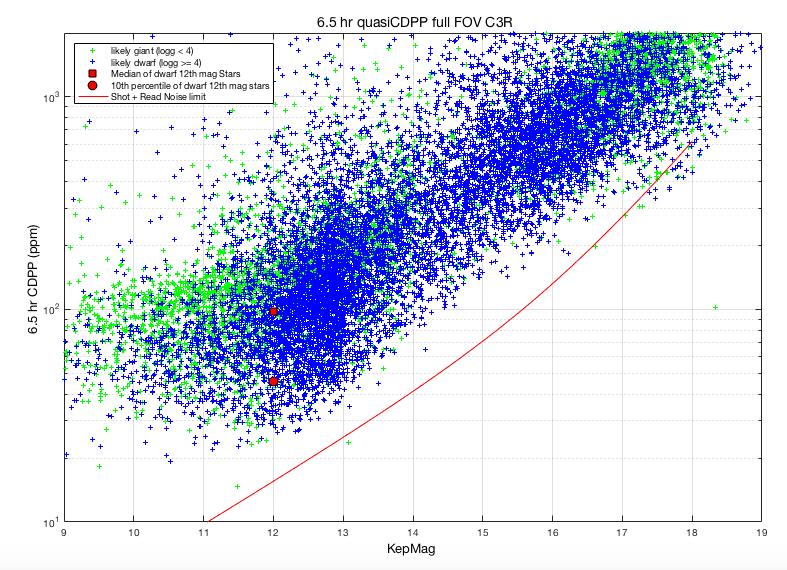
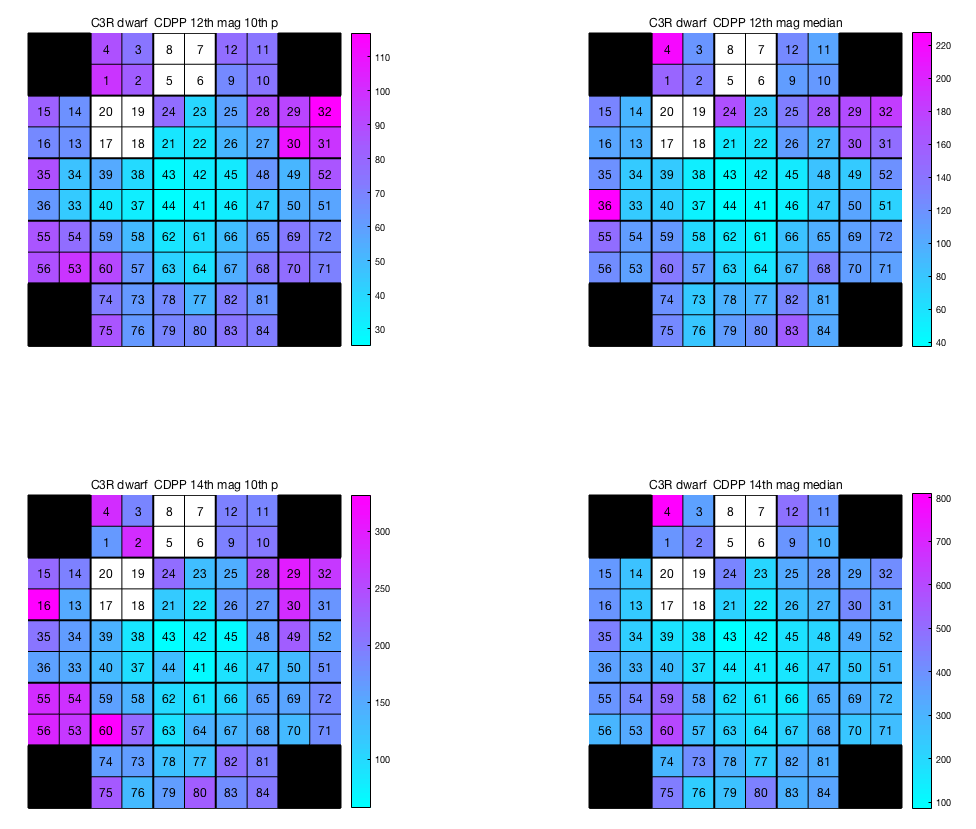
Incorrect pixel-level calibration of some short-cadence TPFs
Due to a processing error in Data Release 26, there are 57 C3 short-cadence targets that had incorrect calibration of their short-cadence pixel-level data. (Long cadence data is unaffected.) The list of affected C3 targets is below. Although it is estimated that only ~25% of them are affected at a non-negligible level, users are strongly encouraged to examine their target, if it is on the list below, to check the severity level and evaluate potential science impact. For a more detailed description of this issue, along with per-target diagnostics and a link to short-cadence TPFs from a previous processing that was not affected by this error, please read this news post.
200004841 200004843 200004844 200004845 200004846 200004847 200004848
200004849 200004851 205917956 205924248 205962429 205967173 205974115
205979004 205982900 205995584 205997466 206003187 206009487 206020725
206053352 206054604 206064678 206064711 206070413 206078331 206085353
206088888 206094605 206103150 206107253 206108325 206135809 206154641
206167112 206169988 206180842 206183149 206184719 206189170 206189649
206201061 206225297 206245055 206262336 206270336 206289686 206289767
206292760 206359447 206368174 206371648 206445085 206453540 206496452
206535752
K2 Campaign 2
These release notes are for the C2 data currently available at MAST in the nominal K2 data locations, which have been processed with the final version of the K2 pipeline as part of the K2 global uniform reprocessing effort. The original release notes corresponding to the previous version(s) of C2 data can be found in the archived data release notes page.
At a glance
- RA: 246.1264 degrees
- Dec: -22.4473 degrees
- Roll: 171.2284 degrees
- 16,665 EPIC IDs in long cadence (LC).
- 54 EPIC IDs in short cadence (LC).
- Several custom targets (see below)
- Time: 2014-08-23 18:27:16 UTC
- Long Cadence Number: 95497
- Short Cadence Number: 2853370
- Time: 2014-11-10 13:27:43 UTC
- Long Cadence Number: 99352
- Short Cadence Number: 2969049
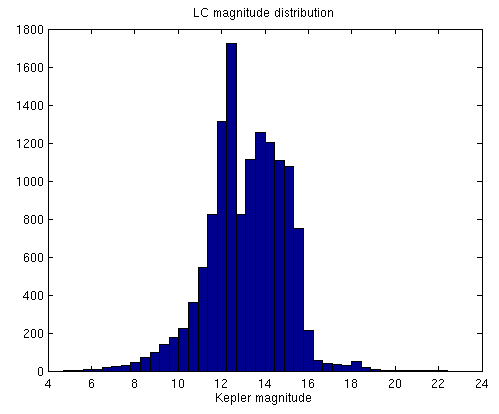
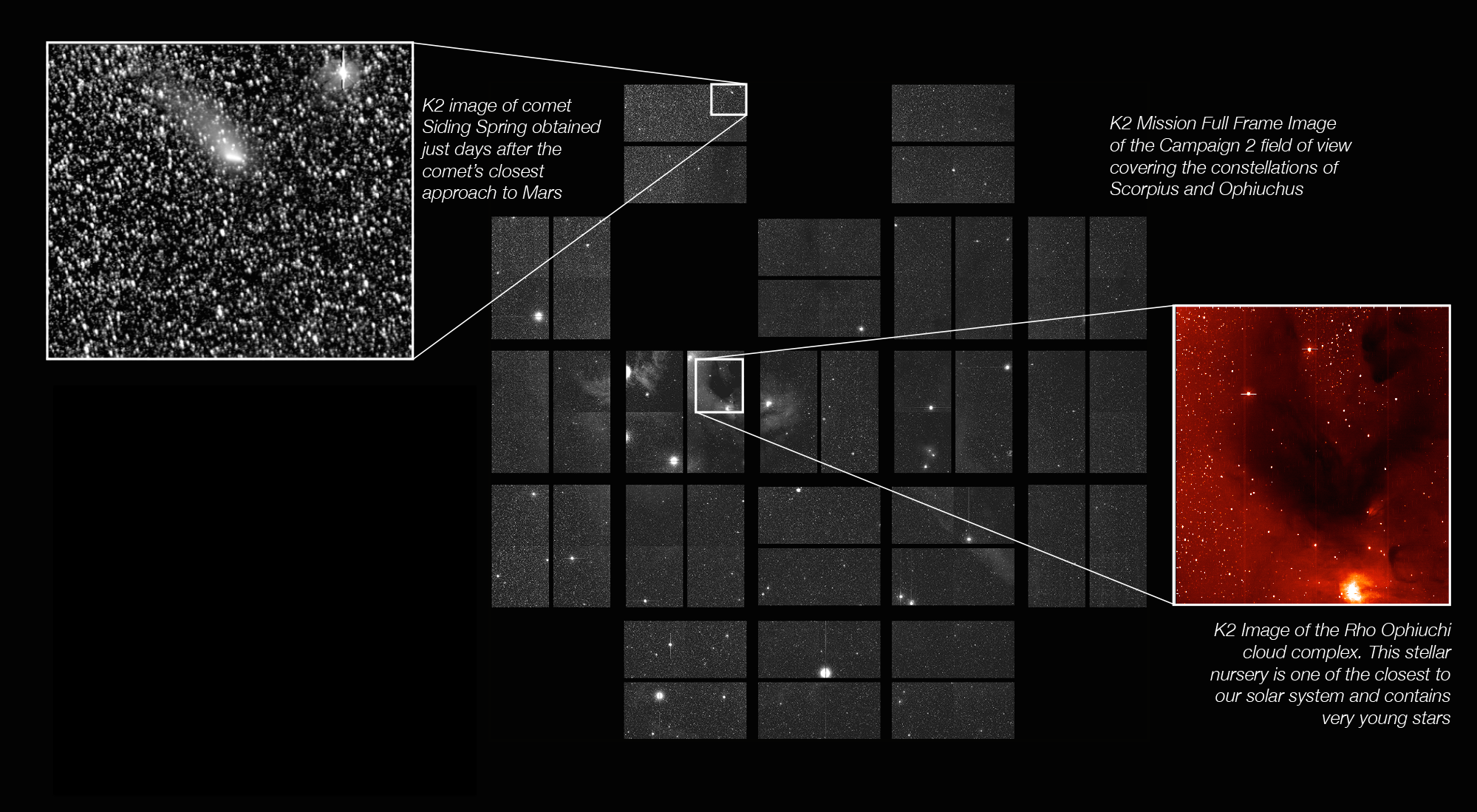
Features and Events
Solar Activity
During C2 Kepler experienced two energetic particle events of note, likely caused by solar activity. Both events affected all channels as can be seen in the dark current metric plot for the first 26 days of C2 (see Figure K2-Dark below). The first was a broad peak lasting approximately from cadence 95924–96335 (01-Sep-2014 11:51:30 Z [MJD: 56901.4941] to 09-Sep-2014 21:24:55 Z [MJD: 56909.8923]). The second was a stronger, sharper peaked event lasting approximately from cadence 96357–96551 (10-Sep-2014 17:01:54 Z [56910.7096] to 14-Sep-2014 07:20:35 Z [56914.30596]). At the peak of the 10-Sep-2014 event the average dark current increased by a factor of ~7 over the quiescent level. The GOES X-ray flux plot for this time shows an increased X-ray flux at Earth, though an independent measure of the exact timing and magnitude at the location of Kepler is not available. The impact to the data will be in the form of increased background level and increased photometric noise — the impact will be largest for faint targets.
Mars
Mars passed across the field of view between October 1 and October 23, 2014. See Figure C2-Mars below for a prediction of where Mars is on the focal plane during Campaign 2. Mars is a bright object that saturates the CCD causing significant bleeding along the columns it falls on as it passes through the field. Both its image and its reflection will likely contaminate nearby stars.
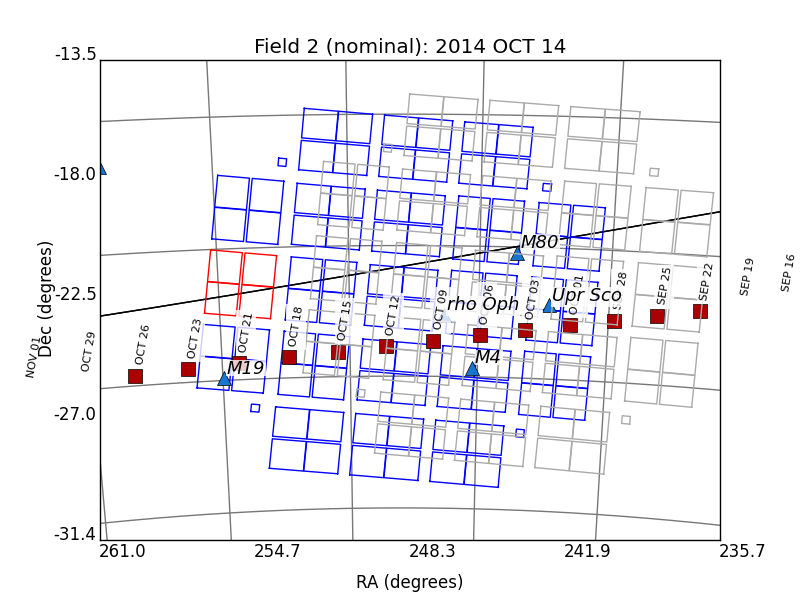
Two Globular Clusters
The clusters M4 and M80 were observed in C2 by collecting all the pixels in 50x50 pixel masks. For M4, 16 of these custom apertures were collected and for M80, 4 were collected. The data files for M4 range from 200004370–200004385. The data files for M80 range from 200004386–200004389. The target pixel files may be found by using the Object Type field on the MAST K2 data search page.
Two Solar System Objects
Comet C/2013 A1 (Siding Spring) was observed by obtaining 2583, 25x1 pixel, masks across module.outputs 2.3, 4.2, 4.3 and 4.4 (channels 3, 10, 11, and 12 respectively) as shown in Figure C2-Comet below. These apertures were given custom aperture numbers ranging from 200001787–200004369. This target was observed as part of the Guest Observer Programs GO2030 (PI:Kelley) and GO2046 (PI:Lisse).
The Trans-Neptunian Object (268361) 2007 JJ43 was observed with 661 pixel masks, each one with size of either 11x1 or 13x1 pixels, and given custom aperture numbers ranging from 200001126–200001786. The pixel masks are shown below in Figure C2-TNO. This target was observed as part of Guest Observer Program GO2066 (PI:Schwamb).
These data sets can be found at the MAST by entering the Investigation ID on the search form. The Investigation ID matches the GO Program number that requested the observations.
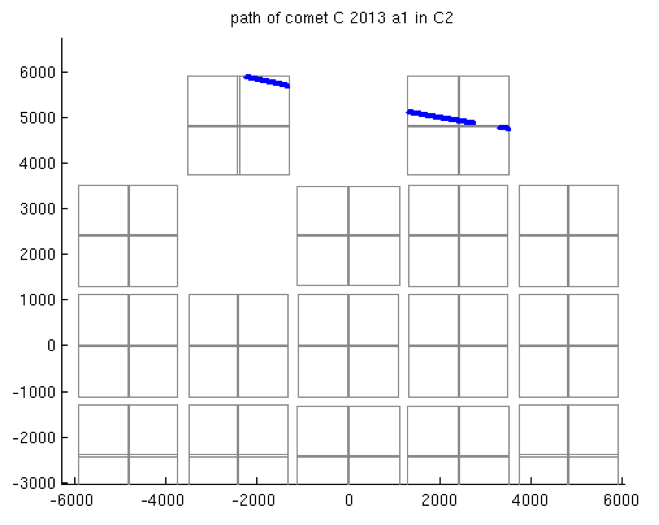
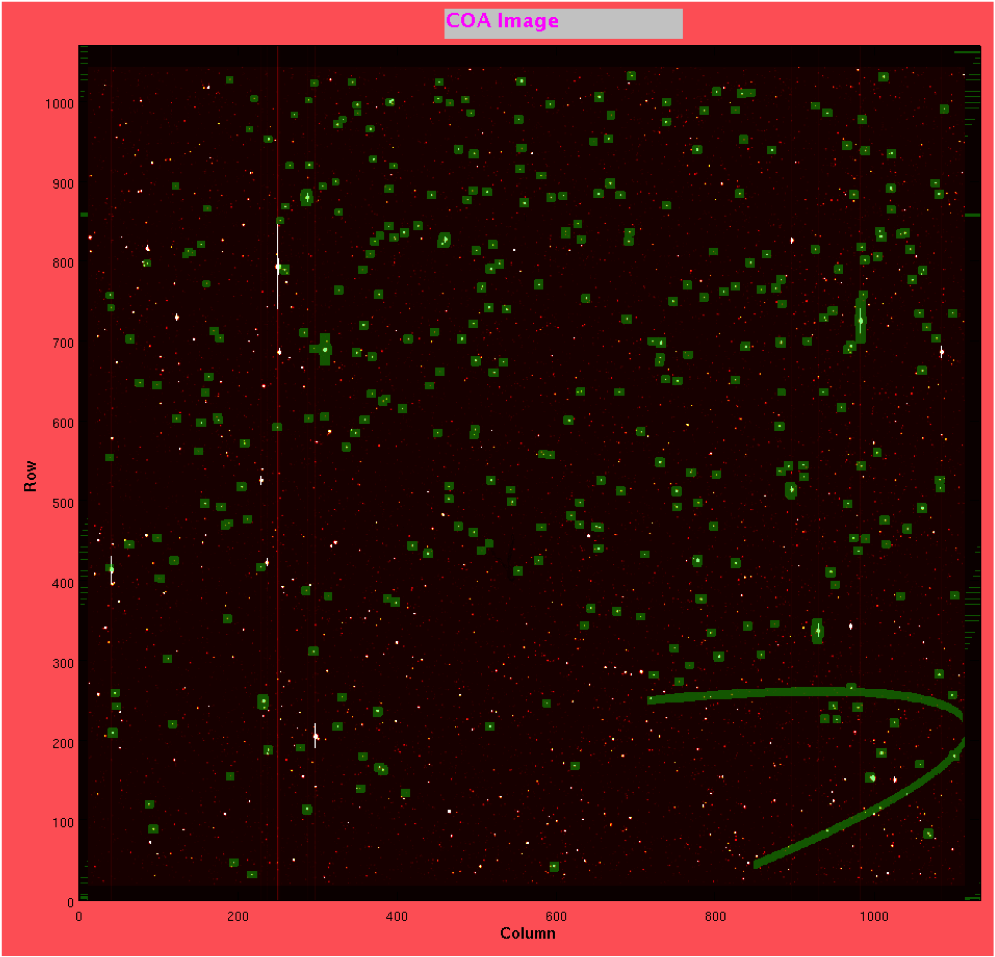
Attitude Tweak
The pointing of the spacecraft was adjusted by approximately 10" on 2014-Aug-25, during cadence 95546, in order to ensure that the observed targets were centered in their masks. This event is flagged in the QUALITY column of the target pixel files with bit 1 (decimal=1). The data collected before the tweak may fall close to the edge of the collected mask and some of the object's flux may have been lost. Users are warned to use these cadences with caution.
Data Quality and Processing Notes
Light Curve Quality
The dominant noise contributors in the C2 data are the saw-tooth roll signal inherent in K2 data and an increased (compared to Kepler and later K2 campaigns) cross-boresight pointing motion due to the lower bandwidth for the attitude determination and control system (ADCS) used in K2 campaigns C0, C1, and C2. The low ADCS bandwidth was particularly problematic for short cadence data, as it meant that the spacecraft pointing errors are on the same time scale as the short-cadence exposure time, so that the pointing induced noise is correlated from cadence to cadence. See notes under C0 for details.
Analysis of the light curve quality reveals that long cadence CDPP values for dwarf stars are ~70% higher than values from subsequent campaigns. This is likely due to the low ADCS bandwidth, Mars traversing the focal plane, and the unflagged large pointing excursion towards the start of the campaign (see next section). The magnitude dependence of CDPP and its distribution over the focal plane are shown below. Other CDPP benchmarks can be found in the table giving 6.5-hr CDPP as a function of magnitude.
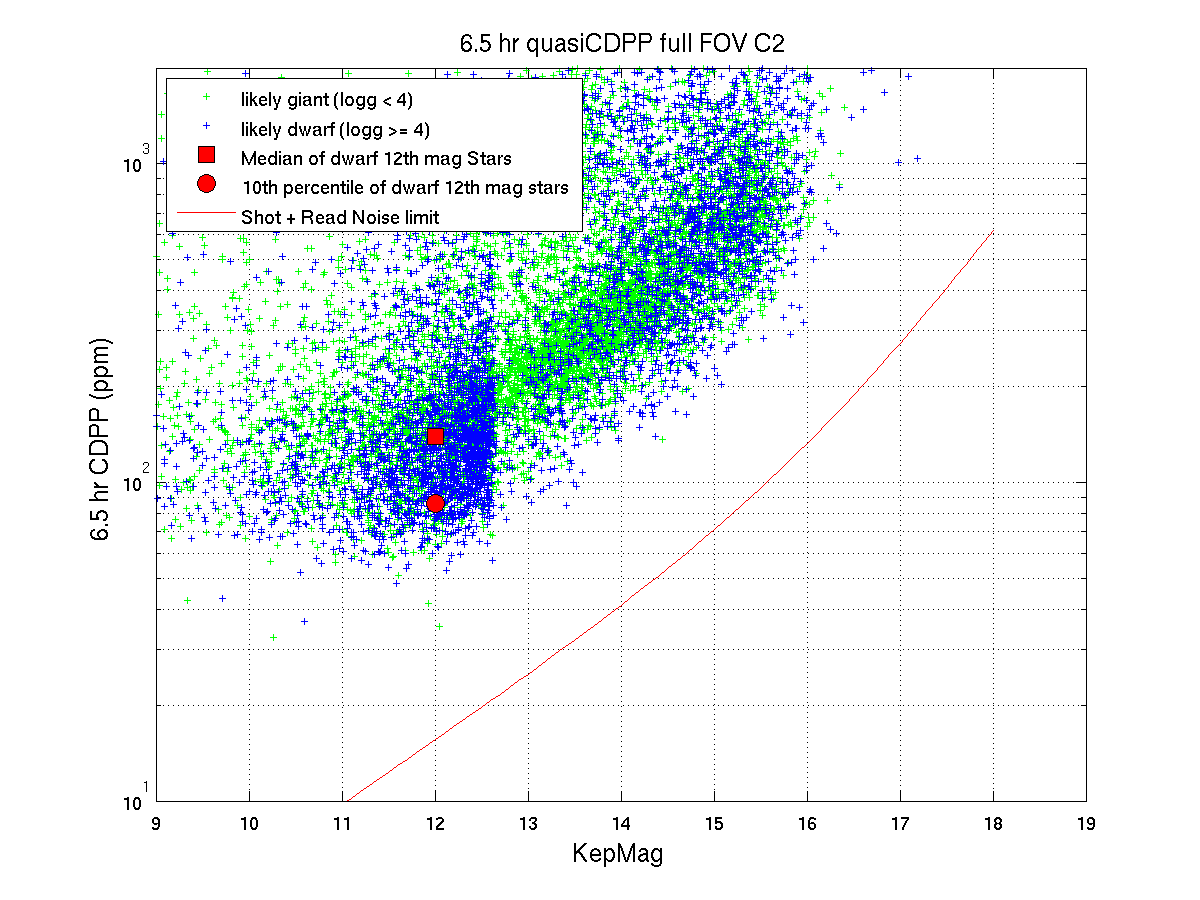
Unflagged Large Pointing Excursion Towards Start of Campaign
As part of the K2 global uniform reprocessing effort, cadences are no longer automatically gapped based on the "Spacecraft is not in fine point" (QUALITY flag bit #16, decimal=32768) flag. Instead, the Kepler/K2 Science Office sets the "Spacecraft is in coarse point" flag (QUALITY flag bit #3, decimal=4) flag based on inspection of the actual pointing data for the campaign using high-frequency sub-cadence telemetry. For C2, the spacecraft was technically in 'coarse point' for LC cadences 95687–95696, which are early on in the campaign. However, the pointing was stable to ~2 pixels during this time period, which given the large size of the collected pixel-stamps for each target in C2 (3–4 pixels in a 'halo' around every target were collected), the decision was made to not set the "Spacecraft is in coarse point" flag (QUALITY flag bit #3, decimal=4) for these cadences.
While the targets did remain on downloaded pixels during this cadence range, a significant fraction of their flux came in and out of the pipeline-computed optimal photometric apertures. For the PA and PDC lightcurves, this results in some significant outliers during this cadence range, including some negative flux values. Consequently the CDPP (a measure of the detrended lightcurve scatter) is higher due both to the outliers themselves, and the PDC module likely wasting some of its 'detrending power' on trying to correct outliers instead of broader systematic features.
If users are utilizing the PA or PDC lightcurves, it is recommended that they discard the cadences in this range. However, if users are producing their own light curves, as long as their own photometric apertures are sufficiently large to capture each target's flux given the extra motion, or if their light-curve production/detrending technique utilizes all the pixels in the image, then these cadences should still be usable and result in good data.
Incorrect pixel-level calibration of some short-cadence TPFs
Due to a processing error in Data Release 21, there are 44 C2 short-cadence targets that had incorrect calibration of their short-cadence pixel-level data. (Long cadence data is unaffected.) The list of affected C2 targets is below. Although it is estimated that only ~25% of them are affected at a non-negligible level, users are strongly encouraged to examine their target, if it is on the list below, to check the severity level and evaluate potential science impact. For a more detailed description of this issue, along with per-target diagnostics and a link to correctly-calibrated target-pixel files for these targets, please read this news post.
202717132 203092367 203393495 203514293 203633963 203734535 203761347
203770817 203836090 203889365 203907143 203927020 203937317 204141790
204226766 204241221 204296786 204313397 204356572 204371831 204372172
204399980 204490599 204494885 204506777 204506926 204514548 204550630
204595607 204624076 204638251 204662993 204819556 204926239 204951731
204959839 204987685 205010433 205089975 205204563 205211890 205311975
205467732 205703810
KIC 204241221 Short-Cadence Dynablack Bug
KIC 204241221 is a V=8.7, A9V star with potentially observable asteroseismic signatures. Due to a bug in the K2 pipeline, Dynablack (see news post here) was not run on the short-cadence pixel-level data for this target — the pipeline defaulted to the original CAL module. (Note that the long-cadence data did have Dynablack successfully run for this target.) The end result is minor, namely that the short-cadence TPF and lightcurve files for 204241221 will not have the benefits of Dynablack, e.g., the correction of potential cross-talk from the fine guidance sensors and rolling-band flags.
LDE Flags
During the latter half of C2 a large number of 'parity errors' were observed from the photometer's local detector electronics (LDE). These LDE parity errors can occur when a very bright star saturates and spills charge into the CCD serial readout register, causing an overflow at the input to the analog-to-digital converter. While these errors were rare in Kepler, the very bright stars, or solar system planets, on the focal plane in K2 can cause frequent parity errors. For example, stars on channels 67 and 75 were the source of many of the parity errors during C2. These errors do not affect the quality of data from pixels on the active focal plane.
The LDE parity error triggers a flag (bit 15, decimal=16384) in the QUALITY column of the target pixel files. This flag is set for the majority of cadences in the second half of the campaign.
Note that the pipeline does not utilize the LDE parity flag and thus the delivered data is unaffected by this flagging — it is mentioned here for users who may do their own processing and it is recommended that cadences with this flag set are not discarded as they contain good quality data.
K2 Campaign 1
These release notes are for the C1 data currently available at MAST (Data Release 32) in the nominal K2 data locations, which have been processed with the final version of the K2 pipeline as part of the K2 global uniform reprocessing effort. The original release notes corresponding to the previous version(s) of C1 data (Data Releases 3 and 14) can be found in the archived data release notes page.
At a glance
- RA: 173.939610 degrees
- Dec: 1.4172989 degrees
- Roll: 157.641206 degrees
- 21,647 EPIC IDs in long cadence (LC).
- 56 EPIC IDs in short cadence (LC).
- 1 custom target was selected in C1: TNO 2002 GV31, which was assigned EPIC ID 200001049
- Time: 2014-05-30 15:54:44 UTC
- Long Cadence Number: 91332
- Short Cadence Number: 2728420
- Time: 2014-08-20 20:19:37 UTC
- Long Cadence Number: 95353
- Short Cadence Number: 2849079
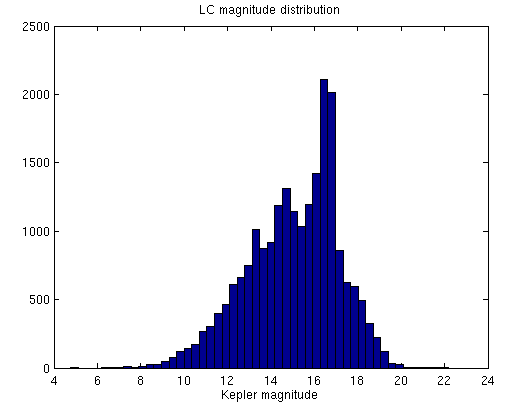
Features and Events
Operational Considerations
Campaign 1 (C1) was the first full length observing campaign for K2 where the targets were selected by peer review. The project was uncertain of the pointing precision and compression efficiency that could be achieved in early K2 operations and took steps to miminimize the risk of losing science data. In order to allow for the potential of coarse point operations, all target apertures included six halo rings. The oversized apertures and uncertain compression performance led the project to include a mid-campaign break lasting 2.9 days (long cadences 93281–93420) in order to downlink data.
Attitude Tweak
The attitude of the spacecraft was tweaked by 3.3 pixels at cadence 91433 to better position the targets in the centers of their apertures. All cadences in the first 2 days of C1 prior to this event (long cadences 91332—91433) have the first bit in the QUALITY column set (integer value = 1) to indicate that they were taken prior to the tweak.
When creating light curves, the pipeline uses PA-COA to determine the optimal photometric aperture that maximizes the signal-to-noise ratio for each target over the full campaign. This static optimal aperture is determined from a robust average of the achieved pointing, so relatively short segments of off-nominal pointing tend to be excluded from the aperture calculation. In the case of C1, the optimal apertures generally do not contain the target star in the pre-attitude tweak cadences. Accordingly, the SAP-Flux and PDC-Flux values found in the light curve files are gapped for the pre-tweak cadences (long cadences 91332—91433, where the QUALITY flag=1). In addition, neither background flux (FLUX_BKG, FLUX_BKG_ERR) nor motion polynomial values (POS_CORR1, POS_CORR2) were computed for the pre-tweak cadences.
Because of the large C1 apertures (with six halos) the TPFs do fully contain the target in the pre-attitude tweak cadences. However, due to the offset, incorrect background flux values are subtracted from the TPF pixel fluxes given in the FLUX column of the TPF. Users wishing to recover photometry from these cadences should add the per-cadence pixel background values (TPF column FLUX_BKG) back into the pixel flux values and then compute their own background levels. The position offset columns (POS_CORR1, POS_CORR2) should likewise be ignored for these pre-tweak cadences.
Finally, in the pre-tweak cadences a small number of targets may have incorrect smear calibrations due to bright saturating stars spilling charge into the detector smear regions. Such effects are flagged and excluded from smear calibration for the post-tweak cadences, but the pre-tweak positions of the bright stars were not used to flag bad smear corrections. Only about 0.2% of the focal plane columns were affected in this way, so the number of potentially affected targets is very small.
Trans-Neptunian Object
A long-cadence custom aperture was constructed in order to collect data on trans-Neptunian Object 2002 GV31. Note, this target is very faint (V=22) and falls in its 23x22 pixel custom aperture for only about 10 days. This custom aperture can be found by searching the MAST for EPIC ID 200001049.
EPIC Catalog Assignment
For this Campaign, a number of targets were proposed without EPIC IDs. If a target was observed, it was either 1) given an EPIC ID from the regular catalog if that target matched a target in the catalog, or 2) assigned a new EPIC ID. EPIC IDs were created for 28 targets, ranging from 210282464 to 210282491. The remaining C1 targets have EPIC IDs ranging from 20100000001 to 202059065.
Data Quality and Processing Notes
Light Curve Quality
The dominant noise contributors in the C1 data are the saw-tooth roll signal inherent in K2 data and an increased (over Kepler and later K2 campaigns) cross-boresight pointing motion due to the lower bandwidth for the attitude determination and control system (ADCS) used in K2 campaigns C0, C1, and C2. The low ADCS bandwidth was particularly problematic for short cadence data, as it meant that the spacecraft pointing errors are on the same time scale as the SC exposure, so that the pointing induced noise is correlated from cadence to cadence. See notes under C0 for details.
The magnitude dependence of CDPP and its distribution over the focal plane are shown below. Other CDPP benchmarks can be found in the table giving 6.5-hr CDPP as a function of magnitude.
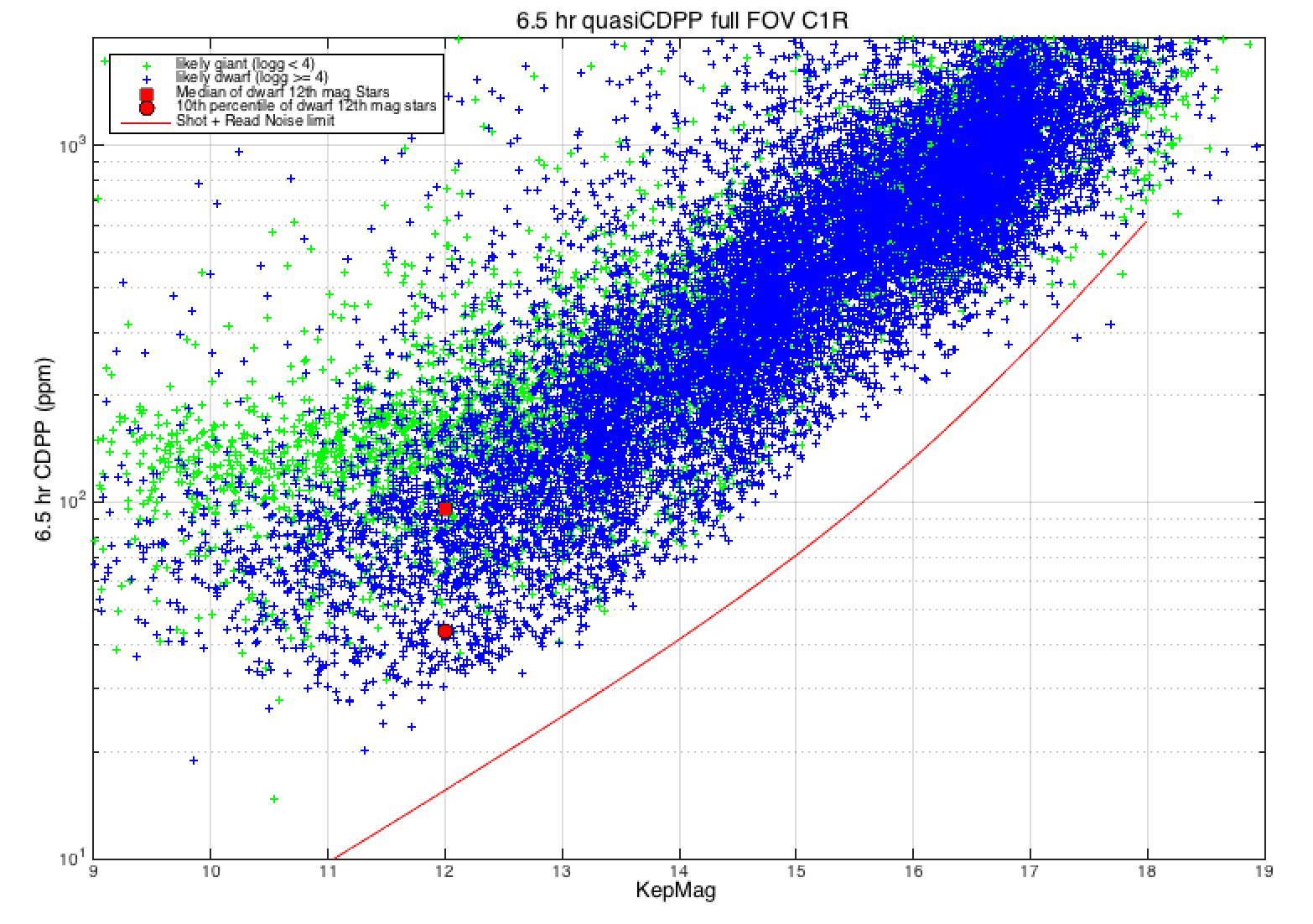

K2 Campaign 0
These release notes are for the C0 data currently available at MAST in the nominal K2 data locations, which have been processed with the final version of the K2 pipeline as part of the K2 global uniform reprocessing effort. The original release notes corresponding to the previous version(s) of C0 data can be found in the archived data release notes page.
Campaign 0 (C0) was implemented as a full-length engineering test to prove that K2 was a viable mission. It observed sources "at risk" from a community-provided target list.
At a glance
- RA: 98.2985439 degrees
- Dec: 21.5904167 degrees
- Roll: 177.4754730 degrees
- 7,902 EPIC IDs in long cadence (LC).
- 13 EPIC IDs in short cadence (LC).
- Several custom targets (see below)
- ktwo2014070234206-c00_ffi-cal.fits
- ktwo2014074233223-c00_ffi-cal.fits†
- ktwo2014110010101-c00_ffi-cal.fits†
First cadence
- Time: 2014-03-12 00:18:30 UTC
- Long Cadence Number: 87434
- Short Cadence Number: 2611480
- Time: 2014-05-27 16:48:13 UTC
- Long Cadence Number: 91186
- Short Cadence Number: 2724069
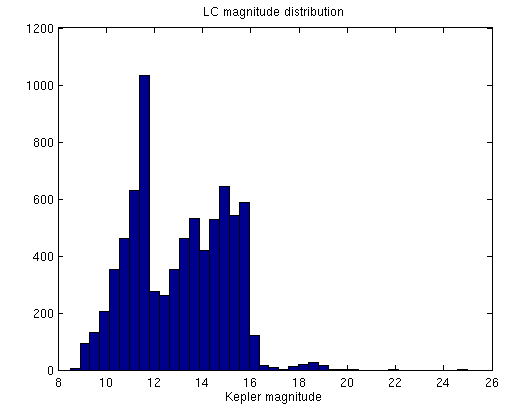
Features and Events
Large Pixel Masks
When planning C0 observations, the pointing performance of K2 was not yet accurately known. The worst case scenario was that a star at the edge of the focal plane could move as much as 40" from its nominal position. Therefore each star was assigned a large pixel mask by first computing a Kepler-style optimal aperture and then adding 10 rings of pixels to account for a potential 40" pointing offset. (Later campaigns only added 2 – 4 rings of pixels.) Care will be needed when performing photometry on C0 data — simply including all collected pixels for a given target will not create a high signal-to-noise light curve. For tools to help choose your photometric aperture, see for example the lightkurve Python package, PyKE software tool suite, or other packages.
Pointing and Roll Performance
C0 was the first full-length campaign observed by K2, and as such testing and refinement of the telescope control systems occurred during the campaign. The first ~18 days of observations had a mixture of fine and coarse pointing, at the end of which the telescope was put into safe mode for ~24 days to adjust the pointing control systems. The spacecraft then resumed observations, experiencing just over a day of coarse point, followed by ~37 days of fine point. Figure C0-Pointing shows the pointing history over the campaign by plotting the observed motion at the edge of the field of view in science pixels versus cadence.
Based on the pointing history, and known complications in processing data with large coarse pointing regions and data gaps, while the entire C0 cadence range was processed by CAL (pixel calibration) and PA (simple aperture lightcurves), only long cadences 89407 – 91186 (and the corresponding short cadence range 2670670 – 2724069) were processed by PDC (systematic detrended lightcurves). This corresponds to the ~37 days of fine point data at the end of the campaign.
During these ~37 days, examining Figure C0-MAR, the pipeline-calculated maximum distance between the derived and nominal positions for any target (the "maximum attitude residual", or MAR) for C18 is less than 2.1 pixels, substantially under the 10-pixel limit accommodated by the aperture halos. (Note that long cadences 89407 – 89410 are flagged using QUALITY flag bit #3 to indicate significant pointing excursions, despite the spacecraft technically being in fine point, and users may wish to discard them.)
No Data for Modules 3 and 7
Prior to the start of C0, on January 21, 2014, the photometer was autonomously powered off by an under voltage fault in the Local Detector Electronics Power Supply. Since that time, module 7 (i.e., channels 17 to 20; see this graphic) has yielded no star data or charge injection signal. The subsequent behavior of this module is very similar to that of module 3 after it failed on January 19, 2010. Thus, there is no data for targets falling modules 3 or 7 for Campaign 0 or subsequent campaigns.
Jupiter's Reflection
Jupiter was in the K2 field of view during C0 from 2014-03-14 through 2014-05-12, but fell on the dead module 3. It creates a bright antipodal ghost on module 23, channel 79, and impacts all the targets observed in this region. See the FFI ktwo2014074233223-c00, extension 79, for an image of the reflection.
While Jupiter was on the focal plane, the background level was increased over its nominal value for nearly half the channels, with the largest impact seen in channels 53 – 84. In addition, as Jupiter moved on and off the focal plane, a specular reflection lasting approximately 6 hours was seen in these channels. The relative background levels as measured in the smear signal from channel 83 are shown below as Jupiter enters the focal plane (near cadence no. 87525) and leaves the focal plane (cadence no. 90375). The specular bump resulted in an increase in background level of 25 – 30% for the affected channels, while the quasi-static background increase for the time Jupiter was on the focal plane was 3 – 5%.
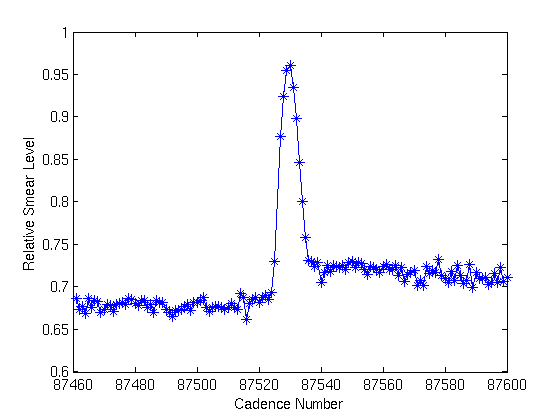
Observations of M35 and NGC 2158
The open clusters M35 (NGC 2168) and NGC 2158 were observed during this campaign by placing 154 separate 50x50 pixel masks over the densest portion of these two adjacent clusters. Each mask was given a custom aperture number to act as the unique identifier found in the file name. The target pixel files for these clusters have custom aperture numbers ranging from 200000811 to 200000964.
Data Quality and Processing Notes
Dynablack Turned Off
One of the new features in data processed as part of the K2 global uniform reprocessing effort is the use of Dynablack, a more sophisticated algorithm to perform the pixel-level calibration, which also flags cadences that are likely affected by the presence of rolling bands. However, due to the large amount of coarse point data, combined with the ~24 day data gap due to the safe mode event, the Dynablack module did not have enough high-quality data to be able to run. Thus for this data release, the pixel-level calibrations were performed with the standard CAL module, and there are no rolling band flags in the delivered FITS files.
PDC Only Run On Last ~37 Days
Based on the pointing history and known complications in processing data with large coarse pointing regions and data gaps, while the entire C0 cadence range was processed by CAL (pixel calibration) and PA (simple aperture lightcurves), only long cadences 89407 – 91186 (and the corresponding short cadence range 2670670 – 2724069) were processed by PDC (systematic detrended lightcurves). This corresponds to the ~37 days of fine point data at the end of the campaign.
As a result, lightcurve files (*llc.fits and *slc.fits) will have valid SAP_FLUX values for most cadences throughout the entire time span of C0 when observations were taken. PDCSAP_FLUX values however will be 0 or NaN for cadences prior to 89407.
Similarly, the cotrending basis vector (CBV) file for C0 (ktwo-c00-d28_lcbv.fits) will only have data for cadences 89407 – 91186.
No ARP Files Available
Since the necessary pixels were not collected in C0, note there are no artifact removal pixel (ARP) files available for C0 (see S2.3.8 of the Kepler Archive Manual).
48 Targets Without Lightcurves
The following 48 targets do not have associated lightcurve files, because the pipeline was unable to find a suitable photometric aperture for these targets. In general they are non-standard targets, such as clusters or very bright objects, or there is no significant flux at the target position. Users are encouraged to create their own lightcurves for these objects from the existing target pixel files using software such as lightkurve Python package, PyKE software tool suite, or other packages.
202060164 202060210 202060421 202060813 202065115 202065116
202065117 202065118 202065119 202065120 202065121 202065122
202065123 202065124 202065125 202065126 202065127 202065128
202065129 202065130 202065131 202065132 202065133 202065134
202065135 202065136 202071440 202071443 202071445 202071446
202071448 202071450 202072947 202072959 202072962 202072982
202073036 202073099 202073125 202073136 202073152 202073290
202073323 202073354 202073360 202073364 202073377 202073415
Degraded WCS Information
Due the smaller number of targets, and large pixel-stamp size, in C0 compared to other fields, overall the World Coordinate System (WCS) solution for most channels is not as high-quality as other campaigns. Users should be especially cautious of the WCS information for the following channels (module.output) in C0, which may be inaccurate by up to several pixels / tens of arcseconds: 2 (2.2), 10 (4.2), 28 (9.4), 42 (13.2), 45 (14.1), 49 (15.1), 51 (15.3), 52 (15.4), and 62 (18.2).
The reduced WCS quality compared to other campaigns also applies to the full frame images (FFIs). Notably, the third FFI https://archive.stsci.edu/missions/k2/ffi/ktwo2014110010101-c00_ffi-cal.fits has an inaccurate WCS that is off by several pixels / tens of arcseconds. Should users require a more accurate WCS, it is recommended to use the WCS info from the previous CO processing (DR2; https://archive.stsci.edu/missions/k2/ffi/old_release_files/ktwo2014110010101-c00_ffi-cal.fits), which was produced using astrometry.net.
Potentially Poor Apertures in Channel 45 (14.1)
A significant number of targets on channel 45 had sub-optimal apertures selected by the pipeline, and as a result the lightcurve quality will be poorer than other channels. Users with targets on this channel are encouraged to inspect the aperture selected by the pipeline (using the target pixel files) before using the lightcurves for science, and/or select a custom aperture and produce new lightcurves using tools such as the lightkurve Python package, PyKE software tool suite, or other packages.
Increased Photometric Jitter Caused by Lower ADCS Bandwidth
For the K2 Mission, only one guide star was observed for each fine-guidance sensor. (Kepler had ten per sensor.) This change was demanded by the need for increased aperture sizes given the uncertainties in the star-tracker to boresight alignment, and the need to acquire an entirely new field-of-view every 80 to 90 days. To compensate for the increased sensor noise and assure that fine-point lock could be achieved, the attitude determination and control system (ADCS) bandwidth for K2 was set to 0.02 Hz for C0, C1, and C2. (Kepler used 0.1 Hz.) This low bandwidth meant that the cross-boresight attitude (i.e., RA and Dec) had a time constant of 50 seconds, which is comparable to the short-cadence duration of 58.89 seconds. As a result, pointing-induced noise is correlated from cadence to cadence for short-cadence observations, resulting in significantly increased photometric jitter for short-cadence lightcurves. It is likely that long-cadence lightcurves also have a slightly increased photometric jitter due to the low ADCS bandwith. Starting with C3, the ADCS bandwidth was increased to 0.05 Hz (20 seconds) to mitigate this effect.
Light Curve Quality
The 6-hour spacecraft roll cycle dominates the systematic errors in C0 simple aperture photometry light curves. In general the PDCSAP_FLUX photometric quality (produced only for the last ~37 days of the campaign) is comparable to later campaigns.
The magnitude dependence of CDPP and its distribution over the focal plane are shown below. Other CDPP benchmarks can be found in the table giving 6.5-hr CDPP as a function of magnitude.
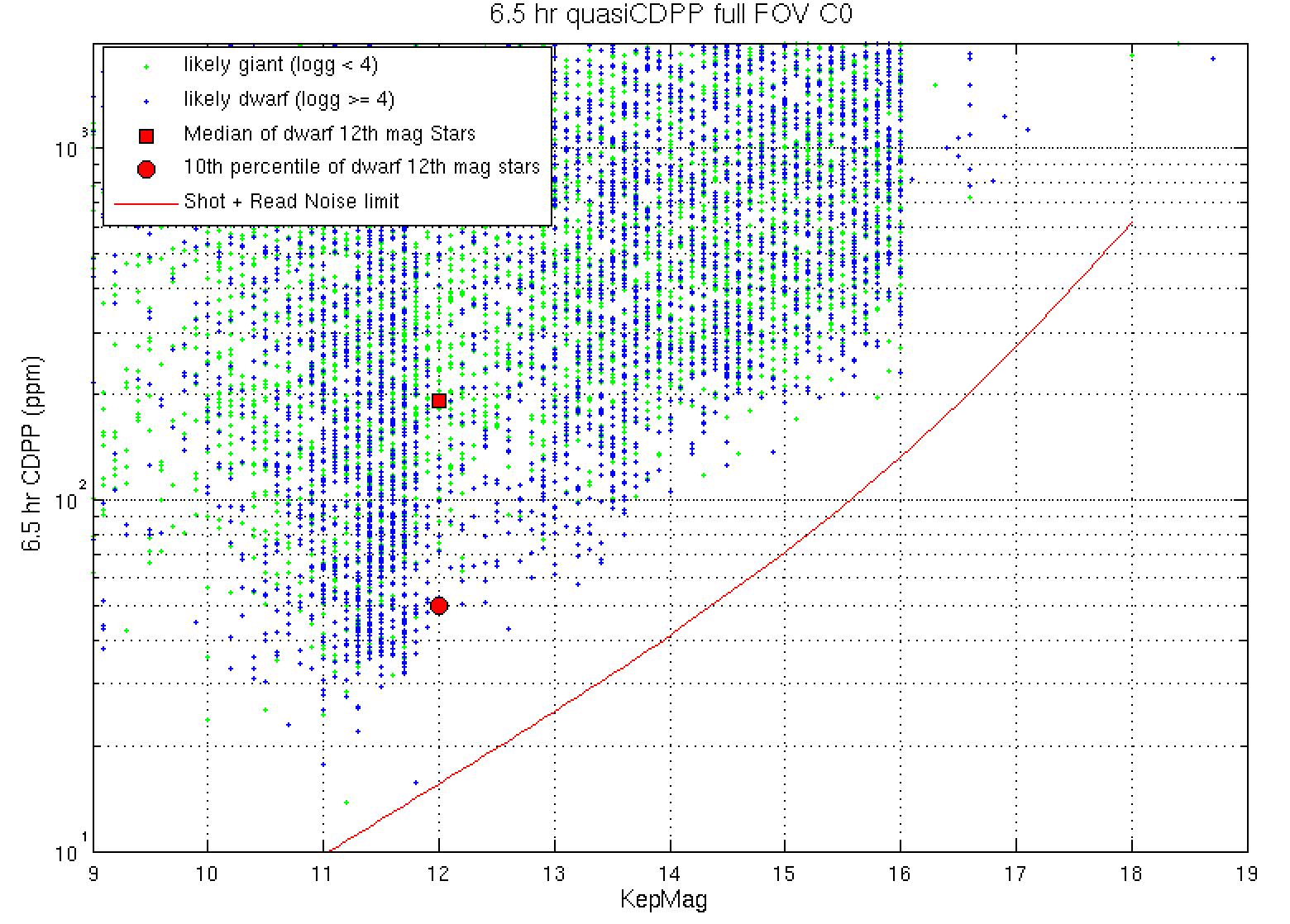
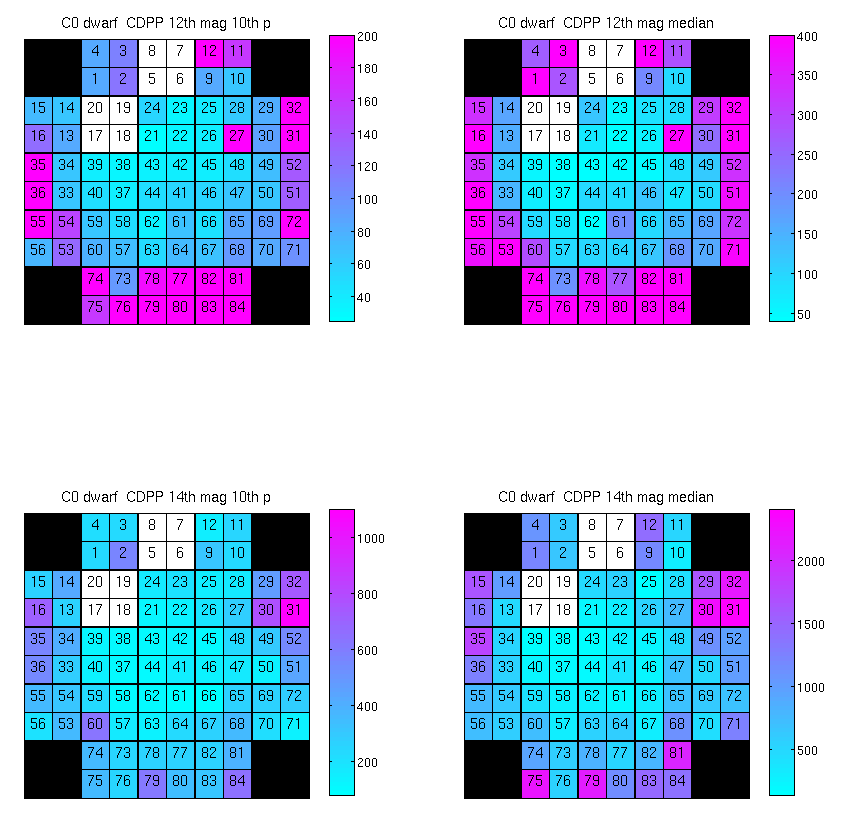
Two-wheel Concept Engineering Test
At a glance
Before the official start of the K2 Mission, the spacecraft executed a 9-day test to demonstrate the two-wheel mission concept. While this engineering test is not an officially-supported Campaign, the pixel data were made public to help the community appraise the characteristics of K2 data. Extensive data release notes are not available for this test, but support is offered on a best-effort basis via the Kepler Science Center helpdesk. Please refer to this data set as the "Two-wheel Concept Engineering Test" in all publications.
- RA: 358.6492374 degrees
- Dec: -2.1523890 degrees
- Roll: -156.4440683 degrees
- Time: 2014-02-04 12:57:46 UTC
- Long Cadence Number: 85698
- Short Cadence Number: 2559400
- Time: 2014-02-13 12:44:30 UTC
- Long Cadence Number: 86137
- Short Cadence Number: 2572599
Page last updated on:
